

BY
DR. FRANZ VON REBER
DIRECTOR OF THE BAVARIAN ROYAL AND STATE GALLERIES OF PAINTINGS
PROFESSOR IN THE UNIVERSITY AND POLYTECHNIC OF MUNICH
Revised by the Author
TRANSLATED AND AUGMENTED
BY
JOSEPH THACHER CLARKE
WITH 310 ILLUSTRATIONS AND A GLOSSARY OF TECHNICAL TERMS
NEW YORK
HARPER & BROTHERS, FRANKLIN SQUARE
Entered according to Act of Congress, in the year 1882, by
HARPER & BROTHERS,
In the Office of the Librarian of Congress, at Washington.
All rights reserved.
THE application of the historic method to the study of the Fine Arts, begun with imperfect means by Winckelmann one hundred and twenty years ago, has been productive of the best results in our own days. It has introduced order into a subject previously confused, disclosing the natural progress of the arts, and the relations of the arts of the different races by whom they have been successively practised. It has also had the more important result of securing to the fine arts their due place in the history of mankind as the chief record of various stages of civilization, and as the most trustworthy expression of the faith, the sentiments, and the emotions of past ages, and often even of their institutions and modes of life. The recognition of the significance of the fine arts in these respects is, indeed, as yet but partial, and the historical study of art does not hold the place in the scheme of liberal education which it is certain before long to attain. One reason of this fact lies in the circumstance that few of the general historical treatises on the fine arts that have been produced during the last fifty years have been works of sufficient learning or judgment to give them authority as satisfactory sources of instruction. Errors of statement and vague speculations have abounded in them. The subject, moreover, has been confused, especially in Germany, by the intrusion of metaphysics into its domain, in the guise of a professed but spurious science of æsthetics.
Under these conditions, a history of the fine arts that should state correctly what is known concerning their works, and should treat their various manifestations with intelligence and in just proportion, would be of great value to the student. Such, within its limits as a manual and for the period which it covers, is Dr. Reber’s History of Ancient Art. So far as I am aware, there is no compend of information on the subject in any language so trustworthy and so judicious as this. It serves equally well as an introduction to the study and as a treatise to which the advanced student may refer with advantage to refresh his knowledge of the outlines of any part of the field.
The work was originally published in 1871; but so rapid has been the progress of discovery during the last ten years that, in order to bring the book up to the requirements of the present time, a thorough revision of it was needed, together with the addition of much new matter and many new illustrations. This labor of revision and addition has been jointly performed by the author and the translator, the latter having had the advantage of doing the greater part of his work with the immediate assistance of Dr. Reber himself, and of bringing to it fresh resources of his own, the result of original study and investigation. The translator having been absent from the country, engaged in archæological research, during the printing of the volume, the last revision and the correction of the text have been in the hands of Professor William R. Ware, of the School of Mines of Columbia College.
Charles Eliot Norton.
Cambridge, Massachusetts, May, 1882.
In view of the great confusion which results from an irregular orthography of Greek proper names, a return to the original spelling of words not fully Anglicized may need an explanation, but no apology: it is only adopting a system already followed by scholars of the highest standing. The Romans, until the advent of that second classical revival in which the present century is still engaged, served as mediums for all acquaintance with Hellenic civilization. They employed Greek names, with certain alterations agreeable to the Latin tongue, blunting and coarsening the delicate sounds of Greek speech, much in the same manner as they debased the artistic forms of Greek architecture by a mechanical system of design. The clear ον became um, ος was changed to us, ει to e or i, etc. This Latinized nomenclature, like the Roman triglyph and Tuscan capital, was exclusively adopted by the early Renaissance, until, with the increasing knowledge of Greek lands and works of art, names were introduced which do not happen to occur in the writings of Roman authors. These were either changed in accordance with the more or less variable standard in use during the sixteenth and seventeenth centuries, or were adopted in their Greek form without change, the latter method being more and more generally employed. This has gradually led to a partial revision of Greek names and their spelling. Zeus and Hermes, Artemis and Athene, have resumed, as Greek deities, their original titles;—Sunium and Assus have been changed to Sunion and Assos; while other names have only been reformed in part, as in the case of the unfortunate Polycleitos, who at times appears as Polycletos, and at times as Polycleitus. Confusion and misunderstanding cannot but result from this unreasonable triple system of Latinized, Anglicized, and Greek orthography. Peirithoos may be sought in alphabetically classified works of reference under Per and Pir as well as under Peir. Πέργαμον, Pergamon, is written Pergamum, Pergamus, and Pergamos, in the two latter forms being naturally confused with the Cretan Πέργαμος, Pergamos, which, in its turn, is Latinized to Pergamus. In the present book the Greek spelling of Greek names has been adopted in all those cases where the word has not been fully Anglicized; that is to say, changed in pronunciation, when it would sound pedantic to employ its original form, as, for instance, to speak of the well-known Pæstum and Lucian as Poseidonia and Loukianos. The English alphabet provides, however, two letters for the Greek κάππα, and the more familiar c has been employed, as in Corinth, acropolis, etc., except in cases where the true sound is not thereby conveyed,—namely, before e, i, and y,—when the k is substituted. Moreover, the final αι is transformed to æ, according to the universal usage of our tongue.
Joseph Thacher Clarke.
| EGYPT. | |
|---|---|
| PAGE. | |
| The Delta. The Oldest Monuments, if not the most Ancient Civilization of the World | 1, 2 |
| Changeless Continuity of Life and Art | 2 |
| ARCHITECTURE. | |
| The Age, Purpose, and Architectural Significance of the Pyramids | 3-5 |
| The Pyramids of Gizeh | 5-7 |
| Variety of Pyramidal Forms | 8, 9 |
| The Pyramids of Saccara, Meydoun, Dashour, Abousere, and Illahoun | 9-12 |
| Table of Dimensions | 12 |
| The Younger Pyramids of Nubia. Truncated Pyramids | 12 |
| Rock-cut Tombs | 13 |
| Development of Column from Pier | 14 |
| The Tombs at Beni-hassan | 14, 15 |
| Development of the Lotos-column | 16, 17 |
| The Invasion of the Hycsos. Restriction of the Prismatic Shaft. Extended Application of the Floral Columnin the New Theban Empire | 18, 19 |
| The Calyx Capital | 20, 21 |
| Piers with Figures of Osiris and Typhon. Entablature | 21 |
| Cavern Sepulchres | 22 |
| Temple Plan, Obelisks | 23 |
| Peristyle Court | 25 |
| Hypostyle Hall | 26, 27 |
| The Dwellings of Kings and Priests | 28 |
| Peripteral Temples | 29 |
| Rock-cut Temples | 30 |
| The Monuments at Abou-Simbel | 31, 32 |
| Palatial and Domestic Architecture | 33 |
| Interiors | 34 |
| The Labyrinth | 35 |
| Unimportant Character of Secular Architecture | 36 |
| SCULPTURE. | |
| Fundamental and Changeless Peculiarities | 36 |
| Conventional Types | 37 |
| The Formation of the Head | 38 |
| Head-dresses. Conjunction of Human Trunks and Animal Heads | 39 |
| The Body. Lack of Progressiveness and of History | 40 |
| Animal Forms | 41 |
| Materials | 42 |
| Reliefs | 43 |
| Coilanaglyphics | 44 |
| The Variety and Interest of the Subjects Illustrated | 45 |
| PAINTING. | |
| Intimate Relation to Sculpture. Hieroglyphics | 46 |
| Painting as an Architectural Decoration. Retrospect | 47 |
| CHALDÆA, BABYLONIA, AND ASSYRIA. | |
| The Traditional Age. The Land and People | 48 |
| Building Materials. Clay and Bitumen | 49 |
| Perishable Character of the Monuments. Hills of Rubbish Recognized as Cities | 50 |
| ARCHITECTURE. | |
| Chaldæa. | |
| The Ruins of Mugheir, or Ur | 50 |
| Warka and Abou-Sharein | 51 |
| The Principle of the Arch | 52 |
| Political History | 53 |
| Babylon. | |
| The Fabulous Account of Herodotos | 54 |
| The Temple Pyramid at Borsippa | 56 |
| Palace Structures. The Hanging Gardens of Semiramis | 57 |
| Private Dwellings. Works of Engineering | 58 |
| Assyria. | |
| Nineveh | 59 |
| The Discoveries of Layard and Botta | 60 |
| The Hills of Coyundjic and Nebbi-Jonas | 61 |
| Royal Dwellings | 62 |
| The Palace at Kisr-Sargon | 63-65 |
| Terrace Pyramids | 66 |
| Lighting and Roofing | 66, 67 |
| The Restriction of Columnar Architecture | 68 |
| The Forms of Small Columns | 69-71 |
| Vaulted Construction | 71 |
| The Pointed Arch | 72 |
| The General Appearance of the Palaces | 73 |
| Sacred Architecture | 74 |
| Terrace Pyramids | 75 |
| The Cella | 76 |
| The Dwellings of the Priests | 77 |
| Altars and Obelisks | 78 |
| Domestic Architecture | 79, 80 |
| SCULPTURE. | |
| Little Represented in Chaldæa | 81 |
| Babylonian Seals and Gems | 82 |
| Enamelled Tiles | 83 |
| Statues | 85 |
| Conventional Types | 85, 86 |
| Cherubims | 87 |
| Mural Reliefs | 87-89 |
| Variance from Egyptian Sculpture | 90 |
| Historical Reliefs | 91-93 |
| Religious Representations | 94 |
| Formal Landscapes. Bronzes | 95, 96 |
| PAINTING. | |
| Upon Tiles and Stucco | 96 |
| Colors | 97 |
| The General Appearance of Assyrian Architecture, as Decorated by Reliefs and Paintings | 98 |
| PERSIA. | |
| Historical Considerations | 99 |
| The Artistic Poverty of the Medes. The Achæmenidæ. Their Chief Cities | 100 |
| ARCHITECTURE. | |
| Persepolis | 101, 102 |
| The Characteristic Differences of Persian and Mesopotamian Building | 102 |
| The Introduction of Columns | 103 |
| Columnar Forms | 103, 104 |
| Capitals | 105-107 |
| The Entablature | 108 |
| Plan of the Palace of Darius | 109-113 |
| Its State of Preservation | 110 |
| Illumination | 110, 111 |
| Upper Stories | 111-113 |
| The Palace and Hall of Xerxes | 114 |
| The Propylæa | 115 |
| The Harem | 116, 117 |
| The Disposition of the Terrace | 117 |
| Fire Altars | 118 |
| Funeral Monuments | 119-121 |
| Tomb of Cyrus | 119 |
| Tombs of the Later Achæmenidæ | 120 |
| Tombs of Subjects | 121 |
| Domestic Architecture | 121 |
| SCULPTURE. | |
| Its Dependence upon the Art of Assyria | 121 |
| Egyptian and Hellenic Influences | 122 |
| Mythological and Ceremonial Representations | 123-125 |
| The Sculptured Decoration of Palaces and Terraces | 126, 127 |
| Rarity of Historical Scenes | 128 |
| PAINTING. | |
| Chiefly Ornamental | 128 |
| General Harmony of the Three Arts | 129 |
| PHŒNICIA, PALESTINE, AND ASIA MINOR. | |
| Extensive Artistic Influence of Mesopotamia in Point of Distance as well as of Time | 130 |
| The Seleucidæ. The Sassanidæ | 131, 132 |
| Phœnicia. | |
| Explorations in Recent Times | 132, 133 |
| The Chief Cities | 133 |
| ARCHITECTURE. | |
| Ruins at Amrith | 134, 135 |
| The Monuments known as El-Meghazil | 135-137 |
| The Grotto Tombs of Central Phœnicia. Sarcophagi at Jebeil | 137, 138 |
| Domestic Architecture | 138 |
| SCULPTURE. | |
| Work of Driven Metal (Sphyrelaton) | 139 |
| Bronzes | 139, 140 |
| Inlaid Work. Ivory Carvings. Glass | 140 |
| Influence of the Sphyrelaton upon Sculptural Style | 141 |
| Stone-cutting | 142 |
| The Decisive Influence of both Egypt and Mesopotamia | 143 |
| Palestine. | |
| The Dependence of the Jews in Artistic respects upon Egypt | 143 |
| The Tabernacle | 143-147 |
| Its Disposition | 144, 145 |
| Its Columns. The Horns of the Altar. The Seven-armed Candlestick | 145, 146 |
| The Holy of Holies. Cherubim | 146, 147 |
| Solomon’s Temple | 147-156 |
| Untrustworthiness of Biblical Accounts | 147 |
| Construction of the Building. Its Site | 148 |
| The Brazen Laver | 149 |
| “Jachin and Boaz” | 149-151 |
| The Tower | 151, 152 |
| Interior. Upper Story | 153, 154 |
| Materials | 154 |
| Decoration. The Molten Sea. The Mercy-seat and Cherubim | 155 |
| The Destruction and Rebuilding of this Temple | 156 |
| Its Architectural Character | 157 |
| Rock-cut Tombs | 157, 158 |
| Cyprus and Carthage. | |
| The Rock-cut Tombs at Paphos | 160 |
| The Temple of Aphrodite at Golgoi. Cesnola’s Discoveries | 161, 162 |
| The Ruins of Carthage | 163 |
| Malta, the Balearic Isles, Sardinia | 163 |
| Asia Minor. | |
| An Independent Art Found only in Lycia, Phrygia, and Lydia | 164 |
| The Rock-cut Tombs of Lycia. The Timbered Dwelling Carved in Stone | 165, 166 |
| The Monument of the Harpies at Xanthos | 167 |
| Lycian Sarcophagi | 168 |
| Temple Façades Imitated upon Cliffs | 169 |
| The Rock-cut Tombs of Phrygia | 171, 172 |
| The Tumuli of Lydia | 173, 174 |
| HELLAS. | |
| The Ægean Sea the Centre of Greek Civilization | 175 |
| The Dorians and the Ionians | 176 |
| The Development of Poetry Earlier than that of Art | 177 |
| ARCHITECTURE. | |
| The Tholos of Atreus | 179-183 |
| The Phœnician Character of its Decoration | 183 |
| The Grave at Menidi | 183 |
| The Treasure-houses of the Pelopidæ | 184 |
| Tumuli | 185 |
| The Common Modes of Burial | 186 |
| Pyramids | 186, 187 |
| Primitive Fortifications. Tiryns | 187 |
| Mykenæ | 188 |
| Gateways and Portals | 189-193 |
| The Agora of Mykenæ | 192 |
| Primitive Temple Cellas without Columns | 192, 193 |
| The Structure upon Mt. Ocha. Timbered Roofs and Ceilings. The Origin of the Doric Entablature | 195-197 |
| The Decorative Painting of Woodwork | 197 |
| The Doric Column | 197-199 |
| Its Egyptian Prototype | 198 |
| The Development of the Temple-plan | 199-202 |
| The Temple in Antis | 199 |
| Prostylos | 200 |
| Amphiprostylos. Peripteros | 201 |
| Stone Construction | 202 |
| The Entasis | 203 |
| The Capital | 204 |
| The Inclination of the Columns | 205 |
| The Details of the Entablature | 206-209 |
| Polychromy | 210 |
| Curvatures | 211, 212 |
| The Pteroma and Ceiling | 213 |
| Illumination | 214 |
| Archaic Doric Temples | 215 |
| The Progress of this Style. Selinous | 216 |
| Corinth | 217 |
| Acragas | 219 |
| Olympia. Ægina | 222 |
| The Supremacy of Athens | 223 |
| The Theseion | 224 |
| The Parthenon | 225 |
| The Propylæa | 226 |
| Phigalia | 227 |
| Eleusis | 228 |
| The Ionic Style. Its Intimate Relation to Oriental Architecture | 229, 230 |
| The Capital | 231-233 |
| The Entablature | 234 |
| Its Want of Historical Development | 235 |
| Phigalia | 236 |
| The Ionic Monuments of Asia Minor | 237-240 |
| The Ionic Monuments of Attica | 240-245 |
| The Temple upon the Ilissos | 241 |
| The Propylæa | 242 |
| The Erechtheion | 243-245 |
| Caryatides | 245 |
| The Corinthian Capital | 246-249 |
| The Temple of Olympian Zeus in Athens | 249 |
| Monumental Tombs | 250 |
| The Mausoleum of Halicarnassos | 251, 252 |
| The Monument of the Nereides at Xanthos | 252 |
| The Choragic Monument of Lysicrates | 253 |
| The so-called Tower of the Winds at Athens | 253 |
| The Stoa | 253-255 |
| The Palæstra | 255 |
| The Gymnasion | 256 |
| The Stadion and Hippodrome | 257 |
| The Theatre and Odeion | 258-260 |
| Domestic Architecture. Palaces | 260, 261 |
| The Boundless Luxury of the Diadochi | 261 |
| SCULPTURE. | |
| The Unrivalled Perfection of the Art. Its Fundamental Deviation from the Principles of Egyptian Sculpture | 264, 265 |
| Its Dependence upon Western Asia | 266 |
| Empaistic Work. Xoana | 267 |
| Dædalos | 268 |
| The Homeric Shield of Achilles. Its Workmanship and Artistic Importance | 269-271 |
| Pseudo-Hesiodic Shield of Heracles | 272 |
| The Gate of the Lions at Mykenæ | 273, 274 |
| Schliemann’s Excavations upon the Acropolis of Mykenæ | 274, 275 |
| The Chest of Kypselos. The Throne of Apollo at Amyclæ | 276-278 |
| The Introduction of Bronze Casting. Marble-cutting and Chryselephantine Work | 278-281 |
| The Potter Boutades | 278 |
| Glaucos. Rhoicos and Theodores | 279 |
| Boupalos and Athenis | 280 |
| Dipoinos and Skyllis | 281, 282 |
| The First Metopes at Selinous | 283, 284 |
| Archaic Statues at Miletos | 285 |
| Reliefs at Assos. The Apollo of Thera | 286 |
| The Stele of Aristion | 287, 288 |
| The Second Metopes at Selinous | 290 |
| Archaistic Works | 291, 292 |
| The Gable Sculptures of the Temple of Ægina | 293-296 |
| The School of Ægina: Callon and Onatas | 296, 297 |
| The School of Attica: Hegias, Critios, and Nesiotes | 297 |
| Canachos | 298 |
| Agelades | 299 |
| Calamis | 300 |
| Pythagoras | 301 |
| Myron | 302, 303 |
| The Progress of Athens after the Persian Wars | 303 |
| Pheidias | 304-315 |
| The Athene Parthenos | 310-313 |
| The Panathenaic Frieze | 313-315 |
| The Metopes | 316 |
| The Scholars of Pheidias. Agoracritos | 316, 317 |
| The Gable Sculptures of the Temple of Olympia | 317, 318 |
| The Victory of Paionios | 319 |
| The Scholars of Myron | 320 |
| The Phigalian Frieze | 321 |
| Callimachos and Demetrios | 322 |
| Polycleitos | 322-326 |
| The Third Metopes at Selinous | 327, 328 |
| The Extent of the School of Attica and Argos. Kephisodotos | 329 |
| Scopas | 330-333 |
| The Niobids | 331, 332 |
| Praxiteles | 333 |
| The Scholars of Scopas and Praxiteles. The Sculptures of the Mausoleum of Halicarnassos | 334 |
| The Hermes of Olympia | 335, 336 |
| The Venus of Melos | 338, 339 |
| Silanion and Euphranor | 340 |
| Lysippos | 340-344 |
| The School of Lysippos | 344, 345 |
| The Sculpture of the Hellenistic Period | 346, 347 |
| The Altar at Pergamon | 347, 348 |
| The so-called Dying Gladiator | 348, 349 |
| The School of Pergamon | 349, 350 |
| The School of Rhodes. The Laocoon | 351-353 |
| The Farnese Bull | 353-355 |
| The Apollo Belvedere | 356-358 |
| The Introduction of Greek Sculpture into Rome | 358-360 |
| The Borghese Gladiator | 361 |
| The Belvedere Torso | 362 |
| The Hellenic Renaissance in Rome | 363-366 |
| PAINTING. | |
| Lack of all Remains | 366 |
| Its Early Development Fictitiously Related by Pliny. Eumaros. Kimon | 367 |
| Polygnotos | 368, 369 |
| The Scenography of Agatharchos. Of Apollodoros | 370 |
| Zeuxis | 371, 372 |
| Parrhasios | 373, 374 |
| Timanthes | 374 |
| The School of Sikyon: Eupompos, Pamphilos | 375 |
| Melanthios. Pausias | 376 |
| The School of Thebes and Athens: Nicomachos, Aristides, Euphranor | 377, 378 |
| Nikias | 378 |
| Apelles | 379-382 |
| Protogenes | 383 |
| Antiphilos. Ætion. Asclepiodoros. Theon | 384 |
| Hellenistic Painting. Timomachos | 385 |
| Trivial and Obscene Subjects. Mosaic. Sosos | 386 |
| ETRURIA. | |
| Relationship to the Arts of Greece | 387 |
| ARCHITECTURE. | |
| The so-called Cyclopean Walls. Arched Gates | 388 |
| Vaulted Canals | 389 |
| Cemeteries. Tumuli. The Tomb of Porsena | 390 |
| Imitations of Dwellings upon Tombs | 391, 392 |
| Grotto Sepulchres | 392 |
| Imitations of Temple Façades upon Cliffs | 393, 394 |
| Norchia | 394, 395 |
| The Etruscan Temple | 396, 397 |
| The Dwelling-house | 397 |
| Its Court | 398, 399 |
| Lack of Progressive Architectural History | 399, 400 |
| SCULPTURE. | |
| Museums. The Oldest or Decorative Period. Phœnician Importations | 400 |
| The Influence of Western Asia Superseded by that of Greece | 401, 402 |
| The Sarcophagus of Cære | 402 |
| Realism. Sculpture in Marble | 403 |
| The Bronze Chariot from Perugia | 404 |
| The Capitoline Wolf. Engraved Mirrors | 405 |
| Height of Etruscan Art. Hellenistic Influences | 406 |
| Sculptured Sarcophagi | 406, 407 |
| Terra-cottas and Bronzes | 408 |
| The Similarity of late Etruscan to Roman Sculpture | 408, 409 |
| PAINTING. | |
| Its Development Similar to that of Sculpture. The Ornamental and Dependent Period | 409 |
| Realistic Characteristics | 409, 410 |
| The Wall-paintings of Cære and Corneto | 409, 410 |
| The Influence of Greece | 411 |
| Artistic Manufactures | 411, 412 |
| Sgraffiti. The Importance of Etruscan Art | 412 |
| ROME. | |
| The Conditions of Civilization Similar to those of Etruria | 413 |
| ARCHITECTURE. | |
| Primitive Walls | 414, 415 |
| Gates. Vaulted Canals | 416 |
| Temples: their Tuscan Character. The Temple of Jupiter Capitolinus | 417 |
| Hellenic Influences | 418 |
| Prostylos and Pseudo-peripteros | 419, 420 |
| The Tuscan Order | 420 |
| The Doric Order | 420, 421 |
| The Ionic Order | 421, 422 |
| The Corinthian Order | 423, 424 |
| The Composite Capital | 424 |
| Constructive Advances. Arching and Vaulting | 425 |
| Aqueducts and Sewers | 425, 426 |
| Baths | 426-429 |
| The Baths of Agrippa. The Pantheon | 427 |
| The Baths of Caracalla and of Diocletian | 428, 429 |
| The Circus, Theatre, and Amphitheatre | 430-436 |
| The Theatre of Marcellus | 433 |
| The Flavian Amphitheatre (Colosseum) | 436 |
| Funeral Monuments | 436, 437 |
| Commemorative Columns | 437 |
| Triumphal Arches | 438-440 |
| Public Buildings. Basilicas | 441-443 |
| Dwellings | 444 |
| Private Courts of Justice the Prototypes of the Christian Basilica | 445-447 |
| SCULPTURE. | |
| Lack of Statues during the Earliest Period. Decorative Work | 447, 448 |
| The Influence of Etruria | 448 |
| The Influence of Greece | 449 |
| Rise of Sculpture after the Samnite War | 449, 450 |
| Importations of Statues from Greece | 451 |
| Coponius | 452 |
| Portrait Sculpture | 453-455 |
| Iconic Statues | 453 |
| The Horses of St. Mark’s | 454 |
| Shortcomings of Roman Reliefs | 456, 457 |
| Historical Representations | 457-459 |
| Trajan’s Column | 458 |
| The Arch of Titus | 459 |
| The Monument of Antoninus Pius | 460 |
| The Degeneration of Sculpture | 461 |
| Portraiture | 461, 462 |
| The Arch of Constantine | 463 |
| PAINTING. | |
| The Earliest Paintings by Greek Artists. The Temple of Ceres | 464 |
| Fabius Pictor | 464, 465 |
| Pacuvius and Metrodoros | 465 |
| Battle-scenes | 465, 466 |
| Panel-painting. Collections | 466 |
| Wall Decorations after the Alexandrian Fashion | 466-470 |
| The Golden House of Nero | 467 |
| Landscapes. Architectural Ornamentation | 468, 469 |
| Mosaics | 470, 471 |
| From Herculaneum and Pompeii | 471 |
| Conclusion | 471, 472 |
| The Christian Paintings of the Catacombs | 472 |
| GLOSSARY: A, B, C, D, E, F, G, H, I, L, M, N, O, P, Q, R, S, T, V, X, Z | 473 |
| INDEX: A, B, C, D, E, F, G, H, I, J, K, L, M, N, O, P, R, S, T, U, V, W, X, Z | 479 |
| (Some images have been moved slightly from within paragraphs for ease of reading. If viewing in a web browser click on the image to bring up a larger version. [note of etext transcriber]) | ||
| EGYPT. | ||
|---|---|---|
| FIGURE | PAGE | |
| 1. | The Pyramids of Gizeh | 1 |
| 2. | The Great Pyramid of Gizeh. Section N. and S., looking West | 6 |
| 3. | Section of the Great Pyramid of Saccara | 9 |
| 4. | The Pyramid of Meydoun | 10 |
| 5. | Southern Stone Pyramid of Dashour | 11 |
| 6. | Section of the Middle Pyramid of Abousere | 13 |
| 7. | Egyptian Wall-painting. Transport of a Colossus | 14 |
| 8. | Section and Plan of the Northernmost Rock-cut Tomb at Beni-hassan | 15 |
| 9. | Second Rock-cut Tomb at Beni-hassan | 16 |
| 10. | Pier Decoration from the Tombs of Sauiet-el-Meytin | 17 |
| 11. | Lotos-column of Beni-hassan | 18 |
| 12. | Column from Sedinga | 19 |
| 13. | Lotos-columns from Thebes | 20 |
| 14. | Calyx Capital from Carnac | 21 |
| 15. | Capitals from Edfou | 22 |
| 16. | Osiris Pier | 23 |
| 17. | Royal Grave near Thebes | 24 |
| 18. | Southern Temple of Carnac | 25 |
| 19. | Temple of Edfou | 26 |
| 20. | Great Temple of Carnac | 27 |
| 21. | Section of the Hypostyle Hall, Great Temple of Carnac | 28 |
| 22. | Chapel upon the Platform of the Temple of Dendera | 29 |
| 23. | Temple of Philæ | 30 |
| 24. | Façade of the Rock-cut Temple of Abou-Simbel | 31 |
| 25. | Hall of the Rock-cut Temple of Abou-Simbel | 32 |
| 26. | Egyptian Wall-painting. Interior of a House | 33 |
| 27. | Labyrinth of the Fayoum | 35 |
| 28. | Egyptian Profile. Greek Profile | 38 |
| 29. | Husband and Wife. (Munich Glyptothek.) | 39 |
| 30. | The Schoolmaster of Boulac | 40 |
| 31. | Lion of Reddish Granite. (British Museum.) | 41 |
| 32. | Egyptian Wall-painting. Sculptural Work | 43 |
| 33. | Egyptian Wall-painting. Lance-maker | 44 |
| 34. | Egyptian Wall-painting. Prisoners of Different Nationalities | 45 |
| CHALDÆA, BABYLONIA, AND ASSYRIA. | ||
| 35. | Relief from Corsabad. Assyrian Shrines | 48 |
| 36. | Temple at Mugheir (Ur) | 49 |
| 37. | Ruins of Warka | 51 |
| 38. | Patterned Wall. Warka | 51 |
| 39. | Tomb at Mugheir | 52 |
| 40. | Bors-Nimrud. Temple-terrace at Borsippa | 54 |
| 41. | Plan and Elevation of the Temple at Borsippa | 56 |
| 42. | Plan of Babylon | 59 |
| 43. | Plan of Nineveh | 61 |
| 44. | Plan of the Palace of Kisr-Sargon, Corsabad | 63 |
| 45. | Ornamented Pavement from the Northern Palace of Coyundjic | 64 |
| 46. | Cornice of the Temple Substructure at Corsabad | 66 |
| 47. | Plan of the Northwestern Palace of Nimrud | 67 |
| 48. | Relief from Coyundjic | 68 |
| 49. | Plan of the Palace of Esarhaddon at Nimrud | 69 |
| 50. | Various Capitals and Bases, from Assyrian Reliefs | 70 |
| 51. | Table, from an Assyrian Relief | 71 |
| 52. | Mouth of a Tunnel under the N. E. Palace, Nimrud | 72 |
| 53. | Tunnel under the S. E. Palace, Nimrud | 72 |
| 54. | View of an Assyrian Palace, Restoration | 73 |
| 55. | Terraced Pyramid, from a Relief, Coyundjic | 74 |
| 56. | Plan and Section of the Terraced Pyramid, Nimrud | 75 |
| 57. | Relief from the Northern Palace, Coyundjic | 76 |
| 58. | Entrance to One of the So-called Temples, Nimrud | 77 |
| 59. | Obelisk from Nimrud | 78 |
| 60. | Assyrian Dwellings. Relief from Coyundjic | 79 |
| 61. | Tent-like Dwelling. Relief from Coyundjic | 80 |
| 62. | Susa. Relief from Coyundjic | 81 |
| 63. | Babylonian Seal, and its Impression | 82 |
| 64. | Wall Decoration of Enamelled Tiles | 83 |
| 65. | Statue of a King, from Nimrud | 84 |
| 66. | Winged Lion, "" | 85 |
| 67. | Winged Bull, "" | 85 |
| 68. | Lion, "" | 86 |
| 69. | King and Warrior. Relief from Corsabad | 88 |
| 70. | Heads. Reliefs from Nimrud | 89 |
| 71. | Temple. Relief from Corsabad | 90 |
| 72. | A Besieged City. Relief from Nimrud | 91 |
| 73. | Wounded Lioness. Relief from Coyundjic | 92 |
| 74. | Transportation of Stone. Relief from Coyundjic | 93 |
| 75. | Transport of a Cherubim | 94 |
| 76. | Glazed Terra-cotta, from Nimrud | 97 |
| PERSIA. | ||
| 77. | Restoration of the Palace of Darius, Persepolis | 99 |
| 78. | Plan of Persepolis | 101 |
| 79. | Fragment of a Base from Pasargadæ | 103 |
| 80. | Persian Columns with Bull Capitals | 104 |
| 81. | Spiral Ornaments upon Chairs | 105 |
| 82. | Columns from the Eastern Portico of the Hall of Xerxes | 106 |
| 83. | Rock-cut Tomb of Darius | 107 |
| 84. | Entablature of the Palace of Darius | 109 |
| 85. | Plan of the Palace of Darius at Persepolis | 110 |
| 86. | Persian Door-casing | 112 |
| 87. | Relief from the Portal of the Hall of a Hundred Columns | 113 |
| 88. | Propylæa of Xerxes at Persepolis | 115 |
| 89. | Altar Pedestals at Pasargadæ | 118 |
| 90. | The Tomb of Cyrus | 119 |
| 91. | Relief from a Portal, Persepolis | 124 |
| 92. | Relief from the Stairs of the Palace of Darius | 127 |
| PHŒNICIA, PALESTINE, AND ASIA MINOR. | ||
| 93. | Rock-cut Tombs at Myra | 130 |
| 94. | Temple Cella (El-Maabed) at Amrith | 134 |
| 95. | The Monuments El-Meghazil at Amrith | 136 |
| 96. | Façade of a Rock-cut Tomb at Jebeil | 138 |
| 97. | From a Relief at Saida | 141 |
| 98. | From the monument El-Meghazil at Amrith | 141 |
| 99. | From Rock-cut Relief at Mashnaka | 142 |
| 100. | The Mosaic Tabernacle | 143 |
| 101. | Relief at Thabarieh | 146 |
| 102. | Vase Discovered in Cyprus | 150 |
| 103. | Hypothetical Plan and Section of Solomon’s Temple | 151 |
| 104. | Rock-cut Tomb at Siloam | 158 |
| 105. | Rock-cut Tomb at Hinnom | 158 |
| 106. | Tomb at Paphos in Cyprus | 160 |
| 107. | Cyprian Pilaster Capitals | 161 |
| 108. | Votive Figure from Cyprus | 162 |
| 109. | Cyprian Head | 163 |
| 110. | Rock-cut Tomb at Antiphellos | 164 |
| 111. | Rock-cut Tomb at Antiphellos | 165 |
| 112. | Rock-cut Tomb at Myra | 166 |
| 113. | The so-called Monument of the Harpies at Xanthos | 167 |
| 114. | Sarcophagus at Antiphellos | 168 |
| 115. | Rock-cut Tomb at Telmissos | 169 |
| 116. | Details of Columns from Telmissos, Myra, and Antiphellos | 170 |
| 117. | The so-called Tomb of Midas | 171 |
| 118. | Phrygian Rock-cut Tomb near Doganlu | 172 |
| 119. | The so-called Grave of Tantalos | 174 |
| GREECE. | ||
| 120. | View of the Athenian Propylæa. Restoration | 175 |
| 121. | Plan and Section of the Tholos of Atreus | 179 |
| 122. | Restoration of the Tholos of Atreus. Portal | 180 |
| 123. | Fragments of an Engaged Column from the same | 181 |
| 124. | The Pyramid of Kencreæ | 186 |
| 125. | Plan of the Acropolis of Tiryns | 188 |
| 126. | The Gate of the Lions at Mykenæ | 189 |
| 127. | The Smaller Gate at Mykenæ | 189 |
| 128. | Portal from Samos | 190 |
| 129. | Gateway of Phigalia | 190 |
| 130. | Portal upon Delos | 191 |
| 131. | Gate of Missolonghi | 192 |
| 132. | Gate of Messene | 192 |
| 133. | Gate of Thoricos | 193 |
| 134. | Gate of Ephesos | 193 |
| 135. | Interior of a Structure upon Mount Ocha, Eubœa | 194 |
| 136. | Elevation of the Corner of the Middle Temple, Selinous | 203 |
| 137. | Entablature of the Parthenon | 206 |
| 138. | Scheme of the Doric Entablature | 207 |
| 139. | Plan and Elevation of the so-called Temple of Theseus | 208 |
| 140. | Painting over the Pteroma of the same | 209 |
| 141. | Coffered Pteroma Ceiling, Selinous | 211 |
| 142. | Coffered Ceilings from the Parthenon | 212 |
| 143. | Plan of the Middle Temple, Selinous | 213 |
| 144. | Capital from the Northern Temple, Selinous | 216 |
| 145. | Capital from the Middle Temple, Selinous | 216 |
| 146. | Capital from the Temple at Assos | 216 |
| 147. | Capital from the Eastern Plateau, Selinous | 217 |
| 148. | Capital from the Temple of Zeus, Selinous | 217 |
| 149. | Capital from the Temple of Heracles, Acragas | 217 |
| 150. | Capital from the Temple of Theseus, Athens | 218 |
| 151. | Capital from the Portico of Philip, Delos | 218 |
| 152. | Capital from the Temple of Demeter, Pæstum | 218 |
| 153. | Plan of the Great Temple at Pæstum | 219 |
| 154. | Plan, Section, and Elevation of the Temple of Zeus, Acragas | 220 |
| 155. | Entablatures of the Older and of the Present Parthenon | 221 |
| 156. | Plan of the Temple of Zeus at Olympia | 222 |
| 157. | Plan of the Parthenon | 225 |
| 158. | Plan and View of the Propylæa, Athens | 226 |
| 159. | Plan of the Temple of Apollo, Bassæ | 227 |
| 160. | Plan of the Temenos at Eleusis | 228 |
| 161. | Ionic Order of the Mausoleum at Halicarnassos | 232 |
| 162. | Plan of the Normal Ionic Capital | 233 |
| 163. | Plan of the Corner Ionic Capital | 233 |
| 164. | Ceiling of the Peripteros of the Mausoleum. Restored | 235 |
| 165. | Base and Capital from Bassæ | 236 |
| 166. | Base from the Heraion at Samos | 237 |
| 167. | Base from the Temple of Apollo Didymæos, Miletos | 237 |
| 168. | Base from the Temple of Athene, Priene | 237 |
| 169. | Base from the Propylæa, Cnidos | 237 |
| 170. | " " Temple of Wingless Victory, Athens | 237 |
| 171. | Ruins of the Temple at Aphrodisias | 239 |
| 172. | The Temple upon the Ilissos | 241 |
| 173. | Plan of the Erechtheion | 242 |
| 174. | Northwestern View of the Erechtheion | 243 |
| 175. | Order of the Eastern Portico of the Erechtheion | 244 |
| 176. | Corinthian Capital from Bassæ | 248 |
| 177. | " " from the Temple of Apollo, Miletos | 248 |
| 178. | Corinthian Capital from the Tower of the Winds, Athens | 248 |
| 179. | Tomb at Mylassa | 251 |
| 180. | The Mausoleum at Halicarnassos. Restoration | 252 |
| 181. | The Monument of the Nereides at Xanthos | 253 |
| 182. | Plan of the Stoa Diple at Thoricos | 254 |
| 183. | Plan of the Stadion at Messene | 256 |
| 184. | Plan of the Hippodrome at Olympia | 257 |
| 185. | Plan of the Greek Theatre, according to Vitruvius | 258 |
| 186. | The Theatre at Segesta. Restored | 259 |
| 187. | The Cover of Dodwell’s Vase. (Munich.) | 271 |
| 188. | The Relief over the Gate of the Lions, Mykenæ | 273 |
| 189. | Steles from the Acropolis of Mykenæ | 275 |
| 190. | Golden Mask from Mykenæ | 276 |
| 191. | Figures from the Vase of Clitias and Ergotimos | 277 |
| 192. | Metope Relief from Selinous | 284 |
| 193. | Statues from Miletos | 285 |
| 194. | The Apollo of Thera | 286 |
| 195. | Archaic Relief from Sparta | 287 |
| 196. | The Stele of Aristion | 288 |
| 197. | A Stele found at Orchomenos | 290 |
| 198. | Head of a Warrior, Selinous | 291 |
| 199. | Archaistic Artemis, from Pompeii | 292 |
| 200. | Central Figures from the Western Gable, Ægina | 294 |
| 201. | Harmodios and Aristogeiton | 297 |
| 202. | Apollo, after Canachos | 298 |
| 203. | The Discos-thrower | 302 |
| 204. | Statuette of the Athene Parthenos | 305 |
| 205. | Fragment Imitated from the Shield of Athene Parthenos | 306 |
| 206. | Coins of Elis | 307 |
| 207. | Demeter and Persephone, from the Parthenon | 311 |
| 208. | Aphrodite and Peitho, from the Parthenon | 312 |
| 209. | Fragment from the Frieze of the Cella of the Parthenon | 314 |
| 210. | Figure from the Temple of Zeus, Olympia | 316 |
| 211. | Figure from the Temple of Zeus, Olympia | 317 |
| 212. | Head of Apollo, from the Temple of Zeus, Olympia | 318 |
| 213. | Metope from the Temple of Zeus, Olympia | 319 |
| 214. | The Victory of Paionios, Olympia | 320 |
| 215. | From the Frieze of the Temple at Phigalia | 321 |
| 216. | Copy of the Doryphoros, Naples | 323 |
| 217. | Amazon, after Polycleitos | 325 |
| 218. | Head of Hera, Naples | 326 |
| 219. | The Ludovisi Juno, Rome | 326 |
| 220. | Metope from the Eastern Plateau, Selinous | 328 |
| 221. | Eirene and Ploutos, after Kephisodotos | 329 |
| 222. | The Apollo Kitharoidos | 330 |
| 223. | Niobids. (Florence.) | 331 |
| 224. | Head of Niobe | 332 |
| 225. | Fragment of the Frieze at Halicarnassos | 334 |
| 226. | Head of Eros. (Vatican.) | 335 |
| 227. | The Hermes of Praxiteles | 336 |
| 228. | The Head of the Hermes | 337 |
| 229. | The Venus of Melos | 338 |
| 230. | Copy of the Apoxyomenos of Lysippos | 341 |
| 231. | The Farnese Hercules | 343 |
| 232. | The Zeus of Otricoli | 344 |
| 233. | Boreas, from the Tower of the Winds | 346 |
| 234. | Notos, from the Tower of the Winds | 346 |
| 235. | Coins of the Diadochi | 347 |
| 236. | The Dying Gladiator | 348 |
| 237. | The Laocoon | 352 |
| 238. | The Farnese Bull | 354 |
| 239. | The Wrestlers | 356 |
| 240. | The Apollo Belvedere | 357 |
| 241. | The Artemis of Versailles | 359 |
| 242. | The Borghese Gladiator | 361 |
| 243. | The Belvedere Torso | 362 |
| 244. | Group from the Villa Ludovisi | 364 |
| 245. | The Capitoline Centaur | 365 |
| ETRURIA. | ||
| 246. | The Campana Tomb at Veii | 387 |
| 247. | The Gate of Falerii | 388 |
| 248. | Canal of the Marta | 389 |
| 249. | Restored Plan and Elevation of the Tomb of Porsena | 391 |
| 250. | Ceiling of a Tomb at Cervetri | 392 |
| 251. | Plan and Section of a Tomb at Cervetri | 393 |
| 252. | Interior of a Tomb at Cervetri | 394 |
| 253. | Temple Tomb at Norchia | 395 |
| 254. | Elevation of the Etruscan Temple, according to Vitruvius | 397 |
| 255. | Tomb at Corneto | 398 |
| 256. | Etruscan Sarcophagus | 399 |
| 257. | Bust from the Grotto dell’ Iside in Vulci | 402 |
| 258. | Sarcophagus of Terra-cotta from Cære | 403 |
| 259. | Etruscan Relief | 404 |
| 260. | The Capitoline Wolf | 405 |
| 261. | Etruscan Stone Sarcophagus | 407 |
| 262. | Painting from Cære | 410 |
| ROME. | ||
| 263. | The Janus Quadrifrons in the Forum Boarium | 413 |
| 264. | Gateway in the Walls of Norba | 414 |
| 265. | Remains of the Servian Wall | 415 |
| 266. | The Cloaca Maxima | 417 |
| 267. | Plan of the Temple of Fortuna Virilis | 419 |
| 268. | Plan of the Temple of Antoninus and Faustina | 419 |
| 269. | Tuscan Column from the Coliseum | 420 |
| 270. | The Temple at Cori | 421 |
| 271. | View of the Temple of Fortuna Virilis | 422 |
| 272. | Corinthian Capital from the Pantheon | 424 |
| 273. | Composite Capital | 424 |
| 274. | Section of the Aqua Marcia Tepula and Julia | 426 |
| 275. | Section of the Pantheon, in its Present Condition | 427 |
| 276. | Section of the Pantheon. Restoration by Adler | 428 |
| 277. | Plan of the Baths of Caracalla | 429 |
| 278. | Chief Hall of the Baths of Caracalla | 430 |
| 279. | Plan of the Circus of Romulus | 431 |
| 280. | Scheme of the Roman Theatre, according to Vitruvius | 432 |
| 281. | Theatre of Marcellus, Rome | 433 |
| 282. | Plan of the Flavian Amphitheatre | 434 |
| 283. | Section of the Auditorium of the Flavian Amphitheatre | 435 |
| 284. | Façade and Section of a Rock-cut Tomb at Petra | 438 |
| 285. | Triumphal Arch of Titus | 439 |
| 286. | " " Septimius Severus | 440 |
| 287. | Section of the Primitive Roman Basilica | 442 |
| 288. | Plan of the Primitive Roman Basilica | 442 |
| 289. | Plan of the Basilica of Maxentius | 443 |
| 290. | Section of the House of Pansa in Pompeii | 444 |
| 291. | Plan of the House of Pansa in Pompeii | 444 |
| 292. | The Flavian Palace | 445 |
| 293. | Court of the Palace of Diocletian at Spalatro | 446 |
| 294. | Fragment of the Cista Prænestina | 447 |
| 295. | Janus Bifrons upon an Ancient Roman Coin | 448 |
| 296. | Statue of Isis. (Museum of Naples.) | 450 |
| 297. | Relief of Mithras. (In the Louvre.) | 451 |
| 298. | Vertumnus (Silvanus). (In Berlin.) | 452 |
| 299. | Relief of Bonus Eventus. (British Museum.) | 453 |
| 300. | Statue of Augustus. (In the Vatican.) | 454 |
| 301. | Equestrian Statue of Nonius Balbus, Jun. | 455 |
| 302. | Relief from the Arch of Titus in Rome. | 458 |
| 303. | Relief of Trajan, from the Arch of Constantine in Rome. | 450 |
| 304. | Relief upon the Pedestal of the Column of Antoninus Pius | 460 |
| 305. | Victory, from the Arch of Constantine | 463 |
| 306. | Wall-painting from the Aurea Domus of Nero | 466 |
| 307. | Ceres. Pompeian Wall-painting | 467 |
| 308. | Wall-painting from Herculaneum | 468 |
| 309. | Landscape-painting from Pompeii | 469 |
| 310. | Wall-painting of Decorative Architecture, Pompeii | 470 |
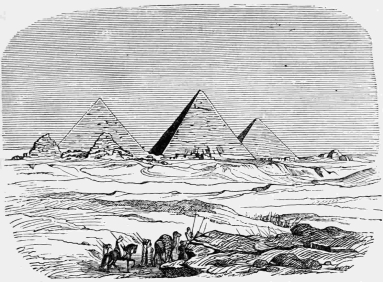
Fig. I.—The Pyramids of Gizeh.
IT is a curious chance that the most ancient monuments of human civilization should stand upon a land which is one of the youngest geological formations of our earth. The scene of that artistic activity made known to us by the oldest architectural remains of Africa and of the world was not Upper Egypt, where steep primeval cliffs narrow the valley of the Nile, but the alluvion of the river’s delta. It would be difficult to decide whether the impulse of monumental creativeness were here first felt, or whether the mere fact of the preservation of these Egyptian works, secured by the indestructibility of their construction as well as by the unchangeableness of Egyptian art, be sufficient to explain this priority to other nations of antiquity—notably to Mesopotamia. Although no ruins have been found in Chaldæa of earlier date than the twenty-third century B.C., it is not at all impossible that remains of greater antiquity may yet come to light in a country which is by no means thoroughly explored. Nor should we deem the oldest{2} structures now preserved to be necessarily those first erected. The perishable materials of the buildings which stood in the plains of the Euphrates and Tigris, generally sun-dried bricks with asphalt cement, were not calculated to insure long duration, or to prevent their overthrow and obliteration by the continual changes in the course of these rivers, through the silting and swamping of their valleys. Yet, though tradition would incline us to assume that Chaldæan civilization and art were the more ancient, the oldest monuments known exist upon the banks of the Nile.
The changeless blue of the Egyptian sky, the strictly regular return of all the natural phenomena connected with the Nile, that wonderful stream of the land’s life, are entirely in accord with the fixedness of Egyptian civilization in all its branches. Though the high state of advance which we first find in Egyptian art, three thousand years before the Christian era, must necessarily have been preceded by less perfected degrees, it is wholly impossible to perceive such stages of development in any of the monuments known. After Egypt had attained a certain height of civilization, its history, during the thousands of years known to us, shows none of those phases of advance or decline, of development in short, to be observed in Europe during every century, if not during every decade.
The Egyptian completed buildings and statues begun by his remote ancestors without the slightest striving for individual peculiarity. He commenced new works in the same spirit, leaving them for similar execution by his great-grandchildren. Numberless generations thus dragged on without bequeathing a trace of any peculiar character and ability. It is only by the cartouches of the kings in the hieroglyphic inscriptions that it is possible to separate the dynasties, and to group into periods of a thousand years or more, works of art which seem from their style to belong to one and the same age. What gigantic revolutions have affected the civilization of Europe during the fourteen centuries elapsed since the overthrow of the Roman Empire, and how slight are the appreciable changes during the nearly equal number of years of the ancient dynasties of Memphis—the period of the pyramids, or again of the Theban kingdom—from the seventeenth dynasty to the rule of the Ptolemies!{3}
The true age of the monuments of Lower Egypt has not long been known. When Napoleon I. fired the spirits of his troops before the Battle of the Pyramids by the well-known words “Forty centuries look down upon you from the heights of these pyramids,” he must have been aware that, according to the conceptions of the archæological science of the time, he was exaggerating. In fact, however, he was far behind the truth. The pyramids of Abousere, possibly also those of Dashour, are of the third dynasty (3338 to 3124 B.C., according to Lepsius), those of Gizeh of the fourth dynasty of Manetho (3124 to 2840 B.C.). These are structures which have stood for five thousand years. The pyramids of Cochome, referred to as the first dynasty of Manetho, are still older, dating from a time nearly coincident, according to Biblical authority, with the creation of the world itself (3761 B.C.).
It is true we are still so far from chronological certainty that dates often differ astonishingly. Osburn, for instance, places the fourth and fifth dynasties as late as the period between 2228 and 2108 B.C., and notably the two kings of the fourth dynasty, Shofo and Nu-Shofo, about 2170 B.C. The first twelve dynasties of Memphis, dated by Lepsius about 3892 to 2167, and by Osburn as late as 1959 B.C., are now known principally by their monumental tombs. Among these, the sepulchres of the kings are prominent in like manner as the ruler in an absolute and theocratic monarchy is elevated above his subjects.
The enslaved people labored upon the monuments of their masters, often during the entire lifetime of these latter. It may be seen from contemporary wall-paintings that the discipline maintained during the work of construction was not lacking in strictness, but it was certainly not that excessive oppression generally imagined. A body of over one hundred thousand workmen sorely oppressed might, even in Egypt, have been difficult to manage by a hated despot. It was principally during the annual inundations of the Nile that the kings employed and fed the poorer classes, at that time, perhaps, unable otherwise to subsist. During other seasons the rulers could not have taken the tillers of the soil from fields and flocks without great injury to their own interests. It is no mark of a selfish despotism, which builds without reference to the welfare of{4} land and subjects, that the kings removed their enormous sepulchral piles from the vicinity of their residences—from the valuable alluvion of the Nile to the barren edge of the desert. They thus, as Plato recommends, occupied no place with dwellings of the dead where it would be possible for the living to find nourishment. The fertile ground of the valley was not encumbered by the colossal pyramids, which were so numerous in ancient Egypt that Lepsius found the remains of sixty-seven in the forty-eight kilometers alone between Cairo and the Fayoum, on the western bank of the river. Supposing only five score such pyramids, with an average area of one hundred ares each, two elevenths of that of the great pyramid of Gizeh, to have stood in the narrow valley of the Nile, what an enormous loss in the grain production of that most fertile but limited land would so great a reduction of arable surface have caused during the past five thousand years!
The fundamental motive of the pyramid is the funeral mound. A small upheaval above the natural level of the ground results of itself from the earth displaced by the bulk of the buried body. Our present practice of interment clearly illustrates this. Increased dimensions elevate the mound to an independent monument. Many nations, some of a high degree of civilization, have contented themselves with such imposing hills of earth over the grave,—tumuli, which, from the manner of their construction, assumed a conical form. Others placed the mound upon a low cylinder, thus better marking its distinction from accidental natural elevations. The Egyptians and the Mesopotamians rejected the cone entirely, and formed, with plane surfaces upon a square plan, the highly monumental pyramid. Peculiar to the former people are the inclined sides which give to the pyramid its absolute geometrical form, as opposed to the terraced structures of Chaldæa. The sand of the desert ebbed and flowed fifty centuries ago as constantly as in our time, when the sphinx, after being uncovered to its base, has been quickly hidden again to the neck. Rulers, unwilling that their gigantic tombs should be thus submerged, were obliged to secure to them great height, with inclined and unbroken sides, upon which the sand could not lodge.
The typical pyramid of Gizeh, near Cairo—the monument of{5} Cheops (Shofo, Suphis), the first or second king of the fourth dynasty—rises above the broad necropolis of Memphis, by far the largest and one of the most marvellous works of mankind. (Fig. 1.) With a ground-line mean of 232.56 m., the great pyramid attained an altitude of 148.21 m., of which the entire apex is now overthrown, leaving a height of about 138 m.[A] The original intention of the builders was doubtless an absolutely square plan. The greatest difference in the length of the ground-lines of the base is 0.45 m. The angle of the upward inclination of the sides has been found, by measurements at various points, to average 51° 51´ 43´´. The entire pyramid is solidly built of massive blocks, pierced by a few narrow passages which lead to small chambers. (Fig. 2.) Like most of these monuments, the entrance is situated somewhat above the ground; it opens to a passage which descends with a gentle inclination. The shaft is covered with stones leaning against each other, so as to present the great resistance of a gable to the superimposed mass. In passing out of the masonry it is continued into the natural rock under the same angle, 26° 27´. Near the point of separation it meets with another passage, which ascends with an inclination of 26° 6´ to the centre of the structure, sending off a nearly horizontal branch at half-way. All three shafts lead to grave-chambers, the highest being the most important. As the ascent continues above the horizontal branch, its importance is emphasized by the passage being increased from 1.2 or 1.5 m. high to a corridor 8.5 m. in height, roofed by gradually projecting blocks, and having upon its floor a slide to facilitate the transport of the sarcophagus. Thereupon follows a horizontal vestibule, closed most securely by four blocks of granite which fell like portcullises. Only three of these had been let down; the fourth remained in its original position, the lower grooves never having been cut to allow its descent. The upper chamber, of polished granite, but otherwise not ornamented, is 10.48 m. long, 5.24 m. broad, and 5.84 m. high.[B] It is ceiled horizontally with nine colossal lintels of granite,{6} a detail which seemed at first surprising, as other voids of far less width were more firmly covered, either by projecting and gradually approaching stones, as in the ascending corridor; or with blocks leaned together so as to form a gable, as in the other passages, and in the middle chamber, called that of the Queen. Yet it was for the security of this upper chamber that the greatest care proved to have been taken. The weight of the half-height of the pyramid remaining above it was by no means allowed to rest upon its horizontal lintels. There are above them five low relieving spaces separated by four stone ceilings similar to the first; mighty blocks are inclined over all these to a gable triangle. In case of rupture the horizontal beams would of themselves have formed new triangles and prevented direct downward pressure. Cheops certainly did not need to fear the ceiling of his chamber falling in upon him. Ventilation was provided for the room by two narrow air-channels, which, inclining upwards, took the shortest course to the outside.{7}
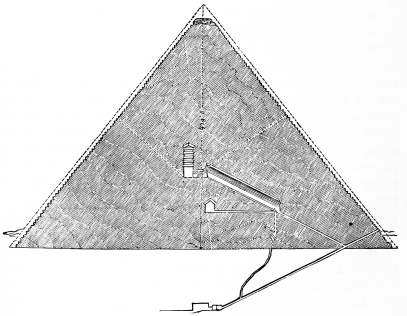
Fig. 2.—The Great Pyramid of Gizeh. Section North and
South, looking West.
The perfectly geometrical form of the pyramids of Gizeh has from early times led to speculations upon their having been erected in conformity with mathematical or astronomical calculations; and endless attempts have been made to discover the fixed proportions which they are supposed to embody, and to determine their symbolical or metrical significance. Too much is often assumed upon the strength of accidental coincidences, generally only approximate; but if such proportions indeed existed, whatever may have been their intention, they are evidently beyond the true province of art.
The second great pyramid, built by the successor of Cheops, Chephren (Sophris), seems not to have been so regular in its interior arrangement. The third, that of Chephren’s successor, Mykerinos (Menkera), is of the most beautiful execution. The unevenness of the ground was so considerable that a substructure of masonry was here necessary. The entire kernel is of rectangular courses of stone, and, with the exception of the exterior casing, is built in the form of steps. This manner of construction was employed in most of the pyramids, but is here particularly noticeable. The casing of granite, highly polished, is still partly intact; the joints of its stones are scarcely perceptible, and are not wider than the thickness of a sheet of paper.
The mechanical excellence of all these pyramids is indeed wonderful; they remain as a marvellous proof of the constructive ability of man in ages far anterior to known periods of the world’s history. Nor are they mere piles of masonry which could have been erected by an enslaved people without the guidance of skilled and thoughtful designers. The arrangement of the passages, of the chambers and their portcullises, of the quarried stone and polished revetment, was admirably adapted to the required ends.
In the third pyramid two corridors have been found, one above the other. The upper, opening within from the first chamber, at some height above the floor, does not reach the exterior surface, but ends suddenly against the unpierced outside casings. This peculiarity is explained by, and in turn gives weight to, the statement that this pyramid, as originally built by Mykerinos, was considerably smaller than it is at present, measuring, according to the end of the unfinished upper corridor, 54.86 m. on the side of the{8} plan, and 42.20 m. in vertical height. Nitocris, the last queen of the sixth dynasty, prepared the pyramid to serve also as her own monument by adding courses of stone which increased these dimensions to 117.29 and 66.75 m. respectively. But as the original entrance, by the prolongation of its inclined line outward, would thereby have opened much too high above the ground, a new corridor beneath the first was rendered necessary. The second chamber, which probably once contained the sarcophagus of the queen, was found entirely plundered. The third and lowest, better protected, had been opened; but in it there still remained in position a magnificent coffer of basalt. The exterior of this sarcophagus was sculptured with lattice-work in imitation of a palace-like structure with portals. Fragments of the wooden coffin, with carved hieroglyphics, once within it, and of the mummy itself, were flung about the room. The sarcophagus, of the greatest value as illustrating the architectural forms of its time, sank in the Mediterranean with the ship which was carrying it away to England. The mummy and the lid of the coffin are in the British Museum. Hieroglyphics upon the latter designate the venerable remains as those of King Menkera, the same Mykerinos whom Herodotos, following traditions of the Egyptian priests, mentions as one of the best rulers of the land. The stone ceiling of the Mykerinos chamber was at first thought to be vaulted, it having the form of a low pointed arch. This peculiarity proved, however, to be due to a hollowing-out of the inclined gable blocks.
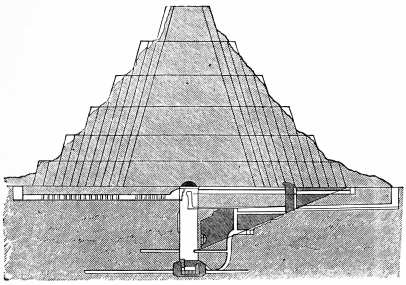
Fig. 3.—Section of the Great Pyramid of Saccara.
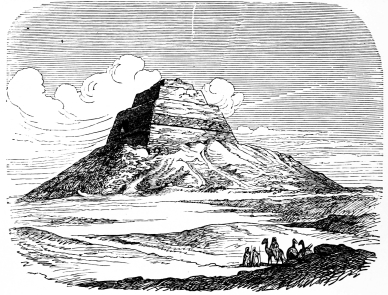
Fig. 4.—The Pyramid of Meydoun.
Princes and princesses of these early dynasties appear to have been buried in smaller pyramids, like those which stand in groups of three near the first and third great pyramids of Gizeh. Prominent subjects were allowed to take a place in the royal necropolis; but their pyramids were always truncated, in form resembling the Egyptian footstool—the pyramidal point remained the peculiar privilege of the kings. It appears to have been customary to commence all these structures with a few large terraces of masonry, which were not fully developed into the perfectly pyramidal structure until the last stones, the revetments, were put in place. These terraces generally had vertical sides. Occasionally this construction was varied by being formed with sloping sides, which{9} repeated the obtuse ascending angle of the footstool, so that the separate steps, elsewhere with a vertical rise, were here somewhat inclined. It is not certain whether the absolute pyramidal form was always intended to be carried out upon the completion of these latter monuments. The examples of the inclined terraces which have been preserved rather seem to show that various attempts were made to develop architecturally upon the exterior the peculiarity of its inner construction. The arrangement and line of the kernel were more or less strictly adhered to, so that the last course of facing-stones showed the original angle of the interior masonry. The increasing of the terraces by successive courses—coats, as it were—seems to have been generally continued as long as the reign of a Pharaoh would permit. The layers, when inclined, were most numerous at the foot of the pyramid, decreasing in number as they ascend, that the mass might not take the proportions of a tower. This manner of building is displayed by the section of the first pyramid of Saccara (Fig. 3.), which, if the courses had been continued in equal number, would have reached a height of at least one hundred and fifty meters, instead of the 57.91 m. effected by its terrace-like{10} contractions. The pyramid of Meydoun shows that this contraction did not necessarily take place in regular and equal steps. (Fig. 4.) There the layers were added, without decreasing in number, to a considerable height, when the structure was quickly completed by broad and low terraces. Similar to this must have been those pyramids which ended in a platform and served as the mighty pedestals of colossal figures, described by Herodotos as existing in Lake Moeris. A remarkable variation from these forms is finally to be noticed in the stone pyramid of Dashour. (Fig. 5.) Rising at first with steep inclination, 54° 14´, it changes its slant at half-height to reach, with a smaller angle, 42° 59´, a more rapid conclusion. This artistically unfortunate form seems to have been owing to a change of plan during the execution of the work; it was doubtless originally designed to have been finished like the pyramid of Meydoun. It is hardly necessary to seek the origin of the double angle in the analogous obtuse termination of Egyptian obelisks. This pyramid of Dashour is further remarkable on account of its magnificent revetment of polished Mocattam limestone, which is almost entirely preserved.{11}
There is as great a difference in the material as in the form of the pyramids. As early as the third dynasty King Asychis (Asuchra) built a pyramid of what Herodotos terms Nile mud; that is to say, of sun-dried bricks. It is not improbable that the great pyramid of Dashour may be identified with this. Besides this peculiarity of material, it is of unusual construction, not having been immediately built upon the natural ground, but standing on a thick layer of sand, which, enclosed by retaining-walls, forms an excellent foundation.
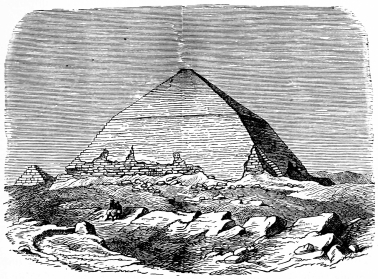
Fig. 5.—Southern Stone Pyramid of Dashour.
One of the group of pyramids at Abousere is built of rubble-stones, quarried from the high plateau of the desert itself, and roughly cemented with Nile mud. The builder of this irregular masonry held it the more necessary to insure the ceiling of his grave-chamber with the greatest care, and three gables of stones, 10.90 m. long and 3.66 m. thick, provide a resistance as sufficient against the imposed mass as does the sixfold roofing of the King’s Chamber at Gizeh. (Fig. 6.) The exterior layers were carefully constructed of blocks from the quarries of Tourah. Immense dikes, forerunners of our modern causeways, led from these quarries to the buildings at Abousere.{12} Although intended only for the conveyance of materials, they were yet so firmly built that they exist at the present time. Egyptian wall-paintings show in the clearest manner the transportation of colossal monolithic statues along these ways upon sledges, either moved upon rollers or dragged over an oiled slide, as in Fig. 7. The pyramid of Illahoun, like the northern pyramid of Dashour and others, is built of brick; its masonry was additionally strengthened by walls of stone, the thickest being upon the diagonals of the plan. The pyramid of Meydoun is built of alternate horizontal courses of variously quarried stone. The following are the most important pyramids still standing, with their dimensions in meters:
| Name of Pyramid. | Original Height. | Present Height. | Side of Plan. | Angle of Ascent. | |
| 1. | Great pyramid of Gizeh | 148.21 | 137.34 | 232.56 | 51° 52´ |
| 2. | Second pyramid of Gizeh | 139.39 | 136.37 | 215.09 | 52° 21´ |
| 3. | Northern stone pyramid of Dashour | 104.39 | 99.49 | 219.28 | 43° 36´ |
| 4. | Southern stone pyramid of Dashour | 103.29 | 97.28 | 187.93 | {above 54° 14´ {below 42° 59' |
| 5. | Pyramid of Illahoun | — | 39.62 | now, 170.69 | — |
| 6. | Pyramid of Meydoun | — | 68.40 | now, 161.54 | 74° 10´ |
| 7. | Northern Pyramid of Lisht | — | 20.85 | now, 137.16 | — |
| 8. | Pyramid of Hovara | — | 32.31 | 116.92 | — |
| 9. | Northern pyramid of Lisht | — | 27.31 | now, 109.73 | — |
| 10. | Southern brick pyramid of Dashour | 81.46 | 47.55 | 104.39 | 57° 20´ |
| 11. | Great pyramid of Abousere | 69.39 | 49.99 | 109.60 | 51° 42´ |
| 12. | Third pyramid of Gizeh | 66.83 | 61.87 | 77.04 | 51° 10´ |
| 13. | Northern brick pyramid of Dashour | 65.25 | 27.43 | 104.34 | 51° 20´ |
| 14. | Great pyramid of Saccara | 61.06 | 57.91 | E. × W. 120.02 N. × S. 107.01 | 73° 30´ |
| 15. | Pyramid of Abou-Roash | — | — | 104.39 | — |
The Nubian pyramids on Mount Barkal and in Meroe, far more numerous than those of Lower Egypt, have lost much of their interest since investigations have shown that the civilization of Egypt and the prototypes of monumental art did not descend from Nubia, as was at first supposed, but arose in the delta and advanced up the stream. Inscriptions prove these pyramids to be some three thousand years younger than those of Memphis, dating them at as recent an epoch as the beginning of the Christian era. They are generally grouped in an extended necropolis, and differ from those of the ancient kingdom by a steeper angle of elevation, by a roundel-moulding upon the angles, and, above all, by much smaller dimensions.
Though the truncated pyramidal form, as has been seen in a{13} number of tombs at Gizeh, was not excluded from the funeral architecture of Egyptian subjects, it was never general. Rock-cut tombs were much more customary. The upright cliffs which border the banks of the Nile led naturally to such a formation, and in their sides are excavated caverns of very different dimensions, from the prevalent small, square chambers, with a narrow entrance high above the level of the valley, to the most extended series of rooms.
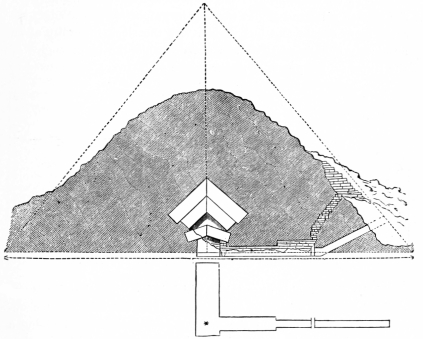
Fig. 6.—Section of the Middle Pyramid of Abousere.
These tombs were commonly decorated by mural paintings alone, but occasionally by carved architectural details, which always represent a wooden sheathing of slats or lattice-work. The larger chambers, even of the most primitive period, have the roof supported by square piers.
It is from these piers that the Egyptian columns seem to have originated, dividing from the outset into two classes and developing in different directions.{14}
One class of columns arose from chamfering the corners of the square pier, this support being thus transformed into an eight-sided, and, when the proceeding was repeated, to a sixteen-sided, shaft. The first phase of change, with its octagonal plan, was simple and advantageous—a predominance of vertical line was secured to the support, as well as greater room and ease of passage to the chamber. The second, the sixteen-sided figure, offered but few new advantages; on the contrary, the play of light and shade between the sixteen sides and angles was lost in proportion as the edges became more obtuse and less visible. As the sleek rotundity of an absolutely cylindrical shaft was not desirable, the blunt angles of the sixteen-sided prism, of rather coarse stone, were emphasized to avoid the disagreeable uncertainty which is felt when the plan is undecided between a polygon and a circle. This was effected by channelling the sides, making the arris more prominent and giving a more lively variation of vertical light and shade. The pier thus maintained, in some degree, its prismatic character while approaching the cylinder, and the channelled column arose.
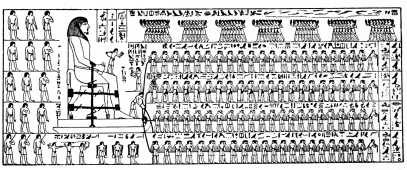
Fig. 7.—Transport of a Colossus. Egyptian
Wall-painting.
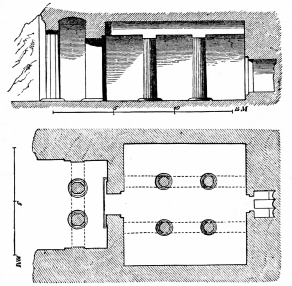
Fig. 8.—Section and Plan of the Northernmost Rock-cut
Tomb at Beni-hassan.
Rock-cut tombs of the twelfth dynasty (2380-2167 B.C., according to Lepsius) situated at Beni-hassan, and part of the necropolis of the ancient Nus, a city early destroyed, show the polygonal pier in the two phases of eight and sixteen sided plan. The most northern of these has the octagonal unchannelled pier in the vestibule, and the sixteen-sided channelled column within. Only fifteen channels are executed on the latter, the sixteenth side being left{15} plane for the reception of a painted row of hieroglyphics. Both exterior and interior shafts have a base like a large flat millstone, which projects far beyond the lower diameter of the column, its edge being bevelled inward. A square abacus plinth is the only medium between shaft and ceiling, the two columns of the vestibule lacking even this. A full entablature did not exist in the interior, as a representative of the outer edge of roof and ceiling there would naturally have been out of place. The northernmost tomb has no distinct entablature carved upon the exterior; but its neighbor (Fig. 9.) shows, cut from the solid rock, a massive horizontal epistyle above the columns, and upon this the projecting edge of the ceiling, which appears to consist of squarely hewn joists. Lattice-work was found represented upon the stone sarcophagus of Mykerinos. Here the model of a wooden ceiling is truthfully imitated upon the rock. As, in the flat coverings of rainless Egypt, roof and ceiling appear one and the same, this entablature has but two members—epistyle and cornice; while the frieze, in Greek architecture the representative of a horizontal ceiling beneath the inclined roof, does not here exist.{16}
This order of architecture, called, because of the similarity of the shaft, the Proto-Doric, was predominant in the ancient kingdom. But at least as early as the twelfth dynasty another class of columns was in use which had been developed in an entirely different manner. The Proto-Doric columns originated from the mathematical duplication of the prismatic sides and angles of the square pier; these second made the same pier their model, but followed its painted ornament, not its architectural form. The primitive designer enriched his work with flowers, striving to preserve the quickly fading natural decoration by an imperishable imitation. Many of the bands of ornament customary in antiquity may be considered as rows or wreaths of leaves and flowers, although often they do not betray their derivation at first sight, because of the original imperfect representation of nature, the subsequent strict conventionalization, and final degeneracy into formalism.
In Egypt, ornamental adaptations of the lotos-flowers of the Nile appear at first in long, frieze-like rows, the blossoms being bound together by the stems in much the same arrangement as similar decorations in Assyria, or the better conventionalized anthemion friezes in Greece. When this horizontal ornament was transferred to the narrow vertical sides of a pier, it was necessary to place the flowers closely together, to lengthen the curled stems and bind them; in short, to form of the wreaths, which had answered for the narrow band, a bouquet better corresponding to the tall, upright space to be filled.
Such a bunch of long-stemmed lotos-buds is shown upon the pillars of the tombs near Sauiet-el-Meytin (Fig. 10.), which, certainly of the ancient kingdom, were probably of the sixth dynasty. This bouquet may have been as customary an ornament for the pier as the garlands of lotos-flowers were for the frieze.{17}
The history of architectural decoration shows that the stone-cutter’s chisel everywhere followed in the footsteps of color. The four sides of the pier bore the same painted flowers; if these were to be sculptured, nothing could be more natural than to carry them from four-sided relief into the full round, where they offered the same face to all points of view, and transformed the painted pier into a column formed like a bunch of lotos-blossoms. This development must have taken place early in the ancient kingdom, for we find the floral column in the same tombs of the twelfth dynasty at Beni-hassan which show the so-called Proto-Doric shaft in its various phases. Form and color so work together in the floral column as to leave no doubt of the fundamental idea having been the bunch of lotos-buds painted upon the sides of the pier. Four stems of rounded profile are engaged, rising from a flat base similar to that of the polygonal column. They are tied together under the buds by fivefold ribbons of different colors. Above these the lotos-flowers spread from the stems, showing between their green leaves the opening buds in narrow slits of white. The flowers of the painted bouquet (Fig. 10.) are spread apart; but in the sculptured column they are necessarily united, forming the capital. Even the little blossoms with short stems, represented upon the painting of Sauiet-el-Meytin, are not neglected, although the calyx itself has become much smaller, owing to technical reasons of the execution.
Beni-hassan proves that the two orders, the channelled polygonal shaft and the lotos-column (Fig. 11.), had been developed as early as the twelfth dynasty; but as columnar architecture was not general in the ancient kingdom, the examples preserved are isolated. The little temple of that age discovered by Mariette Bey near the great sphinx of Gizeh shows no trace of columns, their place being supplied{18} by monolithic piers. The period between the twenty-second and the sixteenth century B.C., during which the Nile-land was occupied by the nomadic Hycsos, the shepherd kings, enemies to all civilization, was not favorable to the further application and development of architectural genius. The columns do not again appear until the advent of the new Theban kingdom with the eighteenth dynasty (1591 B.C., according to Lepsius), when they were extensively employed, especially in temples. It was then that the typical forms of the orders were determined. The Proto-Doric, the channelled polygonal column of the tombs at Beni-hassan, fell into disuse. Its simplicity suited neither the desire for richness of form, peculiar to the later Egyptians, nor the delight in polychromatic ornament, which found only one unchannelled strip at its disposal.
The polygonal shaft received, in certain measure, a new lease of life by the invention of a necessary part, a capital in place of the meagre abacus plinth which had formerly been the insufficient medium of transition between the upright support and the horizontal entablature. The vegetable prototype was deserted, and a female head, or rather a fourfold mask about a cubical kernel, crowned the shaft, being surmounted by an ornament somewhat resembling a chapel. The column thereby became similar to a Hermes, or to a caryatid figure of Janus Quadrifrons, as it were. (Fig. 12.) But the representation of the deity Athor had only a limited application, and seems to have prevented the column from being generally employed.
A far wider field was opened to the floral column, which in its architectural and ornamental development was removed further and further from its original model. The changes were brought about in two ways, the most direct alterations being effected by the sculptor. The four buds and stems of the lotos-columns of Beni-hassan were increased to eight; the latter changed their round cylinders to angular prisms, thus giving up much of the vegetable character. The former straight and stiff shaft, rising directly from the base, was{19} curved near the bottom by a short swelling, which suddenly increased the diameter. This entasis was surrounded by a row of leaves, again characterizing the ascending bundle as stems. Leaves were also added at the foot of the buds, these being out of place and impairing the consequential development expressed in the column of Beni-hassan, though corresponding well enough with the treatment adopted for the similar enlargement at the foot of the shaft. The four little flowers, which were tied in by the bands of the Beni-hassan column, naturally became eight in number with the duplication of the stems and blossoms. They were before much diminished in size, but here became an entirely unorganic, rectangular ornament. The binding ribbons of the neck retained their original variegated colors; but the painting of the capital itself put aside every likeness to the natural colors of the flower. (Fig. 13 a.)
An entirely picturesque transformation also affected the lotos-column, and led to the second phase of its development. The stone shaft was cut cylindrically, the memberings being omitted and all reminiscences of stem and bud being abandoned. The wreaths of leaves remained at the lower end of the shaft and of the capital, as did also the binding ribbons with the little flowers, which were still more broadened and distorted. The rest of the column gave space for painted, or rather coilanaglyphic, representations of devotional acts, for the cartouches of the kings and for hieroglyphic inscriptions (Fig. 13 b.) The capital, which had before consisted of four and of eight buds, became consolidated to a single one; the binding ribbon of the neck was retained without a function. It was the more natural to open the single bud to the calyx of a flower, a graceful and satisfactory solution of the problem which retained its sway henceforth in Egypt much as the Corinthian capital, so nearly related in form to this Egyptian calyx, predominated over other Roman varieties. The{20} shaft and the ribbons remained, as in the painted column of the Memnonium. (Fig. 13 b.) So also did the row of leaves at the base of the capital; the little flowers were entirely omitted, and the upper part of the calyx was thickly covered with royal seals painted between upright ornaments, so small that their line does not affect the composition of the whole. (Fig. 14.) A discord resulted from the retention of the abacus plinth of the former bud capital in its original proportions, a defect which in some degree defeated the æsthetic advantages of the boldly projecting calyx as a medium between the vertical support and the horizontal mass above it.
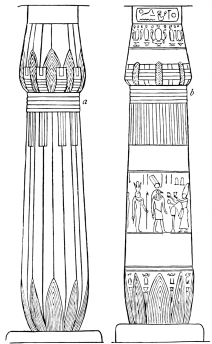
The calyx capital attained no typical and established form in Egyptian architecture, even as the Corinthian capital received no formal development in the Hellenic art which originated it. The decoration of the calyx continued to offer a wide field for the inventive talent of the Egyptian architect, which was here employed with most fortunate results. The ruined buildings, especially of later periods, show hundreds of different capitals, from the simplest upright forms of the papyrus to elaborately turned and rolled leaves; these floral ornaments being almost always composed and conventionalized with admirable taste.
A decided advance was made by separating the upper edge of the calyx, with notches, into four large petals, although the decoration did not have sufficient influence to affect the column as a whole. The most satisfactory among the varieties of the floral column, and that most thoroughly carried out, was certainly the palm; the capital{21} of which was characterized as a crown of leaves, and the shaft, by an imitation of the bark, as a palm-stem. The tall leaves rendered a greater height of the palm capital necessary; thus increased, it most closely approached the Corinthian in beauty of outline. The division of the great calyx into eight lobes was another result of this decoration. As the palm capital was frequently placed among others, especially by the Egyptians of later periods, it naturally had the effect upon the varieties to be brought into harmony with it of lowering the necking of their shafts in the same measure as had been necessary for itself. (Fig. 15.)
The slender proportions prevalent during the time of the Ptolemies caused the abacus plinth upon the calyx to be heightened to a cube, and even increased to twice the height of the capital itself, in which case it was ornamented by the heads of Athor and Typhon, or by the entire dwarfed figure of the latter. In rare cases, piers take the place of columns in the temple courts, and are masked by statues of Osiris or of Typhon. (Fig. 16.) These figures have of themselves no constructive function as supports, and are not to be classed with the caryatides and telamones of Greece.
The great variety of form in the column and capital is not shared by the entablature. This consists, as seen at the tombs of Beni-hassan, of two members. The lower stretches from pier to pier, or from column to column, as a connecting epistyle. The upper, representing the horizontal ceiling, reposes thereupon, and is crowned by the universal cornice-moulding—a boldly projecting Egyptian scotia. Between these two members there is a continuous roundlet, often characterized, by its ornament of an encircling ribbon, as a bundle of reeds. The cornice is sometimes marked by rows of reed-leaves{22} bent forward at the top, the epistyle covered with hieroglyphics. In later times, the decoration of the entablature became more florid, repetitions of the uræos serpent appearing as a cornice ornament.
The columns of the new kingdom had, meanwhile, been given up in the rock-cut tombs, where they first occurred. Yet the cavern sepulchres themselves remained so much in vogue that they even served the kings of the Theban dynasties in place of pyramids. Their tendency was rather to burrow deeply into the cliff than to create large sepulchral chambers, where the support of columns would have been necessary. The principal intention of the excavators—to make the royal burial-place as inaccessible as possible—was adverse to any monumental development of the interior. The decoration was restricted to paintings upon the long and repeatedly closed corridors, and sufficed only to rank these above the bare channels of the pyramids. The formation of the earth on the border of the desert offered no ground for the exterior architectural treatment of these graves, and a simple portal is generally all that designates the entrance to the shafts which were the sepulchres of the Theban dynasties. The plan of that at Biban-el-Moluc is given in Fig. 17.
The temples of the new kingdom with their numerous halls and courts offered, on the other hand, most ample scope for the application of columnar architecture. These extended series of{23} strangely enclosed rooms and courts, though richly decorated with paintings, would have seemed bare within and without if the column had not entered into their composition, and if the building had not been expanded and ornamented by its help. With the floral orders, the temple interior became an architectural organism truly deserving of study and admiration.
With exception of that portion of the structure which stood before the chief portal, and cannot be considered as an integral part of the building, every Egyptian temple was divided into three principal parts, contained within an oblong enclosure: namely, the court, the hall of columns, and the holy of holies—a series of cellas. (Fig. 18.) Long rows of sphinxes generally stand facing the avenue which leads to the entrance of the temple, and prepare for the sacred silence within. The doorway is flanked by two enormous towers, so-called pylons, formed like steep truncated pyramids. The walls of these masses of masonry, ornamented with coilanaglyphic paintings, show slots upon the front for the reception of the high flag-poles which are represented upon contemporary wall-decorations. The towers are crowned with the scotia cornice, the roundlet of which is continued down the angles. Within they are pierced by stairways and small chambers, scantily lighted by narrow slits in the wall. It is probable that the summits of these pylons, without doubt the highest standpoints in the valley of the Nile, served as observatories for the Egyptian astronomers and astrologers; a practical use was thus added to the original purpose of monumental decorative gate-ways. Two or four colossal sitting figures were generally placed before the pylons, and sometimes also two obelisks, bearing the dedicatory inscriptions of the temple.
The obelisks are among the most curious and characteristic structures of Egypt. They are very comparable to the pyramids,{24} and perhaps may even be regarded as small pyramids placed as an apex upon a tall shaft. Few deviate from this type; one of the obelisks of Carnac, crowned by a profile like a pointed arch, and the obelisk of Medinet-el-Fayoum with rounded end, are exceptions. The obelisks are monolithic. In consideration of the difficulty of procuring so large a block from the granite quarries, of transporting its enormous weight and erecting its tall mass, this peculiarity added greatly to the imposing effect of the monument. The delight of the later Roman emperors in the possession of obelisks caused many of these to be transported to Rome, where they still form prominent ornaments of the city. Most of those remaining in Egypt lie overthrown, and often deeply buried under the accumulating earth of centuries. The two before the Temple of Luxor were both erect until 1831, in which year one of them was removed to the Place de la Concorde in Paris. The removal during 1877-78 of an obelisk, and its erection in London, show what difficulties must have attended the quarrying, carving, transport, and elevation of these gigantic monuments in primitive times.[C]
The chief portal of the temple, flanked by the two pylons, opens upon the great peristyle court. The colonnades are upon two or three of its sides, seldom towards the entrance. In the most elaborate instances, as the Temple of Luxor, the court is bordered with double rows of supports—columns alternating with piers—before which stand the{25} above-mentioned figures of Osiris. Sometimes this peristyle court is duplicated, as in the great Memnonium of Ramses II. and the temples of Medinet-Abou and Luxor, the two spaces being separated either by smaller second pylons (Medinet-Abou), by a simple wall pierced by a gate (Memnonium), or by a narrow colonnade between them (Luxor). In such cases the architectural treatment of the courts differs, the second usually being more richly provided with columns and piers than the first. Smaller temples are often so built against these courts that they can be entered only from within them (Fig. 20.), while they project, with the greater part of their plan, beyond the chief enclosure.

Fig. 18.—Southern Temple of Carnac.
The second chief division of the building—the hall of columns, the hypostyle—is entered from the court, either directly or through new pylons. This space, generally not so deep as the outer peristyle, is entirely covered, the stone ceiling being upheld by close-standing columns, the number of which varies greatly according to the dimensions of the building. In the southern Temple of Carnac, the plan of which (Fig. 18.) may be regarded as typical of the usual Egyptian arrangement, eight columns are sufficient, while the dimensions of the hypostyle hall of Medinet-Abou render twenty-four necessary—a number increased to thirty-two in Luxor, forty-eight in the Memnonium of Ramses II., and to a maximum of one hundred and thirty-four in the Great Temple of Carnac. Smaller halls may have received their light through the portal. The upper half of the intercolumniations of the court colonnades was also occasionally left open, as shown by Fig. 19.; but, with the enormous dimensions of the hypostyle and the close ranges of shafts so frequent, a more perfect system of illumination was necessary. The light of day was procured for the hall by an eminently satisfactory arrangement,{26} which gives the key to the true manner of lighting any enclosed space from above—the clerestory—so effectively developed in later ages. The two rows of columns nearest the longitudinal axis were made half as high again as their neighbors, thus lifting their entablature and ceiling well above that of the remaining space. These two ceilings on different levels were connected by piers placed upon the next range of shorter columns, which supported the edge of the higher covering. The light entered between these piers, their openings being but little impeded by stone tracery. The central aisle was thus brilliantly lighted, and, under the cloudless sky, rays and reflections could find their way into the most remote corners of the forest of columns. As shown by Fig. 21., the larger central columns were distinguished by the broad-spreading calyx capital from the others, which retained the simpler forms of the folded bud. The effect of such a hall, especially of the great hypostyle of Carnac, must have been magnificently rich and imposing. The dimensions of the chief columns were in this instance gigantic. They were{27} 22.86 m. high. Their calyx capitals were 6.10 m. in diameter, the epistyle beams 6.70 by 1.83 by 1.22 m. The entire hall was 91.44 m. in length. Walls and columns were thickly covered with carved and painted decorations, which were kept well subordinated to the grand forms of the architecture, and were so blended by the varying light and shade that a rich and sober effect was produced by the somewhat gaudy colors.
One example, the Temple of Soleb, shows this second division of the building also repeated: that such a duplication was less common than that of the courts is explained by the far greater requirements of its construction. The last of the three chief temple divisions was reached from the hypostyle hall, either by a simple gateway or by a third pylon portal. The Egyptian priests performed their mystic rites and guarded the sacred animals in a{28} series of chambers, the innermost of which—the real temple cella—was exceedingly small in proportion to the entire building, being sometimes even cut from a single stone.
As the temple served the priesthood for a dwelling, a cloister-like arrangement of this third space was necessary. The long-accepted supposition that even the royal palaces were included in the temple enclosure has recently been questioned, although the hieratic character of the monarchy, and the strict religious ritual by which the life of the king in his function of high-priest was governed, even to the smallest particulars, would render this of itself not improbable. The plan of the Great Temple of Carnac shows the dwelling of the priests, with its halls and smaller rooms, separated by a court from the places of worship.
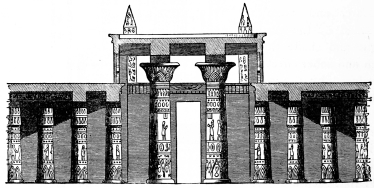
Fig. 21.—Section of the Hypostyle Hall, Great Temple of
Carnac.
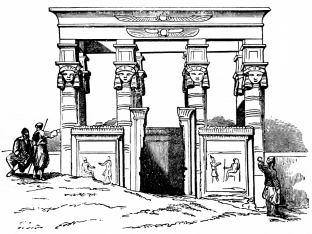
Fig. 22.—Chapel upon the Platform of the Temple of
Dendera.
Magnificently as the temple architecture of the Egyptians had developed since the eighteenth dynasty, its advance had mainly affected the interior. The temples of every other people were built with more or less reference to an imposing exterior effect, but those of Egypt generally remained the fortress-like enclosures which had become typical in the earliest ages of the land’s history. The peripteral plan, indeed, occurs in several small cellas of the ancient kingdom, but it was exceptional, and did not arrive at any systematic development. It has been seen that Egyptian architecture, though it chanced upon the channelled shaft of the Proto-Doric column, was apparently unable to utilize this motive, the great importance of which{29} was not recognized in the land of the Nile. The peripteral temple plan is a similar advance, which, not fitted for the requirements and tendencies of Egyptian architecture, lay dormant for centuries. The unbroken fortress-like walls of the temple were not pierced and resolved into the surrounding pteroma until the sceptre of Egypt had been swayed during three centuries by the semi-Hellenic Ptolemies. These rulers, warned by the example of Cambyses, were wise enough not to interfere with their Egyptian subjects in their most sensitive point of religious conceptions, rendered sacred by the traditions of thousands of years. But they did not hesitate to reintroduce into the land the exterior splendor of the peripteral plan, by that time so fully developed in Greece. The free and cheerful religious rites of the Greeks, performed before the temple, and not within it, agreed, as did the natural character of the people, with the peripteral temple, which was opened outwardly by its pteroma. It was otherwise with the mysterious and sombre precision of the Egyptian ritual, which demanded absolute seclusion. Though the peripteral temple plan was in some measure brought into vogue by the Ptolemies, it was, in Egypt, deprived of its chief characteristic—the freely opened intercolumniation. The Romans, in their desire similarly to combine columnar architecture with entire enclosure, merely decorated{30} exterior walls with engaged shafts and pilasters, giving up the columns as supporting members of independent function, and using them only as a suggestive ornament. This merely decorative treatment, rare in Greece, was not adopted in Egypt until the latest times. The Egyptian preferred to place a screen-like wall, half the height of the columns, in each opening; this hid all the interior from view, even when the building was of small dimensions, as in Fig. 22., and permitted the access of light and air through the upper half of the intercolumniation. The one used as an entrance was also closed by a door-frame of greater height than the side screens. Upon the corners of the peripteral building inclined piers were often retained, as a reminiscence of the original enclosure wall as well as for greater constructional security. This is shown by the Temple of Philæ. (Fig. 23.) That the arrangement of outstanding columns did not entirely supplant the closed surrounding walls is evident from the same plan, where both methods occur side by side in a group of buildings of the same date.
There were parts of the narrow valley of the Nile where the cliffs of the desert so advanced upon the river as to leave absolutely no room for the erection of temples occupying so much ground. The inhabitants here had recourse to grotto temples; that is to say, they transferred the principal rooms of the sanctuary to an excavation in the cliff. When the space between rock and stream permitted it, the courts and pylons were built, and only the hypostyle hall and the holy of holies, reduced to the minimum necessary for the performance of the rites, were cut from the rock. This is the case in El-Cab, Redesie, Silsilis, and Girsheh. The last of these, the largest, had a court with Osiris piers upon the sides and with four columns upon the front, which seems never to have been flanked by pylons. Its largest excavated space, apparently corresponding to a second{31} court, is also decorated upon the longer sides with Osiris piers. Thereupon follows a narrow hall, which but inadequately represents the hypostyle; and, finally, as the holy of holies, a small chamber with an altar.
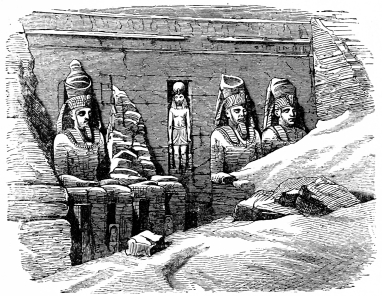
Fig. 24.—Façade of the Rock-cut Temple of Abou-Simbel.
Far more important than these are the grotto temples of Abou-Simbel, in the vicinity of the second cataract, where the portals are also cut wholly from the rock. The larger of the two even attempts to approach, as well as is possible, the enormous pylons of the great Theban temples. (Fig. 24.) To this end the gentle inclination of the cliff was cut away to the talus angle of the Egyptian walls and pylons, and the cornice above, of roundlet and scotia, was worked from the rock. Four such colossal sitting figures, as are often placed before the pylons, were also cut from the cliff—an effective ornament and an economy of labor thus being secured. The representation of the portal between two pylons was given up; the whole front formed one wall in which the entrance-door was cut without further decoration. The empty space above the opening was filled by a high-relief, carved within an oblong{32} niche. (Fig. 24.) The entrance, which has now been cleared of the sand, leads in natural order to a space corresponding to the court of the free-standing temples; it is somewhat similar to that of Girsheh, which was also erected by Ramses II., though more imposing and of better proportions. (Fig. 25.) A following room, the ceiling of which is supported by four piers, suggests the temple hypostyle, here much dwindled in extent from the difficulty of its excavation as well as from the general restriction of this space in Nubian monuments compared with those of Central Egypt. The innermost chambers of the holy of holies are not only as small as those of the free-standing temples, but are reduced in number.
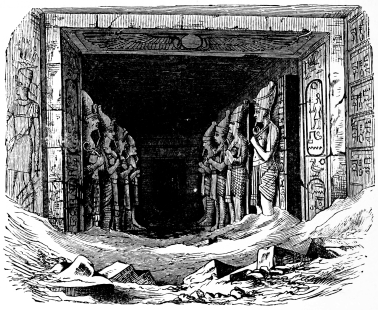
Fig. 25.—Hall of the Rock-cut Temple of Abou-Simbel.
The second rock-cut temple of Abou-Simbel, situated near the one described, is of smaller dimensions. It has upright colossal statues upon the front, which, instead of being cut in the round, have more the effect of reliefs from the fact that they stand in niches, a difference arising from the greater steepness of the cliff at{33} this point. The treatment appears rational in consideration of the smaller amount of material thereby removed, though the unmonumental effect of the reliefs, which lean with the inclination of the wall, is an unfortunate result of this economy. The first hall, analogous to the temple court, has its ceiling supported by six piers, which are decorated upon the side towards the central aisle by Athor masks. Three entrances lead from this hall into a narrow space, here entirely at variance with the character of a hypostyle, and through this into the holy of holies. Notwithstanding the contraction of the two inner departments, the three principal divisions of the free-standing buildings can be recognized in all rock-cut temples.
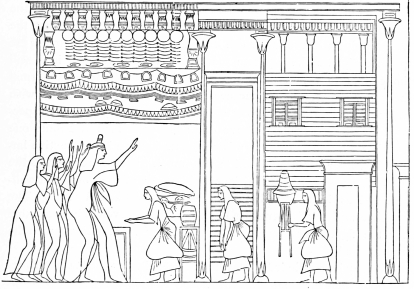
Fig. 26.—Interior of a House. Egyptian Wall-painting.
The existing ruins allow a comparatively clear understanding of the religious architecture of Egypt, in which class the monumental tombs must be reckoned as well as the various forms of temples; but we are left almost entirely uninstructed as to the nature of the private dwellings. The plan of the cloisters within the great temple of Carnac (compare Fig. 20.) is indeed clear, though, being{34} only a portion of a larger scheme, it had no individual or exterior expression. The manner in which these spaces were roofed and lighted is not evident.
The so-called royal pavilion of Medinet-Abou is a complete puzzle in its development of plan and assumed connection with other structures; it can only be held to prove that some private buildings were of several stories. Other peculiarities here noticeable are windows framed by lintels and jambs of enormous blocks, and rounded battlements above a projecting cornice.
Egyptian sculptures and wall-paintings often represent the interiors of well-to-do private houses and of palaces; they show the plans of dwellings and adjoining vegetable-gardens so well that the very products of the latter can be distinguished; but, though these plans designate the separate rooms and their entrances, it is still impossible to comprehend the general arrangement of a normal house, or its exterior appearance. The views of the interiors, with their slim columns and narrow entablatures, with a system of perspective which shows things above one another instead of behind one another, with their evident misrepresentations and constructive impossibilities, must have stood in very much the same relation to the Egyptian reality as the fictitious architecture of the Pompeian wall-decorations does to the buildings of the Greeks and Romans. The architectural details introduced by the painter served only as a frame for the figures or for the contents of the store-rooms which he represented.
It may be concluded that, when private dwellings were more pretentious than the single room necessary to provide the most imperative shelter, columns were not excluded from them; and, from the absence of any remains of these supports, it is probable they were of wood. The ruins and rubbish of sun-dried bricks, which compose the overthrown cities hitherto excavated, show that the great majority of dwellings were no more than low hovels.
Even palaces seldom went beyond a series of small chambers, and thus did not present an important architectural problem. This is illustrated by the gigantic labyrinth, famed in so many fables of antiquity, and somewhat known by the excavations of Lepsius in the Fayoum. (Fig. 27.) A great number of small chambers are here{35} grouped in three rectangular wings around an oblong space, which was probably divided into several courts. The walls remaining do not show that geometrical regularity of arrangement described by Herodotos, Strabo, Diodoros, and Pliny, but a really labyrinthic aggregate of small chambers, the destination of which is not clear. The pyramid which closes the fourth side of the square is alone of monumental importance. It seems possible that, instead of one or more palaces, we have here the remains of some city. It is certainly wrong to connect the work with the Dodecarchia (twenty-sixth dynasty, 685 to 525 B.C.): the twelve pretenders would hardly have united to erect a common monument. In the list of Manetho, Amenophis III., the sixth king of the twelfth dynasty, is mentioned as the founder, a notice corroborated by inscriptions discovered on the site.
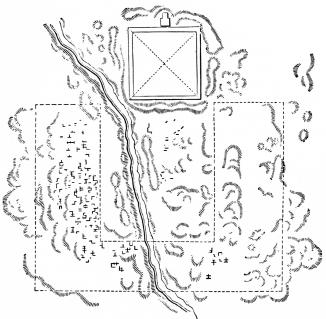
Fig. 27.—Labyrinth of the Fayoum.
That the private buildings were so unimportant in comparison with the religious architecture of Egypt is explained by the excessive{36} subjugation of the people to a monastic ritual, and by the favorable character of the Egyptian climate. It is necessity that prompts invention, and Egypt, with its ever-cloudless sky and constant temperature, required no protection against the inclemency of the weather; the climate did not force man to spend his days within doors, nor did it destroy the lightest shelter. In the absence of rain, the most primitive horizontal ceiling was sufficient. According to the religious conceptions of the Egyptian, it was more important for him to prepare a permanent house for his death-sleep—he had more at heart the protection of his corpse than of his living body. Thus thousands of graves have been preserved, while science cannot find a single dwelling remaining to betray even the general character of Egyptian domestic architecture. To these considerations it must be added that the dwellings stood in the valley of the Nile, and have been subjected to annual inundations which have formed a considerable alluvial deposit, while the graves were almost without exception situated upon the changeless cliffs that border on the desert.
The architecture of Egypt was practised in a manner to show almost no historical development—with the sculpture this is the case in still greater degree. The most ancient carved remains, which with reasonable security may be assigned to the fifth dynasty, show the formal system, retained during the subsequent twenty centuries, as already perfected. Even at that early date the network of lines, which the Egyptian sculptors (more as mechanics than as artists) followed down to the time of the Ptolemies, was already calculated and introduced as a canon.
Besides figures of the gods, the sculpture of Egypt is rich in the images of kings, queens, and prominent subjects; and in such portraits the observation of the living model, of the peculiarities of character which lead to the differences of exterior appearance, would seem to be a natural consequence. But as the individual disappeared in the mass of the Egyptian people, so the appreciation of individuality was almost wholly lacking in the Egyptian artist. Sculptors and painters worked without the least desire for pre-eminence in ability and distinction, without thought of perpetuating their names, and the work they produced expressed these{37} faults. As Brunn truly remarks, we can look upon whole rows of Egyptian sculptures without a question ever arising in our minds as to the authorship of this or that work, without observing that one is superior to the others, or that any were much above manufactures. The work became what the artist felt himself personally to be—a mere link in a monotonous chain. The result of this is that the statues generally represent an entirely abstract human being—not an absolute ideal, for that can hardly be said to exist in any art, but a type of the Egyptian race, well understood and unalterably repeated. As soon as the art had to a certain degree mastered the normal appearance of the human body, it contented itself therewith and came to a standstill. The peculiarities in the living model or in the attributed characters of the deities were rarely considered by the artist, who only distinguished by attributes what should be otherwise expressed; he did not attempt to show the effect of the mind upon the outer being, and thus to give to sculpture its true importance.
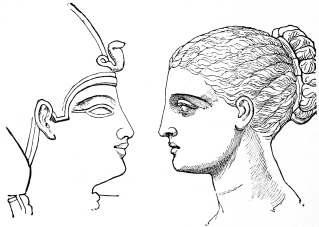
Egyptian Profile. Fig. 28. Greek Profile.
The description of single Egyptian works is consequently almost the same as the consideration of the entire sculpture and painting of the land—the more so as the artist not only employed generally one and the same conventional figure, but in position and movement mainly alternated between two types. The statues are, with a few exceptions, either sitting or in an act between standing and stepping, which does not appear to be an advance, because the feet are too near together; both soles being flat upon the ground, the centre of gravity falls between the two legs, almost more upon the one behind than upon the one before. A figure seems to move only when the body, advanced before the centre of its two supports, throws the greatest part of its weight upon the forward leg, and thus relieves the hinder foot, which, with uplifted heel, touches the ground with the toes, in readiness to be removed. Both sitting and standing statues have the arms pressed closely to the body—the former with bent elbows and hands resting flat upon the knees, the latter with arms hanging straightly and stiffly, the hands holding the so-called Nile key; or folded upon the breast, the hands grasping attributes, crook and plough or whip. Individual action is in every case excluded. If the formation of the body be more closely examined, the following peculiarities are remarkable: The head, as the{38} comparison of it with a Greek type at Fig. 28. shows, deviates so greatly from the normal oval that it could almost be drawn within a square, the principal line of the face being about parallel to the back of the head, as is the flat outline of the top of the skull to the line from the chin to the neck. The general directions of the eye, the mouth, and the ear are not perpendicular to the sides of the parallelogram, inclining too markedly upward; the comparatively large ear is placed half as high again from the throat as it should be. These deviations are in some measure explained by the peculiarities of race characteristic of the Orientals, and especially of the Egyptians—by the different formation of the skull and position of the eye. The forehead is almost straight, being on a line with the upper lip; and, as it recedes from the nose, does not project at all. It is rendered still more unimportant by the curved ridge of the brows lacking decision, and the eye itself wanting in depth. The eye has remained in the rough condition of a primitive imitation of nature—thick strips surround it in place of lids, and continue, the upper overlapping the under, beyond its exterior angle towards the ear. The gently curved, round, broad nose projects but little over the upper lip, which, instead of preparing the close of the oval towards the chin, is pushed forward like the lower lip, upward and outward. The closed, sensually broad lips are sharply outlined. The{39} corners of the mouth, slightly drawn upward, give, with the similar inclination of the angles of the eyes, a certain expression of smiling sarcasm not intended by the designer, and consequently cold and stiff. The chin is flat and pointed in profile, the line from it to the short and thin neck almost straight.
Such is the type that was retained through thousands of years, so unchangeably that even the sexes are scarcely to be distinguished by the heads. Male figures often have a kind of chin beard, cut at right angles, and bound on with ribbons which can sometimes be distinctly traced. The heads, and through them the whole figures, are characterized by head-dresses, referable to one fundamental form—the pshent, a high cap like a tiara; but they have been so modified from their prototype that the Description de l’Égypte, pl. 115, shows thirty distinct varieties.
The deities are frequently recognizable by the heads of animals—of a lion, ram, cow, ape, jackal, crocodile, hawk, or ibis, as the case may be. The worship of nature, peculiar to Egypt, found a better expression in these symbols than in the monotonous representations of man, in marked contrast to the incorporation of Hellenic myths, where, in the monstrous conjunction of human and animal forms, the human head was rarely given up, it being more generally placed upon the body of an animal.
The figure, as accepted by the Egyptian designer, was, to the smallest details, drawn according to a network of lines. Diodorus states it to have had 21¼ units in height, the unit being probably the length of the nose. The shoulders are drawn upward, and, like the flat breast, are broad; the hips, on the contrary, are narrow and weakly modelled: they are girded with a cloth which appears{40} carefully folded and adjusted, but, with all its tightness, does not fit the forms of the body. When upon sitting figures, this cloth often stands out as stiffly and straightly as if carved of wood, giving no indication of the true nature of its material. The lean arms are muscular, dry, and hard; the hands are rendered clumsy by the equally thick and almost equally long fingers. The legs are not powerful, and rather slim, indicating great elasticity, and, like all other parts of the body, the ability to endure great exertion. The knees are sharp and drawn with anatomical understanding; the feet are narrow and long, as are also the toes, which, lying in their entire length upon the ground, do not greatly differ in dimensions and form. In female figures the breasts are fully developed, the nipples being formed like a rosette; a closely fitting gown reaches from the broad neck-ornament, common with both sexes, to the ankles, but, being represented without reference to the material and without the most necessary folds, appears so elastic that its existence is only surely to be perceived at the borders.
The most ancient sculptures and the later works of Nubia are somewhat heavy and full, those of the best period (the time of Ramses) more slim and elastic. After the fifth century B.C. the figures become better modelled, and a certain influence of Greek sculpture is betrayed. But the ancient type remained in the chief characteristics unchanged until the end of the Ptolemaic dynasties, and even to the later ages of the Roman Empire. Those works of Greek and Roman sculptors, so popular during the age of Hadrian, which borrowed the costume and position of Egyptian{41} statues while having nothing else in common with Egyptian art (such, for instance, as the numerous figures of Antinous to be found in almost all the larger museums), must not be classed with the truly national works executed in Egypt and for that country.
The monotony of Egyptian sculpture was not without some exceptions. Less pretentious works, where the necessity of canonic idealization seems not to have been so imperative—as in the well-fed form of the so-called schoolmaster in the museum of Boulac (Fig. 30.), which shows not only in the head, but in the entire body, an undeniable portrait—make it questionable whether the conventionalized representations may not be more owing to the restraint of religious authority and tradition, to the hieratic laws which exercised so complete a sway over the life of the country in every respect, than to any absolute incapability of the Egyptian artist for individual characterization.
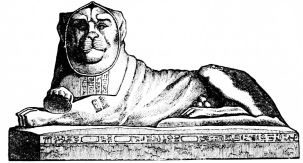
Fig. 31.—Lion of Reddish Granite. (British Museum.)
Egyptian sculpture, thus under the ban of religious conservatism, always dealt more successfully with the forms of animals than with human beings and deities. In hunting scenes there is wonderful spirit and character in the drawing of the dogs, and of the animals which they attack. The artist attained an elastic and life-like force in the representation of all animal forms, even when these were compelled into monstrous combinations with human members. The most common of the latter are the androsphinxes, which differ from the Greek sphinx in being male—having the head and breast of a man and the body of a crouching lion. At times the human head is supplanted by that of a ram or hawk. Rams were also{42} treated as sphinxes, especially before the temples of Ammon and Kneph. The most important androsphinx is the well-known colossus of Gizeh with the head of Thothmes IV. The heads of the sphinxes seem usually to have been portraits of kings. This gigantic guardian of the necropolis of Memphis, the most enormous monumental figure of the world, with space between the outstretched front legs for a chapel there built, is now again buried to the neck by the shifting sand of the pyramid plateau after having been excavated with great labor. Its face alone is 12.2 m. long. But it is in cases where the entire lion is represented without deformation that Egyptian sculpture attains its greatest perfection. (Fig. 31.)
A great majority of the Egyptian works of sculpture were cut with marvellous patience in the hardest materials, in variously colored granite, diorite, syenite, and basalt. Limestone and alabaster were rarely employed for colossal or life-size statues, but were used more frequently for works of smaller dimensions; these were also burned in clay with a surface of blue or green glazing, or were cut in more valuable stones, such as agate, jasper, carnelian, and lapis-lazuli. Enamelled clay idols were manufactured in great numbers; modern museums contain hundreds of these little figures of perfectly similar form. The so-called scarabæus is also very common—beetle-shaped bodies of clay, or of the above-named stones—with incised figures or hieroglyphics upon their lower surface. Such amulets were perforated and worn as beads, and were placed loosely in the coffins with the mummies.
The artistic manufacture of colored glass was extensive. Fine metal-work was less common, although ornaments of enamelled gold, silver, and copper of high artistic value have occasionally been found. Wood-carving was practised upon the mummy-coffins. Although the valley of the Nile did not produce large pieces of a satisfactory material, this lack was supplied by gluing together layers of palm or sycamore wood, and hiding the defects of this process by a painted priming of stucco. The coffins themselves are in so far works of sculpture as they represent upon the cover the form of the swathed body placed within them, and even show the face as exposed.
The sculpture of reliefs was less developed and less correct than{43} of the round. As the relief was always very low, and could not express the greater projections, the artist’s desire to represent the human body clearly and completely led to an unfortunate conflict between the profile and front view of the figure. While mostly drawn in profile, and showing particularly the head and legs in side view, which is the more favorable for representation in low-relief, the shoulders and breast are developed in the other direction, and are seen as from in front. It is only in this position that both arms are visible—an important consideration to the artist, whose object was solely to represent some action or attributes. It was also felt as a difficulty that in a relief of the side view the visible shoulder should project farther than any other part of the body, the breadth of the breast and arms being more than double that of the head. The primitive designer, to avoid these objections, resorted to a forced and clumsy torsion of the body, which may be noticed in the childhood of almost every art—in the Assyrian as well as in the most ancient Greek. The head, with exception of the eye, which was represented as in front, was taken in profile; shoulders and breast from in front, but arms and hands, as well as hips, legs, and feet, in profile again. The lower the relief, the less could the surface be modelled, and this led to a sharp demarcation of the outline, which exaggerated the peculiar leanness of the Egyptian race to a hard angularity.
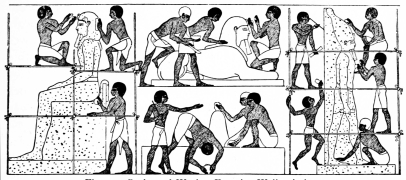
Fig. 32.—Sculptural Work. Egyptian Wall-painting.
The relief is a transitional stage between sculpture and painting; it works upon a more or less flat surface, seeks its chief effect in outline,{44} and lends itself readily to the heightening of color. The most common Egyptian relief, which has been termed coilanaglyphic, being hollowed out, stands even nearer to painting than to sculpture. In real reliefs the surface is so cut away as to leave the figures embossed; but here the forms do not rise above the background, and the original plane remains untouched: the sculptor contented himself with firmly incising the outlines, and slightly rounding the forms of the body within them. This incised outline is clearly seen only by sharp side light, but it has the advantage of protecting the borders of the figures and thus securing the indestructibility of the representation. In other respects the coilanaglyphics are nothing else than paintings, the space within the carved outlines being colored in the same manner as are all Egyptian wall decorations. The limits of the latter art were thus greatly extended, for all temples were covered with such colored coilanaglyphics, while the stuccoed sides of rock-cut tombs and of brick masonry were richly ornamented by paintings.
The number of ancient painted decorations which have been preserved is very great, notwithstanding their age and the perishable nature of all pigments exposed to air and light. The subjects represented and often repeated are, for the greater part, religious scenes, which share the monotony of the strict Egyptian ritual, though often allowing an interesting insight into the customs of interment, the transport of mummies by the processional boat, the sacred dances and sacrifices. Representations of profane scenes are more varied and are exceedingly interesting; the technicalities of Egyptian art are shown by the cutting of a monolithic palm-column, the polishing of a granite chapel, the painting of walls, the writing of hieroglyphics upon tablets and papyrus, the carving and painting of sphinxes and statues (Fig. 32.), the transport of a colossal figure upon a sledge (Fig. 7.), the making of bricks and walling of brick masonry, the interior of houses (Fig. 26.), even the plans of dwellings{45} and gardens. Besides numerous tools and the products of manufacturing trades, there may be recognized upon these paintings weavers, rope-makers, the preparers of paper and of linen cloth, ship-builders, carpenters with hand-saw and auger, and the cutters of bows and lances (Fig. 33.), who employ adzes quite similar to those still in use. Commerce on land and sea is represented by wares, unpacked or in bales, by scales, various kinds of wagons and trading vessels, etc., all shown in the clearest manner possible. Ploughs, sowing and harvesting, the gathering of figs and grapes, the pressing of oil and wine, illustrate the condition of agriculture; while the especial ability of the Egyptians for animal representations is exercised in the hunting scenes of lions, tigers, buffaloes, jackals, and gazelles; by the snaring of birds and fishes in nets, as well as by the admirably characterized figures of apes, porcupines, etc. There are also historical paintings, great battle scenes, the storming of cities, and the triumph of the returning victors, who bring with them booty and prisoners, the nationality of whom is often readily distinguishable by peculiarities of physiognomy and costume. (Fig. 34.) The Egyptian kings appear of superhuman size, either fighting from splendid war-chariots, or striding forward to sacrifice their kneeling enemies, a dozen of whom, seized at once by the hair, are decapitated at a blow.
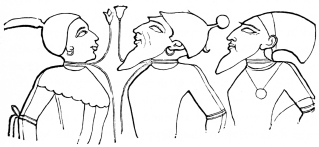
Fig. 34.—Prisoners of Different Nationalities. Egyptian
Wall-painting.
Extended and varied as these Egyptian representations were, and instructive as that which through their agency has been preserved now is, it yet must be confessed that the painting was more a conventional picture-writing than an art. The seven colors used{46}—red, blue, brown, yellow, green, black, and white—are, as a rule, applied simply, without mixture or variation, and without much reference to the appearance of nature. At least, it is very rarely that any striving after natural effect is to be noticed; that, for instance, the skin of a negress appears bluish-gray through a partially transparent white drapery, or that the typical red-brown complexion of an Egyptian, under similar conditions, is of a broken yellow. Within the sharply drawn outlines the colors are flat and without any modification by light and shade, upon the changing effects of which all pictorial illusion is based. This illusion is the fundamental principle of painting, the aim of which is to render the appearance of objects. It being here entirely lacking, we cannot properly speak of an art of painting in Egypt, or, indeed, in antiquity at all, before the time of Polygnotos. Egyptian paintings are entirely of the nature of ornament; the representation of human beings is conventionalized in the same manner as are floral ornaments,—while imitated to a certain degree from nature, it is simplified according to the requirements of decorative laws. The actions shown are all without truth and life. The beauty of decoration demands a certain harmony in the choice of colors, which is there unfettered; in Egyptian paintings this is sought and attained at the cost of truth to nature. It was not distasteful to the Egyptian to see the same figure repeated a dozen times in absolute similarity, for an ornament can always bear repetition.
To these considerations must be added a marked peculiarity of Egyptian painting. Although the art had been restricted to the portrayal of merely exterior actions, even this end could hardly have been attained without the complement of a written explanation, which was here so adjoined as to harmonize with the figures in composition and even in color. This conjunction is far more intimate than is that of picture and text in an illustrated chronicle: the hieroglyphic writing and the painting are closely allied in character. It was only a step from the one to the other, and their limits are sometimes hardly distinguishable, especially in the stucco paintings of the mummy-coffins and the pen and brush drawings upon papyrus manuscripts, where the carelessness of the execution increases the similarity. The hieroglyphic inscriptions might even be considered{47} as the extreme consequence of the hieratically conventionalized pictures.
The painting of Egypt existed unchanged for a period of more than two thousand years, with a stability unequalled in the other civilizations of the world. It was perhaps not quite so extensively employed in the ancient kingdom as in later times: paintings can be dated as far back as the third dynasty (3338 to 3124 B.C., according to Lepsius), but they were restricted to interior decoration. The walls of the pyramids were unadorned by color. After the practice of art had been greatly limited by the invasion of the Hycsos (from the thirteenth to the seventeenth dynasty, 2136 to 1591 B.C.), it arose with new vigor at the advent of the modern kingdom, especially during the eighteenth and nineteenth dynasties, when the architecture which flourished at Thebes offered a wide field for painted decorations. From that time the walls lost their bareness, and richly colored ornaments were employed even upon the exterior, enlivening the dead and heavy character of Egyptian building and somewhat supplying the deficiency of its exterior development.
The art of Egypt attained its greatest elaboration—not, indeed, without some loss of national character—in the time of Alexander and the Ptolemies (332 to 30 B.C.), when Hellenic influence broke through the sombre massiveness of the unmembered walls and applied the brilliant decoration of colored columns to the exterior.
But, delightful as the island of Philæ appears because of these changes, it yet marks the commencing decline of Egyptian art, with the negation of the serious and mystical peculiarities of the land. The excellence of Egyptian technical processes could only delay the utter exhaustion and extinction of their art until the time of the later Roman empire.{48}
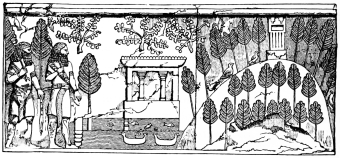
Fig. 35.—Assyrian Shrines. Relief from Corsabad.
THE traditional culture of the land of the Euphrates and Tigris is not younger than that of the Nile. Though the third dynasty (commencing, according to Berosos, with the twenty-third century B.C.) is the first of which we have monumental remains, it cannot be denied that long before that time an important people had inhabited the country, a nation very different from the nomadic hordes which then, as to-day, roved through the neighboring deserts. Several races of antiquity were conscious that the most primitive people of civilization had lived in the land of the two streams. The Jews considered that to have been their original home. The Patriarch Abraham had emigrated from Chaldæan Ur to Canaan. The Greek legend of Deucalion points to the history of Mesopotamia in the same manner as does the Jewish myth of the Deluge; the oldest Greek knowledge of astronomy, astrology, and the calculation of time seems to have been derived from the same source. The tale of the division of the nations in Babel, and their spreading over the face of the earth from that point, is certainly based upon the existence of a most ancient centre of civilization upon the banks of the Euphrates.
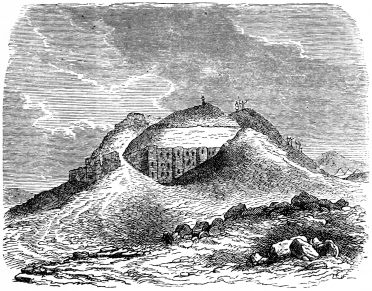
Fig. 36.—Temple of Mugheir (Ur).
The land offered no materials for monuments which, like those of Egypt, could stand uninjured through thousands of years. The narrow valley of the Nile is enclosed by the cliffs of the desert border, which seemed directly to encourage, by the excellence of the{49} building-stone there procured, the erection of immense and indestructible works. The plain of Mesopotamia, on the other hand, spread far beyond the courses of the two streams, losing itself in deserts without any line of eminences as a demarcation. The remote mountains offered no quarries at all comparable to those of Egypt. The soil was of good clay for the manufacture of bricks, but fuel was lacking with which to burn and harden them. The inhabitants of the land were generally obliged to content themselves with drying the clay in the sun, making up by the great thickness of the masonry for the firmness lacking to the material. They further strengthened the massive walls with a facing, or with buttress-like piers of burnt brick, or solidified the interior with alternate courses of this harder substance. The bitumen which still flows at Hit, on the Euphrates, north of Bagdad at the southern border of the higher alluvial terrace of Assyria, was an excellent substance for cementing the bricks; in more important works it was used alternately with lime-mortar: in common buildings, or in the interior of the thickest walls, clay kneaded with straw answered the purpose of a cement.{50}
It is natural that little should now remain of such structures. They could only survive the thousands of years that have elapsed since their building, when an immense thickness secured at least the kernel of the wall, or when the ruins of other buildings early covered and protected them. The remains of ancient Chaldæa are generally nothing more than formless heaps of rubbish, many of which have not yet been opened. Taylor, Loftus, and their predecessors, Ainsworth, Chesney, and Layard, discovered the ruins of over thirty cities in the lower half of the Mesopotamian plain. Of these, Mugheir (the ancient Ur), Warka (Erech), Niffer (Nipur), and Abou-Sharein offered the most important remains of great age; while the ruins of Sura, Tel Sifr, Calvadha, and Ackercuf are mainly of the later Chaldæan period.
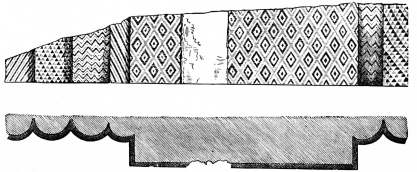
Fig. 38.—Patterned Wall. Warka.
Recognizable among the rubbish-hills of Mugheir are the remains of a terrace which consisted of two oblong steps, the lowest measuring 60.35 by 40.54 m. in length and breadth, and about 12 m. in height, standing upon a platform raised 6 m. above the surrounding country. The greater part of this is overthrown and buried beneath its own material. The kernel of the solid structure is of sun-dried bricks; the facing, which is divided by buttresses, being of burnt brick cemented with bitumen. The whole is perforated by numerous small air-channels. The second step is only about half preserved, and that which it must once have supported has entirely disappeared. A remarkable inscription, repeated upon the four corners of the upper terrace, explained the purpose of the structure and the time of its erection. According to Sir H. Rawlinson’s interpretation of the cuneiform legend, this was dedicated to the deity Sin (Hurki) as a temple, and was first founded by King Urukh (about 2230 B.C.). The name of the spot is given as Ur, a city known from Biblical tradition. The inscriptions were not, however, contemporaneous with the foundation of the building, for, after giving a long line of kings, they at last name Nabonetos, the last King of Babylon, as the restorer of the temple—a fact which is further attested by the bricks themselves, those of the lower terrace having the name of Urukh, those of the upper of Nabonetos. The temple remains of Warka and of Abou-Sharein unite with these ruins of Mugheir to show that the Chaldæan temple consisted of a{51} simple and massive terrace of few steps, crowned, without doubt, by a chapel, which must be supposed richly decorated with colors and gold ornaments from the fragments of agate, alabaster, and fine marbles, of gold-plating and gilded nails, found in Abou-Sharein, and from the blue enamelled clay tiles of Mugheir. The sides of the great steps were either plainly buttressed or treated with projections,{52} as is the case with the terrace wall of a palace at Warka, shown by Fig. 37. There was here a complicated system of reeded projections and stepped incisions—cylinders and prisms which cannot be called pilasters, as they were without capitals, and probably also without base-mouldings. Another ruin of Warka (Fig. 38) has a colored wall-facing, made by driving conical pegs of terra-cotta about 0.1 m. long into the clay, so that the red, black, and whitish base surfaces form different patterns. This ruin is further interesting as giving some insight into the private architecture of the Chaldæans. Rooms were there found separated from one another by walls fully as thick as the enclosed spaces themselves were broad—a clumsy heaviness which shows what massive masonry the poor crumbling material necessitated. The existing remains suggest so strongly the arrangement of the later Assyrian palaces that there can be but little doubt that they, in some degree, served as a model for these latter; although the palace wall, with its revetment of alabaster, might be erected with less thickness. No trace of window-like openings can be observed in the ruins of Warka or in those of Abou-Sharein.
The principle of the arch, though not extensively employed, was well understood and occasionally introduced in Assyria. From a small grave-chamber discovered at Mugheir, we may conclude that it was not known in the ancient Chaldæan period. The roofing was then effected by a gradual projection of the horizontal courses of bricks until the opposite sides nearly touched each other at the top of the gable thus formed. (Fig. 39.) It may perhaps be assumed that this manner of covering by the so-called false arch and vault was only employed for very narrow spaces, while larger rooms were more naturally ceiled by wooden beams. The ruins of{53} Warka, though they do not give a very clear understanding of the fortifications of ancient Chaldæa, at least show that the city walls were not necessarily square, as had been concluded from the testimony of ancient writers, but, as in this case, followed the irregular outline of the city.
The political history of Chaldæa was from the earliest times greatly disturbed by internal divisions. At first the city Nipur, celebrated for its worship of Bel, appears to have been the most important place, at least of Southern Chaldæa. To this followed Ur or Hur, the city worshipping Hurki or Sin, then Nisin or Carrac, and, finally, Larsa, the present Senkereh. Upper Chaldæan Babylon, originally Ca-dimirra, does not seem to have become the only capital until the age of King Cammurabi, about 1500 B.C. A hundred years later Northern Mesopotamia, Assyria, began to gain predominance, and in the thirteenth century B.C. Babylon was conquered (for the first time?) by Tiglathi-Nin, a son of King Salmaneser of Assyria. Chaldæa soon regained its independence, but only to fall again into the power of the conqueror Tiglath-Pileser, and to remain for five centuries subjugated to Nineveh. The attempts to throw off this yoke of Assyrian authority were in vain; even the uprising under the bold Merodach-Baladan, 731 B.C., was not of long duration, and finally led to the depopulation and total destruction of the prominent Chaldæan cities by Sennacherib. The Assyrian Esar-haddon rebuilt Babylon; but it did not recover its ancient importance until the Satrap Nabopolassar revolted from his allegiance, and, with the help of the Medes, made an end of the kingdom of Nineveh; and until his son Nebuchadnezzar, after the fall of Jerusalem in 587 B.C., reduced even distant Egypt to vassalage, thus taking into possession the full heritage of the Assyrian empire in both south and west.
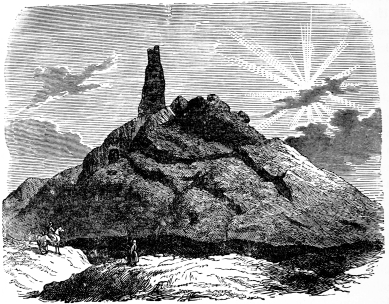
Fig. 40.—Bors-Nimrud. Temple-terrace of Borsippa.
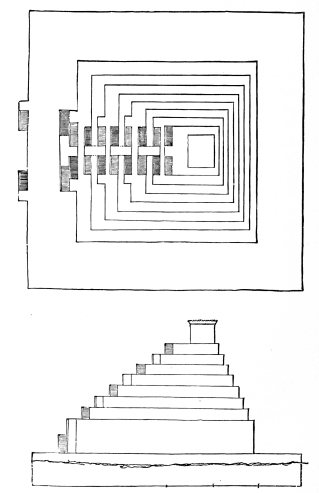
Fig. 41.—Plan and Elevation of the Temple at Borsippa.
(From Oppert’s Measurements.)
Though the subjugation of the land by Assyria had not been without effect upon the civilization of Chaldæa, the general character of Babylonian art remained much the same through all these political changes. The last king, Nabonetos, could complete the temple of Ur, which Urukh had founded seventeen centuries before, as though there had been no interruption in the work. The terraced ruins show that there was no great difference in the architectural{54} treatment of ages so removed. Other city ruins show such an intermixture of ancient Chaldæan and Babylonian walls that their date can be determined only by inscriptions or by stamps upon the bricks. The earlier remains are predominant in Mugheir, Warka, and Abou-Sharein; but the later capital of the country, Babylon, the city of Nebuchadnezzar, is known almost exclusively by the imposing structures of the modern kingdom. Greek antiquity, up to the time of Alexander, was acquainted with this city of wonders only by fables. Even the explicit description of Herodotos is in great degree mythical, especially his astonishing account of the city walls: 480 stadia (96.557 m.) in length, 200 ells (100 m.) high, and 50 ells (25 m.) broad. The ruins have also proved the account of the famed hundred gates of the city walls, and the square network of straight streets which ran from these, to be hyperbolical. Such immense masses of masonry would, as Layard has maintained, certainly have left heaps of rubbish; and, in fact, the ruins of a much smaller city enclosure have been traced. The{55} irregular orientation of the palace plan is also incompatible with the conception that the city was divided up into squares with the regularity of a chess-board. The traditional account that the enormous terraced temple of Bel was built on the borders of the stream opposite the palace structures is certainly incorrect; for, while these latter are still represented by extensive brick ruins, there is not a trace upon the other bank, the supposed site, of massive terraces which could not possibly have so entirely disappeared. Nor could the stream have swept away so colossal a building; for a little north of Hillah, in the immediate vicinity of the spot where Herodotos describes the temple of Bel, there have been found the remains of a small Mylitta temple, which would have offered almost no resistance to an inundation. Yet Herodotos undoubtedly related, besides his fables, much that was correct about Babylon. His account of the temple of Bel seems only questionable in so far as the site is concerned; the rest of his description agrees perfectly with ruins which have been found about eleven kilometers westward, and are known by the name Bors-Nimrud. (Fig. 40.) The temple thus could not have belonged to the city proper of Babylon; and inscriptions mention the place as Borsippa, spoken of by Greek writers as a separate town, which could at best be regarded as a distant suburb of the extended Babylon. The immense hill of rubbish standing entirely isolated in the desert has a lower circumference of 685 m. This dimension agrees tolerably well with the six stadia given by Herodotos as the measure of the first step of the terraced pyramid. The regularly diminished seven steps, the “towers” of Herodotos, 7.5 m. high, reaching altogether a total altitude of 75 m., rose from a square substructure with a side of two stadia (180 m.) and a height of 22.5 m. The diagonals of these different terraces were not directly above one another, the steps being 9 m. broad in front and only 3.9 m. broad behind, while the sides were equal—6.3 m. This peculiarity of the ruin agrees with the flights of stairs described by Herodotos, which, notwithstanding the analogy of the palace temple of Kisr-Sargon, may here naturally be supposed to have been upon the front, where the terraces were sufficiently broad for this purpose. Fig. 41 is an attempt to restore the chief lines of the structure by means of the dimensions given by Oppert.{56} Upon the summit of this terraced pyramid stood the necessarily small temple, which, according to Herodotos, contained a spacious couch and a golden table, but no statue of the deity. The sides of the terraces are directed to the cardinal points of the compass, as was the case also with the ancient Chaldæan temple of Ur; and, as at Ur, inscribed cylinders were here walled in at the angles. These{57} relate that Nebuchadnezzar had magnificently completed the structure—“the temple-pyramid of the seven spheres, the wonder of Borsippa,” begun by a former king. Rawlinson and Oppert have concluded, from the remains of glazed bricks of different colors, that each of the seven terraces was dedicated to one of the seven planets of the ancients, and was characterized by its color—the upper, gold; the second, silver; the next, red, blue, yellow, white; and the lowest, black—according to the hues assigned to the sun, the moon, Mars, Mercury, Jupiter, Venus, and Saturn. The lowest terrace has a panelled architectural treatment similar to that noticed in the ruins at Warka and the palace temple at Kisr-Sargon. It is probable that these high terraces in the flat plains of Mesopotamia were elevations which served the Chaldæan astronomers for their celebrated observatories, as the pylons of temples upon the banks of the Nile were similarly used by the Egyptian priests. As Strabo speaks especially of an astronomical school at Borsippa, there can be little doubt that it was in some way connected with the terraced pyramid of the seven spheres.
The ruins of Hillah, Casr, Mudjelibeh, and Jumjuma give even less information concerning the palace buildings than the hill of Bors-Nimrud does concerning the form of the Chaldæan temple. These masses of masonry have for centuries served as quarries, and, as far distant as Bagdad, bricks, bearing the stamp of Nebuchadnezzar, betray that the material has been transported from the ruins of Babylon. Though the supply is by no means exhausted, this excavation has rendered much unrecognizable, and has so greatly increased the destruction that Layard held it impossible to discover a clew to the plan of the palace structure in the confusion of its overthrown and rifled rubbish. Oppert assumes the hill of Jumjuma, or Amran-ibn-Ali, as it is called from the Mohammedan chapel now standing upon it, to be the remains of the celebrated Hanging Gardens known as those of Semiramis, the wonder of the ancient world. But, plausible as his supposition is, it will hardly be possible to prove by existing remains the correctness of the description given by Diodoros of the Hanging Gardens, in itself more probable than the report followed by Strabo. Diodoros speaks of the Gardens as a terraced structure, the side of the square plan being about{58} 120 m. in length, with separate steps which ascended from the land side, while upon the banks of the river a steep wall formed the back of the highest terrace, measuring 15 m. vertically, and closing the gardens towards the water. The steps were constructed by the help of thirteen thick parallel walls, each being higher than the one next below it. They left between them twelve narrow corridors, the ceilings of which, like those over Assyrian canals, were probably vaulted, and were then covered with rushes and bitumen, burnt brick pavements and lead sheathing, so as to bear the stairways which connected the different terraces, the reservoirs for cascades and fountains, and the imposed garden—earth with large trees, etc. Pumping works in the highest of these covered corridors supplied the garden with the necessary water from the Euphrates.
The ruined terraces of Mudjelibeh (Babil), avoided by the Arabs as the scene of the punishment of the fallen angels, are so completely overthrown that it is not possible to determine whether the remains are those of a temple or of a palace. It is probable that they had some connection with the great pyramidal tomb of Belus, a structure which may be assumed to have been much like the stepped pyramid of Nimrud to be described below. The monument of Mudjelibeh was destroyed as early as the time of Xerxes II. It has since served as a quarry for the neighboring cities Seleucia and Ctesiphon, and has been demolished to the lowest terrace.
The enormous river embankments and dikes which protected Lower Mesopotamia from flood and drought, though now only to be traced by inconsiderable remains, are of the greatest importance and interest. The neglect of these invaluable works, and of the sluices and irrigating canals in connection with them, has reduced to a deserted and pestilential swamp that most fertile land known to Herodotos—where once a harvest of two and three hundredfold was returned to the tiller of the soil. Though there are vestiges of some ancient bridges in the land, it is not possible to decide whether the account given by Diodoros of the great tunnel constructed by Semiramis be true or fabulous.
There seems to have been no reason for the erection of such tall edifices in the vastly extended Babylon as the three and four storied houses described by Herodotos, and no analogy to such a{59} peculiarity exists in the great modern cities of the Orient. It must be remembered in this connection that the crumbling bricks to which the Mesopotamians were restricted would, in such high buildings, have demanded clumsily massive substructures and lower-story walls.
Though the ruins of Babylon have only recently been thoroughly examined, their existence has long been known. Benjamin of Tudela speaks of Bors-Nimrud as the Biblical Tower of Babel, and this local tradition has been handed down to the present day. The palace ruins of the great city have always been readily recognizable, and the one has been called Babel, the other Casr (palace), from time immemorial.
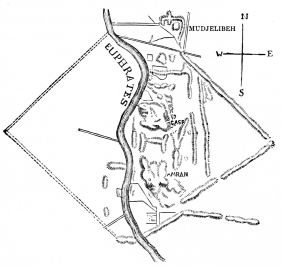
Fig. 42.—Plan of Babylon. (According to Rich.)
It is otherwise with the second great centre of Mesopotamia—Nineveh, the famed capital of the kingdom of Assyria, in the upper land of the great streams. As early as the beginning of this century, Carsten Niebuhr expressed the conviction that the remains of the overthrown city were to be sought among the hills of rubbish which lie opposite the present Mosul, beyond the Tigris; but the energetic Rich, who devoted so much time and labor to the barren ruins of Babylon, paid no attention to the site. Nineveh had{60} entirely disappeared, and was only traditionally known from the Book of Jonah and from the legend of Sardanapalos. It was during two visits to Mosul, in the years 1840 and 1842, that the eminent English traveller and statesman Sir A. H. Layard conceived the plan of undertaking investigations in the vicinity. He expressed his convictions at the time to the French consul, M. P. E. Botta, and in 1843 that gentleman commenced the excavation of the hill Coyundjic, which lay next to Mosul. The natives, becoming aware of the nature of the search, directed his attention to the hill of Corsabad, situated at a distance of about twenty-five kilometers from Mosul; the excavations were removed thither, and carried on with most gratifying results. A few days’ digging laid bare a number of walls reveted with huge slabs of alabaster. The wonderful sculptures in relief upon these excited redoubled activity, and soon entire chambers of the palace structure were freed from the overthrown rubbish which had covered it for well-nigh three thousand years. The French government purchased the entire village of Corsabad: in M. V. Place was provided a worthy successor to M. Botta. The inscriptions discovered have proved the ruins to be those of a palace founded by Sargon about 710 B.C. in the city Kisr-Sargon or Dur-Sargina.
In the year 1845, Layard obtained, through Sir Stratford Canning, then ambassador to Turkey, the necessary means for the English government to take part in the promising undertaking. He at first directed his attention to Nimrud, a hill of ruins about a day’s journey south of Mosul, the great size of which promised the existence of important remains. An immense terrace platform was there found to have supported a number of palaces, several of which were excavated, the more valuable sculptures and other objects of interest being transported to the British Museum. At Nimrud were discovered the most ancient and the most modern of Assyrian buildings known—namely, the northwestern palace, temple, and tower built by Assur-nazi-pal shortly after 885 B.C., as well as the Temple of Assur-ebil-ili, presumably the last Assyrian king, dating to about 610 B.C. Besides these, there were the southeastern and central palaces built by Shalmaneser II. after 860, the latter having been restored by Tiglath-pileser II., from 745 to 727, as Sargon rebuilt{61} the northwestern palace after 722; and, finally, there was the southwestern palace of Esar-haddon, from 681 to 668 B.C. The city itself (Calah) corresponded in grandeur and extent with the palace terrace. It was founded by Shalmaneser, and long rivalled Nineveh, especially after its reconstruction by Assur-nazi-pal.
It is now beyond a doubt that the chief capital of the country is buried beneath the hills of Coyundjic and Nebbi-Jonas, the latter so called from a Mohammedan chapel to the prophet Jonah which traditionally marks the site of Nineveh. Both these mounds of ruins were examined by Layard. In the southwestern palace of Coyundjic, built by Assur-bani-pal, from 668 to 626 B.C., was discovered the most extensive among these dwellings of Oriental despots. The most elaborate of Assyrian palaces was the northern one of this site, built by Assur-bani-pal about 640 B.C., a monarch who devoted certain chambers of the southwestern palace, originally erected by his grandfather, to the reception of inscribed clay tablets—an inexhaustible wealth for the study of Assyrian history, of which hardly a third part seems to have been recovered intact.{62} In Nebbi-Jonas were found traces of the palaces of Vulnirari III., from 812 to 783; of Sennacherib, from 705 to 681; and of Esar-haddon, from 681 to 668 B.C. The line of the city walls, still recognizable among the hills of rubbish, is shown by the plan at Fig. 43. These fortifications could hardly have enclosed the entire city, and it is probable that only the inner town, with the palaces and public buildings, was thus protected, and that the dwelling-houses of the many inhabitants formed suburbs which extended far around the enclosed centre, gradually losing themselves in gardens and groves of date-trees, as is the case with modern capitals of the East. The comparatively small walls of Babylon, at variance with the report given by Herodotos, lead to the same conclusion in regard to that city.
The ruins of Calah-Shergat, situated about 100 kilometers down the stream from Nineveh, are identified with Assur, the oldest capital of the land, which maintained its pre-eminence until Nineveh, in the fourteenth century B.C., became the great centre of power. Reson is thought to be recognized in the ruins of Selamiyeh, lying between Nimrud and Nineveh, and Erbil in Arbola. These sites have not been sufficiently examined to be of direct importance in the history of art.
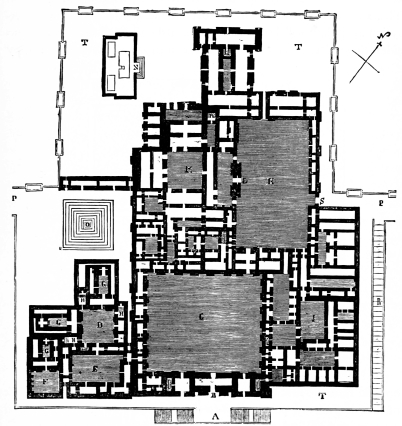
Fig. 44.—Palace of Kisr-Sargon, Corsabad.
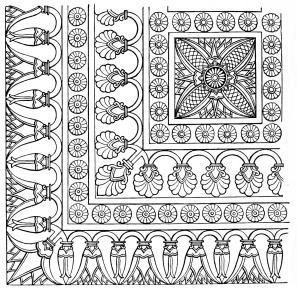
Fig. 45.—Ornamented Pavement from the Northern Palace of
Coyundjic.
It is plain from the ruins already mentioned that the dwellings of the kings took the most prominent place among the creations of Assyrian architecture. The despotic element had in Mesopotamia the same superiority as the hierarchy in Egypt: in the former country the palace was as much in the foreground as was the temple in the latter. In ancient Chaldæa the two elements, and consequently the two classes of monuments, were more equally represented. Still, in most points of view, the relation of Chaldæan and Assyrian architecture is very close, and the differences arose chiefly from the superior material at the builders’ disposal in Upper Mesopotamia. The terraces of Assyria, like those of Chaldæa, were solidly constructed of sun-dried bricks and stamped earth, but the neighboring mountains provided stone for the complete revetment of these masses with quarried blocks. Carefully hewn slabs existed upon the terrace platform of Sargon’s palace, and upon the substructure of the pyramid of Nimrud, while there was rough Cyclopean stone-work employed in the construction of the city walls at Kisr-Sargon. The{63} facing of brightly glazed tiles and stucco-paintings, universal in Chaldæa, is restricted upon Assyrian masonry of the same brick materials to the upper part of the wall, the lower half being sheathed and protected by sculptured slabs of alabaster. The appearance of the whole gained greatly by this change, the revetment of reliefs in place of the painted figures giving a more imposing and durable character to the walls. The palace architecture of Assyria is best exemplified by the plan of the royal dwelling of Kisr-Sargon (Fig. 44), the isolated position and clear disposition of which are adapted to show the general character of these structures. The platform{64} terrace consisted of two divisions, the broader (P) being inside the limits of the city fortifications, while the remainder (T) projected beyond them. A double flight of steps (A) led to the chief portal (B), ornamented by gigantic winged human-headed bulls, which here not only stood on the sides of the passage itself, as at all principal entrances, but laterally upon the front walls, within and without. These figures are among the most characteristic creations of Assyrian art; they will be treated more in detail in the following consideration of the sculpture of the country. The triple gateway opened into the first and largest enclosed court (C). Upon the left of this, one narrow passage led to the chambers of the harem, which were ranged around six smaller courts (D to H). Upon the right of the first enclosure were the household offices (J), with eight courts and numerous halls, magazines, kitchens, cellars, stables, etc. The side opposite the chief entrance was formed by the private apartments of the monarch (M) and by the great hall of the palace—a group of chambers not presenting its chief front to the first court (C), with which it was connected only by subordinate entrances—but to{65} a second enclosure of almost equal extent (K), which may be regarded as the chief open space of the royal dwelling. An inclined ascent (R) led to the right wing of the inner terrace, by which the king, approaching in a chariot or borne by attendants in a sedan-chair, could enter his seraglio without passing the first court (C) or the entrance to the household offices (J). The encroaching line of the city wall (P) made it impossible for the portal to the second court (S) to be arranged in the central axis of that enclosure; but strict symmetry of plan was not adopted even when there were no such obstacles. The inner apartments of the king were entered by a magnificent triple gateway (L) from the court of the seraglio; these were, in certain measure, regularly planned, being so grouped around a smaller court (M) that oblong halls, as long as this was square, were upon three of its sides. The hall upon the south opens into a number of intricate chambers, probably used as baths, sleeping-apartments, and rooms for the immediate body-guards of the king and for the temporary families of the harem. Upon the north a wing was added to the building, projecting almost to the outer border of the terrace, and dividing this (T) into a northern and a western court. The addition was the most richly ornamented portion of the entire palace; it was probably here that the halls of reception were placed. The walls of other parts of the seraglio were reveted upon their lower part with sculptured slabs of alabaster; but this treatment was not elsewhere so freely applied, nor was it as richly decorated as in this northwestern wing. In the first hall, which is 35 m. long and 10 m. broad, the walls are ornamented with continuous scenes representing, as in a procession, the homage and punishment of prisoners-of-war. In other rooms and in smaller courts these reliefs, divided by a band of cuneiform inscriptions, are of smaller dimensions and less pretentious execution, though of marked interest as forming, with their copious inscriptions, chronicles of historical events.
The spacious terrace at the west has in its centre an oblong hall (N), generally supposed to be the temple or chapel of the palace, but which may with more probability be considered as a hall of state. The scanty remains of this structure make a sure determination of its purpose impossible. They consist chiefly of the foundations{66} of solid unburnt brick masonry, faced with slabs of black basalt. The cornice of this substructure is of gray limestone, in form much resembling the characteristic scotia of Egyptian architecture. (Fig. 46.)
A small terraced pyramid (O) at the southwest is a more remarkable structure. Four of its steps, with their facing of white, black, orange, and blue enamelled tiles, are still remaining. These lead, from analogy with the pyramid of Borsippa, to the assumption of three further steps, tiled with the red, silver, and gold assigned to the remaining planets. The vertical panelling of the sides is somewhat similar to that of the remains at Warka; it is not here restricted to the walls of the lower terrace, like that upon the ruins of Mugheir and Borsippa. The square platform at the top of the terraces, the side of which could have measured little more than 10 m., received either an altar or a small cella, not longer than 6 m. Ascent to the top of the pyramid was provided by an inclined plane, which wound from step to step in a rectangular spiral. The destination of the pyramid as the palace chapel seems reasonably certain, from its similarity to other terraced temples of Assyria.
The palaces hitherto discovered show the greatest freedom of detailed arrangement. The variations among the plans may be illustrated by a comparison of those of the northwestern palace of Nimrud (Fig. 47), the palace of Esarhaddon (Fig. 49), and of that of Sennacherib at Coyundjic. The methods of construction adopted for their erection are more similar. All have walls built of burnt or unburnt brick and of stamped clay; those of the larger chambers are reveted in their lower half with slabs of alabaster or with brightly enamelled tiles, and ornamented by paintings upon stucco above. All the principal halls are so narrow in proportion to their length as to resemble corridors—a peculiarity arising from technical difficulties of ceiling.
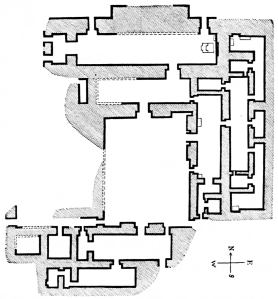
Fig. 47.—Plan of the Northwestern Palace of Nimrud.
The manner of lighting and roofing adopted in Assyrian palaces is not directly evident from the existing remains; none of the walls, the highest of which reaches 9 m. above the ground, showing{67} traces of any window-like openings. Some authorities assume that all the light of the interior was admitted through the doors. That this may, in some instances, have been barely possible is evident from the plan of Sargon’s palace at Corsabad (Fig. 44), where the principal chambers were entered directly from the open courts, or, in exceptional instances, were preceded by narrow ante-rooms which could not greatly have interfered with the light. But it is plain from the plan of the northwestern Palace of Nimrud (Fig. 47) that twelve chambers in such unfavorable positions as those shown upon its eastern side could not have received the slightest light through the two narrow passages leading from the confined court. It is futile to deny the necessity of light and air for the dwellings of man; and theories which suppose these enormous spaces left in darkness, or unventilated and lighted artificially, are certainly untenable. Other scholars are of the opinion that light and air were procured through horizontal openings in the ceiling and roof; but this imperfect and unpractical arrangement is particularly ill adapted for inhabited rooms, and is rendered extremely improbable by the{68} fact that upon the pavements there did not exist the slightest arrangement for leading off the water which must have fallen upon them had the roof been an inefficient shelter. The floors were rarely of stone slabs, like the carved fragments shown in Fig. 45, and in other places the sun-dried bricks would have been rapidly reduced to mud by the furious rain-storms of Mesopotamia.
The present condition of the ruins, the walls of which nowhere rise to the full height of the chambers, does not, however, exclude the possibility of openings for light having existed just beneath the ceiling. The form of such orifices cannot surely be determined; high windows could not have existed, and there must have been low openings in the top of the wall, separated by piers, between which stood small columns, as is evident from a relief of Coyundjic, given in Fig. 48 to serve as an argument for this manner of illumination. Light and air could thus have been freely admitted, without inconvenience to the dwellers within. The high position of the apertures, immediately under the somewhat projecting roof, prevented the entrance of rain, and shut off the interior from the view of those without, just as this same manner of lighting to-day protects the harems of the East. The small shafts, which were introduced as supports between these windows, appear to have been the only representatives of columnar architecture in the Assyrian palace. If columns had been used, in their customary function, as upholders of the roof,—as members which bore an important entablature,—some traces of these would certainly have been preserved; their material could hardly have been more perishable than the sun-dried brick of the walls. The entire arrangement of plan shows that their assistance was not relied upon. The chambers were disproportionately narrow, plainly to render it possible to cover them without the introduction of intermediate supports.{69} The beauty and fitness of the corridor-like spaces were so sacrificed to this narrowness that its universal appearance can be regarded only as a constructive necessity. It is well illustrated by the cramped principal hall of the palace of Esar-haddon at Nimrud (Fig. 49), where a greater width than that permitted by the span of ceiling timbers was only to be obtained by the erection of a division wall to provide a subsidiary support for the beams. So helpless a make-shift, destroying the unity and grandeur of the hall, could have been adopted only in entire ignorance of the opening and supporting element of the column, apparently never recognized in Assyria.
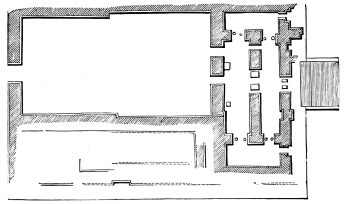
Fig. 49.—Plan of the Palace of Esar-haddon at Nimrud.
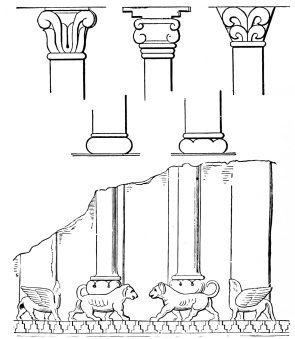
Fig. 50.—Various Forms of Capitals and Bases, from
Assyrian Reliefs.
The form of the small columns, which stood in the openings allowed for light in the upper walls, can be approximately determined from the representations upon reliefs. The shafts were cylindrical, and probably without flutings; they had a roundlet, or at least a projecting fillet, at either end. The base consisted solely of a high tore, sometimes notched upon the top, or placed upon the back of a striding lion. (Fig. 50.) The most common form of the capitals was a peculiar conjunction of two spiral scrolls, similar to a doubled Ionic capital, with an echinos-like roundlet beneath and a stepped abacus above. It is hardly to be doubted that this was the prototype of the Ionic capital, although it cannot be determined from the reliefs whether a lateral roll corresponded to the volute of the front, or whether the helix was repeated upon all four sides, as is{70} the case with the capitals of Persian columns. The small scale of the representations upon reliefs, and their careless execution, do not permit a sure understanding of any part of the capitals. A table (Fig. 51) upon a relief of Coyundjic better determines the form of the volutes; it has distinct spirals in place of the rosettes, wrongly shown by Layard’s drawing.[D] There is reason to suppose that the double helix was not the primitive and normal form of the Assyrian capital, but was rather an abbreviation of the leaved calyx so frequently met with in Phœnicia, Palestine, and Cyprus, and that the rolled ends of the leaves, shown by two of the examples in Fig. 50, originally suggested the volutes of the capital and the various spiral forms occurring upon carved Assyrian furniture, as in Fig. 81. The question will be considered more at length in the section upon Syrian architecture.{71}
The columns of Assyria were employed only in this subordinate position, and the dimensions and shape of larger enclosed spaces were dependent upon the limited span of the wooden ceiling beams. Assyrian palaces were, in these respects, unable to fulfil the demands of a monumental architecture. It can only be surmised how roof and ceiling were constructed in detail. The beams were naturally so placed as to require the least possible length to span the clear width; the sinking in the middle, to which the elastic trunks of palm-trees so much inclined, and the accumulation of water in the hollow thereby formed, were thus avoided as well as might be. The constructive details of the roof-platform are not surely known; it is probable that a layer of clay and earth was placed upon the beams, being rolled down compactly after every rain. The exterior representation of roof and ceiling, the wall entablature, may have consisted of a painted wooden sheathing, bearing ornaments of the character displayed by the pavement. (Fig. 45.) It was divided, like the Egyptian entablature, into two parts; in neither case was there a marked distinction between roof and ceiling. The imitations of building-fronts upon reliefs make it probable that stepped battlements rose above the main cornice.
Fig. 52.—Mouth of a Channel under the
Northwestern Palace, Nimrud.
Fig. 53.—Channel under the Southeastern
Palace, Nimrud.
The fundamental principles of vaulted construction, as of columnar architecture, were known in Assyria, but neither the column nor the arch was worthily recognized and developed into an important feature capable of exercising an influence upon the extent or form of the enclosed spaces. The palace terraces were pierced by narrow vaulted channels, still to be traced among the ruins. This was the case with the most ancient structure of Assyria, the northwestern palace of Nimrud. (Fig. 52.) Though it cannot be proved that the Assyrians were the original inventors of the arch of wedge-shaped stones, there are certainly no earlier instances of this manner of building known than those of that{72} country. Round arch barrel-vaults were not exclusively used for such channels; an ogive appears upon the same terrace of Nimrud, in the somewhat later southeastern palace. (Fig. 53.) Though the key-stone of the latter is undeveloped, the vault is yet built upon the principle of the Gothic pointed arch. It is not impossible that this form may have descended in uninterrupted tradition from Mesopotamia to the Arabs, being brought by them to Europe, where, effecting a change in the round Romanesque arch, it exercised a decisive influence in the development of mediæval manners of building. The bricks of these vaulted Assyrian channels are carefully moulded to the more or less marked wedge-form determined by the size of the arch—a greater refinement than is practised by modern masons, who use only rectangular bricks, effecting the curve by the wedge-shape of the mortar-joint. Yet, perfected as vaulted construction appears in these channels, its application seems to have been almost restricted to them; Assyrian builders hesitated to apply vaulted ceilings to spaces of much greater span than gates and window apertures. Reliefs show arched portals alternating with{73} horizontally covered openings; and in the fortification walls of Kisr-Sargon, the city adjoining the palace-ruins of Corsabad, traces of a barrel-vaulted entrance have been discovered where the arch, of 4.5 m. clear, rested upon the backs of the winged monsters referred to as the guardians of all important gateways. A vaulted corridor, considerably less in span, will be noticed at the temple pyramid of Nimrud. Among the numerous palace chambers remaining, only a few narrow cells show traces of vaults; the opinion of some recent investigators, that the customary horizontal ceilings of smaller rooms were surmounted by cupolas of beaten earth, does not appear plausible.
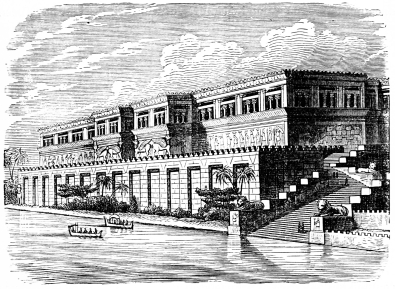
Fig. 54.—Restoration of an Assyrian Palace.
From the chief points gained by this consideration, it is evident that the restoration given in Fig. 54, a variation of the reconstruction by Layard and Fergusson, cannot greatly misrepresent the once existing structures. The Assyrian palace was, upon the whole, a more satisfactory building than the Egyptian temple. The outlines and masses of its composition were grand; it was richly ornamented, perhaps even overladen, with sculptured and colored decoration.{74} The massive and unpierced walls of the lower half bore a kind of open loggia, consisting of light columns between powerful piers which were fully capable of upholding the ceiling. The entire edifice being elevated upon a terrace, upper stories were not necessary to secure an imposing height. The existence of one lower story alone is indicated by the ruins; no large staircases, or other means of ascent to an upper floor, were provided. The apparent duplication of the stories of houses upon reliefs is owing to a fault of perspective common to the primitive representations of all nations: things are shown as above and upon, instead of behind and beyond, one another. The ground-chambers, of which sixty-eight have been counted in the Palace of Sennacherib at Coyundjic, and over two hundred in the Palace of Sargon, were surely ample in number and extent.
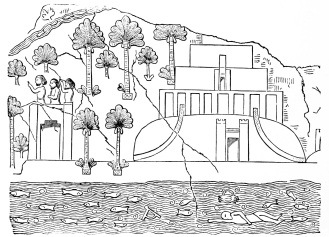
Fig. 55.—Terraced Pyramid. Relief from Coyundjic.
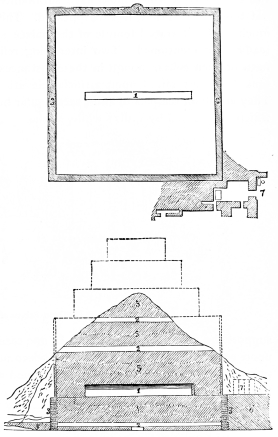
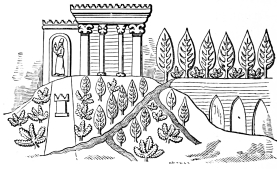
Fig. 57.—Relief from the Northern Palace of Coyundjic.
Though the royal dwellings of Assyria chiefly attract attention in considering the architecture of the country, there are also many remains of sacred buildings in the lands of the Upper Tigris. But we are acquainted only with those places of worship which stood in immediate connection with the palaces, no traces of edifices for general and popular worship having been discovered up to the present time. Even were we without knowledge of the ruins, it would be natural to suppose the temples of Assyria similar to those of Mesopotamia; that is to say, pyramidal terraces, with high lower stories.{75} (Compare Fig. 41.) A relief from Coyundjic, the upper portion of which is unfortunately destroyed, confirms this view, showing a terraced structure of three or four steps situated upon a natural elevation. The lower terrace is decorated, like Chaldæan works of the kind, with pilasters in low-relief; before it are pylon towers. (Fig. 55.) This specifically Mesopotamian type is to be recognized in the most prominent ruins of Assyrian sacred architecture—namely, in the terraced pyramid which occupied one corner of the great palace platform of Nimrud. It is also to be observed in the more fragmentary remains at Kileh-Shergat, which time has buried beneath shapeless hills of rubbish, without entirely obliterating the original disposition. The ruins at this site have not been thoroughly investigated; those at Nimrud showed the lower part of the pyramid at least to have been solidly built of bricks, reveted with a wall of quarried stones. (Fig. 56.) In the height of the main palace terrace was a shaft, the purpose of which is uncertain, as it was without entrance, and empty; it is interesting in architectural{76} respects from the admirably executed barrel-vault of brick masonry which formed its ceiling. The ruin, for the greater part destroyed, offered beyond this corridor but few peculiarities. The stone revetment has been almost entirely carried away, and every trace of the temple cella which must have surmounted these terraces, as it did those of Chaldæa, has disappeared. The better-preserved but much smaller terraced temple of the palace at Kisr-Sargon has already been mentioned. Two interesting reliefs show the general form of such cellas, though in these instances the structures represented are not raised upon artificial elevations. (Figs. 35 and 57.) They are small temples in antis, rectangular buildings, three sides of which are formed by walls; while, in the open fourth, two columns support the entablature and roof. In one case the ends of the walls upon each side of the columns are undecorated; in the other the pilasters, though without a base, are crowned with a member similar to the capitals of the columns. The simple entablature projects in an oblique line; it is terminated by stepped battlements, in which the Mesopotamian type of the terraced pyramid is repeated in outline and adopted as a merely decorative detail. Such temple cellas were erected not alone upon extensive terraces, but in the plain; perhaps, also, like the similar structures of Phœnicia, in the midst of sacred lakes. The reliefs given in the cuts show the chapels to have stood at the foot of natural elevations, as well as upon them. Another form of sanctuary, with gabled roof and lanceolate acroteria, is represented upon a relief of Corsabad. (Fig. 71.) The building{77} remotely resembles a Hellenic peripteros. Its constructive peculiarities cannot well be understood from the relief, as these considerations were probably not clear to the sculptor himself. It is possible that the architectural form was one foreign to the country,—perhaps the imitation of a temple in Southern Asia Minor. Another variety of these palace chapels appears upon the terrace of Nimrud, the forms there differing but slightly from those of the dwelling-chambers; the sacred cellas are distinguished only by the exclusively mythological character of the reliefs, and by the altars and offerings placed at the entrance. (Fig. 58.) It is possible, however, that these spaces were used as the dwellings of priests rather than as sanctuaries, especially as the two examples known are situated near the base of the great temple of Nimrud, being in this respect admirably adapted to the uses of the sacerdotal officers in the royal household.
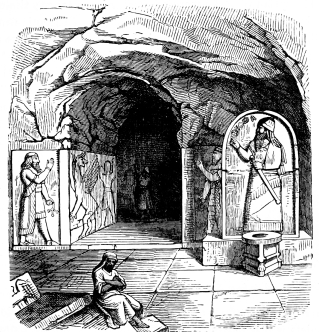
Fig. 58.—Entrance to one of the so-called Temples,
Nimrud.
The forms of Assyrian altars are illustrated by reliefs. (Figs.{78} 35 and 57.) The rectangular shaft, at times furrowed, rests upon a plinth, and bears a projecting slab, bordered by stepped battlements. A tripod was found before the entrance to the so-called Temple of Nimrud (Fig. 58); and upon reliefs are represented fire-altars, upholding by a single support a basin for burnt sacrifices. These altars and the bronze tables for offerings were not treated as architectural details, but more resembled the chairs and thrones variously represented upon reliefs.
The Assyrian obelisks were of greater importance; though they cannot be compared to the gigantic wonders of Egyptian mechanical skill, they yet represent the typical forms of Assyrian art as characteristically as do the Egyptian shafts the architecture of that land. A small specimen carved in black basalt, 2.1 m. high and 0.6 m. broad at base, was discovered in Nimrud and has been transported to the British Museum. (Fig. 59.) The gently diminished pier is crowned with a terraced pyramid, thus giving the principal monumental form of Mesopotamia, on a small scale, as distinctly as the termination of Egyptian obelisks does the more strictly geometrical pyramid of the Nile land. The steps and part of the shaft are carved with cuneiform inscriptions, and with reliefs which represent an act of homage—the presentation to the king of various gifts, animals, etc.
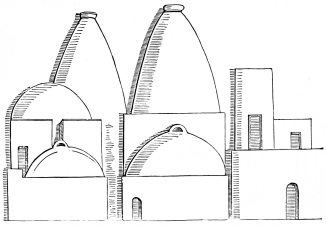
Fig. 60.—Assyrian Dwellings. Relief from Coyundjic.
Rich as are the results of scientific investigations in regard to the palaces of Assyria, they are deficient in everything concerning the cities, which could have been but mean and insignificant in comparison with the royal dwellings. Only scanty traces of the fortification walls around Coyundjic, Corsabad, and Nimrud have been preserved. From reliefs these appear to have been provided with projecting galleries for defence, with square or circular loop-holes, and with battlements of rectangular or oblique outline. As before mentioned,{79} there have been preserved at Kisr-Sargon (Corsabad) the remains of a round-arched city gate, flanked with winged lions. (A skilful restoration of this is given by Viollet-le-Duc in his Entretiens.) The small hills of rubbish within the city did not tempt the closer investigation of excavators, who found such inexhaustible rewards for their labors at the palace terraces. Private dwellings, which were not, like the chambers of the kings, constructed with hewn and sculptured stones as a revetment of the weak masonry of unburnt bricks, are now in so complete a state of destruction that an understanding of their original form is hardly possible. The known reliefs are not adequate to convey satisfactory information in regard to them. Among the clearest of these is a relief of Coyundjic (Fig. 60), which shows buildings with hemispherical and oval cupolas, much like those still customary in some parts of Syria. The openings for light and air are distinctly indicated in the summit of the vaults. On the other hand, dwellings like that shown in Fig. 61, which often occur in great numbers within the enclosure of fortification walls, are of most perplexing construction, unless assumed to be tents. Some interior views indicate this character, and the surrounding walls might accordingly be considered the fortifications of an encampment. The plan-like illustrations of walled towns, where the houses are repeated in conventionalized forms, give no definite{80} information concerning the peculiarities of Assyrian domestic architecture. (Fig. 62.) They remind us rather of the topographical usage prevalent during the seventeenth and eighteenth centuries of our era, when, in similar manner, approximate representations of houses and cottages were typically employed to designate a village, a town, or a city, upon maps from which no conception of the nature of the structures could be obtained. But it may be concluded from these views that a majority of the dwellings consisted of a higher and a lower division, each being provided with an independent platform.
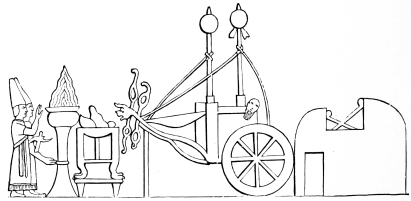
Fig. 61.—Tent-like Dwelling. Relief from Coyundjic.
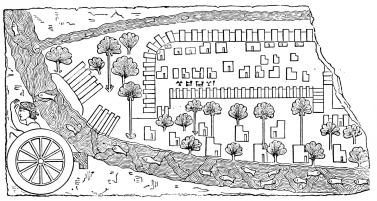
Fig. 62.—Susa. Assyrian Relief from Coyundjic.
The character of Egyptian architecture was essentially influenced by the rich colored ornamentation which covered and enlivened so much of the wall-surface with the coilanaglyphic paintings peculiar to that country. Upon the palace buildings of Mesopotamia painting and sculpture were something more than mere decorative adjuncts to the architectural construction. They may even be said to have predominated. The brick walls of Nineveh, instead of bearing ornamental slabs, were themselves upheld by the richly sculptured revetment. The works of the sculptor and the painter take a more important place in the history of Assyrian art than do those of the architect. This, however, was not the case in the earliest ages of the Chaldæan empire, for monuments like the Temple of the Moon at Ur (Mugheir), and like the remains at Warka, appear to have been almost destitute of carved, if not of painted, ornamentation.{81} The simple treatment of wall-surfaces with glazed and colored tiles, even when laid in the variegated patterns of the Chaldæan buildings, can hardly be spoken of as painting; and in that country no surely attested remains of sculpture have been discovered. Nor could the carving of stone flourish in the later Babylonian period. The remoteness from mountains and quarries of the great cities, and especially of the capital itself, which stood in the midst of an extended alluvion, was too great to allow stone material to be readily procured even for the revetment of walls. Only one fragment of a larger relief was found by Layard among the ruins of Babylon,[E] and this was so entirely similar to the Assyrian sculptures that it would, without further question, have been regarded as the work of Nineveh had not the Babylonian character of the cuneiform inscriptions indicated its origin. A colossal statue of black basalt, representing a lion standing upon a human being, a work known to travellers for over a century, still lies in position, half buried in the earth; it might convey an adequate idea of the sculpture of Babylon were it not so weathered and imperfect as not to be considered worth removal. The most numerous examples of the stone-carving of Southern Mesopotamia—that is to say, of Babylonia—are given by the cylindrical seals of syenite, basalt, agate, carnelian, etc. These stones generally measure about 0.03 m. in length{82} and 0.01 m. in diameter; they are perforated in the line of their axis, to allow of their being strung upon a cord or fixed upon a metal wire, by which, if held as a handle, the seal could be rolled over some soft substance, such as wax, thus leaving the impression of the figures engraved upon it. (Fig. 63.) The great variance between the style of these cylinders and that of Mesopotamian reliefs is mainly due to the totally different technical peculiarities of intaglio and relief-cutting. The seals of Babylonia and Assyria are usually so much alike that they are to be distinguished only by the character of the cuneiform inscriptions, or, in some instances, by the mythological subjects represented. The origin of many of the carved cylinders which lack such indications cannot be determined, the place of their discovery being of slight importance in the case of objects so easily transportable. Numbers of these seals exist in all large European museums, being picked up by the inhabitants of Hillah after torrents of rain have furrowed the earth in which they lie concealed.
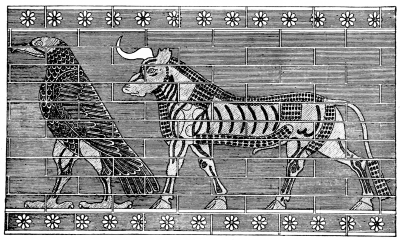
Fig. 64.—Wall Decoration of Enamelled Tiles.
The Babylonians made up for this national lack of monumental works of sculpture, due, as has been seen, to the difficulty of obtaining suitable material, by the development of another branch of decorative art. Favored by the clayey earth of the Chaldæan alluvion, they did not content themselves with the manufacture of admirable bricks, or with exact and durable masonry of this material, but developed a glazed decoration of their outer surfaces. The walls of chambers seem generally to have been prepared with a coating of plaster and then painted. Naturally, no traces of this{83} process exist, but passages in the books of the Biblical prophets indicate it to have been customary. Exterior walls, which, on account of climatic influences, could not thus be treated, were ornamented with enamelled and variously colored tiles. Upon the steps of temple terraces this was effected by glazing the outer sides of all the bricks with a single color, but for palace walls entire compositions were so formed that each separate tile was drawn and colored in reference to the entire representation. (Fig. 64.) Remains show the glazing to have been quite thick; the colors, chiefly bright blue, red, dark yellow, white, and black, have been perfectly preserved. A French traveller of the last century relates that a chamber with walls of colored tiles, representing, among other objects, the sun, moon, and a cow, was unearthed from the hill of Mudjelibeh, one of the mounds of ruins formed by the overthrow of the Babylonian palaces. An account given by Diodoros, who describes a great hunting scene upon the innermost city wall, shows how extended this enamel painting must have been. Among many figures the queen, Semiramis, took a prominent part in the action, throwing a spear at a panther from her position on horseback, while the lance of the king transfixed a lion. The general character of the composition can be understood{84} from the analogy of similar scenes represented upon reliefs from Nineveh.
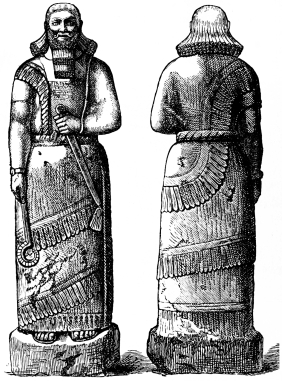
Fig. 65.—Statue of a King, from Nimrud. (British
Museum.)
The palace decorations naturally developed in an entirely different manner in Northern Mesopotamia—Assyria. The spurs of neighboring mountains advanced from all sides close upon Nineveh, and good building-stones, notably the most beautiful alabaster, are found in the plain, under the shallow strata of alluvial earth. The flat colored decoration of the walls with glazed bricks was superseded by a carved revetment of lavish richness, which so generally covered the lower half of larger palace chambers with reliefs that an almost inexhaustible material is presented for elucidation of the style by the fragments discovered during the short period of twenty years.{85}
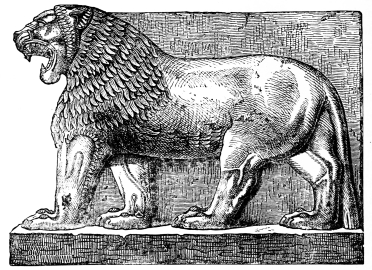
Fig. 68.—Lion from Nimrud. (British Museum.)
Sculpture so concentrated itself upon this decorative field of revetment reliefs that it appears rarely to have ventured the execution of independent works. Statues in the full round are extremely rare, and the few known are nearly as similar to each other as are those of Egypt. The best-preserved figure was found in the so-called temple at the foot of the terraced pyramid of Nimrud, and has been carried to the British Museum. (Fig. 65.) It is about 1 m. in height, hewn from a hard limestone, and represents a king in the garb of a priest. The round head is covered with long thick hair, which, falling somewhat over the forehead, is not parted, but divided into wavy horizontal rows; it ends upon the shoulders in a straight section of closely and regularly arranged spiral curls. The imposing beard is still more conventionalized; beginning in thick curls, it is arranged in alternate courses of rope-like twists and rows of small coils. The ends of the mustache curl into marked spirals. The large eyes, of rather oblique position, are situated too low, and are consequently without expression. Their strap-like lids do not sufficiently protrude, while the thick eyebrows, excessively curved upward and meeting above the bridge of the nose, so interfere with the natural form of the forehead as to give to the face a gloomy and almost bestial expression. The curved Semitic nose is{86} broad and fleshy, as are all the features, which, though not appearing puffy, have a decided tendency to fatness. The well-formed ear is placed lower than is that of Egyptian statues, and is ornamented with large rings. The thick and short neck disappears behind under the full locks of hair; the round shoulders make the back appear broader than the breast, but are more correctly modelled than those of Egyptian figures. The long priestly garment, thickly fringed, covers one of the fleshy arms up to the wrist, and falls without folds or indication of the lower body beneath it, being girded around the stout waist by a twisted sash; it leaves only the toes visible. The right hand holds an instrument formed like an augur’s crook, probably of some sacred significance; the left grasps the sceptre. Arms and hands have broad muscles, blunt, rounded outlines, and the short and thick proportions peculiar to the entire body. With the exception of the face, the sculptor made few absolute misrepresentations of nature, though evidently more skilled in relief-carving, and paying but little attention to the side view. An inscription upon the breast designates the statue as that of King Ashurakbal, the builder of the northwestern palace and of{87} the so-called temple of Nimrud, “the conqueror of the upper valley of the Tigris to Lebanon and the great sea, who brought under his power all the lands, from the rising to the setting of the sun.”
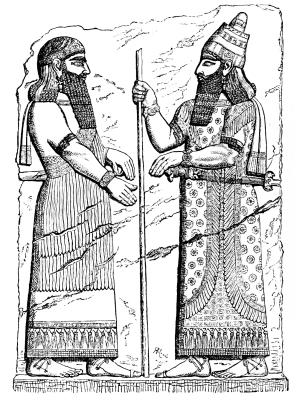
Fig. 69.—Relief from Corsabad. (Louvre.)
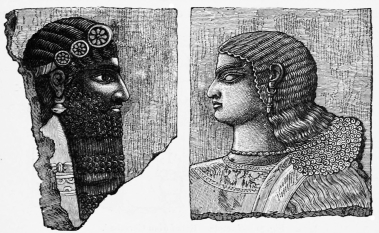
Fig. 70.—Fragments of Reliefs from Nimrud. (British
Museum.)
The monsters mentioned above form a peculiar transitional step between the full round and relief sculpture. (Figs. 66 and 67.) Winged bulls, or, more rarely, lions, with human heads and animal ears, flanked the larger portals as sacred guardians of the entrance. On the sides of the passage they were executed in relief up to the heads, which were worked almost entirely free, and project, with the royal or divine tiara, from the main block. In the front view, the breast and fore legs, as well as the head, appear in the round. This combination of round and relief carving resulted in two abnormities. In the first place, the animals have five legs, as the side was allowed four, while the front, besides the support which it had in common with the side, demanded another, that it might not appear one-legged. Further, the monsters seem, in the relief, to be striding and advancing, but in the front view to be firmly standing. These cherubims—for thus the commentators of the Bible call such “forms having a human head, the body of a lion or bull, and the wings of an eagle”—are among the most characteristic works of Mesopotamian sculpture. They were imposing symbols of guardian deities; the hair of the head and beard curled tightly, as did that of breast, abdomen, and the end of the tail; the feathers of the powerful wings were almost straight, the legs hard and muscular, the expression of the face severe and majestic. Lions of normal formation, exceptionally occurring in the place of these cherubims, show so masterly an understanding of nature and such wise conventionalization that, with the sphinx-like lions of Egypt (compare Fig. 31), they rank among the most successful representations of animals in any period of sculpture. Prominent among the subjects shown by the reliefs, serving the purposes of mural decoration, is the so-called tree of life, a symbol not adequately explained, a plant form woven in ribbons and anthemions to an ornamental play of lines, before which stand sacrificing figures or winged genii with eagle-heads, holding in the one hand a basket, in the other a species of pine-cone, or in the one a lotos-flower or a scourge, and in the other a gazelle or a small lion. Upon this follow the long{88} processions advancing in homage before the king, which so fittingly covered the walls of the courts. The monarch stands to receive his vizier, who is followed by several warriors. (Fig. 69.) Behind stand eunuchs—one holding a sun-shade, another a fan for flies, a third a handkerchief, a fourth drinking-vessels, a fifth jugs with bottoms formed like the jaws of a lion (used to dip out wine from the large cooling-vessels), a sixth a wine-skin; the two following have a large platter with food and the stand belonging thereto; another comes with two models of cities, perhaps to be explained as dishes; then two with a throne, the next with a table, those following with a bench; others, again, with a magnificent chariot, the tongue of which is carved as a horse’s head and the cross-pieces as the heads of gazelles,{89} while the rich back of the seat is supported by human figures; two helmeted warriors follow this, with a less elaborate war-chariot, and others lead four horses to the scene. A similar representation shows subjects bringing gifts to the king. Some lead horses; numbers of others present flowers and fruits, among which apples, pomegranates, grapes, pineapples, figs, etc., may be distinguished; those following offer cakes, locusts strung upon sticks, hares, birds, and the like. The figures upon these ceremonial reliefs, generally over life-size, are carefully executed to the smallest detail. Little can be said concerning their peculiarities of feature beyond that stated above, in the consideration of the statue of King Ashurakbal. In opposition to the wiry toughness of the Egyptian type, the voluptuous and vigorous fulness of the Assyrian appears distinctly in the full cheeks, the thick eyelids and brows, the widely opened eyes with curved and projecting balls, the energetic aquiline nose, the pouting lips, and the imposing growth of hair and beard, so neglected in Egyptian sculptures. Eunuchs are characterized by a lack of beard; the usual fulness degenerates into mere obesity in all the features, but especially in the heavy and hanging under-jaw, and the weak, fleshy arms, the only parts of the body not hidden by the garments. The fragments illustrated by Fig. 70, when compared with{90} Egyptian heads from reliefs (Fig. 28), will convey an idea of the entire difference of race and artistic style in the lands of the Tigris and of the Nile.
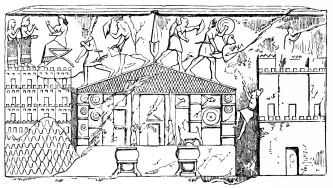
Fig. 71.—Temple. Relief from Corsabad.
In the works of Assyria, as in those of Egypt, the breast is usually presented in front view, for the reasons already set forth, but the attempt to show this part of the body in true profile is more common in the former country; an instance may be observed in the vizier of Fig. 69. The wrists, like the arms, are muscular and stout; the hands broad, coarse, and awkwardly stiff. Bracelets, closing firmly by means of a spiral spring, are placed upon the wrists and above the elbows. The magnificence of these and similar ornaments, which have frequently been copied by modern jewellers, and also the dignity of the swords and other accoutrements, strictly depend upon the rank of the wearer, being graded from the king and vizier to the warrior and eunuch. The most customary garment in time of peace reached from the neck to the ankles, and was often edged with a fringe of tassels and a double or fourfold border of pearls. The underdress is smooth and white, that of the king alone being richly patterned. The overgarment seems to have consisted almost wholly of fringes, leaving the right arm free. The royal mantle was also in this respect an exception, having two sleeves and covering the shoulders, besides being ornamented with rosettes or embroidered with mythological representations. The feet in Assyrian reliefs are long and powerful, more supple and true to nature{91} than the hands, though the toes lie too closely upon the ground. The monarch and his escort have rings upon the great toe of each foot; they wear a kind of sandal which covers only the heel, in wise recognition of the fact that a complete sole disturbs in some measure the natural elastic action of the ball of the foot and the toes. When the underdress is short, as is the case in hunting and warlike costumes, the leg below the knee is correctly but rather stiffly modelled; the muscles protrude like hard bands, without giving to the limb the vigorous force peculiar to Egyptian works. Yet the whole composition, as well as every detail of Assyrian sculpture, displays more direct study of nature than was to be found in Egypt, where the figures were created upon an abstract model,—a canon founded more upon convention than upon observation of life. Instead of remaining behind reality, as did the Egyptian, the Assyrian sculptor went beyond natural truth, exaggerating and coarsening. There the figures were without flesh and blood, ghost-like, as if their slim trunks and extremities were not fitted for earthly nourishment; here the material existence was expressed in the most positive manner. A voluptuous fulness was chosen as a type of the luxurious and contemplative Mesopotamian, in the same way as the elastic leanness of the Egyptian figure characterized the sinewy Fellah, emaciated from scanty nourishment and fatiguing exertion in his dry climate.
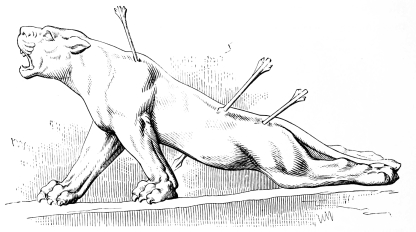
Fig. 73.—Wounded Lioness, from Coyundjic.
More than three quarters of the historical reliefs are warlike scenes, mostly on a small scale, with figures less than half a meter high. Cities are surrounded, set on fire, and plundered; when the fortress is situated upon a height, the besiegers build ramparts of{92} fascines, and, sheltered by these, attack the walls with battering-rams similar to those used by the Romans. The defenders attempt to burn these offensive machines with torches and to cripple them with chains, the latter being warded off from below with hooks and poles. It is also shown how warfare was carried on in the open field, upon wooded mountains, in swamps, and on the marshy banks of rivers, with the aid of lances, slings, and bows. The archers are sometimes protected by a kind of chain mail. It is represented with great clearness and fulness how the defeated enemies seek to save themselves by flight to a swamp, how friends and foes swim rivers supported upon inflated skins, while the king is transported in his chariot upon a ferry-boat. Some battle-fields are covered with the slain, whose severed heads are piled up to form a trophy of victory truly Oriental. At times the male prisoners of war are shown suffering death by torture; they are stripped to the skin and beaten with clubs, or are impaled and flayed alive in great numbers. The tongues and ears of others are cut off; while prisoners of higher rank are dragged by rings through the under-lip before the victorious king, who languidly deigns to blind them with a lance. At the same time, the monarch receives homage from kneeling subjects; players of stringed instruments celebrate his victory, while eunuchs record the amount of booty brought before him. The spoil is shown with great circumstantiality;{93} female captives, holding children by the hand and infants at the breast, advance on foot or are borne upon carts, and all manner of utensils and provisions are carried upon beasts of burden and drays. The captured herds—beeves, sheep, and camels—are given with wonderful truth to nature; like the animal types occurring in the act of homage upon the obelisk of Nimrud already mentioned, they are of masterly characterization—the peculiarities of the lion, antelope, buffalo, rhinoceros, elephant, and ape being carefully observed and admirably rendered. The same understanding of animal forms is shown in the often-repeated hunting scenes: the conception of the wounded beasts is truly wonderful. (Fig. 73.) Besides the capture of gigantic lions and buffaloes, the snaring of small game, hares and birds, is shown. Even the various species of fish can be distinguished in the reliefs, which show net and rod fishing.
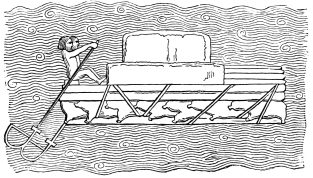
Fig. 74.—Transport of Stone. Relief from Coyundjic.
Many industrial occupations are also represented. Trees are felled, the trunks of which are floated upon the river as rafts, or are dragged behind boats, for the building of a royal palace; terraced mounds are heaped up by enslaved laborers with baskets of earth. Larger masses of building-stone, and the cherubims already described, are brought down stream from the quarries by means of rafts, the buoyancy of which is increased by inflated skins bound beneath them. (Fig. 74.) The statues are carried to the terrace platforms by inclined planes, up which they are drawn by hosts of workmen, who pull upon the cordage attached to the sledge, which{94} slides over rollers, and are driven forward by blows from the over-seers. (Fig. 75.)
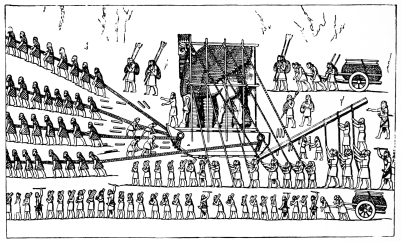
Fig. 75.—Transport of a Cherubim.
Religious representations are much rarer than in theocratic Egypt. The kings of despotic Mesopotamia arrogated to themselves the supremacy allowed in Egypt to the gods, who in the latter country had been placed by the priests in relation with every human action, and whose ceremonial scenes were so predominant. The typical winged figure described above occurs continually in small reliefs, and even in diminutive ornaments. In rare instances a griffin or a kind of Pegasos is employed in its place upon purely decorative works. The sacred symbol of the tree of life, or that of the great god Ashur—the winged and encircled figure already mentioned—is worshipped by standing or kneeling human beings and by inferior deities. Processions are represented bearing images upon thrones, and the sacrifice of lambs is shown, the animals being slaughtered and burned piecemeal. These purely ceremonial reliefs differ fundamentally from the historical scenes. In the former the figures are over life-size; they are carved with great attention to detail, and are never grouped, but placed at regular distances: in the latter the human beings do not receive the attention devoted to the inanimate objects occurring in the pictured story, and especially to the indications{95} of its locality. The fortifications of besieged towns are mapped out with scrupulous exactness, and are easily understood when it is borne in mind that the effect of distance, from the lack of perspective in this primitive art, is expressed by piling things upon one another which were in reality behind one another. Buildings are shown by reliefs like those given in Figs. 35 and 57, with a more or less successful attempt to clearly illustrate constructive details.
The landscape is conventionalized in a peculiar manner. Fields of grain upon regularly rolling hills are designated by wavy lines; the trees are usually suggestive of the carved toys accompanying the well-known Noah’s ark of our children—this impression being heightened by the trunks radially diverging from the hill, that they may be the more closely grouped together. The childlike art of the Assyrians here expressed a common error of childhood—that more trees can grow upon the increased surface of a hill than upon a plain with an area equal to the base of the hill-cone. At times, when necessary for the characterization of a locality, palms, grape-vines, figs, and other plants are indicated by a detailed imitation of leaves and fruit. Lakes, rivers (Fig. 74), and swamps are carefully drawn in wavy parallel lines with spirally conventionalized ripples; they are bordered with reeds and sedges, and inhabited by aquatic animals easily recognized by the naturalist. The events are represented in a simple and straightforward manner; unimportant figures are diminutive and less carefully carved, while the chief actors in a scene not only tower above their fellow-beings, but even above trees and fortifications. As the only intention of the artist was to represent a locality and an occurrence, he did not hesitate to give a city such proportions that the defenders upon its battlements could never have passed through its gates, and, standing upon the ground, would have overtopped the towers.
These conventionalized types do not appear in the bronzes, sheathings of thin wood-work, bowls, and other vessels, or in the rarer remains of ivory carvings. A number of objects of this kind, discovered during the excavations of Nineveh, are deposited in the British Museum. The better preserved and more easily recognizable among the ivory carvings are of Egyptian style, and even in some instances represent Egyptian religious ceremonies. This is{96} also, in a measure, the case with the bronzes, which are composed of ten parts of copper and one of tin; though a majority of these show thicker and heavier forms, especially in the animals, and strikingly remind one of similar utensils discovered in Phœnicia and Cyprus. These articles must be considered either to have been directly imported, or so slavishly copied from foreign originals that they are at present not surely distinguishable. There can be little doubt that the native place of the bronze vessels was Phœnicia, and not Egypt. The former country, as proved by the repeated allusions of Homer and other early authors, was famed in the pre-historic ages of Greece for the manufacture of metal utensils, and especially for an extended employment of the bronze supplied by the copper-mines of Cyprus and the tin trade with England. When considered in connection with the well-known extent of Phœnician commerce, this derivation of the metal remains found at Nineveh is rendered more than probable.
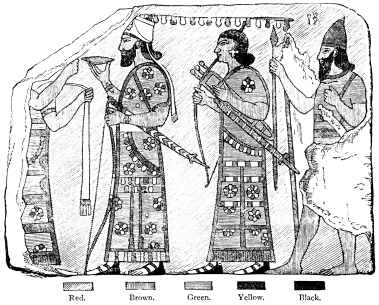
Fig. 76.—Glazed Terra-cotta, from Nimrud.
The few and unimportant vestiges of Assyrian painting add little material to the history of art. It has already been mentioned that the palace walls were covered with a colored facing, shown by fragments found among the ruins to have been of painted stucco and glazed tiles. It consisted of bands of ornament, rows of rosettes and anthemions, woven strap-work, conventionalized mythical animals, and other forms arranged in set regularity. This treatment was adopted especially for the exterior and for the courts, where imposing ceremonial reliefs with colossal figures covered the lower surface of the wall. Animals the size of life are given in yellow upon a blue ground, such mosaic mural decorations being formed of tiles drawn and colored with reference to their ultimate position. (Fig. 64.) There are also paintings corresponding to the reliefs of alabaster common upon the lower half of important walls. With figures somewhat over 0.2 m. high, they represent scenes which appear to have stood in some relation to the carved ornaments of interior chambers. The most important of the fragments preserved shows a king, who, returning from battle or the hunt, is about to place to his lips a bowl handed him by a servant. (Fig. 76.) The bow which he holds in his left hand rests upon the earth; a sword hangs by his side. A eunuch with bow, quiver,{97} and sword, and a warrior in short dress, with lance and pointed helmet, follow him. The garments are outlined by a broad band of yellow color, somewhat similar in effect to the heavy leading of mediæval stained glass-work, which increases the impression of flat stiffness peculiar to the Assyrian costumes of baggy cloth without folds. The head, arms, and legs are drawn in simple lines. A dark-yellow border separates the green dress from the red background, and the brownish color of the exposed flesh. White is intermingled with yellow in the rosettes, fringes, swords, etc.; the hair, beard, sandals, and the pupils of the eyes are black. Other fragments illustrated by Layard have a green background, yellow flesh, blue garments, horses, fishes, etc., all drawn with a heavy white, or, in rare instances, brown, outline. It would be difficult to determine whether these pigments have preserved their original color, and whether, indeed, some tints are not entirely lost. Chemical analysis has demonstrated that several metallic preparations were known to the Assyrians. The yellow is that preparation of antimony and lead{98} which, under the name of Naples yellow, has been supposed a modern invention; the blue is a combination of copper and lead, also praised as a device of recent date in its application as a flux for glazing. The white is an enamel of oxidized tin, commonly held to have been first employed by the Arabs of Northern Africa in the eighth or ninth Christian century; the red is a suboxide of copper.
In regard to the style of these paintings, little can be added to that already stated in the consideration of Assyrian sculpture. The figures are somewhat more slender, and seem at times to betray a slight Egyptian influence. As in that country, the tones of color within the firm outlines are without modulation, differing only in the hues of the substances they represent. The composition is, perhaps, more picturesque, the figures frequently covering each other with varied position and action. The carved slabs which served as a revetment of the lower wall-surfaces were brought into harmony with the paintings above them by the addition of color to the reliefs. The hair, beard, and the pupils of the eyes were black; some parts of the dress, as the ribbons of the tiara, the sandals, etc., red. There is no doubt that other tints, not now recognizable, were added to the sculptures; but it must not be held that this painting was so brilliant and decided as some restorations represent. If the uniform effect of a completely painted wall-surface had been desired, the carving would largely have been given up. The best ornamental treatment of the architecturally bare surface was given by the marked division of its height. If the light openings of columns and pilasters, just under the ceiling, be assumed to have existed above the high and unpierced wall, as a distinct horizontal member crowning the enclosing mass, we can but admire this combination, in the Assyrian palace, of superposed courses of sculptured, painted, and architectural works.{99}
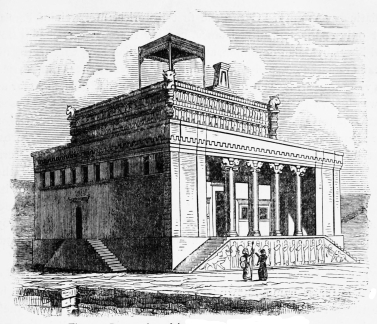
Fig. 77.—Restoration of the Palace of Darius,
Persepolis.
THE fall of Nineveh, instead of being despicable—according to the common legend—from the weakness of Sardanapalus, the last Assyrian king, deserves rather, from the heroic ruin of the monarch with his city, to be compared to the fall of Carthage or of Jerusalem. It removed for some time the centre of Western Asiatic power farther to the east, beyond the Mesopotamian streams: first to mountainous Media, whose inhabitants, through want of culture, were better fitted to destroy than to build, and who, therefore, play almost no part in the history of art. As the short reign of Median greatness passed away, political power tended to the southeast, to Persia, which raised its world-renowned kingdom upon the ruins of the Median, and stretched the boundaries of the new empire far beyond any former compass of Western{100} Asiatic sovereignty. Cyrus, the first historical monarch of Persia, not only conquered all resistance, notably that of Nebuchadnezzar and his Babylonian dominion, and of the Lydian king Crœsus (by no means remarkable solely on account of his great riches), but carried his victorious arms even to the Ægean Sea; so that Asia, in so far as it was known to Europe, was synonymous with Persia. Cambyses, successor to Cyrus, crushed the oldest power of the world, that of the Pharaohs; and the third Persian king crossed the Bosporos, that he might embody in the colossal Persian empire the eastern lands of Europe and the borders of the Pontos. Persia, by the personal greatness of some of its rulers, by the healthy force of its original inhabitants, as well as by marked good-fortune, thus attained a position in the history of the world hitherto equalled by no other country; and it was by no means wanting in a corresponding monumental expression of this advance.
The chief cities of the land—Susa, Pasargadæ, and Persepolis, for which latter, a name known through Greek historians, we might substitute New Metropolis of the Persians—strove, at least in their royal palaces, to surpass the cities of the Assyrians and Babylonians. Diodoros speaks of Persepolis as “the world-renowned royal fortress,” imposing even to the Greeks. The thousands of years that have passed have yet left remains sufficient for an ideal reconstruction of the whole, and a conception of the artistic ability of the Persians may there be obtained. This is less the case with Susa, more destroyed, and in no wise thoroughly examined. Its site, known by the name Shush, which still clings to the ruins, is revered by Mohammedan pilgrims as that of the tomb of Daniel, in like manner as the location of Nineveh found traditional confirmation among them in the Mohammedan chapel of Jonas. The remains of Pasargadæ, near Murgab, are somewhat better preserved than are those of Susa. Beside its palace terraces, among its other tombs, altars, etc., there rises, nearly intact, one of the most wonderful monuments of the world—the tomb of the great Cyrus. Most important, however, and worthy of chief consideration, is New Pasargadæ, or Persepolis, where the massive palace ruins near Istakr, known under the name of Chehil-Minar (forty columns) or Takt-i-Jemshid (throne of Jemshid), have for centuries been the wonder of travellers.{101}
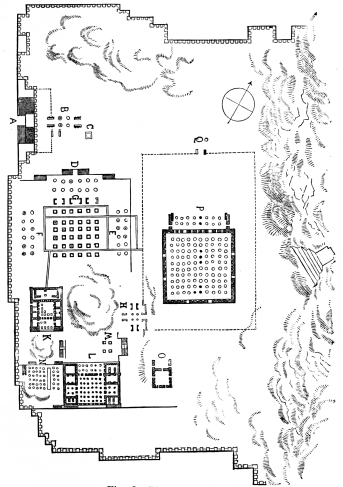
Fig. 78.—Plan of Persepolis.
A. Grand Stairway. B. Propylæa of Xerxes. C. Cisterns. D, E,
F, G. Great Hall of Xerxes. H. Portal between the Palaces and
Harem. K. Palace of Darius. L, M, N. Palace of Xerxes. O.
Unrecognized Ruins. P. Harem. Q. Portal to the Court of the Harem.
The Persians, of later development than the Mesopotamians, naturally based their art upon the older culture of the people conquered by them. The palaces were similarly placed upon extensive terraces, which, like those in Nimrud, seem to have been afterwards enlarged to make room for several royal dwellings. The palace terrace{102} of Persepolis (Fig. 78) is, as an exception, not isolated, but so placed as to employ a rocky plateau, which, levelled partly by excavation, partly by filling, acquired architectural character by the vertical revetment of its borders: it abutted with one of its oblong sides upon a cliff, this forming a background of richly carved tomb-façades. The casing of the platform beneath the Palace of Kisr-Sargon (Corsabad) consisted of a masonry formed of quite regularly hewn stones. At Persepolis, on the other hand, is employed, in a similar position, a kind of Cyclopean masonry with predominant horizontal lines—a proof that this wall does not necessarily indicate a greater age than does a facing of hewn stone.
In spite of the close relationship of the architecture of Persia to that of Assyria, the ruins still show in many points such a fundamental difference that Mr. Fergusson’s nearly absolute identification of the art of the two nations cannot be accepted, and a higher grade of independent position, at least in architecture, must be granted to the Persians. The Assyrian ruins showed walls and no columns; in Persia, on the contrary, we find columns and no walls. In view of this, it is a daring hypothesis to assume that chance has preserved here only the one, there only the other, constructional member—that the Persian ruins exhibit the skeleton, as it were, the Assyrian the flesh, of one and the same architectural body, the totality of which is only to be understood and explained by the mutual complement, the combination of the two. For such is Mr. Fergusson’s view. The inadmissibility of transferring Persian columns to Assyrian palaces has already been made evident.
The peculiar formation of plan recognized in the ruins of Nineveh, the narrow and corridor-like chambers, required no interior supports. The clumsy disproportion of the long and cramped Assyrian rooms seems rather to have been decided by the lack of such constructive assistance; with it, on the other hand, the Persian palace was enabled to develop freely. The subordinate shafts in the windows of the palaces at Nineveh did not partake of the true nature of a column, they did not serve to enlarge an enclosed space, but were merely decorative substitutes for the piers which elsewhere separated the openings. It is not possible to transfer the characteristic Persian details either to these or to the columns in antis of the{103} Assyrian temple cellas. The sculptured reliefs mentioned above, from which alone the columns of Assyria are known, present an entirely different class of forms. The Persians recognized the full importance of columnar construction in opening and enlarging enclosed spaces as no other nation has done except the Egyptians. It is in this that the artistic advance of the former beyond their Chaldæan and Babylonian predecessors consists.
The columns of Persia were developed with a characteristic conventionalization which, though not entirely without foreign precedents, was upon the whole original, and, at least in the more simple varieties, decidedly artistic; the capital was peculiarly adapted to its functions. But one small fragment has been found of the ancient remains of Pasargadæ, dating, according to inscriptions, to the epoch of Cyrus. It is a base, and is fortunately characteristic and interesting. (Fig. 79.) The tore is similar, upon the one hand, to the plinth-mouldings of Assyrian columns; upon the other, in its detail, to the more recent creation of the Ionic column, which was not without connection with the art of Mesopotamia. The ornamentation consists of shallow horizontal channellings, with sharp arrises like those of the so-called Proto-Doric shafts of Egypt, and is closely allied to the bases of the most ancient examples of the Ionic style. The terrace of Persepolis, with its monuments, built during or after the time of Darius, displays these bases only in the palaces built by that king. The tore there occurring was placed upon two square plinths. The later monuments of Persepolis, which, for the greater part, were built by Xerxes, show the base to have kept pace with the further advance of the shaft, and to have consisted of multiplied and embellished members. The square plinth is supplanted by a beautifully curved calyx, turned downward and ornamented by two rows of leaves—the upper rounded and heart-shaped, the lower lanceolate. To this is sometimes added a wreath of anthemions, which appears to have been taken from Syrian or Phœnician models. The projecting moulding of these more elaborate examples is diminished in size, and has lost the horizontal{104} grooves. The shaft, with thirty-six shallow channels, separated by sharp arrises like those of the primitive base, rises upon the combined tore and plinth to a height of nine times its lower diameter. It is not inconsiderably diminished. The junction between shaft and base is effected, as in the Ionic style, by a gentle curve, ornamented by a small roundlet. The capital shows, instead of the floral form usual in other countries, an animal combination, which, from the analogy of certain gold coins of Western Asia, appears to have been a widely known symbol. It consists of two bull’s heads and shoulders, grown together back to back, with the front legs bent under them in a recumbent position. The head is drawn upward, the elegantly curved neck being ornamented by a rich chaplet. Upon the common back of the two animals lies the chief transverse beam of the ceiling. A description of the peculiar style of carving will be given in the section upon Persian sculpture. It may only be here premised that the general treatment of the animals is quite similar to that noticed in Assyria. The capital is particularly well adapted to receive and support two ceiling timbers crossing above it at right angles; the lower of these shows its section upon the front of the building, and rests upon the back of the bulls; while the epistyle beam upon it, which joins the columns and{105} is seen in its whole length upon the front, is supported by the heads and by the main timber between them. This method of laying the ceiling beams was the reverse of that followed by the architects of other nations. The timbers of the ceiling, which run at right angles, are usually placed upon, and not beneath, the connecting epistyle.
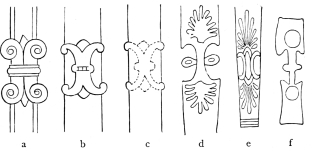
Fig. 81.—Spiral Ornaments upon Chairs.
a. From an Assyrian Relief. b. From the Vicinity of Miletos. c.
From Xanthos. d, e, f. From Paintings upon Greek Vases.
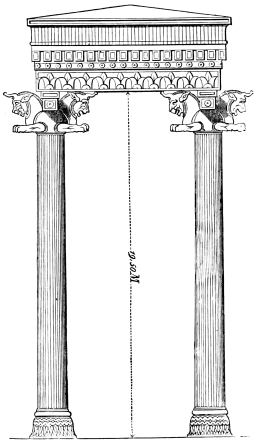
Fig. 82.—Columns from the Eastern Portico
of the Hall of
Xerxes.
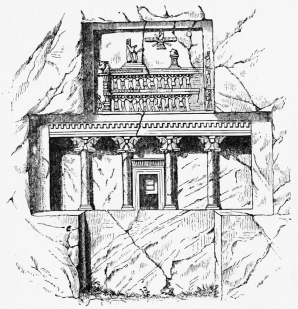
Fig. 83.—Rock-cut Tomb of Darius.
In the time of Xerxes, these simple bull capitals appear not to have satisfied the increasing demands of luxurious elegance. Three new members were therefore placed below them, and the entire capital became almost as high as the remainder of the shaft, which was naturally much curtailed by this innovation. (Fig. 80.) The two lower of these new members may perhaps be counted as one—the wreath of falling leaves being regarded as part of the calyx above it. These leaves are very simply treated; they do not curve, and are terminated by a semicircle: between them and the calyx there is a small egg-and-dart moulding; that is to say, a wreath of small leaves entirely bent over. As the derivation of this characteristic member cannot be traced to Syria, the supposition is natural that it was derived from the Hellenic architecture of Asia Minor, which had been fully developed in its principal aspects since the time of Darius. The general form, as well as the detailed decoration of the upright calyx by narrow bundles of lotos-flowers, points so distinctly to an Egyptian model that it must, without further question, be ascribed to the influence of that land, which had been subjugated by the Persian Cambyses. After a repetition of the egg-and-dart moulding, there follows above the calyx a remarkable{106} member of sixteen spiral rolls, as similar to the forms of Assyrian as to those of Ionic capitals. The spirals are so placed around the oblong kernel of the shaft that two touch upon each of its angles—thus standing vertically, and not horizontally. The derivation of the form appears to be owing more to Assyrian-Mesopotamian reminiscences than to any influence of the Greek Ionic style. The remarkable vertical position of the volutes is better explained by subordinate ornaments of the former than by architectural members of the latter land. The decorations upon the legs of thrones and other parts of furniture, shown by reliefs, prove the helix to have been more frequently used by the Assyrians as the vertical ornament of a shaft than as a horizontal coronation—a capital. (Fig. 81.) That the former usage was extensive is shown by the similar occurrence of the form upon Greek examples from Asia Minor. The spiral, with concave or convex fluting, with ribbed and channelled rolls, was originally double; in Persia it was transferred to a four-sided shaft, to serve, not as a coronation, but as a vertical ornament, as one of the three or four distinct members of the complicated capital. The{107} double-headed animals were placed upon it as the termination of the column. In the mythological sculptures of Mesopotamian lands, lions and bulls shared equally the honors of frequent representation; and upon the capitals of Persepolis a horned and double-headed lion was substituted for the double-headed bull. This, however, was not in an important position, and the change is known by only a single example—the eastern portico of the Great Hall of Xerxes. (Fig. 82.) The isolated attempt was the more successful because no other animal forms had been so well conceived and characterized by the Orientals as the lion; that king of beasts, with open mouth and powerful paws, was the favorite subject for decorative treatment down to the latest times of Hellenic art. As the comparatively short fore legs of the lion could not be bent underneath the body, but were necessarily extended from the shoulder, the general outline of the capital was impaired by a long and straight horizontal line just at its junction with the shaft; and on this account the lions, notwithstanding their more majestic heads, could not displace the traditional bulls.{108}
As the entablature was in all probability entirely constructed of wood, and has disappeared without a trace, the restoration of this part of the building is difficult. But the normal forms may yet be determined with greater correctness than is presented in Coste’s restoration (Fig. 82), which is a tasteful combination of the scotia and roundlet cornice common to both Egyptian and Assyrian architecture, with dentils and the leaved ornaments found above all the doors and windows of Persian remains, and with the decorations upon the borders of staircase buttresses. A number of rock-cut tombs appertaining to the early Persian kings, the Achemenidæ, and dating from the time of Darius, represent the façades of royal palaces, and give important information concerning the exterior appearance of such structures. The oldest and best-preserved of these is designated by cuneiform inscriptions as the tomb of Darius. (Fig. 83.) It is especially interesting as illustrating the formation of the entablature. An epistyle, triply stepped, like that of the Ionic style, so that each face slightly projects beyond the one beneath it, is placed above the transverse beam, which lies upon the backs of the double-headed animals forming the capitals of the columns. The multiplication of the faces of the epistyle is explained by the weakness of the timber produced by Mesopotamia and Persia, which, in opposition to the single and massive Doric lintel-block, required the employment of several beams to obtain the desired capability of support. Upon it followed the ornaments known as dentils, representatives of the small and closely lying joists of the horizontal, slightly projecting roof. They are quite similar to the dentils upon the tombs of Beni-hassan, and to those of the still more naïve imitations of wooden houses found in Lycia, which will be considered in the following section.
In Persia, the proportions of the dentils and of the distances between them are still characteristic of the original timbered construction—a truthfulness of imitation which was lost as early as the development of the Ionic style. The nature of the band following above is not clear; it might be natural to suppose in it a representative of such a hollow cornice with leaves as Coste has introduced upon his entablature, were it not that a frieze-relief with ornamental lions is visible upon this member in another tomb, and that a remarkable block of{109} the Palace of Darius at Persepolis bears further testimony against it. One of the corner piers of the front portico of that building has been preserved to such a height that the side bearing of the lintel can be observed. This renders the projection and outline of the entablature certain. It was six times stepped, and may best be reconstructed, as in Fig. 84, by a series of narrow bands, which represent in some measure the layers of the horizontal ceiling and roof. From a comparison with the rock-cut tomb, it is plain that a further cornice, like that over the door and window-frames, was here not possible. If a parapet had been desired for the accessible platform of the roof, it must have taken the form of a light balustrade, not that of a heavy scotia cornice.
The oldest and, because best-preserved, the most intelligible of the royal dwellings upon the terrace of Persepolis is that shown by inscriptions to have been built by Darius. (Fig. 85; and K upon the topographical plan of Persepolis, Fig. 78.) It exhibits a regular and well-considered plan, the oblong form and general disposition of which are somewhat similar to the simpler Greek houses. A flight of steps led from each side to the narrow southeastern front—a double tetrastyle loggia. This was flanked by two moderately large rooms, which, as they could be entered only from the portico and had no connection with the interior, were probably intended for guards or servants. A door, between four windows, opened into the square hall, the ceiling of which was supported by sixteen columns, standing in line with those of the loggia. This space corresponded to the atrium of Greek and Roman houses. Three of its sides, that of the front being excepted, had access to inner rooms—those upon the right and left being small, while, opposite the entrance, they were more spacious, and separated from the hall by a corridor. The walls were enriched by niches as well as by door and window openings. Through{110} one of the chambers upon the left was a lateral entrance, reached by a double flight of steps upon the southwest. Notwithstanding the preservation of the special foundation terrace, of the steps, of the door, window, and niche frames, as well as of some corner piers, the ruin did not at first glance make evident the disposition here described. All the columns of the palace have disappeared. It is uncertain whether this is because the supports of the less pretentious structure were of wood, or whether stone shafts, of the moderate dimensions which must be assigned to them, were carried away during the two thousand years in which the ruins of the palace terrace have served as a quarry for neighboring towns. The square plinths upon which the columns stood have, however, remained in their original position, so that the number and site of the supports may be easily and surely determined. The greater portion of the walls has also disappeared. Some corner piers and the marble frames of doors, windows, and niches, cut from immense monolithic blocks, alone stand erect; but their perfect state of preservation and well-marked position permit the nature of the wall between them to be determined without difficulty. It seems that this was of small quarried stones, or even of brick, thus being easily removed, or, in the latter case, reduced to dust by atmospheric influences; while the massive door and window casings were secure from removal by man and from the injuries of time. Their stepped jambs are decorated upon the inner side with reliefs; the heavy lintels have a scotia cornice, carved with a triple row of leaves and bordered below by an astragal. Of the openings for providing light to the great hall no traces remain. If, as is usually supposed, the windows now recognizable were all that ever existed, the chambers of the palace would have been most gloomy, with the exception{111} of the hall of columns, which had four openings upon the loggia, besides the door. The light of the hall itself must have been dim, for it could not enter directly, the windows and doors being beneath the shade of the deep portico, with its double range of columns; and when still more impeded by the close-standing shafts of the hypostyle, it would have been wholly insufficient for the chambers. It is further to be remarked that several of the inner rooms have no direct communication with the hall, while if they had depended on it for light they would certainly have been provided with window-openings in place of the blind niches. It is evident from the existence of a second story, presently to be discussed, that horizontal apertures in the roof and ceiling could not have existed; this would be even more inadmissible here than in the palace buildings of Nineveh. It is necessary, however, to assume other openings for illumination and ventilation than those now to be observed in the ruins, and windows were most probably arranged in the manner in which the Orientals still secure their dwellings from the view of the outer world while admitting light and air—the manner customary with the Assyrians, as well as with the more ancient Greeks. The apertures were probably upon the exterior walls, just under the ceiling, high above the ground. All traces of architectural members in such a position must necessarily have disappeared when the mass of masonry which supported them was overthrown. It is possible that their form was entirely plain, like that given in the restoration of the Palace of Darius at the head of this section (Fig. 77), and offered no carved details to aid in their recognition.
A comparison of the rock-cut façade upon the tomb of Darius with the palace of that king will aid in the consideration of the upper story. As the tomb represents the palace with but slight variations, even agreeing tolerably well with its proportions, it may be supposed that the monarch copied his dwelling upon the front of his grave, that he might, as it were, inhabit it even after his death. This is not an isolated instance of such a proceeding in the history of architecture. The second story, distinctly recognizable upon the tomb, cannot be regarded as an insignificant decoration, especially as the Palace of Darius at Persepolis seems, from its plan, to{112} have been thus arranged. The limited area covered, exceeded by many a modern private house, renders an enlargement by a second story natural; and this is also made probable by the hypostyle, which occupies a place where an open court, with full upper light, would otherwise have been more suitable. Space for the staircases was provided by the two narrow corridors next the rear chambers. The second story was not, however, extended over the entire ground-plan, but seems to have left the flat roof of the side chambers as an elevated veranda, perhaps sheltered from the sun by canopies, as the talar, a similar though smaller upper structure, stands as a pavilion upon the modern houses of Persia. The walls of the second story could scarcely have been placed elsewhere than upon the otherwise unreasonably thick partition-enclosure of the hypostyle hall. They could not have stood over an intercolumniation, as upon the façade of the rock-cut tomb—for this would have been difficult, if not impossible of construction—but in other respects the upper part of the palace may have been like that representation. Its corner supports, which are a strange combination of scotias and roundlets, ending below in lion’s paws and above in a one-sided lion capital, have, at least, every appearance of being copied from an architectural model, and are similar in their lower half to the legs of the throne given in Fig. 87. The standing figures, which, in double row, support the ceiling, may have been carved in relief or simply painted. That this was a common ornament is evident from its repetition upon the reliefs of gateways, where such typical figures are admirably characterized as representatives of the various nations subjugated by the{113} Persian power, they literally supporting the throne. The entrance and the second-story windows may be supposed to have been upon the side opposite the front, where the veranda was broadest and the staircases led from the lower floor, as otherwise the imitation of the façade upon the rock-cut tomb would have shown windows and doors as well as a staircase, which probably led in double flight to the uppermost roof. That this house-top was flat and accessible is evident from the reliefs considered in this connection (Figs. 83 and 87), one of which represents the royal throne shaded by a canopy, the other one of those fire-altars which, according to Persian custom, was placed upon the highest level of the house. This altar upon the summit of a royal palace is mentioned in the Bible, when Hezekiah, overthrowing the Sabæan worship of the sun, destroyed “the altar which is upon the top of the upper rooms of Ahaz.” In the restoration of the Palace of Darius (Fig. 77), the introduction of the altar with the royal canopy may be considered as more than a mere decoration of the design. This simplest and best-preserved ruin upon the terrace of Persepolis permits a comparatively trustworthy understanding of the elements of Persian palace architecture.
The ruin O of the topographical plan (Fig. 78) shows the remains of a similar structure of about the same dimensions, later, and therefore of less interest, than the Palace of Darius. The Palace of Xerxes (L, M, N) was nearly double this size, being provided with a spacious terrace before its gates, and with a colonnade upon one{114} side, the nature of which cannot readily be explained. On the other hand, it had no large chambers behind the hypostyle, as the rooms upon the right and left seem, by their more spacious proportions, to have rendered these unnecessary. The portico was hexastyle, and the square hall behind it consequently provided with thirty-six columns. Two of the side chambers were so large that their ceilings required the support of four columns.
Of still greater dimensions, more than eight times the area of the Palace of Darius, was the Palace Hall of Xerxes (D, E, F, G) which was preceded by a magnificent double flight of steps. The ceiling of the imposing hypostyle was upheld by thirty-six columns of gigantic size. There are no traces of chambers having been connected with it; three of its sides were provided with hexastyle porticos, which masked and artistically enlivened the dead enclosing-walls. The masonry has disappeared, with the exception of unimportant remains of the portal (G), which Coste has restored as the foundations of pedestals. Although a similar ruin at Susa, examined by Loftus, was also without walls, it is impossible to agree with Coste that these were originally altogether lacking, and that the columns of the central space were unenclosed—that the three portals, provided with separate roofs, were grouped around this without any connection. While we agree with Fergusson in as far as regards the completion of the wall line and the unity of the whole under a common roof, we must yet discredit his further assumption that this building was provided, like the Palace of Darius, with an upper story; all the requisite conditions for this were lacking. The ruin is remarkable from the remains of the colossal columns being in the comparatively best state of preservation. They represent the three orders described above: those of the western portico having the double-headed bull; those of the eastern the double-headed lion, and the others the form of shaft coronation combined of three or four members. The destination of this building was not that of a dwelling, but, without doubt, that of a festive hall for the audiences and ceremonies of the vainest and most magnificent of despotic monarchs. To this end it was fittingly placed next to the entrance-gate of the palace terrace. It is one of the most enormous buildings of the world; the area covered by{115} its plan, about 10,500 sq. m., nearly equals that of the Cathedral of Milan, and surpasses that of the Cologne cathedral by about 2350 sq. m.
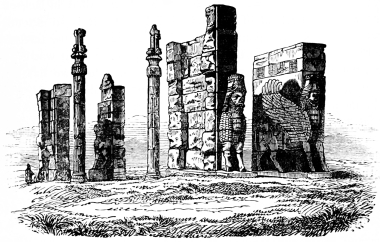
Fig. 88.—Propylæa of Xerxes at Persepolis.
The imposing portal next to it, B, proved by inscriptions to have also been erected by Xerxes, remains upright in the grand masses shown by Fig. 88. An adequate explanation of its nature is not possible. It is only clear that its principal disposition, like that of the similar portal, H, of the terrace, was determined by the intersection of passages, the crossing being marked by four columns, while the parallel walls were of sculptured marble blocks. In a former work upon the history of ancient architecture,[F] the author has expressed the supposition that side walls were built in the directions marked by dotted lines upon the topographical plan (Fig. 78), connecting the portal with the ascending staircase. The gate would thus receive the character of a fortification, a termination of the palace terrace, instead of being the useless structure, easily to be circumvented, which it is commonly considered. It is probable that these side walls existed also at the chief portals of the Assyrian palaces, as otherwise the entrances, especially that of the harem,{116} would have been too much exposed. These masses of masonry have disappeared from the ruins of Nineveh, because of the crumbling of the terrace borders, and in Persepolis, where all walls have been overthrown and carried away, their extent is not marked by the more durable door and window frames, which alone remain of the palace enclosures.
The assumption of similar communicating walls in connection with the other portal structures of the palace terrace (H and Q) not only renders to these their full importance, but throws light upon a building of enormous extent (C), the destination of which has hitherto been problematical. This edifice has been called, in lack of a better name, the Hall of a Hundred Columns. It is an extended enclosure of square plan, within which stood columns, traceable by the remains of six of their number. Upon the front was a portico, not decastyle, like the interior, but octastyle; two bases remaining in situ determine its arrangement and dimensions. The columns may be calculated, from their lower diameter, to have been about 7 m. high. The enclosure of the hall, determined in extent by the remains of all the portals and niches, measured 68 m. upon each side. According to general acceptance, the building was restricted to the area now covered by its ruins, and served as a second great hall for ceremonies. Fergusson terms it a coronation hall. But, apart from the fact that the Hall of Xerxes must have been far better fitted by its imposing proportions for such a purpose than this low and broad space, where the forest of columns would have impeded the view, it is hardly possible that two such extensive buildings would have been provided upon the terrace for the same use. But some adequate space is yet to be assigned to that important necessity of Oriental custom, the harem, which tradition particularly asserts to have existed among the Persian palaces. If the ruin is examined in its relation to the other palace structures of Persepolis, it becomes plain that it can be nothing else than the central hall of a similar, but more extended, series of chambers, of which, as is also the case with the ruined remains at O, hypostyle and portico have alone been preserved, while the walls of all the outer rooms have disappeared. Only the doors and windows of any wall upon the terrace now exist; and as the entrances were naturally small{117} and the openings for light high above the ground, in the enclosure of the harem, it is not surprising that this masonry has disappeared in almost its entire extent. Two principal portals, perhaps the only ones of the outermost walls, have been preserved, however, and mark the outline of the building. These are the gateways H and Q of the topographical plan: the first of these even shows some trace of the enclosing wall; it is the entrance from the palaces K, L, M, N, and O; the second probably led to an open court, to which access must have been allowed the fair prisoners. The space between the hypostyle and the exterior wall, indicated upon the plan by dotted lines, must have been occupied by the numerous small rooms which provided dwellings for the three hundred girls of the harem. The low and broad central hall served as a place of assemblage; the great number of its columns and the excessive lowness of the ceiling exclude the idea of its having been used for public ceremonies, but render it particularly fitted for this purpose, the many shafts separating the groups of intimate conversers. The dim twilight of the room was, at these evening assemblies, enlivened by the many-colored lamps of the East. The harem upon the terrace thus received a development analogous to that of the royal dwellings, and its necessarily great extent was provided for in a becoming place. By the assumption that the remains at P are those of the harem, an integral part of the Oriental palace is recognized, and a large tract of the terrace area is occupied, the use of which could not otherwise be designated upon the topographical plan.
The disposition of the terrace under Darius appears to have differed considerably from that under his successors. It is not known whether its extent has since been increased; to establish this point, extensive excavations would be required. It is probable that the northwestern side of the plateau has been built out by adding earth to the natural rock; the buildings upon the southern half appear the more primitive: it is certain, however, that the position of the ascent was changed during the great reconstruction completed by Xerxes, and possibly commenced during the latter part of the reign of Darius. The orientation of the Palace of Darius, which, of all the buildings at Persepolis, alone faces the south, shows the great staircase to have been originally upon the southern end of the terrace.{118} Enormous dowelled blocks of stone assured the stability and preservation of the newer parts of the substructure. The broad and gently rising flights of steps remain in so good a condition that it is even to-day possible to ascend them upon horseback.
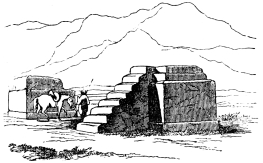
Fig. 89.—Altar Pedestals at Pasargadæ.
Among the remaining monuments of Persian architecture there are no temples; it would be vain to seek such structures; the worship of the land did not demand closed rooms, requiring only sacrifice and prayer upon the summits of mountains or artificial elevations. Herodotos relates that the Persians not only scorned temples, but did not erect images of their deities, nor even altars. This last point is certainly incorrect; the worship of fire particularly called for altars, and these are represented upon the ornamented façades of the rock-cut tombs. (Fig. 83.) It is probable that two pedestals, standing near each other upon the palace terrace of Pasargadæ, are ancient Persian. They are cubes, each about 3 m. high; one is terminated by steps, and has upon one side a straight line of ascending stairs; the platform at the summit was sufficiently large to receive an altar, or may perhaps itself have been used as a receptacle for fire and sacrifices. They are similar to the altar upon the upper story of the Palace of Darius, used for religious devotion. The supposition may be ventured that these two altars, in such vicinity, point to the dualism of the Persian worship of Ormuzd and Ahriman.
Other large monuments of the land may have had something to do with religious observances; but as they lack any characteristic form, this cannot be proved. Such is the case with the cone of Darabgerd, known as Kella Darab, apparently an imitation of a natural mound. It is surrounded by a circular wall, perforated in eight equidistant places, and rises, in two rings of masonry, to a height of 48 m. A similar structure is the massive tower of Firuz-Abad,{119} a rectangular obelisk 27 m. high, measuring 8.5 m. upon each side of its base. Near it is an enormous platform, with broad buttresses upon the four sides, which are directed to the cardinal points of the compass; the foundation of the mass measures 61 by 78 m. The masonry is of carefully hewn stone, of a workmanship not found in the country after the advent of the Christian era; the swallow-tail dowelling of the blocks is similar to that upon the pavement of the terrace at Persepolis.
To the consideration of these structures must be added that of the semi-sacred tombs. Though few other monuments can be traced back to the age of the founder of the Persian sovereignty, the heroic Cyrus, fortune appears to have preserved his tomb almost entirely intact in architectural respects. The description of it by Arrian is not precise, but his account may still be identified with an interesting and evidently ancient Persian monument, now known as Medshed Mader-i-Suleiman, the tomb of the mother of Solomon. Its situation is in Murgab, not distant from the ruins of Pasargadæ, which{120} contain inscriptions with the name of Cyrus, and reliefs commemorating his exploits. The monument consists of a terrace seven times stepped, covering a ground surface of 12.5 by 13.5 m.; it is built of enormous blocks carefully joined, and bears a cella with gabled roof. The simple and gently curved mouldings of the cornice and base of the cella do not betray Greek influence, but it is possible that the form of the roof, rare in the Orient, may be attributed to reminiscences of Hellenic construction observed during the campaigns of Cyrus in Asia Minor. The entrance, described by Arrian as very small, is 0.9 m. broad and 1.2 m. high; the exterior of the cella is 5.2 m. broad and 6.3 m. long; the chamber itself only 3 m. long and 2.1 m. broad and high. There is naturally no longer any trace of the objects once within the interior—the table, coffin, and bier of solid gold; the garments of royal purple. The inscriptions have, unfortunately, also disappeared. The blocks of the chamber floor are swallow-tailed into each other with great exactness; to which circumstance, and to the exact jointing of all the massive masonry, this exceptionally fine state of the building’s preservation is to be ascribed. The whole structure gives the impression of a terraced Chaldæan temple. It is not improbable that the Tomb of Cyrus received this sacred form because the character of a hero of Western Asia was attributed to the king soon after his death. A colonnade appears to have enclosed the sombre pile; several drums of its columns still project above the ground. The accounts of Greek authors refer to buildings erected for the priests to whose care the monument was intrusted; these are believed to have been recognized in the remains of a neighboring caravansary.
The tombs of later Persian kings, which, during the entire dynasty of the Achæmenidæ, were almost alike, are of a totally different nature from that of Cyrus, being cut in and upon the face of the rock. Upon the steep cliff of Naksh-i-Rustam and Persepolis there are seven of these facades, which form an imposing feature of the landscape, whether viewed in the vicinity or from afar. All follow the type of the Tomb of Darius described above, giving a representation of the royal dwelling upon the wall before the grave-chamber. (Fig. 83.) Only the lower half of the door is used as an entrance, the upper part being closed by an imitation of slat-work.{121} It leads to a corridor running parallel to the face of the cliff; in the Tomb of Darius this extends to the left, beyond the breadth of the façade, to three chambers, each of which is arranged for three coffins. All these graves had been plundered when investigated by Coste and Flandin. A rock-cut tomb at Serpul-Zohab is of still simpler disposition; originally it had two columns upon the front, but was not further decorated; the interior consisted of a small chamber, providing only sufficient space for two sarcophagi. It is not certain whether other monuments in the vicinity of Naksh-i-Rustam and of Pasargadæ should be regarded as tombs. They resemble towers; their corners are strengthened by pilasters, and they have oblong niches upon each side, the frames of which are triply stepped. Of the tombs of Persian subjects nothing whatever is known; it may be possible that the people of that nation were accustomed formerly, as at present, to carry down their dead from the highlands to the Necropolis of Chaldæa, where millions of graves still await scientific investigation.
As little is known of Persian domestic architecture. No vestiges of private houses have been found which belong to an historical period earlier than that of the Roman emperors. The habitations of subjects were not to be compared with the magnificent palaces of their despotic rulers, and must have been built of the most destructible materials. We may imagine the Persian house somewhat to have resembled, in disposition of plan, the royal dwellings, though of course greatly simplified by the substitution of an open court for the hypostyle hall, by the omission of terraces, columns, and carvings, and by the reduction of all spaces and dimensions to a minimum.
The Persians developed far less independence in sculpture than in architecture. They showed themselves, in their carvings, to be but meanly endowed scholars of the Assyrians, and gained little by subjecting themselves to the influence of other nations, the spirit of which they did not comprehend or employ towards any possible improvement of Assyrian traditions. The Mesopotamians were, in their artistic development, thrown upon their own resources; they therefore looked earnestly to the fountain-head of nature as the model of their sculptured work; but the Persians, in the wider{122} extent of their kingdom, instead of profiting by the study of nature, so requisite to true progress, depended upon forms and methods inherited from the Assyrians, upon which they engrafted certain peculiarities borrowed from the Egyptians, and also, in still greater measure, from the higher art practised among the Greeks of Asia Minor in the time of Darius and Xerxes. In this adoption of foreign properties, in this mingling of Mesopotamian, Egyptian, and Hellenic manners of expression, they utterly sacrificed originality and simplicity of style, and made of their sculpture a repulsive hybrid of inharmonious elements. It may well be conceived that with this lifeless imitation the creative impulse languished, and art became more and more limited, until it shrank at last into mere ornamental handiwork. The Persians could the more easily forego the revetment of their walls with carved slabs, after the Assyrian fashion, as their architecture itself, far more than that of Mesopotamia, fulfilled its own aim,—accomplished with its own means what was elsewhere effected by sculpture and painting.
With Persian statues in the full round we have no acquaintance. Several examples remain of colossal monsters in the half round, like those met with in Assyrian sculpture. In conception and in detail, in proportion and in situation, they scarcely differ from those of Assyria: they are only somewhat stiffer; their strap-like sinews and veins, their muscles and hair, are conventionalized almost to pure ornament; they have entirely lost the life-like natural truth of the works of Nineveh. The tendency towards decoration is well expressed in the wings of these monsters. The rectilinear feathers of the models upon the Tigris were in Persia transformed into the graceful but unnatural curves seen also in the griffins of Greek architecture. This Colossus is found in the best state of preservation at the Propylæa of Xerxes near the ascent of the terrace of Persepolis. On the front are perfect bulls, with proportionately small heads; on the back are the cherubim already mentioned, with long-bearded, tiara-crowned human heads. These purely Assyrian monsters of the gateway may perhaps be regarded as trophies from Mesopotamia, which, in the course of time, had become naturalized into the Persian practice of palace architecture.
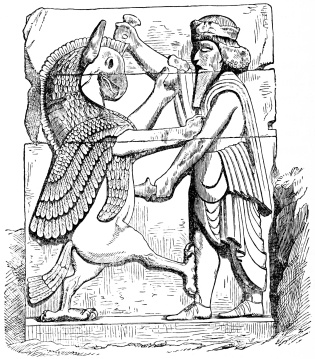
Fig. 91.—Relief for a Portal of Persepolis. (See Fig. 86.)
If the masonry, probably of brick, had received a richly sculptured{123} stone revetment, like that which covered the Assyrian walls, some remains of this would certainly have been found. It seems, however, that the wall surfaces were ornamented only with paintings. In proportion as carved decoration was diminished, the architectural treatment of the enclosing masses was increased, by doors, windows, and niches, and by the repeatedly stepped epistyle beams and its crowning scotia, richly ornamented with leaves over the lintels. Only the inner surfaces of the door-jambs were used for representations in relief, the subjects being partly mythological, partly ceremonial. The ruins of Pasargadæ show such a mythological figure, in long, close-lying garments without folds, according to the Assyrian tradition, though of somewhat lighter proportion. It has a less pronounced Semitic profile, Egyptianized by long twisted ram’s horns upon the head, and with the irrelevant ornaments of the Nile situla, disks, and uræos-serpents; the greater part of it is so destroyed that only the outline is recognizable. Upon the terrace of Persepolis there is repeated a kingly or divine being lifting a lion into the air while strangling it, such as appears in more vigorous design upon the reliefs of Nineveh; or this figure pierces with a short sword a bull, lion, or griffin standing upright upon its hinder legs. One of these peculiar mythological representations is given in Fig. 91. The head of the male figure, ornamented with a diadem, is distinguished from the Assyrian type only by a longer and less protruding nose, and by some diminution of the luxuriant hair and beard. The exposed limbs, the arms and legs, have more slender proportions; with a softer and somewhat Hellenized swing of the outlines, there is less modelling than was found upon the Tigris. The expression of great muscular power, of striking and healthy energy of action, peculiar to the Assyrians, is lost in Persia. The garments are not sack-like and close-fitting; with the richly patterned treatment of surfaces, there is an attempt, not altogether fortunate, to indicate the folds of drapery and the free flow of cloth. It is possible to recognize in this respect the influence of Asiatic Hellas, falling, indeed, upon rather sterile ground, and received with little understanding. The strapped shoes take from the cramped foot its true form, being curved in the sole even more than is the case with the naked instep. The power, long since acquired by the Greeks, of so raising the hinder foot of{124} a moving figure that only the toes touch the ground, was as far from being possessed by the Persians as was the power of causing the whole body to take part in an action—carrying forward the momentary position. The human being is apparently able neither to turn the animal away from himself, nor, by additional exertion, to give the death-blow. The opposing griffin is similarly petrified; it here appears with eagle’s head and feathered tail, occurring in other representations with lion’s head and scorpion’s tail. Both paws of the fore feet, and one of the eagle’s claws of the hind feet, are in the position of attack; one paw grasps the right arm, as it reaches towards the head of the monster; the other is laid upon the left, which pierces its body with a broad and pointed dagger. At the same time, one of the bird-like hinder legs touches the front knee of the human figure. But nowhere is there the energetic movement{125} of seizing or pressure found upon Assyrian sculptures; there is a posture, but no action; and thus the lion-eagle monster has no frightful power—only something hatefully comical in figure and bearing. Nor has the bull or lion, which occasionally takes the place of the griffin, anything of the Assyrian force; the scene might be considered as a harmless play of the man with the animal, were it not for the sword half buried in the body.
The most accessible subjects for such an art were naturally mere ceremonial representations, where the action, reduced to a minimum, was naturally neither momentary nor energetic. There are the promenades of the king, with staff and lotos-flower in his hands, followed by eunuchs, one third of his size, who carry his handkerchief and sunshade, and cool him with a fan of peacock’s feathers. It is worthy of curious notice that, upon a door at the back of the palace, the sunshade is omitted from the relief, as being of use only in going out. A casual observation of Persian sculpture may be deceptive, and we may seem to recognize quiet dignity in what is mere want of all expression. It is thus with the frequently repeated ceremonial scenes, the architectural employment of which has been mentioned above. (Fig. 87.) The canopied throne appears raised upon an elevation; the king sits with his feet resting upon a footstool, his retinue before him with censers. Three superposed rows of men stand as supporters of the throne, with outstretched arms bearing the platform. The figures are placed in such regular position that the effect is purely ornamental; but are individually interesting, in so far as they are intended to represent, in feature and costume, the different nationalities of the Persian empire. Notwithstanding the celebrated description of the review of the Persian army upon the banks of the Hellespont given by Herodotos, it would be hopeless to attempt to recognize among the figures the types of known tribes. Of a similar kind are the upper parts of the rock-cut reliefs upon the tombs of the Achæmenidæ, the architectural peculiarities of which have already been mentioned. Because of the sacred character of these graves, the kings are not represented enthroned, but standing upon a stepped platform before an altar, over which floats the winged and encircled deity, near the disk of the sun or moon. A consideration of the exterior treatment of the upper story of the{126} palaces would here be in place if it could be shown that the ornamentation was indeed carved.
Persian sculpture received its most extensive application upon the buttresses of the steps placed before every palace. Here are found the ceremonial scenes of the Assyrian courts in a feeble rendering, far removed from the sharp and careful cutting of the details, and the naturalistic modelling of the bodies, peculiar to the works of Mesopotamia. Long processions of men represent different nationalities, characterized by their costumes and by the treatment of hair and beard; by their various feather-caps, hoods, capuchins, pointed hats; short skirts, with wide pantaloons; long garments, with great fulness at the bottom, and sleeves falling in multiplied folds; by the skins of animals worn as mantles; by girdles, sword-belts and swords, bows and quivers; by peculiar sandals, shoes, boots, and the like. These subjects bring to the monarch most manifold gifts—horses, dromedaries, musk-oxen, rams, goats, a wagon, elephants’ tusks, stuffs, garments (among which various kinds of stockings are even distinguishable), swords, double-headed hammers, bracelets for the arms; censers, with vessels for incense; salve, in little bowls, borne upon trays which hang like scales; wine-skins, goblets, globular and flat cake-like loaves of food, carried in the palm of the hand; carved cups and saucers; little bags, etc. Others bear only lotos-flowers and pomegranates. They are slim, narrow-chested figures; the short upper body is given in profile, without anatomical truth in general form or detail; not only without motion, but apparently incapable of it. At times the position of the arms shows, not, indeed, a gesture, but some attempt of varied position; the hands lie upon one another, or touch the mouth, the end of the beard, the hilt of the sword hanging at the side, or the quiver, or are extended so as to rest upon the shoulders of the preceding figure in the procession.
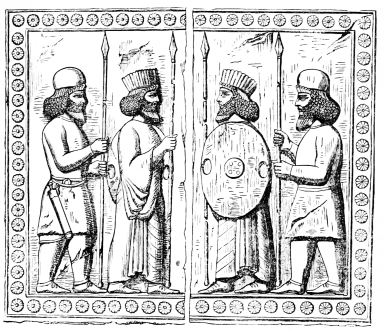
Fig. 92.—Relief from the Stairs of the Palace of
Darius.
Lifeless as these appear, they are still superior to the guards, armed with a lance, who march towards each other from opposite sides, in long processions. (Fig. 92.) The heads differ from the Assyrian type only in the pointed chin-beard; the bodies alternate between uniforms of two fixed patterns. One of these is without a shield, in a closely fitting leathern garment, with awkward pantaloons bound{127} at the ankles, and a globular cap of surpassing clumsiness. The other, distinguished by shield and plumes, with a long robe drawn up at the hips, and with wide sleeves hanging in folds, is more tolerable. The elliptical shields, like those of Bœotia, have a round cut upon both sides, in which the lance was probably placed; they are strengthened by a circular plate riveted to the centre. Upon the terrace stairs, in the triangles formed by the ascending steps, are groups of animals—lions seizing bulls from behind. Though the forms are rendered with but little understanding of detail, the entire composition is well fitted to the triangular space allowed it, and thus has a certain decorative and architectural value. The parapet of the staircase terrace is decorated with rows of highly conventionalized lotos-flowers upon leafy stems; in its centre is the winged divinity of the disk between crouching lions. These carvings upon the staircase buttress, though monotonous, were still so rich that they{128} gave to this member much the same distinction as that of the gable in Greek architecture, to which it is somewhat similar in outline, the ascent from each side forming a triangle. The representations upon it are, in their subjects, suited to the palace fronts, where guards were in place, as well as gift-bearing deputies from tributary nations. Though the division of the surface into several horizontal stripes by rows of figures, one over another, is not artistically beautiful, it still has the advantage that the standard of proportion is not infringed upon, as is so often the case when colossal statues are placed before buildings; the disadvantage may perhaps be less when life-sized figures, like these, are dwarfed by being brought into comparison with enormous edifices.
Only one important historical scene is known—the rock-cut relief of Bi-Sueton. A king, followed by guardsmen, sets his foot and bow upon a victim lying backwards on the ground, who stretches up his hands in a beseeching manner, while a procession of nine prisoners approaches, their hands tied behind them, and bound one to the other. Above is the winged deity. The proud bearing of the king, and the stooping of the helpless enemies, show a slightly superior artistic ability. Though Persian sculpture was successful in some rare instances, the conviction must still remain that, in comparison with the art of Assyria, it was not only a dependent imitation, but failed to attain any of the superiorities of its model. That which was borrowed from other lands than Mesopotamia was superficially carried into execution in unimportant details. Strictly speaking, we can hardly acknowledge the existence of the art of sculpture in Persia, as it was without either independent foundation or any progress of its own.
Of Persian painting there are no remains or information. The walls were without doubt plastered and colored. If there had been a revetment of glazed tiles, according to the Mesopotamian practice, some fragments of this almost indestructible material would surely have been found. From analogy of the carvings, it is probable that paintings upon the walls were chiefly ornamental and of subordinate importance. Upon the principal front of the buildings there remained but little space where painted decorations could be employed; the façade of the Tomb of Darius was largely covered{129} with inscriptions. On the other hand, the restoration of the Palace of Darius, at the head of this chapter (Fig. 77), shows that the aid of color was particularly needed upon the other sides, which would have been bare and monotonous without painted ornaments. We may suppose that the Persians felt this need, and that decorative painting was extensively employed; they were led to it by familiarity with the methods of Assyrian art, and with the colored mural decorations universal in Egypt, both which lands they considered their tributary provinces. Though we cannot speak of monumental independence in Persian sculpture and painting—of which, indeed, no ancient Orientals had any conception—the art of the land had at least the superiority that its three branches, in their application, stood in true relations to each other, inasmuch as architecture employed and brought forward the sister arts as secondary, decorative aid; painting and sculpture did not predominate in the excessive degree characteristic of the older nations of the East. The Egyptians, whose architecture, otherwise so richly developed, was chiefly restricted to the interior, made excessive use of painting and coilanaglyphics to enliven the dead masses of exterior walls. The Assyrians needed sculptured revetment and painted stucco to support and hide the weakness of their masonry, and its incapacity for architectural treatment, within and without. Merely decorative art thus gained an undue supremacy in both countries. Among the Persians, on the other hand, architecture attained its full rights by important and harmonious advances, while decorative sculpture and painting withdrew to their proper subordinate positions.{130}
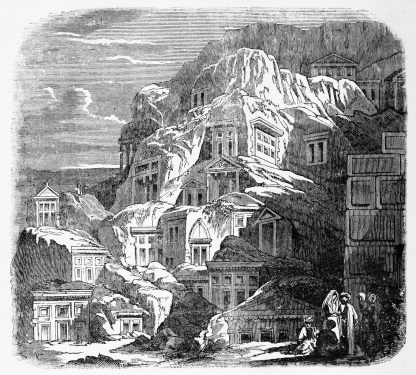
Fig. 93.—Rock-cut Tombs of Myra.
THE primitive tradition which makes the valley of the Euphrates and Tigris the centre of the most advanced culture of the earth is illustrated by the extraordinary expanse of Mesopotamian influence in both time and space. Extending eastwards even to the Ganges, in a westerly direction passing beyond the Adriatic, bounded on the north only by inhospitable Scythia (Siberia), and on the south by the Indian Ocean, its roots, long after the advent of the Christian era, sent forth fresh shoots into Western Asia, recognizable in the monuments of the Sassanidæ and in the works of the world-conquering Arabians. The spring of native civilization was not entirely exhausted, although, after the fall of the Persian empire{131} and the foundation of a Greek Asiatic monarchy by Alexander the Great, Hellenism had expanded itself over Western Asia for five centuries,—first among the luxurious Seleucidæ, who had attached to themselves the Asiatic half of the Macedonian empire, and in later times under the strict military power of the imperial Roman period. Nor could the barbarism of the Parthians wholly obliterate from the land the reminiscences of ancient Persian and Mesopotamian culture. These influences appear again when the Persian Ardshir—boasting a direct descent from the Achæmenidæ, and therefore called Artaxerxes by the Byzantine Greeks—shook off the yoke of the barbaric Parthians in the year 226 after Christ, as his forefather Cyrus, eight centuries previously, had founded his empire upon that of the Medes. Ardshir was the first ruler of a new national Persian dynasty, named after his father, Sassan,—a race under whose sway the land east of the Tigris was raised to a glory and importance which made itself felt even in distant and powerful Rome. One Roman emperor, the unhappy Valerian, was even forced to languish during the last ten years of his life in a Persian prison, the Romans not venturing to free him from the despicable slavery of the Sassanian Shahpur I., who meanwhile took care to hand down to posterity that world-renowned result of Persian bravery and cunning by numerous monuments and rock-carved reliefs, which testify, as a leaf of authentic history, to an event so humiliating to Rome.
The Palace of Ctesiphon,—the Sassanian representative of the Hellenic Seleucia upon the Tigris, a city of the Diadochi which had itself taken the place of the Chaldæan Babylon on the Euphrates,—the dwellings of Sarbistan and Firuz-Abad, with many other buildings and monuments sculptured upon the face of cliffs, give evidence of the artistic ability of the new Persian kingdom, which continued to flourish until the foundation of the Mohammedan power in Mesopotamia, 641 A.D. Much was certainly lost, and the artistic ornamentation of architecture, as illustrated by the columns and pilasters of Sarbistan, which are without capital or base, sank again to the rudeness of the ancient monuments of Chaldæa; but, on the other hand, the constructive gain was not inconsiderable, notably in the greater development of gateways, windows, and niches, as well as in the appearance of immense arches, cylindrical vaults,{132} and cupolas, which received peculiar forms of parabolic lines, though not excluding the round arch. The later Persians had marked influence upon the conquering Arabs, who, with few native traditions, were readily receptive: this is illustrated by the horse-shoe arch, so characteristic of Moorish architecture, which may be traced in the works of the Sassanidæ from the Palace of Ctesiphon to the Monument of Tak-i-Gero. Chronological considerations and the increasing influence of Greek and Roman elements seem, however, to forbid the treatment of Sassanian architecture in this sequence. Indian art is omitted chiefly upon the ground that the best work of the Farther East does not appertain to a history of antiquity at all; the remains antedating the Christian era, such as the columns of Asoka, are too undeveloped and wanting in independence to deserve separate consideration. This would be even less the place for a review of Sassanian sculpture, because in this, in spite of the recurrence of ancient Mesopotamian figures and details, and notwithstanding the national peculiarities observable in the modelling of muscles and draperies, the Hellenic and Roman influences are too great to allow of a proper treatment of the subject apart from the artistic development of Greece and Italy. Sassanian and Indian art, though standing in a certain relation to the civilization of antiquity, may receive a more just historical treatment if considered immediately before the advent of Mohammedan methods of building,—upon the threshold of the Middle Ages.
The chief currents of culture and intellectual development have ever flowed steadily towards the West: such was the course of the wide-spreading artistic influence of Mesopotamia. The valley of the Euphrates and Tigris is divided from the shores of the Mediterranean by desert tracts which did not allow Assyrian traditions, though directed and furthered by the important trade-roads, to take immediate and undisputed possession of the strip of Phœnician coast. Egypt lay too near for this; its influence could not remain unfelt by the seafaring inhabitants of the Syrian lands. Indefinite theories have been prevalent for some time concerning the meeting and blending of the peculiar civilizations of the lands of the Nile and the Tigris, but until recently Phœnicia was the least-known country of the ancient world. The Syrian expedition of the French under{133} the auspices of Napoleon III., like the Egyptian under Napoleon I., presented the possibility of a thorough and systematic exploration of Phœnician remains. The difficulties of prosecuting the investigations were not less than they had been in Chaldæa. “The land,” says Renan, who was commissioned to conduct the explorations, “is now completely deserted. The destruction of the forests has everywhere done its evil work; the soil, year after year carried off by the inhabitants of the villages or washed away by the torrents of winter rain, has disappeared from the native rock; the flow of water from the springs, more and more exhausted, has become too weak to find its way to the sea against the many hinderances; hemmed in by dunes and alluvial formations, it fills the plain with the poisonous exhalations of swamps, so that the once blooming and populous land has become a pestilent desert, where for miles there is scarcely a hut to be seen.”
The remaining monuments are chiefly grouped around the five principal trading towns of the coast,—Ruad (Aradus), Amrith (Marathus), Jebeil (Byblus), Saida (Sidon), and Sur (Tyre),—which follow one another from north to south in the given succession. Still farther to the south are isolated ruins near Gabr-Hiram and Um-el-Auamid. Beyrout, now the most important city of all the original Phœnician territory, has the fewest remains of antiquity; the greater number are at the totally deserted site of Marathus, where the neighboring brook, Nahr-el-Amrith, alone retains a trace of the city’s anciently celebrated name. The city Aradus, frequently mentioned in the Mosaic Scriptures, founded Marathus, its most important colony, as well as Paltus, Balaneia, Carnek, and Enhydra. Of Aradus itself little exists beyond a few enormous blocks of hewn stone; the fanaticism of the present inhabitants of Ruad prevented an adequate examination of the site. All these cities lost their importance in the Roman period, with the ascendency of Antaradus, the mediæval Tortosa.
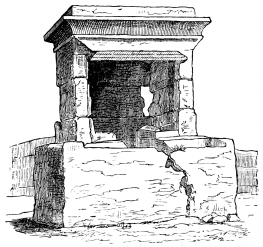
Fig. 94.—Temple Cella (El-Maabed) of Amrith.
The remains at Amrith are barely sufficient to give a conception of the temple buildings and monumental tombs of the Phœnicians. One fane, in an exceptionally good state of preservation, is still called by the inhabitants El-Maabed (the temple). It consists of a rectangular area, the temenos, 48 m. broad and 55 m. long, sunk into the{134} native rock, so that three of its sides are formed by the perpendicular cut, and reach the height of 5 m. Upon the north, the entrance, the enclosure was completed by a wall, which was also continued around the other three sides, and there heightened the boundary. Two piers, in the southeastern and southwestern corners, standing 3.5 m. from the edge of the rock, and numerous sockets for the ends of the beams, plainly visible in the walls, lead to the supposition that a gallery was carried partially or entirely around the space. The whole sunken area formed the court of a temple, perhaps a sacred lake, as many traces of paved springs in the interior seem to indicate. The small cella, which rises exactly in the centre of the quadrangle, thus became an unapproachable sanctuary. (Fig. 94.) It is formed of only five stones. The socle is hewn from the solid rock, 3 m. high and 5.5 m. square, with traces of a stairway upon the right side. The three-walled cella, open to the north, is 5 m. high; its ceiling is monolithic, while the walls consist of three superposed blocks cut to the plan of the chamber. The roof, chiselled within to the form of a flat-arched vault, juts forward over the opening; its projection may have been supported by light columns of metal, the probable form of which will be considered in connection with the{135} rock-cut reliefs of Mashnaka. Upon the side-walls, which stand 2.34 m. apart, there are two low benches, leaving a ground-space of only 0.8 m. between them. The architectural decoration of this shrine is limited to a cornice of scotia and roundlet; though this appears also in Assyria and Persia, it still gives an Egyptian character to the cella exterior, which in plan and general disposition is very similar to the Mesopotamian chapels represented upon Assyrian reliefs (Figs. 35 and 57), and to such structures as appear to have existed upon the terraced pyramids of Chaldæa. In this cella we possess the oldest and the only Semitic temple known, still in admirable preservation, although the downfall of the crumbling mass is predicted by the authorities who accompanied the Phœnician expedition. Of two similar structures, which stood near the city of Marathus, Renan could discover only overthrown blocks buried in the swamp of Ain-el-Hayat (fountain of the serpents) and hidden by oleander-bushes. They stood at a distance of 10 m., their open sides turned towards each other. The remains of the better-preserved cella show it to have been entirely monolithic. It stood upon a double substructure, of which, strange to say, the lower part is considerably smaller than the upper. It betrays still closer relationship with Egyptian works of the kind by rows of uræos-serpents over the cornice scotia and the winged disk upon the inner ceiling. From their plan, they appear to have had no columnar supports, and resemble, in the careful restoration made by Mr. Thobois, the monolithic cellas of Philæ preserved in Leyden and in the Louvre. Traces of three other sanctuaries, or at least of their temenos enclosure, which is partly cut in the rock and partly built, exist in the vicinity of the Stadion of Amrith, now known as El-Meklaa (the quarry), and designated by Renan, upon insufficient grounds, as itself ancient Phœnician.
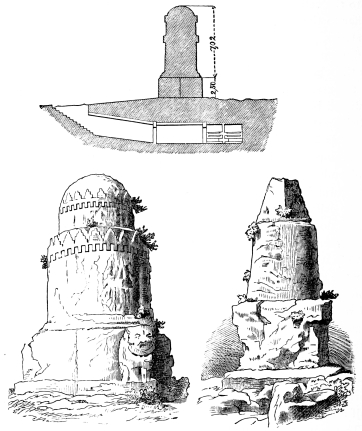
Fig. 95.—The Monuments El-Meghazil of Amrith.
The monumental tombs of Amrith are not less important than these places of worship; the ruins known under the name El-Auamid-el-Meghazil (the spindle-columns) are truly majestic. (Fig. 95.) The first rises in three cylindrical steps upon a square platform little elevated above the ground. The lower part, 2.5 m. in height and 5.15 m. in diameter, built of two stones, is ornamented over the corners of the platform with engaged lions, which are among the most prominent{136} works of Phœnician sculpture known, and will be considered at greater length below. Upon this first cylindrical step rests a block 7 m. high, ornamented at the base with delicately curved moulding, and at the summit with dentils and battlements. These latter are found also upon fragments from Jebeil in conjunction with squares and rosettes and a particularly characteristic frieze of straight-lined laurel branches; they show great similarity to Mesopotamian remains. In the circular plan of the structure there is no reminiscence of Egyptian methods of art; an hemispherical termination lends to the whole so marked an individuality that, although its{137} form seems not to have been universal, or even the most common, upon the Syrian coasts, there yet may be recognized in this monument a truly original Phœnician type. In the development of memorial stones a cultured people generally expresses its fundamental artistic conceptions, as is the case with the pyramidal termination of Egyptian obelisks, and with the Assyrian piers terminated by a stepped terrace, in both of which are embodied the lines predominant in the architecture of those nations. A stairway hewn in the rock leads to the subterranean burial chambers; its entrance is at some little distance from the monument, as shown in the section Fig. 95. Only 6 m. removed from this rises a second pile, which, from a certain parallelism of position, seems to belong with it. It is simpler than the first, consisting of a cube measuring 3 m. upon the side, so roughly hewn that it appears a block taken just as it was quarried; upon it is a monolithic cylinder 4 m. high and 3.7 m. in diameter, terminated by a five-sided pyramid of steep inclination. Somewhat removed from these are two similar monuments, of which the better preserved stands upon steps and rises in two cubes, separated by a cornice of wavy outline, the upper block terminating in a four-sided pyramid, now almost entirely overthrown. It is remarkable for the monolithic horizontal covering of the entrance to the grave chambers, which is again a little distant from the base. Of the pyramidal termination of its neighbor, only traces remain. All these monuments were in part cut from the native rock and in part composed of enormous monoliths; a fifth, of considerably greater dimensions, was built of quarried stones. Of this latter, the commanding mausoleum known under the name of Burdj-el-Bezzak (Tower of the Snails), little remains beyond the platform, which measures 11 m. in height and 9 m. in the square plan. The four-sided pyramid, of obtuse inclination, placed upon this elevation, is now entirely overthrown. The blocks, 5 m. long, are hewn only upon the joints, and left with a rough face. A cornice of curved profile ran around the platform; within it are two chambers, each lighted by a small window, the existence of which rendered the otherwise customary grotto beneath the pile superfluous.
Grotto tombs, with a decorated entrance cut upon the rock wall, seem to have been most generally employed in Central Phœnicia.{138} They are exemplified by the numerous remains of this kind at Saida (Sidon) and Jebeil (Byblus). A tomb at the latter place shows a simple but interesting façade; its ornamentation, by the heavy gable and ring-formed acroterium, is strikingly similar to forms occurring in Central Asia Minor (Phrygia). (Fig. 96.) Its flat border and plain five-leaved rosette in the tympanon triangle give no evidence of Hellenic influence. The interior of these tombs is generally a large room, with curved ceiling and niches upon three of its sides, sunk into the rock, one above another, like those of the Catacombs, to hold the rows of coffins. The finest of the sarcophagi of Jebeil is decorated with festoons, wreaths, single leaves and branches, in a naïve style of ornament betraying no knowledge of Greek sculpture. In Southern Phœnicia a monumental development of the sarcophagus seems to have been chiefly favored. The tomb known as that of Hiram (Gabr-hiram), south of Sur (Tyre), is an immense coffer, 3 m. high, with a heavy arched cover, raised upon a plinth built of hewn blocks 4.24 m. long, 2.64 m. broad, and 3 m. high, the upper part of which is formed by a monolithic slab almost one meter in thickness. Not far from this site, at Um-el-Auamid, is a large sarcophagus, 2.40 m. long and 1.24 m. broad, with a gable-shaped lid decorated by clumsy corner acroterias. Against one of its sides stands a small altar, remarkable for the corners of its battlemented termination, which must be similar to the horns of the altar which stood in the tabernacle of Solomon’s Temple.
Of the domestic architecture of Phœnicia can be mentioned only an entirely unornamented house, hewn from the rock, in Amrith, and a portal at Um-el-Auamid, where the middle block of the triple lintel is decorated with the Egyptian disk and uræos-serpents upon either side. The materials employed by the Phœnician architects{139} seem generally to have been the cedars of Lebanon and the various metals of transmarine commerce; it is on this account that the preserved monuments are so few, and their remains so bare of carved decoration.
This explains also the lack of examples illustrating the sculpture and extended industrial art of the country. The Homeric epics constantly point to the Syrian coast as the home of all contemporary skill in metal-work, pottery, and weaving. Stone statues were rare; metal was the favorite material of Phœnician sculpture, although it was but seldom, as in the columns before the Temple of Jerusalem, employed for casting. The usual proceeding of the artificer was to make a core of wood for the work, whether this were to be in relief or in the full round; upon it sheets of metal were secured, and these finally beaten with the hammer to the modelling of the carved wood beneath, thus forming a so-called sphyrelaton. The sculptures of Solomon’s Temple illustrate this process, and, according to the Biblical account, may unhesitatingly be ascribed to Phœnician artists. In some instances the beaten metal was gold, this being the case with the Temple of Jerusalem and with a small temple at Carthage, which contained an image similarly overlaid. Silver was more rarely thus employed, though it is known that from the earliest times the Spanish silver-mines were worked by the Phœnicians. The metal was perhaps more frequently devoted to utensils like the twelve silver vessels discovered upon Cyprus, of which those now in the Louvre show a workmanship nearly akin to that of the before-mentioned Assyrian bronzes. It has been remarked in the section upon Assyria that this style was neither purely Mesopotamian nor Egyptian, but rather a mixture of both, the latter predominating. This points to the Phœnician origin of such works, and these silver vessels of Cyprus lend a striking confirmation to the supposition. The beaten metal was usually a bronze, the copper in its composition being derived from the Phœnician island Cyprus, the tin an article of commerce brought from England. It is natural that the Phœnicians, to whom alone these metals were accessible, should be regarded as the inventors of that amalgamation of ten parts of copper with one of tin known as bronze, of so great importance in casting. Homer’s mention of{140} vessels and utensils from Sidon, and the discovery of Phœnician bronzes in the ruins of Nineveh, prove a most ancient and extended trade in objects formed of that metal.
The carved wooden form covered with sheets of metal, the sphyrelaton, is a peculiarly Phœnician product. Such beaten reliefs were generally of copper, pure, or with a small percentage of tin; gold, silver, and even tin were, however, similarly employed, in conjunction with mosaics of precious stones, ivory, and notably with amber, a substance greatly prized in early antiquity, and brought by the enterprising Phœnicians from the coasts of the North Sea. A certain effect of color was thus obtained. In the decoration of weapons, a ground of metal served instead of the wood as a foundation. This inlaid work was known to the Greeks of the Homeric age. It stood in the same relation to primitive monumental painting as the mosaic of the Byzantines did to the decline of the art, its greatest height of development being reached by the so-called chryselephantine sculpture, where a combination of carving and inlaying was effected with gold and ivory upon a wooden kernel. The throne of Solomon was an example of this, the lions carved upon its arms rendering it the work rather of a sculptor than of an artisan. Carvings entirely of ivory are mentioned by Hezekiah as frequently existing in the sanctuaries of Tyre, and in Nineveh there have been found many fragments, apparently Egyptian, which may, without doubt, be attributed to the Phœnicians. The Biblical prophets speak of great works in Tyre composed of precious stones, and Theophrastos mentions an entire obelisk of emerald as existing in the Temple of Melkarth of that city, which is explained to have been of a colored glass (plasma di smeraldo). Glass itself, assumed to have been invented by the Phœnicians, but common in Egypt before the fifteenth century B.C., appears to have been made only in colored, and generally opaque, masses. The most ancient piece of white transparent glass known is described by Layard as a cup whereupon is cut the name of King Sargon in cuneiform characters—consequently an Assyrian work from the end of the seventh century B.C.
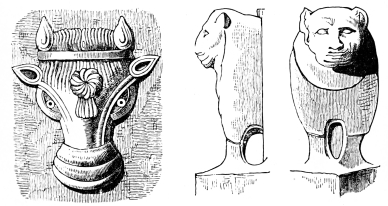
Fig. 97.—From a Relief of Saida.
Fig. 98.—From the Monument El-Meghazil of Amrith.
Phœnician sculpture is almost exclusively represented by metal-work, and, as this was mostly beaten, it is natural that it should assume{141} that peculiar style of conventionalization which, even in works of stone, reminds us of empaistic prototypes,—that is to say, of the characteristic forms and modes of conception originally decided by the properties of beaten metal. This style is shown by the Phœnician leaved ornaments upon architectural details, and is especially striking in the representations of animal forms. Upon a frieze at Saida (Fig. 97), for example, is a remarkable illustration of the Phœnician sphyrelaton, which enables us to understand the form of the bulls upon the brazen laver in the Temple of Jerusalem. The half-lions upon the monument of Amrith, also, although carelessly carved and much weathered, are still more interesting in this regard. (Figs. 95 and 98.) Besides their peculiarities as imitations of empaistic work, especially recognizable in the primitive legs, they show some reminiscences of Egyptian granite forms and of a Mesopotamian conception of animal nature, marked also upon the bull’s-head by the strap-like formation of the sinews. Less direct insight can be gained from other Phœnician sculptures because of their more advanced state of destruction. The rock-cut reliefs of Gineh and of Mashnaka, however, well deserve to be mentioned. The first shows upon one side an animal, apparently a bear, leaping upon a man, while at the right, in a sunken rectangular frame, is an enthroned figure, and in another a man in front{142} view, with two dogs, which are scarcely recognizable. Enough is still preserved to show that the work is not of Egyptian origin, but may more justly be compared to Assyrian sculptures, though without the stiff character of courtly ceremonial peculiar to the works of Nineveh. The two rock-cut reliefs of a mountain-pass near Mashnaka (Fig. 99) are more important to the history of the architecture than to that of the sculpture of Western Asia, because of the remarkable forms of the capitals represented upon them; they will be considered in connection with Solomon’s Temple. The smaller, movable sculptures found in Phœnicia, which were possibly not the work of the country, are of less interest; they usually exhibit decided Egyptian influence. Numerous marble sarcophagi found in Saida are characterized by the confusion of style peculiar to Phœnicia. The covers are imitated from the swathed human forms represented upon the lids of Egyptian mummy-coffins; the heads betray in some measure the influence of Greece, and render it probable that they were executed in the time of the Seleucidæ.
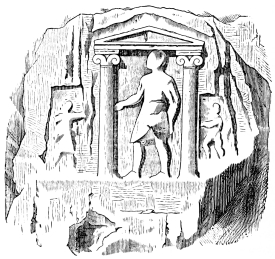
Fig. 99.—Rock-cut Relief of Mashnaka.
As might be expected from the position of the country, lying between Egypt and Chaldæa, and from the national commerce and{143} manufactures, which attracted the products of both countries, the artistic style of Phœnicia was a mixture of Egyptian and Mesopotamian elements. This was, of course, also the case with that of the Jews, who, in their architecture and sculpture, were as dependent upon the Phœnicians as were the primitive Romans upon the Etruscans. The influence of Egypt was felt in Palestine in a greater degree than in Phœnicia, because the Israelites had grown to a people upon the banks of the Nile, and without doubt transplanted many artistic conceptions, as well as methods and details, to the Promised Land. This is noticeable in the tabernacle and in the temple, the latter, as is well known, receiving its general disposition from its relation to that former encampment. The tabernacle (Fig. 100) is in fundamental character a repetition in movable tents of the triple Egyptian temple system of court, hall, and cella. At the time of the emigration of the Jews from their long sojourn in Goshen, they could have been familiar only with Egyptian forms; we cannot mistake if we suppose them, before their intercourse with the Phœnicians, to have supplied all their artistic needs from Egyptian precedents.
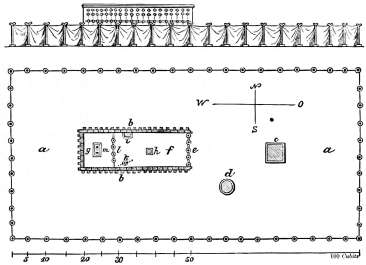
Fig. 100.—The Mosaic Tabernacle.
The simple enclosure of the tabernacle formed a court, with a front of fifty cubits, and twice as long as it was broad. There were twenty-one columns, like tent-poles, upon the sides, and eleven upon the front; those of the corners being counted twice. These supports were five cubits high, ornamented with silver capitals, and standing in sockets of bronze; they must have been entirely similar to the shafts represented upon Egyptian wall-paintings. They appear not to have been joined by cross-bars. White immovable hangings were fastened between them, beneath their capitals, with the exception of the four central intercolumniations of the eastern front, where hung movable curtains of blue, purple, and scarlet linen. The tabernacle itself, b, did not stand in the centre of this enclosure, but nearer the western end, probably so that a square of fifty cubits was left before its entrance, in which space there stood the altar, c, of earth and wooden sheathing for burnt-offerings, five cubits square and three cubits high, and the laver of brass, d. There thus remained upon the three other sides a space of twenty cubits between the tabernacle and the enclosure. This disposition is not expressly affirmed, but may naturally be assumed from the indications presented by the dimensions of the tabernacle, which was thirty cubits long and ten broad. Except in the front, e, where were five columns, it was formed of forty-eight boards overlaid with sheet-gold. These boards, like the poles of the enclosure, were not rammed into the earth, but stood upon double sockets of silver; they were fastened together by tenons and by bars, which were pushed through projecting golden rings. The arrangement of the five columns of the front, also overlaid with gold, is not certain. It is hardly possible that they were placed in antis; for, although the shafts were but thin poles, the six intercolumniations thus formed would have had a width of only one and a half cubits each—too narrow for passage. The two outermost columns may, from this consideration, be assumed to have stood before the ends of the boarded wall, in prostyle arrangement, or close upon this, as indicated in the plan at e; a method of avoiding the narrowing of the space by the two exterior intercolumniations which was adopted in much later times upon the so-called tombs of Absalom and Zachariah, to be considered below, where the forms may have been in some measure decided by{145} reminiscences of these primitive constructions. If the ten cubits of the tabernacle front were divided into four parts instead of six, passage would have been easy.
There is no information concerning the appearance of these shafts. Their sockets of bronze may have been similar to the high bases of Moorish columns, and to those which support the canopy-poles of our churches. If the shafts were neither connected by cross-braces nor rammed into the earth, they must have been provided with a footing even broader than that of either of the instances mentioned, and have resembled the wide-spreading plinths of Egyptian lotos columns. That the columns were disproportionately slim is evident from the consideration that five shafts of normal Egyptian, or Greek Doric, proportions, ten cubits high, would have entirely occupied the narrow front of the tabernacle, and have left no space for the intercolumniations. Mere tent-poles would have been sufficient, as the building was provided with no fixed roof, but was covered, like the tents of Bedouins, with colored linen, cloths of goat-hair, and the skins of rams and seals. As this covering received its chief support from the side walls, a light epistyle of wood was sufficient to unite the summits of the front columns. It cannot be said that there was any entablature, in the proper sense of the word.
The proportions of the tabernacle, three times as long as it was broad, were like those of the Egyptian temple. It was divided into two unequal compartments, the front, f, being twice the depth of the innermost holy of holies, g. The altar for incense, h, one cubit square in plan and two cubits high, probably stood in the centre of the first space; it was of acacia-wood, covered with beaten gold. Like the altar for burnt-sacrifices, its corners were ornamented with “horns,” the nature of which has been variously explained, but which could have been nothing else than corner acroteria, like those upon the monuments, sarcophagi, etc., of Asia Minor, and those of the small altar found at Um-el-Auamid, in Phœnicia. Such acroteria—which do, indeed, somewhat resemble upright horns—were not merely for ornament, but served to hold the golden lattice-work (zer) surrounding the top of the altar, to prevent the scattering of coals. Next to the northern side-wall stood the table for shew-bread,{146} i; in the southwestern corner of the space the seven-armed candlestick, k, was so obliquely placed that, to a person entering, its flames were in a line. The form of the candlestick is known from the representation upon the Arch of Titus, which, though possibly not copied from the original—as Josephus relates that only an imitation was paraded during the triumph of Titus—yet agrees with the main points of the Biblical description. The seven arms consisted of three concentrical semicircles and a vertical staff, all of which ended at the same height. The base was polygonal, and ornamented with sculptures, the support decorated with leaves, the arms represented branches with buds and blossoms, ending in the open calyxes of the flowers which bore the lamps. Its importance, as was the case with all the appurtenances of Jewish worship, was considerably greater in material than in artistic respects; the candlestick was without doubt solid, and was made of a talent of gold—worth more than four hundred pounds sterling. A relief of Thabarieh, probably older than the Christian era, shows its general form; it is given in Fig. 101 as further illustrative of the peculiar metallic style of the Phœnician-Israelitic art of stone-cutting.
The holy of holies, a cubical space of ten cubits on the side, was separated from the larger antechamber by four columns, l, which were also covered with gold, and stood upon silver sockets; they bore a second curtain of four colors. This cella contained the palladium of the people, the ark of the covenant, m, a coffer of acacia-wood, two cubits and a half long and a cubit and a half high, borne upon poles fixed in golden rings. Upon the lid, the so-called mercy-seat, were the figures of two cherubim, monstrous combinations of bulls, lions, eagles, and human bodies; or, at least, of three of these—the body of either the lion or the bull being adopted. Though De Saulcy and Layard do not doubt that these cherubim were perfectly similar to the symbolical monsters before the portals of the palaces of Nineveh,{147} it must not be forgotten that the Jews were, at this period of their wanderings, so completely influenced by Egyptian conceptions of art that peculiarly Assyrian forms could not have existed in the tabernacle. The cherubim must rather have been Egyptian—entirely similar to the sphinxes, which, as has been seen, frequently presented this same combination of human head and breast, with the body of a lion. Neumann considers the cherubim to resemble the animals upon an Assyrian ornament, with sunken head and bent fore-legs; but it is more probable that they were crouched like a sphinx, or were, perhaps, sitting upon their hinder quarters, like the figures of a Phœnician throne of rather later period published by Renan. They were carved in wood and overlaid with thin sheets of gold, as was also the golden calf with which the Israelites in the desert sought to imitate the Egyptian idolatry of animals. This is all that can be said of the Jewish sculpture of the period; the Second Commandment entirely prevented any independent development of art.
The form and arrangement of the tabernacle are in the main clear. This is not the case with the monumental temple which Solomon, according to the plan of his great predecessor, erected to take its place, after King David had recovered, and brought to the plateau of Moriah (at present known as Haram-el-Sherif) the ark of the covenant, which had for some time been held as booty in the hands of enemies. The Biblical accounts enlarge, after the well-known manner of the Jews, principally upon the great cost of the materials, and are thus rather archæological notices than artistic descriptions. As might be expected from writers ignorant of art, the statements are, for the greater part, vague and confused. The conditions of Jewish architecture and sculpture appear radically changed since the time of Moses. Immediately after the exodus, Egyptian conceptions and manners of work were dominant; but, as time advanced without further direct communication between the two countries, these became more and more outgrown, and at last completely changed to a dependency upon the civilization and art of Phœnicia. The Egyptian element, however, by no means disappears, for, as has been seen, it existed in Phœnicia itself, as might be expected from its geographical position between Mesopotamia{148} and Egypt: The Jews were not so far developed from a nomadic people as to be able themselves to create imposing architectural works. These call for centuries of practice in the art of building. The construction of their temple was given over to their northern neighbors, the more readily as Solomon was in friendly alliance with Hiram, King of Tyre. The Tyrian architect Hiram was sent with a great number of assistants to Jerusalem. Stone-cutters of Byblos worked, with the aid of Jews, in the quarries of Jerusalem; the necessary timber was hewn in the Phœnician forests of Lebanon; and upon the Jordan, in the vicinity of Scythopolis, a metal-foundry for the temple ornaments was built under Phœnician direction. An understanding of the activity among these artisans during the time of building may be obtained from a consideration of the number of workmen employed: eighty thousand stone-cutters were assisted by seventy thousand bearers of burdens. This multitude of laborers would not have needed one year to complete the temple, far less the seven years actually employed (1014 to 1007 B.C.), had it not been for the imposing substructure of the rocky plateau,—a mass of masonry which may almost be compared to the Egyptian pyramids; surpassing the remains at Ruad, if not in the colossal size of the blocks, at least in the exactitude of their workmanship. From the numbers said to have labored in Jerusalem at one time, it appears probable that by far the greater part of the immense foundations was built under Solomon, though the supporting vaults of the southeastern corner are known to date from the time of Herod, if not even later. The erection of enormous terraced foundations plays a prominent, and at times even the most important, part in the architecture of all the people of Western Asia.
The temple itself occupied but a very small part of the oblong area, more than 1500 m. in circumference, which was gained by this artificial extension of the rocky plateau. This space was provided with gates upon all four sides, to some of which access was had by arched bridges; it was surrounded by thick walls and double ranges of columns, asserted by Josephus to have been monolithic. This outer court, accessible to all, contained a smaller interior enclosure formed by other colonnades, and probably also by several large halls; four gateways with gilded bronze doors led to the interior, to{149} which every worthy Jew had access. Infidels were debarred from farther advance by a grating almost 1.5 m. high, which enclosed the space corresponding to the outer court of the Mosaic tabernacle. The altar for burnt-offerings had been increased in plan to a square of twenty cubits, and to a height of ten cubits; an inclined ascent of considerable size was necessary to reach the summit. It is believed that the kernel of this altar is the holy rock in the present Mosque of Omar.
The brazen laver (the kijor) had developed into the so-called molten sea,—a basin of ten cubits in diameter, cast in bronze, and supported at a height of five cubits upon the backs of twelve bronze oxen. It may be conceived as very similar to the fountain of the Court of the Lions in the Alhambra. The oxen were so divided in groups of three that they faced the cardinal points of the compass, “and all their hinder parts were inward.” These figures, so purely Phœnician, must have been far more similar to the productions of Assyria than could have been the case with the Mosaic cherubim. Their heads probably resembled that shown above (Fig. 97) upon the relief of Saida, their legs those of the primitive animals upon the monument of Amrith (Fig. 98), or of the lions in the court of the Alhambra. The altar and the molten sea were situated before the front of the temple, the axis of which was turned east and west, at right angles to the general direction of the outer court, which ran north and south.
The entrance to the temple was ornamented by two bronze columns, known as Jachin and Boaz; their height is given in different passages as 18 and 35 cubits, and here begins the confusion caused by the Biblical contradictions which make it so difficult to obtain a reliable understanding of the nature of Solomon’s building. It cannot even be decided whether these columns were in the entrance, as architectural supports, or stood before the gates, without a function,—they being spoken of as in, upon, and before the portico. If they stood in the entrance itself, as supports of its lintel (as assumed by Baehr), it is probable that they did not divide its width into three equal intercolumniations. The diameter of the shafts was four cubits, and such an arrangement would so have occupied the total opening of the portal, only fourteen cubits, that but two cubits would have remained for each of the three passages. It is more probable{150} that they were placed next to the jambs in the manner assumed for the front of the tabernacle. If the columns be supposed to have stood before the portico, without any function of support, like obelisks, all difficulty is avoided. In either case it would be important, for an understanding of the style of Solomon’s Temple and of Phœnician workmanship, to comprehend the long description given of their capitals. It is only clear that these were four or five cubits high, and had the general form of lilies, probably that of a calyx, as if derived from the floral capitals of Egypt. A column discovered in the foundation vaults of the temple exhibits a peculiarly heavy capital of this kind, which is, however, though evidently of primitive outline and proportions, characterized by the acanthus-like carving as a work influenced by the later art of Greece. It is to be observed that the normal Egyptian-bell calyx, without additions, could not be spoken of as having the form of a lily, by which name the curled ends of leaves were usually designated in the Orient. The volutes thus especially referred to must have been similar to those upon the Assyrian capital, and notably to those of the rock-cut relief in the Pass of Mashnaka (Fig. 99), which, situated upon Phœnician territory, offer the most striking analogy. An illustration of the extensive ornamental employment of the helix termination is offered by the decoration of a vase recently discovered in Cyprus (Fig. 102), and by pilaster capitals in the Cesnola collection. (Fig. 107.) It is an anachronism to bring the columns, because of their channelled shafts and some minor peculiarities, into connection with the forms of Persian architecture, which could not have been developed so long before the time of Cyrus. The additions—wreaths of chains, nets of checker-work, hanging pomegranates, etc.—of which the Scriptures render a chaotic account, cannot, in detail, be understood or explained. If the shafts are supposed to have been united{151} by a lattice-work of metal, it is more natural to seek a parallel in the free-standing columns of an Assyrian relief than in the canopies of Persian thrones suggested by Julius Braun. That the chains, net-work, and the pomegranates did not hang upon the capitals themselves has been argued by Vogué, from the analogy of an ancient capital of the Mosque of Haram, and is made evident by Braun’s question, how, indeed, it would be possible to count two hundred pomegranates strung around a capital at such a height above the ground.
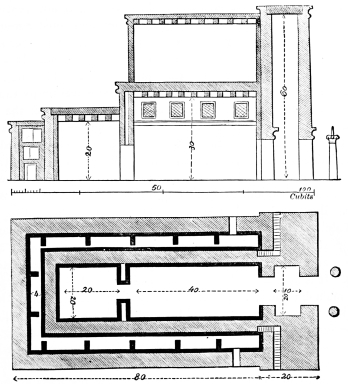
Fig. 103.—Hypothetical Plan and Section of Solomon’s
Temple.
An important portal stood before the halls of the temple. With a plan of 10 cubits deep and 20 cubits broad, the astonishing height of 120 cubits is attributed to this tower, a number appearing in the Chronicles, and repeated in the Septuagint and by Josephus, so that{152} it cannot be regarded as the mistake of a transcriber. But even if the first measures are arbitrarily assumed to refer only to a small interior space enclosed by walls of enormous thickness, the constructive impracticability of erecting a tower of such height is evident; it appears impossible that the temple could have been preceded by a pile twice as high as the principal building was long, and six times as high as this was broad! We would not venture to present a restoration with such proportions, and must agree with Hirt, Streber, De Saulcy, De Vogué, and others, that the account is a Scriptural exaggeration, passed on from hand to hand. It is hardly to be explained by the suggestions of De Saulcy and Streber. The first of these authorities wishes to reduce the elevation by the supposition that one half of the entire height existed under the earth as a foundation, so that only 60 cubits remained visible above. This is ludicrous; the solid rock beneath the temple rendered such remarkable foundations useless and impossible to execute. Streber, also seeking to uphold the Biblical authority, would have it that the 120 cubits was obtained by adding together the heights of two pylons. But this is no less inadmissible, apart from the extreme improbability of heights having been given in so unwonted a manner; the portal appears, from its narrow width, to have been a single tower, and not divided, like those of Egypt, into two separate pylons. It is at least probable, however, that the structure rose above the main building; like the pylons of Egypt, it must have had a marked talus, and without doubt a cornice of scotia and roundlet, as these forms appear upon the monumental tombs of Siloam (Fig. 104)—the oldest of Palestine—and as this cornice was common in Phœnicia, and appears also in Assyria, upon the temple terrace of Kisr Sargon, and in Persia, over door and window openings. The entrance, 14 cubits broad, was probably diminished as its walls ascended, sloping like the outer angle of the elevation, so that the construction of the lintel presents little difficulty, especially when we consider the enormous stones employed in the restoration of the building by Herod, some of which Josephus relates to have been 5 and 6 cubits broad and thick, and 45 (!) cubits long. Above the lintel the same principle of a relieving triangle seems to have been practised, as may be observed in various parts of Egypt and in Mykenæ:{153} the blocks over the door did not lie directly upon the lintel, but gradually approached from both sides above the jambs, leaving between them a gable-shaped opening, which was closed, in order to spare the beam beneath, by only a slab of marble, as at Mykenæ, or by light, thin masonry. This method of construction is indicated by the mention that a golden candlestick, dedicated by Queen Helena, was so placed over the temple entrance as to be shone upon by the sun; and especially by the reference to a triangle existing over the door which opened into the holy of holies. The first gate had jambs of olive-wood and movable doors of cypress, both overlaid with gold. It led to the larger hall, 20 cubits broad, 40 cubits long, and 30 cubits high; to which adjoined the holy of holies, a cubical space of 20 cubits side. The access to this, permitted in rare instances, was through a richly carved door, overlaid with gold and draped with a magnificent curtain. The separating wall was of gilded cedar. These two halls were surrounded upon all sides, with the exception of the front, by a large number of small chambers, in three stories, lighted from without by three rows of windows. These secondary sacristies were each 5 cubits in height within, and, with their ceilings, must have attained an altitude of 20 cubits. The holy of holies was consequently entirely surrounded, and must have been without windows, and dark. The larger space still rose 10 cubits above this side structure, and in this clerestory its windows, which are especially mentioned, must have found place. The flat roof, or, rather, the terraces upon different heights of which it was composed, mounted from the holy of holies to the portal tower in steps somewhat more than 20, 30, and perhaps 60 cubits high. According to Eupolemo (Eusebius), the covering was of copper sheathing.
The temple bore an upper story, explicitly described by Josephus, as it appeared after Herod’s reconstruction of the building, but which is only once mentioned before his time, with the remark that these upper chambers were overlaid with gold (2 Chron. iii. 9). The height of this second story is evident from Josephus, who gives 60 cubits as the total elevation of the building, while the space beneath it had but 30 cubits in this dimension. In regard to the extent of its plan, it must be assumed that it was not built above the{154} lateral chambers or the holy of holies, as the height of the principal hall was far greater than that of the chambers; this would have made the upper story on entirely different levels, and have required staircases large enough to occupy the whole of the space above the 20 square cubits of the holy of holies; and the height of this chamber would, upon the exterior, have become thrice that of its length and breadth—namely, 60 cubits. Such deformities, impracticable of execution, without purpose, and offending all sense of fitness and beauty, may be rejected when the authorities for them are indefinite and contradictory, or, as is the case with Maimonides (1190 A.D.), are assuredly unauthentic. It is probable that the upper story was built only upon the ceiling of the larger hall; and that it was not formed of the massive materials employed for the walls of the lower temple, but, as is indicated by the statement that these upper chambers were overlaid with gold, was built lightly of wood. Such a manner of construction would have permitted a passage to be left around it in the width of the hall ceiling, thus uniting the suitability and the æsthetic advantages of a terraced form, and agreeing with Mesopotamian and Persian analogies. The suggestion may even be ventured that it was by a misunderstanding connected with these upper chambers that the fabulous height of 120 cubits was originally assigned to the portal tower, which, perhaps, was regarded as twice the height of the principal hall; if the elevation of the lower hall and the upper-story had been taken together, if 60 cubits had been doubled in the place of 30, this would account for the 120 cubits taking the place of the more probable 60.
The lower walls of the temple were built of hewn blocks of white marble. The remarkable statement that a layer of cypress or cedar beams always followed upon one of stone cannot be explained otherwise than as a reference to the interior revetment of the masonry with wood. The wall of the court, where the beams are said to have followed three courses of stone, must be considered as of triple thickness, its quarried blocks being hidden by a sheathing, like that of the temple. The statement that the ceiling joists of the smaller surrounding chambers were not sunk into the stone wall itself, but were borne upon the beams, now becomes intelligible; they rested upon the studding of the wooden revetment. The entire{155} interior of the temple, exclusive of the passage through the portico, is particularly asserted to have been provided with this sheathing. The partition between the holy of holies and the principal hall was probably altogether of wood, as here only the two revetments were visible. Upon these walls were sculptured ornaments overlaid with beaten gold. This wood-carving, with its surface of sheet-metal, here took the place of the sculptured and painted decoration upon the walls of Nineveh; it is in this point that the chief difference between the mural treatment of Upper Mesopotamia and Phœnicia appears to have consisted. Quarries of alabaster were common in Assyria; Mount Lebanon, on the other hand, provided the most beautiful wood for carving, and Phœnician commerce procured the metals for the characteristic beaten work—the sphyrelaton.
The few notices preserved concerning the decorations of Solomon’s Temple prove them to have been similar, in both subject and design, to those of Nineveh; they represented cherubim, palms (the so-called tree of life), and floral wreaths. It was only in the cherubim and in the oxen bearing the molten sea that the exercise of sculpture in the full round was at all permitted, and these subjects did not greatly encourage the artistic study of nature. The cherubim stood in the holy of holies as guardians of the ark of the covenant. They were independent colossal figures, carved of olive-wood and overlaid with beaten gold. They were no longer, as in the Mosaic tabernacle, upon the lid of the ark—the mercy-seat—in a recumbent or sitting position, but stood at either side of the holy coffer, and were without doubt greatly different in style from their predecessors. In the consideration of the cherubim of the tabernacle, the similarity of these works to Assyrian parallels was denied, for the Israelites, immediately after the exodus, were naturally acquainted alone with the artistic traditions of Egypt; but this was by no means the case in the time of Solomon, when we have to deal with Phœnician styles,—that is to say, with a combination of various manners of artistic conception and expression. The cherubim of Solomon may fairly be assumed to have in the main resembled the monstrous guardians of Assyrian palaces; the chief deviation from the cherubim of Nineveh was that their wings were not folded closely,{156} but were outstretched as if for flight, so that the tips of their feathers touched together over the ark of the sanctuary, and extended to the side walls of the holy of holies, measuring ten cubits in entire span. The ark of the covenant itself and the other vessels of the temple were either overlaid with gold or were of the solid metal. The altar of incense, the shew-bread table, and the seven-armed candlestick remained as they had been in the tabernacle; to them were added, besides many less important utensils, ten further lamp-holders of gold. As the beaten metal not only extended over all the carved walls of wooden sheathing, but even covered the horizontal ceiling, the eye saw nothing but gold—a decoration which the many-flamed candlesticks must have rendered particularly brilliant, but which was eminently barbaric, as the metal was probably not enlivened by colored enamels. It is in questionable taste, even in the most prominent members of an architectural composition, to outbid the artistic expression of a work by employing for it a material of too striking intrinsic value; but it is wholly condemnable to paralyze the concentrating effect, which is always attained by the moderate use of a very bright and valuable material, by its universal employment, and thus to lose the precious character of the centre through the attempted magnificence of the whole.
As is well known, Solomon’s Temple was destroyed at the command of the Babylonian King Nebuchadnezzar, in 587 B.C. The attempt to rebuild it was not entirely successful until Cyrus ended the Babylonian exile, and not only permitted the building to proceed, but even returned the sacred utensils, which had been carried off as booty, and kept in the Temple of Bel. This reconstruction, named, after the ruler, Zerubbabel, was not completed until after forty-six years, when, under Darius, all the difficulties in the way of its prosecution were overcome. There is reason for supposing that the influence of Persia made itself felt upon the style of the new work, but nothing of importance to the history of art is directly known concerning it. The magnificent restoration of Herod, commenced in 16 or 15 B.C., was executed in ten years, to be destroyed within a century by Titus, so that, literally, not one stone remained upon the other. The remodelled temple is not important to the history of Phœnician-Israelitic art; though the original plan and{157} arrangement were in the main preserved, its style became a debasement of the Greek and Roman orders. The gigantic platform, the site of the building with which so many remarkable events are connected, will always continue to be of peculiar interest in the history of the world’s development.
The description of Solomon’s palace given by the Scriptures is too vague to convey any adequate conception of it. It was a building extended by columns and provided with an upper story: the shafts were of cedar-wood; their form is not mentioned. The walls were of stone, hewn rectangularly, as might be expected from the similar masonry of the temple. The cedar beams of the ceiling must be supposed, agreeably to Solomon’s preference for costly materials, to have been overlaid with gold. There is nothing in these descriptions to suggest Persian arrangement or details, which did not develop from Assyrian methods of building until four centuries later. As the Phœnician architecture of this epoch can be compared to that of no younger land than Mesopotamia, and as the plans of the known Assyrian palaces are provided with no halls of columns, it is natural to seek for the origin of the hypostyle disposition in Egyptian elements, which, in other respects, take so important a place in the development of Israelitic art. Buildings of wood overlaid with metal are, on the other hand, peculiarly characteristic of the Syrian coast.
All this magnificence has totally disappeared, and it would be natural to expect that, as in other parts of Western Asia, the rock-cut tombs in the vicinity of Jerusalem, preserved by their indestructibility, would give the most direct and trustworthy information concerning the Phœnician-Israelitic style. But the more ancient of these monuments—those erected before the time of the Seleucidæ—are of such extreme simplicity that, from lack of detail, they convey no understanding of Phœnician columns and entablatures, nor, indeed, of any characteristic architectural forms. A simple stairway leads to the smaller grotto graves, which, excavated in the cliff, were once closed by slabs of stones. Their plan is generally square, the ceiling cut to the form of a flat barrel-vault. In the larger family sepulchres the burial-chambers are grouped around an antechamber, the bodies in them being placed upon stone benches or pushed into{158} coffin-like niches. When the entrance is at all architecturally characterized upon the exterior, which is of comparatively rare occurrence, it displays the heavy Egyptian scotia and roundlet (Fig. 104), or a simple framing with a gable and a ridge acroterium of double volutes, like the rock-cut tombs of Phrygia. (Fig. 105.) Where there is carved foliage in the gables and friezes, as upon the so-called tombs of the judges and kings, these are the conventional traces of a later period, though these ornaments frequently retain in design and execution the peculiar dry angularity characteristic of the imitation of beaten metal which is so universal in Phœnicia.
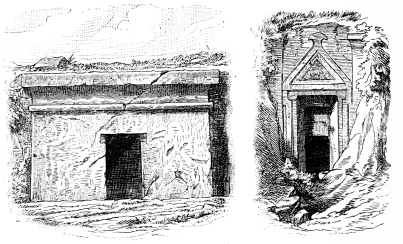
Fig. 104.—Rock-cut Tomb of Siloam.
Fig. 105.—Rock-cut Tomb of Hinnom.
The influence of Greece and Rome is distinctly betrayed in the so-called Tomb of Jacob, the pretended sepulchres of the kings, and the tombs attributed, without reason, to Absalom and Zachariah. These monuments, some of which have been cut entirely from the native rock, are ornamented by Doric friezes with Roman disks in the metopes, and by Doric and Ionic columns and engaged shafts, which reproduced the debased forms which characterize the treatment of Greek architecture under the Romans. Yet in all this there are still traces of national peculiarities. At times vegetable ornaments, grapes and grape-leaves, pomegranates, ivy, laurel, and acorns fill the tympanon and the frieze, interrupted by the triglyphs. The{159} general form of the two last-named tombs is peculiar. That of Zachariah is a cube of a little over 5 m. on the side; that of Absalom of almost 7 m. They are ornamented by pilasters and debased Ionic engaged shafts, and have heavy cornices of the Egyptian roundlet and scotia, to which is added, upon the Tomb of Absalom, a late Doric frieze. The former is concluded by a pyramid, 3.6 m. high, cut also from the native rock, a termination which gives to the general form a certain similarity to the Tomb of Amrith known as the Snail-tower. The latter supports upon the cube a smaller and much lower mass of masonry, built of quarried stones, and bearing upon a doubly stepped cylindrical base a cone of concave outline, which terminates, at a height of 13.5 m. above the ground, in a clumsy, tulip-like flower. The entrance to the burial-chamber cut in the rock substructure of Absalom’s tomb has been broken in above the scotia cornice; the traces of nails upon the walls of the small space point to the customary sheathing of metal. Notwithstanding such isolated reminiscences of indigenous—that is to say, Phœnician—manners of building, it is impossible to agree with several noted authorities in recognizing, in the Doric and Ionic details which appear combined with them, predecessors and models of the Hellenic development of these styles. Such prototypes should least be sought among a people who, possessing no art of their own, did but borrow from their neighbors. And, moreover, these forms appear by no means to be primitive attempts, but clearly exhibit the lifelessness and debasement of the latest period of Greek architectural history. These monuments may safely be ascribed to the last two centuries B.C. Although the Corinthian order almost entirely superseded the older styles in Italy during the time of the Cæsars, these provincial Doric and Ionic forms may still be assumed to date rather from the later than from the earlier half of this period.
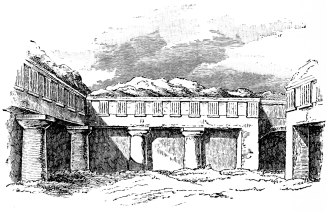
Fig. 106.—Tomb at Paphos in Cyprus.
Palestine, in the history of art, may be regarded as a domain of Phœnicia, and the same thing may be said of Cyprus and of Carthage. All the eastern coast of the Mediterranean, lying as it did between the great powers of civilization in the valley of the Nile and the plain of the Euphrates and Tigris, seemed destined by nature, as we have seen, to combine the artistic peculiarities of Egypt and Assyria. Cyprus, in a somewhat similar position, shared the{160} Phœnician civilization and was also exposed to the influence of the Greeks, especially to that of the Dorians, who had founded colonies upon the southern islands of the Ægean, and who early possessed a stronghold in Crete. It is therefore not surprising that upon the rock-cut tombs of Cyprus the Doric style of architecture was not restricted to the late and debased forms found upon the tombs near Jerusalem, but may occasionally be met with in a very primitive state of development. An instance of this is offered by a tomb near Paphos. (Fig. 106.) In general, the position of the island exposed it more to the influence of Egypt than of Mesopotamia; it is not evident in how marked a degree this was felt. Of the chief Phœnician sanctuary upon Cyprus—the Temple of Astarte at Paphos—there exist only insufficient representations upon coins and upon an engraved gem of the Museo Pio-Clementino. These prove no more than that, within a circular enclosure of lattice-work, there stood a tall structure towering above low side-buildings, which were supported, like porticos, upon columns. Two Egyptian shafts appear to have been placed before the entrance, without function as supports, and, like Jachin and Boaz, without strictly architectural purpose. Still less is known of the temples of Amathus and Golgoi. It is hardly probable that the remains of a building discovered by General Cesnola in the village of Atienu, near the present port of Larnaka (the Biblical Chitim and Greek Kition) are those of the{161} world-famed Temple of Aphrodite at Golgoi. The structure seems rather to have been a treasure-house, in some way connected with the great temple, which once contained, with the votive statues there discovered, other objects belonging to the temenos. The oblong plan with irregular entrances, the bareness of its walls, and especially the carelessly arranged pedestals which filled the space within, seem to point to its original destination as that of a magazine. The only objects of architectural interest discovered in these remains are the columns which flank the doors, in a position corresponding to that of the columns of the Mosaic tabernacle. The bases, found in position, are channelled like those of Persia. The shafts and capitals are not preserved. The form of the latter may perhaps be surmised from a comparison of fragments in the Cesnola collection (Fig. 107), analogous to the capitals of Mashnaka, to the double spirals of Assyrian architecture, and to the descriptions given of the lily-capitals of Solomon’s Temple.
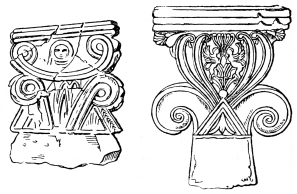
Fig. 107.—Cyprian Pilaster Capitals.
Cesnola’s discoveries upon Cyprus are more important in sculptural than in architectural respects, and are worthy to rank with those of Botta, Layard, and Schliemann. The chief works are limestone statues of various sizes. To these are added, from the investigations of other ruins, doubtless of tombs, a great number of minor articles: terra-cotta figures, vases and lamps, and various objects of glass, metal, etc. These works are easily divided into two great groups, each of peculiar style, with which the inscriptions that have{162} been discovered agree in general character and in relative number. Among the eighty-five inscriptions found up to 1870, thirty-three are Greek, twenty Phœnician, and thirty-two Cyprian. The styles of Phœnician and Cyprian sculpture resemble each other far more closely than did the languages of those countries, so that in the comparative rarity of examples it is difficult to distinguish the origin of these works. They show a kind of compromise between Egyptian, Syrian (Assyrian), and early Greek methods—a combination agreeing with the geographical position of the island, and with the descent and history of its inhabitants. All Cyprian sculpture shows, in so far as it is not influenced by a reflection of the later Greek and Roman forms, the Phœnician style which has been described as developed from beaten metal-work; this is evident even in the stone carvings. (Figs. 108 and 109.)
The destruction of Carthage is as famous for its completeness as that of Jerusalem, which, indeed, it resembled in other respects, and it is natural that but few traces of this magnificent Queen of the Sea should have been preserved. Recent French and English investigations under Bente and Davis describe the considerable remains of the fortification walls of the Byrsa, built of colossal blocks of tufa. Their great thickness, 10 m., permitted the formation of semicircular chambers in three superposed stories, which, being accessible from within, served as casemates and magazines. The numerous rock-cut tombs are, as in Phœnicia, provided with steps from above, and form an oblong crypt, about which the deep niches for the reception of bodies are grouped.{163}
The remains of barbaric temples upon Malta and the neighboring islands are of subordinate importance, if indeed they are to be mentioned at all, in the consideration of Phœnician art. The double temple upon Gozo is the most important of them. It consists of two adjoining spaces, each concluded by a semicircular apse, having upon both sides similar niches, so that the entire enclosure appears as a combination of apses around an oblong. The pavement is partly of rectangular blocks, so stepped as to show an interior division; but the Cyclopean masonry of the walls is so rough that, in its entire lack of ornamental treatment, the structure has but little interest for the history of art, and permits no conclusions concerning Phœnician architecture, which elsewhere produced such incomparable masonry of hewn stones.
The funeral monuments of the remaining Punic lands, of the Balearic Isles, and notably of Sardinia, though of greater artistic value, are fully as uncertain in their origin. Their form is at times like that of the monuments of Amrith; yet they may very possibly be of Etruscan derivation, for, apart from their resemblance to the tombs of Etruria, they are almost exclusively upon the eastern coast of Sardinia, the side turned towards Italy, while the Phœnicians would more naturally have come in contact with the western part of the island.
The most advanced outpost of the extended civilization of Phœnicia was Asia Minor. Under the dominion of the Seleucidæ and of the Romans, the influence of Greek art was so felt upon the Syrian coast, and even as far as the banks of the Tigris, that purely national works of architecture and sculpture are comparatively rare. But this influence was doubly great in the land of which, from the earliest times, the Ionians had possessed the seaboard, and where they had founded a number of flourishing cities which had attained to a degree of prosperity and culture not less than that of{164} their relatives upon the peninsula of the Peloponnesos. Yet, although Ionian art bore some of its finest fruit upon Asiatic soil, and from roots which may partly be traced back to Mesopotamia, this can be historically treated only in connection with the civilization of Greece and its common origin and development. Hellenic Asia Minor and the countries under its influence—that is to say, the coasts and islands of the Ægean, Propontis and Pontus—cannot be separately considered. All the sculpture of these regions must therefore be reserved for a later page; but there are a few architectural monuments of the southern coast and of the interior which require our present attention as being peculiarly national. Yet even in these territories, divided according to their ancient population into Lycia, Phrygia, and Lydia, all the monumental architecture was greatly affected by the long Asiatic sway of the Diadochi, and by the military power of Rome. The temples and public edifices gave up their national peculiarities for manners of building characteristic of Greece and Rome. It was only in the tombs that original conceptions retained a stubborn hold. These, when cut in the rock, became imitations of the dwellings of the country. Types of house construction were represented which had been determined by the climatic necessities and by different building materials of each province. By their massive simplicity and by the popular consideration that a changeless dwelling best suited the quiet repose of the dead, the rock-cut tombs retained their primitive peculiarities without sensible alteration, being exposed only to unimportant modifications. Little reference was made in them to the advance of artistic or constructional methods from age to age. Though we have to deal exclusively with the tombs of the country, they allow{165} us to draw conclusions concerning the appearance of other buildings, whether temples or dwellings, which they had taken as their models.
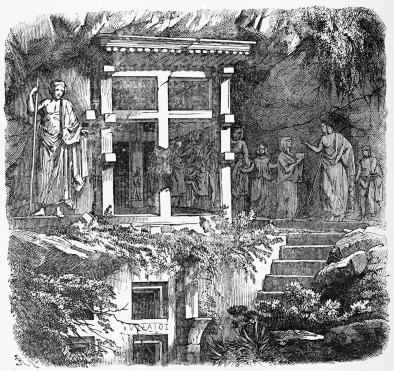
Fig. 112.—Rock-cut Tomb at Myra.
Next to the Phœnician coast, and opposite Phœnician Cyprus, lies Lycia, embracing the greater part of the southern sea-line of Asia Minor. It calls for chief consideration because of its almost numberless tombs, some of which are admirably preserved, and because of their instructive variety. Entire cliffs, like the Necropolis of Myra, shown in Fig. 93 at the head of this section, are literally covered with such monumental façades, picturesquely grouped according to the natural configuration of the rock. The greater number are excavated grottoes, the fronts of which are careful imitations of timbered houses. They might be called log-house tombs if other than the roof beams were of unsquared trunks. The interstices between the framing, when not remaining open as an entrance, are closed by panels. The individuality of these monuments is as marked as could have been possible among the dwellings of Lycian mountaineers, whose wealth was not great, and whose architectural demands did not much vary. An exact imitation of the ingenious carpentry is cut in the rock down to the smallest detail: the stiles of the panelling, the round unhewn timbers of the roof, the clamping and dovetailing of the beams, and the primitive tree-nails with which these are secured are shown with the greatest distinctness. The appearance of the whole, when intact, must have resembled a petrified village. These groups of tombs are among the most curious and striking remains of antiquity. The attempt was made by several races of early civilization to prepare a funeral-chamber which should resemble as closely as possible the dwellings inhabited during{166} life; but this intention was not elsewhere so thoroughly carried out, and never resulted in so piquant a contradiction to the material in which it was executed. The native rock was made completely to deny its nature, and to present the image of a distinctively wooden construction. Upon abrupt cliffs this was usually restricted to a façade, which at times was very simple, but quite characteristic, as in a tomb at Antiphellos (Fig. 110), where the wooden framing underneath the flat projecting roof forms two windows, left open as entrances to the cavern. A somewhat more complicated example is shown by another tomb of this site (Fig. 111), which is especially remarkable on account of the carefully imitated coping of the cross-beams. In this case only one of the door and window panels is open, and a gabled roof appears, which seems to have been{167} customary in Asia Minor, and to some degree in Phœnicia. The framing of an interior or of side walls is also shown by the stone imitation, as in the case of a fine example at Myra (Fig. 112), which seems to illustrate the utmost limit of the style. But here the contradiction between the form and the material is so glaring that the curious elegance of the result does not redeem it. The repeating of wooden constructions in stone without any modification—which is at first sight, and in less extent, pleasing and piquant—has here become disagreeably obtrusive. This is still more striking upon the rarer monumental sarcophagi at Phellos and Myra, where the block-house is carved in the full round from the native rock. These works represent the wooden model upon all four sides, so completely and conscientiously that it would be possible, by their aid, to reconstruct the dwelling-house of a Lycian mountaineer in wood—to repeat from such a petrified copy the original, though its frail materials perished more than twenty centuries ago. It is curious how greatly the present huts of the country resemble their antique predecessors.
Near these tombs, in some instances even connected with them, though usually independent, stand upright monuments of the nature of obelisks, but with an upper member characteristic of Lycia. In place of the pyramidal point of Egypt, or of the hemispherical or stepped termination of Phœnicia and Assyria, there is here a cornice of projecting slabs, upon which rests a small but comparatively high block. The most important example is that known as the Monument of the Harpies (Fig. 113), now in considerable part transported to the Lycian Hall of the British Museum. It consisted of a gigantic monolith bearing a small burial-chamber, the enclosing slabs of which were ornamented by the famous reliefs, so important in the history of Greek sculpture.
The third group of Lycian sepulchral monuments, the smaller sarcophagi, is the most numerous, forming at times an extended{168} necropolis. Though the majority are not free from Hellenic influences, they yet generally maintain the peculiar national characteristics, being imitations of wooden constructions somewhat similar to the rock-cut tombs. The lid in some instances appears to be of slat-work, and, instead of the semicircular gable common in Phœnicia, presents a pointed arch. The cornice dentils distinctly betray their derivation from the projecting ceiling beams, which, upon the block-house tombs, had still preserved the round form of unhewn timbers. A tomb at Antiphellos (Fig. 114) has a channel cut upon the summit of the lid, probably to serve as a socket for the ridge-crestings. The heads of lions and other projecting ornaments upon the sides enrich the architectural treatment. The monument cannot be spoken of as a sarcophagus, in the true sense of the word, for its lid was not movable, the body being introduced from the front, where window-like openings were provided for the purpose.
A fourth class of Lycian rock-cut tombs, those with a façade resembling a small temple-front, is of particular interest to the history of architecture. Many among these display the influence of a late Hellenic period, yet some preserve such primitive forms as to make it certain that Lycia took a prominent part in the development of the Ionic style—that the southern coast of Asia Minor was an important station, marking the advance of artistic culture from Mesopotamia to the Ægean Sea. These tombs generally represent the front of a temple in antis—that is to say, of a portico with two columns between the advanced side walls. The predominant Ionic forms are singularly primitive in the capital and entablature, the greater number{169} of the examples showing no trace of the decline of the style, or of the Roman type, so easily recognizable by the formal character of the details. These differ greatly, and seem to show the experiments of an early period of development, which may still have been contemporaneous with a far higher advance of the style upon the more northern coasts of the Ægean Sea and Sporades, being influenced in a different degree by the same Western Asiatic motives. The important combination which characterizes the perfection of Ionic architecture—the conjunction of the volute with the Doric echinos beneath it—does not appear upon these capitals; the spiral has not a graceful curve, and the contraction of the side rolls of the volute is lacking; the abacus is badly profiled, and the shafts are often joined without a curve to the clumsy bases. (Compare Fig. 116.) As was always the case among the Orientals, who knew of no independent gable and roof formation above the ceiling, the entablature consisted of only two members,—the epistyle, uniting the columns, and the terminating cornice. The triple division of the entablature, of so marked importance in the perfected style, was not known; even the two members here occurring were not sharply defined, and the dentils of the cornice were fully developed at a time when their original constructive significance had not yet been forgotten in their decorative application. The gable acroteria are clumsy knops, similar to the circular ridge ornaments and the horn-like corner pieces of Phœnician monuments. In short, we may trace in the rock-cut tombs of Lycia, if not a Proto-Ionic style, yet a distinct parallel development of the most{170} primitive Ionic forms. These did not exclude the influence of Greece, after the full perfection of the style had been attained, but rather prepared its way. An example of such later semi-Hellenic work may be observed in the magnificent monument of Xanthos, built in the middle of the fourth century B.C. as a trophy after the capture of Telmissos by the Xanthians. This also has been in part transported to the British Museum. This structure was not cut from the solid rock, but was built of quarried stones. It shows the full development of Ionic forms. Upon a comparatively high substructure there stood a cella surrounded by columns—of a peripteral arrangement rare in Lycia, where all the tombs which represent temples seem to show that the national places of worship, like those of Assyria and Phœnicia, were restricted to a portico in antis, the evolution of the peripteros being an improvement of the Greeks. The naïve originality observable in the Ionic does not exist in the more isolated Doric forms, although a few very archaic monuments of the latter style are known. Their existence is explained by the vicinity of Crete, that southern outpost of early Doric culture, as well as by the neighboring Doric colonies which flourished upon the southwestern extremity of Asia Minor.
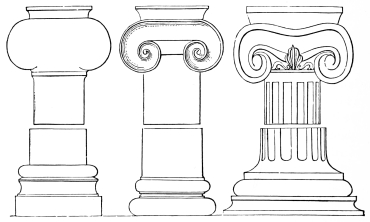
Fig. 116.—Details of Columns from Telmissos, Myra, and
Antiphellos.
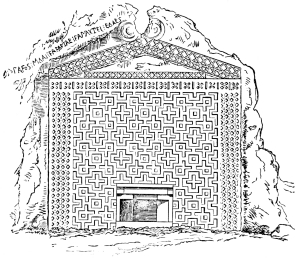
Fig. 117.—So-called Tomb of Midas.
Lycia appears to have had but little influence upon the other countries of the seaboard, which were almost entirely Hellenized;{171} nor did its influence penetrate as far into the interior country as Phrygia, where the civilization of the Greeks was introduced only by way of the Ægean and Pontic coasts. There were neither frequented ports nor navigable streams to open the way. The tracklessness of wooded mountains restricted the commercial and intellectual horizon of the Phrygians, who, as a nomadic people, were contented with the slightest artistic exertion. In the same way as the Lycian carved his wooden hut upon the face of the cliff, that he might retain after his death the beloved dwelling of his life, the Phrygian ornamented the front of his grotto graves by a representation of his movable house, the nomadic tent. Only the cloth of the tent, with its woven pattern, was shown; its constructive ribs, not visible upon the exterior of the original, were omitted from the imitation. The most important of these tomb frontispieces, between Kiutahija and Sivrihissar upon the Saquaria, which are attributed to Phrygian kings, is called by the Turks Yasili-Kaia (the inscribed stone). (Fig. 117.) It is known as the Tomb of Midas from the one legible word, Midai, occurring in an unintelligible inscription. Upon the face of the cliff there is cut a square surface, 11 m. broad and about 9 m. high, terminated above by a low gable,{172} which, with the acroterium, adds 3 m. to the height of the whole. The triangle is framed by a light lattice-work in low relief, and crowned with two volutes, similar to the circular ridge decorations of Phœnician tombs. The tympanon is not carved, but probably, with the entire front, was painted. The extensive rectangular surface beneath is covered with a complicated meander ornament in relief—a play of lines evidently taken from a woven pattern and resembling the decorations of Moorish walls, where the fundamental motive was also the tent-cloth. The border of this surface represents, without conventionalization, an edging set with precious stones, such as may have been customary upon costly Syrian stuffs. The small interior chamber was only large enough for the reception of a sarcophagus. The entrance to it was not marked by any architectural features—even as the tent itself was not provided with a door—but the passage was originally closed by a slab, upon the face of which the woven pattern was without doubt continued. A second tomb of the vicinity, also marked by an undecipherable inscription, is of similar character. (Fig. 118.) The gable represents a wooden construction, somewhat like the framing of Lycian sarcophagi; its double acroterium is decorated with three rosettes. The principal surface, the square below, is without carving, and had probably a painted pattern. A third frontispiece of this type shows a floral frieze of alternate palmettoes and buds, resembling an Assyrian motive, but inverted, perhaps because its direct model was the border of a carpet. It recalls the hanging rows of pomegranates upon the columns Jachin and Boaz of Solomon’s Temple. The cliffs of Phrygia are honey-combed by such rock-cut tombs. Especially in the district north of Seid-el-Ar are there numberless{173} small grottoes, the entrances to which are either perfectly plain or provided only with a simple triangular gable—all giving proof of the rarity of artistic effort among these idyllic mountains.
The influence of Assyrian and Persian methods is evident even to the west of the river Halys, the border of the Mesopotamian dominion before Cyrus; but upon its farther banks, in Eastern Phrygia, Oriental art is universally prevalent. At Eyuk there are remains, supposed to be those of a temple, with a portal flanked by monsters like the cherubim of Nineveh and Persepolis. At Boghaz-Kieui, besides rock-cut reliefs entirely similar to those of Persia, there are the foundations of a terrace with the ruins of a palace, built upon the plan of the royal dwellings of Persepolis.
Lydia, the last of the three independent countries of Asia Minor, was so near to the Ionic cities of the coast, and so exposed to the influence of their civilization, that but few national peculiarities were preserved in the historical period. The tumulus was there, as in early Greece, the customary form of the monumental tomb. In Lydia, as in Etruria, numbers of these mounds stood in an extended necropolis. The conical tumulus is as characteristic a form for the extreme west of Asia Minor, for the Troad, as the strictly geometrical pyramid is for Egypt, or its terraced variation for Mesopotamia. The mound of earth was at times reveted with a masonry of large polygonal blocks, or placed upon a low cylindrical drum of such Cyclopean walls; the only architectural ornaments were simple base and cornice mouldings. The best-preserved, though not the most important, monument of this kind is the so-called Grave of Tantalos upon Mount Sipylos, near Smyrna, one of a group of twelve. (Fig. 119.) The rectangular chamber in its centre, 3.5 m. long and almost 3 m. high, is roofed by a false vault, the horizontal, gradually projecting stones being cut within to the outline of a pointed arch. The entrance to this tumulus, like the shafts of the Egyptian pyramids, was hidden by the casing of exterior masonry. The fragments of a stone pier near by, somewhat like the Meghazil monument of Amrith, probably belonged to the ornament upon the summit of the cone, which, with a diameter of plan equal to 33.6 m., attained a height of 27.6 m. Of greater grandeur, though in an entire state of destruction, are the royal{174} graves of the Lydian capital. The world-renowned name of Sardis has been preserved in the appellation of the squalid village Sarabat now standing upon its site. In its vicinity are the remains of more than one hundred tumuli. The most important of these, with a cylindrical drum 257 m. in diameter and 18.5 m. high, still rises to an elevation of 61.5 m. It is with some probability identified with that monument of Alyattes described by Herodotos, who exaggerates its dimensions to a diameter of 400 m. The cone of rammed earth was apparently not reveted with stone. Upon its apex there was a pier of five blocks, which bore a hemispherical termination; of this various fragments have been found.
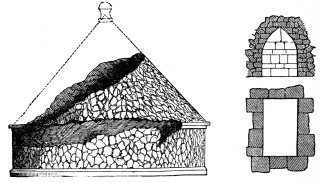
Fig. 119.—The So-called Grave of Tantalos.
These tumuli approach in dimensions closely to the pyramids of Egypt. The elevation of the cone upon a cylindrical base was a certain advance, but its execution was such as to allow of no comparison between the monuments of the two countries. The pyramids of Egypt were built; the tumuli of Lydia were merely heaped up of earth. The former demanded great technical ability and the assistance of a commanding and calculating mind; the latter were the works of an enslaved people alone. But, on the other hand, the Lydian cones more closely resembled the natural form of a funeral mound than did the pyramids of Egypt and Mesopotamia, and on this account were capable of greater development. Such tumuli are to be met with from Asia to Etruria, and were adopted even by the great architects of Greece: the highest artistic civilization always gives preference to the simplest solution of a problem.{175}
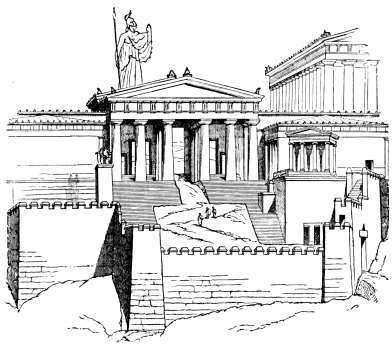
Fig. 120.—View of the Athenian Propylæa. Restoration.
THE Mediterranean Sea was the heart of the Old World; the important lands of the early history of civilization were grouped about its richly indented shores, generally decreasing in respect of culture as they receded from it. The northeastern part of the Mediterranean, because of its many islands, having an even greater proportionate coast-line, was the centre of the countries ennobled by Hellenic civilization. Separating and uniting at once, like all the waters of the earth, the Ægean Sea formed the boundary between the two chief races of Greek intellectual life—the Dorians and the Ionians; while it was, at the same time, the favoring medium of exchange for the productions of their genius. European Greece, with its predominating Doric population, and the almost exclusively Ionic coasts of Asia Minor, equally looked upon this sea as their own, traversing{176} it with thousands of ships, and gaining more from the trackless waters before them than from the interior lands of the immense continents whose seaboard alone they were content to occupy. In Asia the Greeks were restricted to the countries upon its uttermost western border; in European Greece the development was chiefly directed towards the eastern coast, paying even less attention to their own shores on the Adriatic than to the early colonized ports of Magna-Græcia and Sicily. The Archipelago itself provided convenient strongholds and outposts in every direction. The numerous harbors and anchoring-places of its many islands offered protection against the notorious treachery of the Ægean main—a protection imperatively necessary for the primitive seafarers of antiquity. But, as in the history of all civilization, the currents of Greek intellectual and artistic progress moved distinctly from east to west. The European (Doric) culture was in itself less calculated to influence Asia than the Asiatic (Ionic) to affect the younger continent. It was, as decided by nature, upon European soil, upon Attica—the most advanced promontory of European Greece—that the two branches of the Greek race united, and bore in Athens that double fruit at which we marvel. The Dorians, displaced, in some measure, by the rapid growth of Ionic Asia and Europe, turned still farther westward, and settled upon the shores of Sicily and the Gulf of Tarention, where imposing monuments still attest the extent of their power.
The legends of the wanderings of Hellenic tribes, and especially of the so-called Doric migration, were based upon the busy currents of intercourse between Asia and Europe, over seas and straits, and between the European continent and the Morea, the Island of Pelops. The relations and the quarrels of Hellenic and semi-barbaric peoples upon each side of the Ægean are illustrated by the tales of the Argonauts and their voyage, and of the Trojan War, both of which bear the stamp of a certain piratical rivalry. The fatal lack of unity, resulting from the separate development of neighboring districts, could not be more distinctly characterized than by the fact that the Greek races, although they felt themselves divided from other nations—from barbarians—by an impassable gulf, and were aware of their own absolute intellectual{177} superiority, yet lacked any comprehensive designation for themselves: the name Greeks, or Hellenes, is of comparatively recent origin.
The Homeric epics prove that the intellectual development of the people to whom the immortal poet belonged stood, at least as early as the ninth century B.C., at a height to which nations of such primitive civilization as the Egyptians and Chaldæans had never attained. Phenomenal as the appearance of those poems may have been, they still could not have stood so high above their time—which they evidently represent with a certain transfiguration—that contemporaries were not able to comprehend and enjoy them. The creative arts stood, at this epoch, in strange contrast to so great an intellectual height; they were far surpassed by the advance of poetry. Though certain textile and ceramic manufactures (the making of wooden and bronze utensils, woven stuffs, and pottery) must have been practised to some extent in Greece proper, the better artistic productions are continually referred to as imported from the civilized countries of Asia. Larger objects, and notably buildings, were either exceedingly primitive, or, in the lack of trained native ability, were erected and ornamented in foreign styles. The Homeric epics know nothing of a columnar temple, nothing of artistic images of the gods, nothing even of dwellings corresponding to the importance of their princely heroes. Even at a much later time a Spartan, accustomed to erect his own house with saw and axe alone, might be astonished at the squarely hewn beams of a ceiling, which he previously had seen formed only of round trunks, like those imitated upon the Lycian block-house tombs.
It is of this exceeding simplicity that we must picture to ourselves the palaces of the kings, one of which is so attractively described by the singer of the Odyssey, in the account of the royal dwelling at Ithaca. The entire establishment must have been similar to a grange—a wall enclosing a number of buildings with the court before them. The rustic parallel is clearly brought to mind by the description of this farm-yard, where the compost-heap, surrounded by swine and geese, was the bed of the old watch-dog, who, in Homer’s truly idyllic account, alone recognizes his master, and, dying, wags his tail in greeting. From this yard a gate led to an{178} inner court, comparable to the peristyle of later buildings, but without the ornament of columns, and in all respects extremely primitive. Goats and beeves were driven in here without further ado to be slaughtered. This adjoined upon one side the chambers of the men, upon the other those of the women, so separated that the tumultuous massacre of the suitors in the principal hall did not disturb the slumber of Penelope, and only reached the ears of the maids like distant moaning. Upon the third side, probably opposite the entrance, was the hall of the men, a ceiled space, which must have been of considerable extent, as the hundred and eight unwelcome guests could here unite in the banquet and other amusements. Its ceiling, like that of the armory and that of the royal sleeping-chamber, was supported by upright beams of wood. We may imagine these similar to the shafts in the Palace of Oinomaos at Elis, one of which, bound together with iron hoops, was preserved as a relic in the time of Pausanias. The ceiling beams of the hall were smoked and blackened by open fires and torch-lights as in rustic dwellings. Of the walls there is no mention, though the supposition is not improbable that the bright metal sheathing of the palaces of Menelaos and Alkinoös existed here also. It would be explained by the Phœnician overlaying of wood-work with beaten bronze, or, to speak more correctly, with copper. The space could not have been without openings for light and air. These are not directly mentioned by the poet, but may be assumed, from the analogies offered by other civilized nations of early antiquity, to have existed in the wall, immediately under the ceiling. Here the interstices between the immense horizontal beams, which rested upon the walls, were left open, and the motive of the subsequent Doric metope resulted of itself. That the timbers overhead were not sheathed with boards is evident from a Homeric simile: Athene rose to the ceiling, and there sat, “like unto the resting swallow;” that is to say, upon the cross-beams of the open triangle formed by the roof-framing. Further evidence is offered by the account of the hanging of Epicaste upon a ceiling beam, which must have been exposed from all sides.
The tholos of the palace at Ithaca was an isolated circular structure, before the court, and may perhaps be identified with the high thalamos to which Telemachos descended. In this also lay{179} gold and metal in heaps; while shrines containing garments, and amphoras filled with oil and wine, etc., stood around. Its double door, of careful workmanship, agrees with the character of a treasury. If this identification of the tholos and thalamos be accepted, no doubt can remain that we have here to deal with a space similar to many yet remaining in Greece, generally known under the name of treasure-houses. Examples exist at Orchomenos, near Pharsalos, Amyclæ, Menidi, and in Mykenæ.
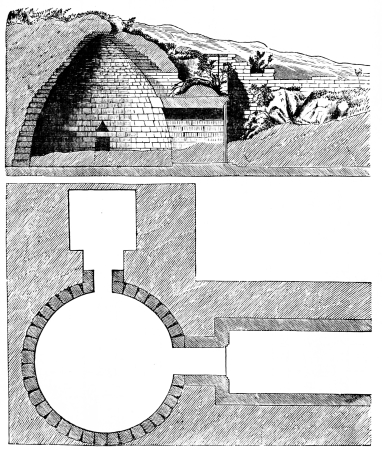
Fig. 121.—Plan and Section of the Tholos of Atreus.
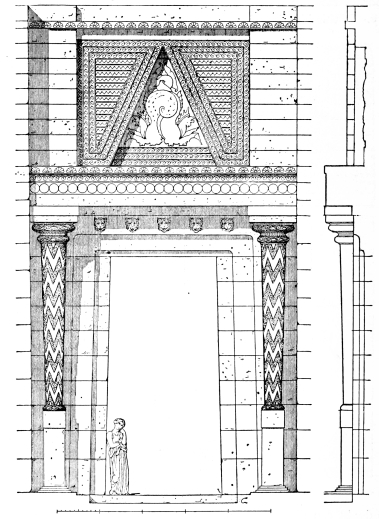
Fig. 122.—Restoration of the Tholos of Atreus. Portal.
(Clarke.)
One of the five in Mykenæ, known as the Treasury, or the Tholos,{180} of Atreus, remains in an admirable state of preservation, especially as regards the interior. This consists of a space of circular plan, 15 m. in diameter, and of the same height, formed like a pointed vault. (Fig. 121.) Its walls begin to curve from the floor, which is of stamped clay pisé. Upon this the first circular course of masonry{181} immediately reposes. The walls then rise, in parabolic outline, to a pointed apex. They are not constructed upon the principle of a vault—that is to say, with wedge-shaped stones, and with the direction of joints to a common centre—but are laid in horizontal beds, each course so projecting over the one beneath it that, by this diminution of the concentric circles, they finally unite at the summit. They were smoothly cut upon the jointing surfaces, while the face was not chiselled until after the completion of the masonry. The blocks were rectangular, and the joints, which consequently increased radially in plan, were filled with the same pisé used for the floor; the interstice between the wall door and the rock-cut inner chamber upon one side being also cemented with this substance. An entrance-passage, the dromos, led from the valley to the tholos in a gently inclined ascent. It was bordered by walls of cut stone, but nowhere ceiled. Its floor, 6.20 m. broad and 36 m. long, was paved with pisé. Thisentrance-passage was terminated without by a terraced retaining-wall, and within by an elaborate portal façade. The recent investigations of Stamatakis and Thiersch have given sufficient information concerning the composition and details of this front to permit a restoration of its chief masses. (Fig. 122.) The lower part was constructed of long stones, carefully cut and jointed. The stepped jambs of the opening, peculiar to all antique doors, were probably cut after the blocks were in position. Upon either side were decorative engaged columns, which are so entirely similar to the one represented upon the Gate of the Lions at Mykenæ that it is possible completely to understand their nature by{182} that general guide; by the help of fragments which still exist, and others drawn in former publications, though now lost; by traces upon the wall, and especially by the sockets cut for the swallowtail clampings of the bases and capitals. The shaft, instead of being diminished, increases as it ascends, as does also the column upon the relief over the Gate of the Lions. Its base, from this analogy, and from the narrow space left for it by the clampings, seems to have consisted of a simple tore. The abacus and parts of the mouldings beneath it still exist; the coronation was formed by two roundlets, separated by a scotia, the lower being considerably smaller in height and diameter than the upper. (Fig. 123.) Without the lower member, there is a certain similarity of the capital to a Doric echinos, which is increased by the proportions of the boldly projecting abacus; but the whole is so similar to an Asiatic (Ionic) base that it was not natural to believe it a capital, and the fragment published by Donaldson has hitherto been believed to be the foot of the shaft. The columns were entirely covered with an ornamentation in relief of zigzag lines alternating with the well-known spiral wave; they stood upon rectangular pedestals, of which the triply stepped plinths have been preserved. The existence of bronze ornaments upon the lintel of the door is evident from the traces of nails; five lion-heads can be distinctly recognized. An epistyle extended from capital to capital across the entire front of the portal; it projected far beyond the lintel, upon which it partly reposed. Above this entablature was a surface, like an attica, which masked the triangle formed by the relieving blocks over the lintel. The upper walls were not originally visible, having been reveted by thin slabs of stone, secured in position by dowels. Fragments from Mykenæ deposited in the British Museum, in the Munich Antiquarium, and in Athens appertained to this upper façade; they all show spiral ornaments between horizontal grooves, and are similar to many other decorations of the same age. The borders of the casing over the relieving triangle and its extreme upper corner were patterned in like manner, as is plain from the mitre-joint of some of the slabs, and from a small fragment exactly fitting the upper angle of the opening. The entire triangle was probably closed by some light stone carving, since it could have had no function as a passage for{183} light. The door, as may be seen from traces of pivots upon the sill and lintel, had two wings, which, from their bolt-holes, appear to have been so large that, when closed, they considerably overlapped. Upon the exterior jambs a broad strip of metal was affixed, still to be traced by two vertical rows of nail-holes, in which fragments of bronze occasionally remain. This work leads to the supposition that the wings of the door were themselves overlayed with metal, and, with the characteristic forms of the decoration upon the monument, points to the peculiarities of Asiatic art. It is natural to attribute this to the influence of Phœnicia; indeed, the effect of the civilization of that country upon early Greece can hardly be overestimated. A broad, horizontal strip of metal sheathing existed also upon the exterior, and small fragments of it are repeatedly met with in the rubbish filling the tholos; similar vestiges are found in a second monument of the kind near by. This overlaying of walls with sheet copper was by no means uncommon in ancient Greece. The subterranean bronze chamber of Danae may be explained as a tomb sheathed with metal. In mythical ages, in the sanctuary at Delphi, as well as in later times, in the Chalkioicos of Athene at Sparta, this wall-treatment appears employed for temples, even as Homer described it in palaces at Sparta and the Island of the Phæacians. The Tholos of Atreus was itself subterranean; the exterior of the conical mass of masonry was covered with a hill of earth. In consideration of the almost perfect preservation of the interior, it is evident that some remains of a strictly architectural exterior would have been recognizable, had it existed. A tumulus covered and protected the structure; though its earth is now, for the greater part, washed away, to it must still be ascribed the good condition in which the kernel has remained.
The recently discovered grave at Menidi, in Attica (Lolling), is a parallel construction. As regards beauty of execution and richness of ornament, it is far inferior to the Tholos of Atreus; it is also much smaller, having an average diameter of 8.35 m. and 9 m. original height. Its only peculiarity is that the relieving blocks over the lintel, instead of projecting one over the other so as to form a triangle, are so placed as to leave four voids between as many horizontal beams, in a manner similar to the arrangement for relieving{184} the ceiling of the principal chamber of the great pyramid of Gizeh.
The Tholos of Atreus offers a welcome commentary upon the thesauros of the royal palace at Ithaca, but only in respect to its construction. The purpose of the circular buildings still existing in Greece seems to have been entirely different from that of the treasure-house described in the Odyssey. It is true that eminent authorities deny this difference—and the analogies of the round Homeric building, of the treasure-vaults at Mykenæ mentioned by Pausanias, and of the treasury of Minyas in Orchomenos, lend their arguments some weight, and, at least, a greater probability than the suppositions that the structures of tholos form were intended for spring-houses (Forchhammer) or places of worship (Pyl). But there are reasons against all these assumptions. The treasure-houses of the Pelopidæ must have been upon the acropolis, inside the fortification walls, not at various distances outside their limits, as is the case with those of Mykenæ. Still less could such vaults for hoarded valuables have been as distant from the city as was the Tholos of Baphio from the ancient Amyclæ, which stood entirely isolated in the midst of an open plain, without the possibility of communication with any royal residence. The tumuli of earth above the crypts would have but ill suited them to form a part of the palace building; while for a cell which was only to receive precious goods—for a magazine of deposit—the rich overlaying of the interior walls with sheet metal, and especially the elaborate carving of the portal front, seem out of place. These peculiarities, not to mention some of less importance, point to another purpose, for which they are, one and all, fitted—namely, the destination of the structures as tombs. Their position, before the acropolis and without the city walls; the covering of the chamber with earth in a tumulus form; the impossibility of their having had any communication with other buildings; the elaborate decoration of the entrance, and the princely wealth of metals in the interior—all support, with the striking analogies beyond the Ægean, this conception of the tholos buildings advocated by Welcker and Mure. It is possible that it is to these structures that Pausanias refers as the treasure-houses of the Atridæ; but Pausanias, like us, knew Mykenæ only by its ruins.{185} That patron of all ciceroni upon classic ground was not exacting for proofs of their legends. The hypothesis of Pyl may in so far be correct that the tholos itself did not serve as the place of sepulchre, which was provided by the small side chamber, but was a chapel for the funeral worship naturally to be assumed in connection with an heroic dynasty.
It is not possible to assign these tombs to individuals, like those of the early Persian monarchs, or even to dynasties: the questionable identification of the graves discovered in the agora of the acropolis, ventured by Schliemann, would here be inadmissible. It is reasonably certain, however, that the best-preserved tholos, that known by the name of Atreus, is about contemporaneous with the Gate of the Lions, and dates from the most flourishing period of the heroic age—before the downfall of the Atridæ upon the return of Agamemnon.
A small chamber, only of sufficient size to receive the cinerary urn, in the centre of an upheaval of earth, was sufficient for the graves of the heroes who fell before Troy. Several of these tumuli exist. The larger of them, those of Hector and of Achilles, had a considerable elevation, and, standing upon a low promontory, were visible far at sea. They were without architectural features or decoration, mere cones of earth and stones; terminated, as Homer relates concerning those of Ilos, Sarpedon, and Elpenor, by a monument like a column, which must have resembled the piers upon Lydian tumuli. It is questionable whether the trees which grew in later times upon the mounds of Protesilaos before Troy, and of Alcmæon in Arcadia, were originally and intentionally there placed, and are to be deemed characteristic of such works. Those planted upon the tumulus of Augustus in Rome may certainly be referred to his individual desire. From the account given by Pausanias of the tumulus of Æpytos at Pheneos, in Arcadia; from foundations remaining upon the island of Syme, and from later ruins at Kyrene—not to mention a well-preserved tumulus of very considerable dimensions, reveted with stone, which, from its situation in Algerian territory, might perhaps be ascribed to the Carthaginians, or even to the Romans—from all these examples, it is evident that such mounds, like the tumuli of Lydia and Etruria, were, for the greater part, elevated upon cylindrical{186} foundations. But whether the interior were chambered or solid, whether the cone of earth rose directly from the earth or from a drum substructure, the tumulus appears to have been, in primitive times, the most customary form of monumental tomb for persons of high rank.
The common man was probably buried in pits, as at the present day, the grave being marked by an upright stone, with or without some slight ornament. Schliemann’s discoveries in the agora of Mykenæ show that, under certain circumstances, this procedure was adopted even for princes. The kingly importance of these sepulchres is assured by their position, and by the immense quantity of gold and valuables found within them. The decorative style of these objects dates them conclusively to the heroic age; but the assignment of the different graves to Agamemnon and his associates is a mere hypothesis.
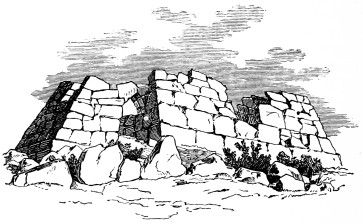
Fig. 124.—Pyramid of Kenchreæ.
A pyramidal form was only in isolated instances substituted for the tumulus. Of a pyramid, described by Pausanias as existing between Argos and Epidauros, there now remains a mass of masonry measuring 12 m. in the line of the diagonal. A second, near Kenchreæ, between Argos and Tegea, is better preserved. (Fig. 124.) Its plan is oblong, 14.5 m. long and nearly 12 m. broad; the two chambers of the interior are at present unroofed. The structure appears{187} to have served as a common place of sepulchre for the fallen, and, at the same time, as a memorial of victory. This destination is also evident in two further pyramidal remains, in Laconia and near Lessa, which are described by Curtius and by Ross. The Greeks adopted both Asiatic and Egyptian forms for their funeral monuments; but in the construction of both tumulus and pyramid they introduced comparatively large chambers, early striving for ends foreign to those despotic lands:—a wise economy of material and labor and a gain of space.
Mausoleums and sepulchres are always among the first traces of civilization, and the most ancient examples of architectural art. In Greece, however, there are contemporaneous remains significant of other purposes. Chief among these are the fortifications of towns, although in general these works enclosed only the acropolis, which contained the residences of the rulers and the sanctuaries of the people. The true age of these defences can by no means be surely determined. Not all Cyclopean masonry is to be attributed to the earliest ages of Hellenic antiquity, for this manner of polygonal jointing remained in use long after a time when cut and squared stones were generally employed. On the other hand, immense rectangular blocks, laid in horizontal courses, frequently occur in city walls which are known to be of the greatest antiquity and even to have been totally ruined in the historical period, such monoliths being regularly used upon corners, the jambs of gates, etc., where especial strength and independent firmness were called for. When the surface of Cyclopean walls is perfectly smooth and exactly jointed, these may confidently be regarded as not of primitive antiquity; the erection of such masonry is a subtlety of greater difficulty than that of square blocks and horizontal beds. But walls built of enormous boulders, unhewn, and roughly piled up without calculation, the larger interstices being filled with smaller stones, are of extreme age. Such masonry appeared to later generations to be the work of giants, of Cyclops, and hence a name which might more fittingly be changed to Pelasgic than to Poseidonic, as suggested by Gladstone. The walls of Tiryns (Fig. 125) are of such gigantic blocks—bulwarks mentioned by Homer and Hesiod, and admired in their ruins by Pausanias. They are built upon a ridge of rock, which is{188} over 190 m. long, only 70 m. broad, and elevated 10 m. above the surrounding plain. The masonry is from 7 to 15 m. thick; of its original height, estimated as 18 m., there remains from 10 to 12 m. The enormous stones vary from 2 to 3 m. in length and 0.9 to 12. m. in thickness. In its greatest breadth the wall is provided with galleries, roofed by projecting stones laid in horizontal beds and cut to the outline of a pointed arch. Such spaces are provided with loopholes upon the exterior, and, without doubt, served as magazines and casemates. Within these fortifications must have stood the royal residence, famed in the legends of Heracles and Eurystheus; of it no recognizable traces remain.
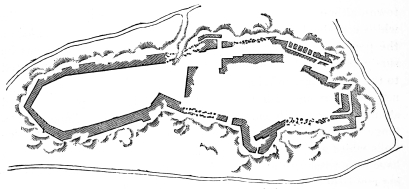
Fig. 125.—Plan of the Acropolis of Tiryns.
The walls of Mykenæ are not of equally gigantic masonry, but are fully as old, and are especially interesting because of the city having been a complete ruin in the earliest historical times. Besides casemate galleries in the walls, there are in Mykenæ a number of highly important gateways and portals; those of the fortifications at Tiryns were entirely destroyed, an inclined plane leading to the eastern side of the acropolis is there alone to be recognized as an approach.
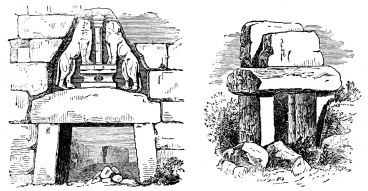
Fig. 126.—Gate of the Lions at Mykenæ.
Fig. 127.—Smaller Gate of Mykenæ.
The doors were naturally of greater technical perfection than the long line of bulwarks; having been created for both admittance and defence, they required a certain constructive calculation, and permitted the employment of more exterior ornament. The simplest possible form of a gateway is the combination of three stones—the two jambs and the lintel—observable in two examples at Mykenæ. (Figs.{189} 126 and 127.) Such a construction had the disadvantage that the upright blocks could not be joined to the wall, and that the lintel, which necessarily lay clear for a considerable length, could not immediately receive the massive continuation of the masonry above it. Notwithstanding the convergence of the jambs upon the great gate of Mykenæ, the beam has a length of 4.6 m., with a span of 3.05 m.; the bottom of the door being 3.2 m. wide, and its height 3.25 m. A relieving gable was consequently constructed, similar to that common in Egypt during the age of the Pyramids, and to that described in the consideration of the Tholos of Atreus. A triangular opening remained above the lintel, by which the efficacy of the wall as a fortification was considerably impaired. The orifice was closed by one or two slabs, which did not press heavily upon the lintel; but they could not have been sufficient to escape fracture by heavy missiles, or to resist the blows of a battering-ram. The attack was therefore diverted from this vulnerable point by moral means. The panel received a certain consecration by some protecting sacred symbol being carved upon it—such, for instance, as a Gorgon’s head—a recourse which was effective in times when the slightest desecration of a divine emblem was deemed more impious than the bloodiest deed of human violence. Such a carving has been preserved over the gateway of Mykenæ, which has received its name from the lions represented upon it. As a work of sculpture, it will be considered below. The column between the animals has, however, a bearing{190} upon the architectural forms of the epoch. It is the same shaft, diminishing from summit to base, which has been noticed upon the portal front of the Tholos of Atreus. A second gate of Mykenæ resembled the Gate of ºthe Lions, but was smaller and simpler. (Fig. 127.)
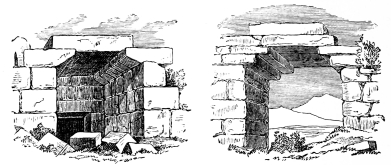
Fig. 128.—Portal upon Samos.
Fig. 129.—Gate of Phigalia.
The form of three blocks appears to have been soon changed, the wall itself serving in place of an especial jamb. The span of the lintel was decreased by two or four boldly projecting blocks as brackets. Examples of this development are offered by portals of Samos and Phigalia. (Figs. 128 and 129.) But in the same measure as the danger from the great span of the lintel was diminished, that of the brackets being pressed downward and disjointed was increased. A third manner of covering the opening, by stones leaned against each other at an angle, was a still further advance. (Fig. 130.) When the side thrust could be well borne—and for this the walls were always sufficient—such a gable could support any pressure that could possibly be imposed, while allowing a great breadth of passage. Finally, a triangular construction could be obtained by a gradual projection of horizontal stones, laid as they had been in so many instances for the relief of a lintel beneath them. This construction occurs in two varieties, differing in appearance, though not in principle: the projection of the horizontal courses of stone either began directly from the ground (Fig. 130), as has been noticed in the Tholos of Atreus (Fig. 122), or commenced at some height, the jambs being carried up vertically. (Fig. 132.) In both these varieties the line of the gable frequently appears concavely{191} curved, as in the parabolic walls of the tholos, and the outline of a pointed arch was thus obtained. (Figs. 133 and 134.) In spite of their early familiarity with the abstract principle of the arch, as shown in Fig. 130, the Greeks refused to adopt the true arch, with its wedge-shaped stones, even in late historical ages, when they assuredly were acquainted with its construction. An illustration of their feeling in this respect is given by the aqueduct adjoining the Tower of the Winds in Athens, where the semicircles are cut from monoliths.
The influence of the gateways upon the masonry is evident from the more frequent adoption of the rectangular blocks, which had at first only been employed to give the portals an independent strength, both for the ramparts and for the out-works and protecting towers which these openings necessitated. Such a fortification, erected for the defence of a gate, still stands in Tiryns—the city to which succeeding ages ascribed the invention of tower-building (Pliny, Hist. Nat. vii. 56); it reaches a height of 13 m. Thetower which defended the gate of Mykenæ was even larger. Homer mentions such structures at Troy, Thebes, and Calydon, and is also familiar with casemates and battlements. The latter are shown by paintings upon archaic vases to have been of the normal rectangular shape.
Schliemann’s excavations in Mykenæ have proved that in this city the agora was situated just within the principal gate. Some of the stone benches encircling the agora were found in almost perfect preservation; they were constructed of slabs standing erect in concentric rows to receive the horizontal seats. They lend a new confirmation of Homer’s truthful characterization of locality, illustrating a passage which occurs in the description of the shield{192} of Achilles, which describes the judgment scene upon the marketplace:
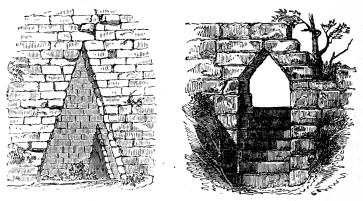
Fig. 131.—Gate of Missolonghi.
Fig. 132.—Gate of Messene.
Though the remains of these prehistoric ages show in some degree the form of an ancient Greek acropolis, with its royal dwelling of courts and halls, and the sepulchral monuments before its gates, they are yet insufficient to complete even the main outlines of the picture by giving any understanding of the temple—that structure destined to become the ideal of Hellenic architecture. While the life and customs contemporary with the Homeric poems are, in other respects, represented with incomparable truth and distinctness, the epics are entirely silent upon this subject. It appears that the temples were neither of great size nor of artistic importance; among the ruins of Tiryns and Mykenæ there are no vestiges of columns or entablatures. The symbolical images of the deities were placed upon cliffs, in caverns, among the branches of sacred trees, or in the hollows of their trunks, and simple altars were erected before them. Frequently the worship of a deity was merely connected with a grove, or with some other locality fitted by nature for this purpose, and was there performed without an image or other dead symbol. It was thus with the most primitive god of Greek mythology, Zeus of Dodona. When a building was provided at all, it was, in the heroic ages, restricted to the cella, a ceiled chapel of oblong{193} plan, which stood in the centre of a consecrated area, the temenos. This original form—the whole of the primitive shrine—is recognizable even in the developed peripteros, as the kernel within the outstanding columns. It does not appear strange that we should be acquainted with so few of these chapels when it is considered that hardly greater traces remain of the entire architecture of the Teutonic races during the first seven Christian centuries. It is natural, in the development of civilization, that sanctuaries exemplifying different phases of advancement should seldom stand next to each other; after the destruction of the old, the new arises in its place, upon its consecrated site. Examples of such original cellas are not, however, entirely wanting. Several remains published by Dodwell and Stackelberg are to be explained as chapels. A structure upon Delos, designated by Thiersch as a tomb, is quite comparable to a columnless temple cella. There is less probability that the ruins upon Mount Ocha and near the village Stoura, upon Eubœa, were temples. They are chambers sheltered from above by slabs of stone, inclined like a gable. (Fig. 135.)
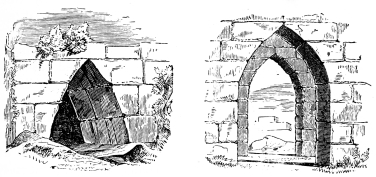
Fig. 133.—Gate of Thoricos.
Fig. 134.—Gate of Ephesos.
This method of roofing could not have been generally practised in early times, when simple and natural constructions utilized the materials at hand best adapted to the purpose. The builders, among the bald mountains of Eubœa, were forced to such a manner of covering their chamber by lack of wood. The south of the island produces no trees which could provide the timber for roof-beams; while, on the other hand, open quarries in the neighborhood{194} furnished a kind of slate-stone which is easily split into large slabs like joists and boards. So clumsy a ceiling construction as that upon Mount Ocha was not natural in countries of dense forests, such as was the original home of the Dorians. In other parts of Hellas than the rocky and sterile islands of the Ægean, the chapels must have been roofed with wood. The most obvious considerations make it evident that ceiling and roof of the primitive cella were originally of wood. In the later marble architecture of Greece this assumption is confirmed by numerous reminiscences of timbered construction, sufficient even to explain the methods and form of the original carpentry.
A pitched and gabled roof seems to have been generally employed for these early structures. The horizontal ceiling might be sufficient for the changeless blue sky of Egypt, but could not suffice in Greece, where, in certain seasons, heavy rains were frequent, and even hail-storms not unknown. Still no land upon the Mediterranean was familiar with the great steepness of roof made necessary by the enduring snow and ice of the North. In colder climates the pitch of the covering was not only greatly increased, but all horizontal projections were avoided, and the upper surfaces of smaller members and mouldings inclined. The rafters required ceiling beams beneath them; because of the necessary support and jointing, they could not be placed directly upon the stone walls, and it was further desirable to support the summit of the triangle by a king-post. The ceiling thus provided stood in such relation to the roof that a beam tied together each pair of rafters, and was, consequently, so laid across the oblong enclosure that the ends reposed upon the side walls. Upon these horizontal timbers planks were placed which concealed the inclined roof. By this an independent ceiling{195} was created; and, as the boarding was laid upon the beams and not fastened to their lower side, this gave rise to the formation of lacunæ or long coffers. The ends both of the horizontal ceiling beams and of the roof rafters were visible upon the exterior: the latter, forming the eaves, projected beyond the wall, to further the shedding of water and to protect the sides of the building. As the upper surface of the roof had been so closed as to be water-tight, it is natural that this sheathing should have been carried around upon all sides of the projecting rafter ends. It was otherwise with the spaces between the beams, which, being protected by the eaves, were not covered and masked by boards. The artistic instinct of the Greek would not permit him thus to conceal constructive forms when this was not rendered necessary by practical considerations. They received, on the contrary, an especial emphasis, that they might express their peculiar function with full force. Moreover, the closing of the aperture between the ends of the beams would have required the provision of other openings for light, as there were no windows in the walls of masonry.
This manner of roof and ceiling construction was generally employed in European Greece, being customary for palaces and dwellings as well as for the primitive temples. Open interstices between the horizontal beams existed in the hall of the royal dwelling at Ithaca. There can be no further doubt as to the development and original function of the metopes of the Doric entablature when it is considered that the Greeks, as late as the time of Euripides (Iphig. in Taur. 113), were familiar with the idea that it was possible to enter a primitive structure through these openings between the ends of the beams. The masking of the metopes would thus have been not only purposeless, but even detrimental; it was reasonable, however, to sheathe the ends of the beams themselves by small boards, which should at once protect and ornament them. The hewn extremities of such great timbers were rough and ugly; without covering, they would have been exposed to rapid decay. The simple decoration of three narrow strips of wood affixed to the ends of the beams was so customary in primitive carpentry that it became a typical motive in the later architecture of Greece. The chamfering of sharp edges of boards has been practised by the wood-workers of all nations.{196} When two corners thus treated are placed together, there results a prismatic groove, which distinctly marks the edges of the separate pieces. Thus originated the primitive form of the triglyph, as the most natural and practical decoration of the rough-hewn ends of the ceiling beams by sheathing. The upper edges of the three strips were hidden against a plate beneath the rafters; the lower were covered by a continuous board, which united the various members of the frieze, and concealed any inexact jointing between the beams and the top of the wall. By placing the chamfered boards upright, an æsthetic advantage was obtained: a vertical line was repeated just before the conclusion of the entablature by the cornice, being thus emphasized in the midst of horizontal members. Other ornamental details were added, based, likewise, upon motives of the original wooden construction. The continuous strip affixed to the lower edges of the triglyphs was securely and visibly fastened. This was effected by several thick trunnels, so driven in from below that the heads were left protruding. Under the end of each beam the strip was doubled, to give additional strength where the wood was most weakened by perforation. The ends of the rafters were also sheathed, and brought into harmony with the frieze. The inclined eaves were covered with boards, and as these did not stand erect, like those before the ceiling beams, but hung from the lower sides of the rafters, there was particular need for an increased and distinctly secure attachment. The sheathing was consequently pinned by more numerous trunnels; and as every triglyph had been provided with a second strip, here a second board was placed under the end of each rafter. The projecting heads of these nails were called guttæ by the later Romans, but this cannot convince us that the peculiar form was intended as an ornamental petrifaction of hanging rain-drops: such a glorification of bad weather would have been foreign to the Greeks, accustomed to the clearest skies; and, for so primitive a construction, this explanation appears far-fetched. The imitation of rain-drops could nowhere have been more out of place than upon the inclined lower side of the eaves; drops might, perhaps, hang from the front edge of the cornice, but never upon its under slope, which rain could not even wet. The construction of an original work of carpentry thus provided{197} the motives of the Doric entablature—naïvely expressing the advance from the roughest practical necessity to high architectural perfection. In the apertures between the beam-ends, or metopes, and in the open triangle of the gable, were placed votive offerings, which there found a secure and sheltered stand, heightening the exterior importance of the work. In small chapels this interference with the openings for light could have been of no disadvantage. The gable was closed by a boarding, which hid from view the rough inner construction of the roof. This veil, the tympanon, was placed behind the triangle formed by the outer cross-beam and rafters, as the ceiling had been laid above the other horizontal timbers. The low gable thus naturally developed upon the front; and in later times, when the votive offerings had been exchanged for sculptured figures, formed a most characteristic and imposing feature.
The effect was heightened by the partly protective, partly decorative, painting of all the wooden surfaces. Red and blue appear originally to have been the chief colors; the former, in a dark shade, being used for the sheathing of the tympanon, the latter for the triglyphs and other members. Upon the bands were figured ornaments, most of which had developed from Asiatic prototypes; they consisted of the meander, anthemions, and the woven ribbons, etc., observable upon Assyrian sculptures and upon the archaic bronzes and vases of Greece and Central Italy. The extended polychromatic treatment of the marble temple is doubtless a reminiscence of this painted wood. Without such traditions, it would have developed differently: upon a structure of stone it would have been less restricted to the frieze and cornice.
The entablature had thus far advanced without connection with that most noble work of architecture—the Doric column. The shaft and entablature of the style were not created in connection or simultaneously; the forms of triglyph and mutule are not a growth from the columnar root, but rather prove the Doric frieze and cornice to have been the primitive Hellenic expression of roof and ceiling, which preceded the column, even as the plainest constructive necessities precede ornament. The peculiar wooden character of the entablature could exercise no important influence upon the shaft. If the existence, in heroic times, of the peripteros, the temple with{198} outstanding columns, be denied—and of such structures there is not a vestige—it cannot be supposed that columns existed at all. Interior supports of wood are, indeed, mentioned by Homer, and engaged shafts formed part of the façade of the Tholos of Atreus, and were represented upon the relief over the Gate of the Lions in Mykenæ; but between these and the Doric column there is a distance only to be explained by the assumption that Asiatic influence was paramount, if not exclusive, in the architecture of the heroic ages of Greece. Though it is possible that rudiments of the Doric echinos may be recognized in the upper tore and scotia of the engaged columns of Mykenæ, it is yet evident that the turned-work of these members resulted from a wooden prototype, and that the overladen decoration of the shaft, in its style, is due to familiarity with a sheeting of beaten metal—i.e., to Phœnician artistic traditions. That the forms of the entablature were not created for the peripteros appears from the circumstance that the metopes lose their value as windows by the change of plan, and leave the cella without openings for light and air when surrounded by columns. With the appearance of the peripteral temple, the Doric entablature, which upon the oblong chapel had been the natural expression upon the exterior of roof and ceiling construction, became a functionless ornament, needing, as will be seen, many changes to bring it into harmony with the outstanding colonnade.
The development of the Doric column is not perfectly clear; it is more than probable that it was not wholly autochthonic and primitive Greek, like the entablature of the style. Its principal part, the shaft, was certainly imported. No prominent architectural feature can be deemed newly invented that has been in common usage in a neighboring and accessible country for centuries. The Doric shaft, with its characteristic diminution and channellings, was known in Egypt more than a thousand years before its introduction into Greece, as proved by the monuments of Beni-Hassan. Commercial intercourse had existed between the two countries for centuries, and it cannot be assumed that the Greeks had not seen Egyptian works of architecture; they could not have arrived at precisely the same results by independent invention. It would rather be difficult to conceive how the receptive Greeks could have refused all instruction{199} from the neighboring people, so far in advance of them for centuries after the Trojan war. Eight-sided drums have been found at Bolymnos, and an octangular shaft at Trœzen; but these isolated instances offer no proof that the development of the channelled shaft from the square pier was effected in Greece in the same manner as had been done fifteen centuries or more previously in Egypt.
The genius of the Greeks, however, always showed its independence when the artistic perception of the neighboring nations had been at fault or defective. It was impossible for them to rest content with the termination of the so-called Proto-Doric columns of Beni-Hassan. A simple plinth upon the upper end of the shaft was insufficient; it left without mediation the contrast between the forcible upright line of the channels and the long level of the epistyle. Some interposition was necessary between the vertical and the horizontal members, and a moulding of inclined outline was best fitted to fulfil this natural requirement, which almost appears to be an æsthetic law. The abacus plinth was retained as the transition from the circular drums of the shaft to the broader oblong of the lintel. The oblique and projecting member between the two, the echinos, was a link connecting the plans, as well as the directions, of column and entablature. The perfectly straight outline of an inverted cone was rarely employed in Greece for the echinos; a stele of Artemis Brauronia upon the Athenian acropolis, shown by inscriptions to be of great age, is an isolated instance. This rigid line was early exchanged for a curve, which, in its advancing stages of refinement, became one of the most characteristic features of Doric architecture. The moulding seems, at times, to have been ornamented with painted leaves, which, in the Ionic echinos beneath the roll, was changed, in the manner peculiar to that order, from the colored indication to carving. It is not certain whether this floral decoration was generally adopted, or existed only in the isolated instance by which it is known—the so-called Temple of Theseus. Upon the translation of the wooden construction to a stone entablature, which resulted in a narrow intercolumniation, the base was given up, and the upper step of the stylobate was regarded as a common plinth.
It appears that the employment of columns connected with{200} temples commenced, in Greece, in the manner observed upon the rock-cut tomb façades of Egypt and Lycia, and the chapels of Mesopotamia and Phœnicia: two columns were placed within the open front, between the projecting side walls; that is to say, the temple was in antis.
The next step was the removal of these side walls, or parastadæ, columns taking their place in the corners before them, and the prostyle temple was thus obtained. These changes rendered several important alterations necessary. They caused a new wall to be erected before the interior of the cella, the naos, the colonnade of the front thus acquiring the nature of a portico, the pronaos. The jambs of the door in this wall were so inclined as to diminish the span of the lintel, the frame receiving upon its upper corners the stepped ears, or parotides, customary in Western Asia. A new member of the entablature was needed to replace the omitted wall and provide a bearing for the ceiling cross-beams—namely, the epistyle. It is possible that this member, distinctly separated, existed before the change, but it certainly was not necessary. The division of the cella into naos and pronaos finally altered the position of the front ceiling-beams; in the naos they lay, as before, resting upon the side walls, but in the pronaos they were placed lengthwise—from the columns to the newly erected division wall. Besides improving the construction of the portico ceiling, this greatly added to the beauty of the front entablature: epistyle and ceiling-beams would otherwise have lain upon each other, in the same direction, but from this change resulted the frieze of triglyphs and metopes upon the front, as upon the sides. The gain was not effected without a difficulty arising in the frieze above the end of the side wall and the corner column, the outer ceiling-beam of the pronaos thus lying in its length upon the epistyle without the formation of a metope. And here the constructive truth was first sacrificed in favor of the exterior appearance: a cube, standing above the corner column, took the place of the outer beam, and the continuous alternation of triglyphs and metopes was carried out.
Having so far deviated from logical construction, the desire for an harmonious treatment of the exterior led to other and greater changes. The dead-wall of the rear had had no part in the{201} development of the frieze, and appeared intolerably bare. This deficiency could hardly be overcome otherwise than by a repetition of a portico upon the back, creating the epinaos, and carrying the entablature of triglyphs and metopes around the entire building, thus perfecting the amphiprostyle temple.
The more these alterations were made in favor of the exterior appearance, the more was the original structure dismembered. The extreme boundary of possible concessions was attained, and, at the next step, the entablature, translated into stone, separated itself entirely from the construction and became an applied ornament. In one stride the ultimate type of the Hellenic temple was determined, by carrying outstanding columns entirely around the cella,—the building became a peripteros.
It is probable that these extensive alterations took place almost simultaneously, and were adopted at once for the most prominent shrines, while the preceding varieties—the temple in antis and the prostyle and amphiprostyle temples—though their entablatures were also executed in stone, were only employed in subordinate positions. With the heightened importance of the decorative exterior the monumental significance of the temple rose above the mere necessities of a chamber for the sacred image. The structure acquired equal solidity in every part exposed to view. It was built of a homogeneous material. The timbering of roof and ceiling was hidden by the stone symbols placed before the ends of the rafters and beams; the entablature was allowed an independent freedom of development and proportion. The heaviness of the material made it necessary to diminish the voids and increase the solids of the supports as much as was feasible. The stone shafts were allowed a greater diameter and placed more nearly together than when, as was the case in Etruria at a much later period, their burden had been of timber. The stone cornice, which was not as high as the epistyle, could not span the same clear width, and called for a second support over the intercolumniations,—a further triglyph. This was the more acceptable, as the appearance of the frieze was improved by its adoption; the breadth of triglyph and metope became nearly equal and better proportioned, their alternating rhythm more pleasing. The metopes, having upon the peripteros no importance as{202} windows, were closed by thin slabs, which added to the unity and imposing force of the edifice. It is surprising how faithfully the traditional forms were still retained, even to the smallest details, while they yet received a truly artistic conventionalization and those proportions which make the Doric temple the grandest and most perfect monument of architectural history. It is probable that the completed peripteros existed as early as the seventh century B.C. The first steps of advance were rapidly made, and may, perhaps, be referred to the ages immediately preceding. It would indeed be interesting to know when, where, and by whom the incomparable design was perfected which gave to the world its proudest edifice; but it must suffice to understand the intentions of which the Doric temple was the final result.
Semper has suggested that a canopy-like roof, supported by columns, was placed above and around the small temple cella to increase its extent, and, at the same time, to express its power and sacredness by that oldest symbol of terrestrial and celestial authority. This attractive assumption does not interfere with the theory of the previous development of the temple in antis and the prostylos, or with the historical considerations based upon the appearance of an imperfect peripteros centuries before in Egypt. The cella and outstanding columns rose from a stepped foundation, the crepidoma, the kernel of which, the stereobate, was formed of massive walls, or, when possible, of the native rock. The blocks were too high for human steps, and are not to be conceived as stairs. Such an ascent entirely surrounding the temple would have been purposeless, and contrary to the isolating character of the crepidoma. They formed a base, such as is displayed in an exaggerated manner by the Mesopotamian sanctuaries, where, however, the chapels elevated upon the gigantic terraces were small in proportion to the substructure. In buildings of greater dimensions, the few and massive steps serving as the base of the Greek temple were increased, not in number, but in size. They were thus always proportional and fitted to their function as a foundation. Accessible stairs from all sides would have given a pyramidal effect to the lower part of the composition; while, at the foot of the upright supports, the horizontal line should rather be emphatically pronounced. Smaller intermediate{203} blocks were provided for the ascent to the temple, thus made possible only upon the front. The upper step, the stylobate, was, as has been said, the common plinth, the columns being without base-moulding, and, consequently, without individual functions or isolated independence. The comparatively narrow intercolumniations were the better passages from this absence of projections at the foot of the columns. The powerful shafts were doubly modified by the diminution and by the entasis. The first refinement found its model in the natural contraction of all ascending bodies; a greater strength is needed below because of the increasing weight. To this must be added an optical motive: every diminution modifies the perspective effect, increasing{204} the apparent height or distance of bodies thus bordered by lines slightly converging, though apparently parallel. The entasis was entirely decided by such optical considerations. It overcame a deception, resulting from the diminution, which makes a straight-lined cone of very steep sides appear of slightly concave outline. The shafts usually had twenty, in a few instances sixteen, channels, of nearly elliptical profile, separated by sharp arrises. As may be seen in unfinished temples, these grooves were not executed until the last stone of the building was in place, that the chipping of the delicate edges by the imposition of the drums or blocks next to them, and by other accidents during the process of building, might be avoided. It was only upon the capital that the channels were cut in advance, as a guide. To avoid the chipping of this stone, it was necessary to prevent its sharp lower edges from resting directly upon the top of the drum beneath it. To this end a diminutive step, a scamillus of smaller diameter, was turned upon the bottom of the capital block, or the same effect was attained by slightly slanting off and increasing the right angle of its lower edge. It was contrary to the artistic feeling of the Greek architect for constructive truth to mask even this slight necessity by priming and painting. It was, rather, made more distinct by increased size and a characteristic profile, in some instances even by a repetition of the incision. The upper end of the shaft was thus distinctly separated, notwithstanding the continuous channellings, and was related to the capital as the mediating neck of the column, the hypotrachelion. The echinos began its projection with several annulets, which still more definitely marked the junction of the capital with the shaft. It would be difficult to decide whether these mouldings were reminiscences of the binding-ribbons upon the necking of Egyptian floral columns. They were not placed beneath the echinos, but upon it, and consequently follow the curved profile, enlarging concentrically with its projection. The Doric capital, among all capitals that we know, attains the highest æsthetic perfection by its fulfilment of the requirements of a transitional member: by the proportion of its projection, and especially by its expressive and characteristic curve, which rises from a firm and almost straight line to the decided turn beneath the abacus. The outline{205} is more elastic than a simple oblique angle, more vigorous and capable of resistance than the concave curve. The echinos provides the requisite projection; the abacus upon it forms the second transition from the circular plan of the shaft to the rectangle of the entablature. In the Doric style this upper half is about the same height as the echinos beneath it, while in the capitals of other orders the curved members of circular plan have been developed at the expense of this plinth, which is dwarfed to a thin plate.
It was first noticed by Cockerell in 1829 that the axes of the columns surrounding the cella are not vertical, but lean inward. This peculiarity was chiefly adopted to counteract an optical deception, resulting, like the deviation which led to the entasis, from the diminution of the shafts, making these, when perfectly upright, appear inclined away from the neighboring wall and from each other. The deception is particularly felt upon the corner shafts; these were corrected to lean in the direction of the diagonal, and decided the inclination of the columns of the front and side. The absolute deviation from the vertical is very slight, about 1-150th of the height, and by no means makes the inner sides of the diminished columns parallel to the wall. The inclination was effected by the irregular cutting of the first block, which was lower within than without, being so formed that the surface of its base was not circular, but slightly elliptical. All the succeeding drums had perfectly round beds, and consequently slanted in the manner decided by the first. The contact of these stones of the shaft was restricted to a narrow rim upon the exterior of their plan. In their centre they were steadied by an encased dowel of wood, the form of which is known from the remains of the Parthenon; this served as a pivot for the grinding of one block upon the other.
The stone beams of the epistyle lay from axis to axis of the columns. In buildings of great dimensions several slabs were laid side by side as lintels, each having the entire height of this member, which, as forming the conjunction of the columns, may be conceived as a representative of the wall. The outer surface of the epistyle block was carved upon its upper edge with the tainia and trunnels, described as securing the triglyphs of the original timbered entablature. The forms of these details show the great reverence with{206} which the primitive wooden prototypes were imitated, while, at the same time, they were fitted to be cut in stone in a far more artistic manner than were the direct copies of carpentry observed in Lycia. The slits of the triglyph terminated at first in elliptical lines, which became, in the decline of the style, straight and horizontal. The triglyphs themselves were so distributed that one was placed over each column and one over the centre of each intercolumniation. An exception was made at the corner, where the triglyph could not be placed in the axis of the shaft, being needed for the support of the angle. It would be contrary to the open and non-sustaining character of the metope for this to be assigned to a position so constructively important. Vitruvius, regardless of this consideration, recommends that the corner triglyph be placed in the axis of the column beneath it, like all the others; but only one debased instance is known where this occurs—the so-called Temple of Demeter at Pœstum. The disturbance of symmetry which resulted to the frieze by the removal of the corner triglyph from the axis was counterbalanced by the metopes being made slightly larger, and especially by the outer intercolumniations being greatly diminished in width. This last step was also desirable from other considerations, notably because the dark background of the cella caused the openings between the inner shafts to appear narrower than the free and light space between those of the exterior.
All these changes were primarily caused by the Doric entablature not having been created for the peripteros; it was necessary thus to fit it for decorative employment.
The metopes were originally open interstices between the beams; intertrabies, as they might be called, with reference to the intercolumniations; having, upon the peripteros, been closed within and without by light slabs, the votive offerings, formerly placed in the apertures, were now superseded by sculptures in relief upon these stones, which gave to the entire entablature—or, when the carving was restricted, to that of the fronts—an imposing decoration. A continuous band, like that beneath the triglyphs, terminated the frieze; but the individuality of triglyph and metope was even here maintained, the superposed member being broken around them, as a separate coronation for each.
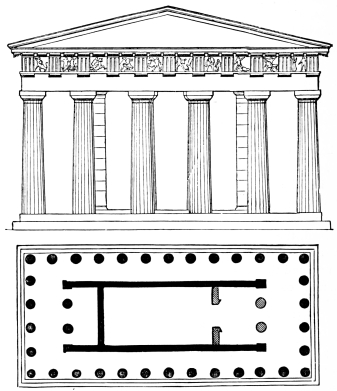
Fig. 139.—Plan and Elevation of the so-called Temple of
Theseus, Athens.
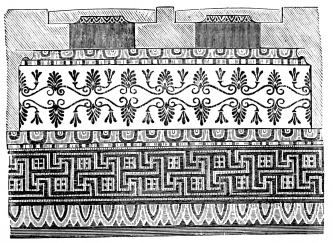
Fig. 140.—Painting upon the Pteroma of the Temple of
Theseus.
The cornice showed reminiscences of the projecting eaves by its corona being cut with a downward slant, such as would never have been invented for the treatment of stone. That this inclination was not precisely the same as the pitch of the roof rafters cannot be adduced as an argument against its fundamental idea; in the marble structure there was nothing to call for so exact a resemblance. The decoration of the lower surface of the corona shows the original motive of its wooden construction as distinctly expressed as was the formation of the triglyph in the frieze. The position of the ends of the{208} rafters, beneath the sheathing, is marked by boards, each being pinned upon it with eighteen wooden pegs. From the duplication of the triglyphs in the stone building there resulted an equal number of mutules, and these were still further multiplied by being placed over each metope—this latter increase having been at first attempted with members of half the normal width, as at Fig. 136. The whole composition was thus the more richly divided the higher the building ascended; upon one column rested two triglyphs and four mutules. It is further remarkable that, to make the decoration harmonious upon all sides of the edifice, these mutules were also introduced upon the front and rear entablatures; this repetition, with the inclination of the corona upon the fronts, naturally without a{209} gutter, must be regarded as a further concession, made, contrary to the genetic signification of members, in favor of the monumental appearance of the entire exterior. The corona is bordered by the so-called Doric cyma, or beak-moulding, distantly resembling the scotia of Egypt and Mesopotamia. The concluding gutter is of a beautifully curved outline. When it occurs upon the sides of the building, where it is frequently restricted to the corners, it is provided with lions’ heads, which, arranged over the columns as gargoyles, throw from their open jaws the rain-water of the roof beyond the steps of the crepidoma. An isolated instance—the Heraion of Olympia, which seems never to have been provided with a stone entablature—shows that the timbered roof and ceiling were placed at times with a wooden epistyle directly upon the stone columns of a peripteros. The covering of the roof was formed, in the best period, by flat marble tiles, the joints of which were covered by smaller curved blocks, running from ridge to eaves, and terminated over the cornice by antefixes. The apex and corners of the gable were provided with acroteria, standing upon special bases. They are reminiscences of an ancient usage of Western Asia: those of the corners found their origin in the ornaments of primitive altars and sarcophagi, known in Biblical accounts as horns. They were sometimes{210} supplanted by votive offerings suited to the position, such as tripods, or by griffins and other symbolical figures. The pointed acroterium of the apex was usually the whole of the two half-anthemions represented upon those of the corners; in larger monuments it was often replaced by statues, just as extended compositions of figures were created for the tympanon beneath, as a substitute for the dedicated objects which appear to have originally filled the gable.
The polychromy of the Doric temple was one of the most important features of its external appearance. It is probable that the greater part of its marble surface, possibly the whole, was colored. Our Northern conceptions can with difficulty comprehend the full value of this treatment in the general composition; in our gray landscape, a building thus painted might appear harsh and variegated. The color of the lower supporting members was restricted to a light tint, the so-called baphe, which had first been applied to the stucco priming necessary for the coarse and porous stone of older temples, and was afterwards transferred from this to the marble of later monuments. It stained the surface with a light golden-brown tint, moderating the harsh chalky white of lime stucco, or of marble, and investing the newly erected building with the patina by which age always modulates the color of stone. This baphe was employed for the marble temple on account of the traditional painting of the stucco priming, because of the too dazzling white natural to the freshly hewn material, and, finally, in order to harmonize the columns and stylobate with the intensely rich colors of the entablature. Dark and positive pigments were restricted to the frieze and cornice, having, without doubt, been first employed to preserve the original wooden material. The beams and slat-work, like the triglyphs with their regulas and the mutules, were designated by blue; the trunnels were red or gilded. That which had at first been open was treated as a dark-red background; the metopes and tympanon thus clearly outlining the reliefs and groups of statues which ornamented them. The continuous members were treated with particular richness; the narrower strips were painted with the meander and other woven forms; the gutter with anthemions; while the Doric cyma was decorated with leaves of various colors, so artistically conventionalized{211} as but little to resemble nature. The inner side of the entablature was still more richly colored. (Fig. 140.)
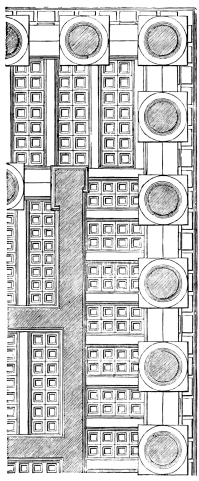
One of the most wonderful refinements of Greek architecture was the attention paid to optical deceptions, and the correction of these by the curvature of all straight and horizontal lines. It has been mentioned that the peripteral columns did not stand mathematically upright, all the axes being inclined inwards; the discovery of this fact was followed by a publication, made by the architect Hoffer in 1838, which maintained that no perfectly level line existed upon the entire temple, the horizontals being curved slightly upwards. Hoffer’s assertions were verified by the micrometrical studies made by Penrose, in 1846, upon the Parthenon, the so-called Theseion, the Propylæa, Erechtheion, and the Temple of Olympian Zeus in Athens, and afterwards upon the temples of Nemea and Segesta. His measurements make evident a curvature of 0.069 m. in 30.876 m. upon the front of the Parthenon, and of 0.108 m. in 69.525 m. upon its sides. Though so very slight a deviation is not readily apparent, there are no mathematically rectangular forms upon the entire building; the corner metopes are, for instance, trapezoidal. Whether these curves, the existence of which is not to be denied, were{212} really intentional, was questioned by Boetticher, but it has been proved beyond a doubt by the further investigations of Ziller. The motive for the adoption of refinements, so extraordinarily delicate and difficult of execution, was the same desire to correct displeasing optical deceptions which prompted the entasis of the columns and the inclination of their axes from the vertical. The apparent deviation of the lines, sagging from the horizontal, was most disagreeably apparent upon the front entablature—the base of the gable triangle, which, when straight, invariably appears concave, while a corona, in reality curved upwards, presents itself to the eye as perfectly level. By a deviation from the absolutely horizontal, the appearance of greater correctness was attained.
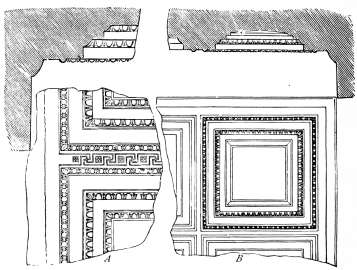
Fig. 142.—Fragments of Coffered Ceilings from the
Parthenon.
A. From the Side Pteroma. B. From the Epinaos.
The peripteral columns of the Doric style worthily express the peculiar character of the Dorians by their simple dignity. By them a passage was formed around the cella, the pteroma, the ceiling of which was most richly decorated with cofferings. (Fig. 141.) So short a span was here required of the horizontal beams that it was possible to translate them into stone simultaneously with the outer entablature; this seems to have been universal in the larger peripteral{213} temples, that of Zeus in Olympia possibly being an exception. The ceiling did not remain in its original position, resting upon the epistyle, but, with the increased dimensions of the stone frieze, was considerably elevated. The spaces between the lintels were closed by slabs of stone which retained the form of the original wooden cofferings, being hollowed by stepped lacunæ, diminishing in size. A transitional moulding was placed in each angle formed by a vertical and horizontal surface. Upon the coffered ceilings of Attic monuments (Fig. 142) this member is the Lesbian cyma, supplemented by an astragal, these signs of an Ionic influence being further noticeable in other parts of these buildings. The wall of the cella, though surrounded by the pteroma, still bears traces of the entablature, which, as shown above, preceded the outstanding columns; the triglyphs and metopes are repeated, or in their place is a frieze of sculptured reliefs, in which the isolated carvings of the metope become continuous and connected. At times there remain beneath the latter the tænia, regulas, and trunnels—only to be explained and justified as the reminiscences of portions of an originally well-founded decoration which had, in part, been gradually supplanted.
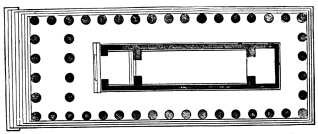
Fig. 143.—Plan of the Middle Temple upon the Acropolis
of Selinous.
The cella itself, within the pteroma, appears in plan either without columns, as a temple in antis, as a prostylos, or as an amphiprostylos, thus supporting the assumption that these were the original forms of its development. The cella was often greatly increased in length; this made its transverse division desirable, and there resulted the front portico, or pronaos, the principal hall of the temple, or naos, and the space partitioned off at the rear, called, analogically, the epinaos. An especial chamber of the building was at{214} times isolated to serve as a treasury; this was known as the opisthodomos. (Fig. 143.) The pronaos, whether with or without columns, was closed, if at all, only by a light bronze grating; from it a wide portal, occupying almost the entire division wall, opened into the naos. Its upper part was fixed, but entrance was afforded through its lower part by folding wings. The grooves worn by the doors are still visible upon the Parthenon floor. The interior was disproportionately narrow, a result of the peripteral enclosure and of the limitations imposed by the gable, which would have become too high and heavy if the front had been greatly widened in favor of the interior breadth; moreover, the horizontal ceiling was unfavorable to width, which was limited to the natural span of the beams.
The possibility of admitting much light had been given up with the change in the position of the entablature and metopes. Notwithstanding the size of the door, sufficient daylight could not enter through this; it was itself in the shadow of the pteroma, and generally, also, of a pronaos. But little illumination was required for the small chapel when this served solely as a receptacle for the sacred image. A dim and mystical twilight was easily obtained by the use of one or more perpetually burning lamps, which could only have been favorable to the artistically unpretentious interior. It was otherwise with the larger and more important temples, opened for festive assemblages. Their interiors were divided by architectural members, and contained manifold works of art and objects of value—a varied richness, which called for an increased splendor of light, possible only by artificial illumination.[G]
In the desire to increase the available space of the temple interior, the enclosing walls were advanced more closely to the columns of the peripteros, thus decreasing the width of the pteroma; while the hall was divided by two rows of inner shafts into three aisles, the outer two of which, considerably narrower than the middle, were{215} partitioned into two stories by the introduction of galleries, accessible by staircases at either side of the chief portal.
We now turn from this general consideration of the Doric style to a review of the principal monuments remaining, dividing them, as well as possible, into groups representative of certain ages and periods of development. The oldest peripteral temples known are not situated in Greece proper, but in the early colonies upon the coasts of Magna Græcia and Sicily. They are distinguishable from later buildings by a naïve freedom of form and the lack of any strictly systematical development—any canonical type. The carving of details is as careful as the coarse and porous limestone permits. The columns stand so far apart that the low and heavy proportion of the whole is not altered by the comparatively high stylobate. The great distance of the shafts from the wall reduces the naos to a corridor-like narrowness, the more noticeable as the whole temple plan is very long. (Fig. 143.) The columns themselves are low, never having a height greater than five lower diameters. The monolithic shaft is much diminished, and has an excessive entasis; it is provided with twenty, or in rare instances sixteen, channels of segmental outline. The incisions beneath the capital block, bordering the hypotrachelion, are generally multiplied, often being three in number. The necking upon the columns of Sicilian temples is not merely the straight commencement of the channellings, but often forms, under the rings, a slight scotia—the apophyge—which weakly detaches the echinos from the shaft by interrupting its organic connection. The echinos has too great a projection; its outline is soft, and the small rings are placed too high. The entire capital appears powerless and flat: on this account the thickness of the entablature has not been increased; the outer and inner surfaces of the epistyle do not project beyond the upper diameter of the shaft. The members of the entablature are exceedingly high and heavy, as are the details, down to the trunnels and cyma. The frieze alone is low, and the metopes consequently small, being framed by massive triglyphs, the chamferings of which have circular or lanceolate endings. The mutules above the triglyphs have the same great breadth; in one instance there remains above the metope only space for half a mutule. (Fig. 136.) The polychromy is, in general,{216} sombre—yellow-brown and black, with little red, being the colors chiefly employed; the patterns of the ornaments are distinctly of Oriental origin.
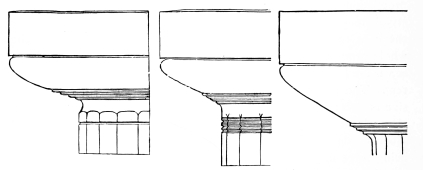
Fig. 144.—Northern Temple upon the Acropolis of
Selinous.
Fig. 145.—Middle Temple upon the Acropolis of Selinous.
Fig. 146.—Temple of Assos.
The most prominent monuments of this class are at Selinous, upon the western extremity of Sicily. That city was founded in 628 B.C.: its acropolis appears to have been early occupied by temples; at least the northernmost of these buildings, with the widest intercolumniations, of two and two thirds lower diameter, and the most spacious pteroma, dates from the commencement of the sixth century B.C. The middle temple of the acropolis appears scarcely fifty years younger; it is celebrated for the primitive reliefs of its metopes, which will be considered in the section upon Greek sculpture. A corner of the building is given above, Fig. 136; its capital is Fig. 145. A third example of this earliest period of development—which is designated by Semper as the laxly archaic style—is known under the name Tavola dei Palladini, and stands among the ruins of the Elian colony, Metapontion, a city founded as early as 768 B.C., but entirely rebuilt in 586 B.C., after its destruction by the original inhabitants of Lower Italy. The fifteen columns at present upright probably date from the sixth century B.C. The intercolumniations are wide, the shafts excessively diminished, and the curve of the echinos too pronounced. It is difficult to decide whether to this class may belong the remains of the temple at Cadacchio upon Corfu (Corkyra), and of that built of lava at Assos, in the Troad. (Fig. 146.){217} The former has been greatly disfigured by a late restoration, and it is not at present possible to determine the date of the latter, known only by insufficient publications.
The next advances of temple architecture consist in placing the higher columns more nearly together and in heightening and narrowing the triglyphs. The elegance of proportion and detail was thus considerably increased. Ionic elements were first introduced in this period, greatly to the advantage of the style, which is designated as the archaic. An example is the middle temple upon the eastern plateau of Selinous, where the columns are cut with Ionic flutes. It is also important in the history of sculpture from the remains of metopes carved with scenes of the gigantomachia. (Fig. 147.) Of similar character is the great uncompleted Temple of Zeus upon the same plateau, 110 m. long and 50 m. broad, with three aisles and galleries in the interior (Fig. 148); and also the so-called Chiesa di Sansone at Metapontion, of which small temple there are only few and scattered remains. A third Doric temple of this site, discovered during the last few months, is as yet inedited. It is uncertain whether the Temple of Artemis upon the island of Syracuse (Ortygia) should be reckoned with this group.
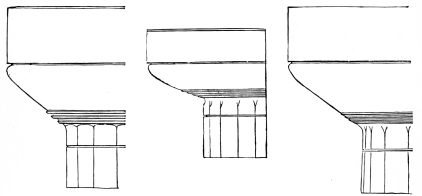
Fig. 147.—Middle Temple upon the Eastern Plateau of
Selinous.
Fig. 148.—Temple of Zeus upon the Eastern Plateau of
Selinous.
Fig. 149.—So-called Temple of Heracles, Acragas.
One example of the epoch exists in Greece proper—the Temple of Corinth. Its columns were once heavily primed with stucco, and{218} are now so weathered that it is impossible to draw any definite conclusions from them. The outline of the capital is primitive, though not in the degree formerly supposed, when this ruin was thought to be the oldest monument of the Doric style. The two last-mentioned remains and the Temple of Athene upon the island Ortygia have the heaviest and lowest proportions, the lower diameter of the columns comparing to the height as 1 to 4.27 (Athene), 1 to 4.29 (Artemis), and 1 to 4.32 (Corinth).
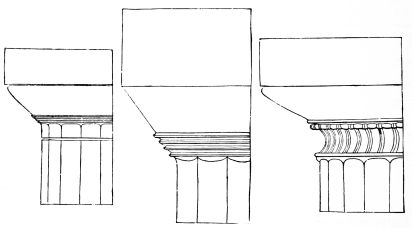
Fig. 150.—So-called Temple of Theseus, Athens.
Fig. 151.—Porticus of Philip, Delos.
Fig. 152.—So-called Temple of Demeter, Pæstum.
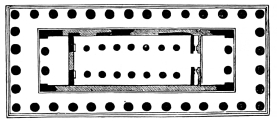
Fig. 153.—Plan of the Great Temple of Pœstum.
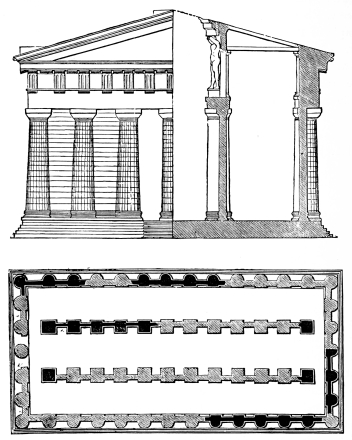
Fig. 154.—Plan, Section, and Elevation of the Temple of
Olympian Zeus at Acragas.
The Temple of Zeus at Selinous was the first of a number of colossal structures, in which the architectural ability of the Greeks, by that time thoroughly schooled, sought also to develop itself in enormous size. The hexastyle front was increased to the octastyle, thus permitting wider dimensions of the cella, which still, however, did not attain the greatest possible extent, the architect being unwilling to reduce the breadth of the pteroma. The columns became even shorter and thicker; they were less diminished and had a more delicately adjusted entasis; the intercolumniations were increased. The separation of the capital from the shaft by an apophyge was abandoned; the entasis was made steeper and of a more vigorous outline. The disproportionately high and weak triglyphs are especially characteristic of this stage of development; with the{219} exception of these, the entablature still remained low and heavy. Marble came more and more into use as a building-stone; the execution of details in stucco was rarer. The new material did not limit the use of color, which, in place of the former tones, became brighter—red, blue, and yellow prevailing. The most imposing, because the best-preserved, of these colossal works is the magnificent Temple of Pœstum, with its two stories of inner columns partly intact. (Fig. 153.) The triglyphs have not as yet disappeared from the walls of the cella, but otherwise the construction shows no primitive traits, being fully fitted for its execution in stone. Resembling this in many points is the Temple of Acragas, or Agrigentum, termed that of Heracles. (Fig. 149.) The great Temple of Zeus of the same city was of the most gigantic dimensions ever attempted in the sacred architecture of the Greeks. It was also, unfortunately, even greater than was really practicable for a trabeated construction in such a building-material, and consequently became a monstrosity. The temple was heptastyle, that is, had seven columns upon the front, which rendered impossible the normal entrance in the middle. It differed still more decidedly from other Greek temples in that the cella was not surrounded by an open pteroma, the outstanding columns being supplanted by a wall decorated with engaged shafts. It would be difficult to decide whether this peculiar pseudo-peripteros owed its conformation to the building-stone at disposal, only to be quarried in blocks too short for the lintels of the pteroma, or whether other considerations led to this abnormal negation of the fundamental principles of columnar architecture, which here has no relation to the better-founded practices of Roman builders in the application of engaged shafts. The transformation{220} of the pteroma made an entire change in the general disposition of plan; but too little of the building now remains above ground to render its arrangement certain. If door-openings be assumed at both sides of the middle column, as in the illustration, this would have been possible only upon the west, the middle column of the east—the customary entrance-front—being proved by the remains to have been engaged. It is not probable that windows existed in the wall between the columns; the supposition is more natural that some of the side metopes were unclosed, and provided the{221} pteroma with sufficient daylight. This would have been no innovation, but rather, in this case, where it was impossible to execute the open peripteros, a return to the original method of illumination through the interstices between the beams upon the top of the cella wall. The before-mentioned Temple of Athene upon the island of Ortygia is another Sicilian example belonging to this archaic period of gigantic dimensions.
The two colossal monuments of Athens, built during the second half of the sixth century, are more important, although the older Parthenon upon the acropolis, if, indeed, ever completed, could not have stood longer than half a century, and the Doric temple of Olympian Zeus was discontinued before its construction had far advanced. A comparison of a fragment of the earlier building with the entablature of the present Parthenon shows how disproportionately high were the triglyphs and how heavy and broad the tænia and regulas of the archaic period. (Fig. 155.)
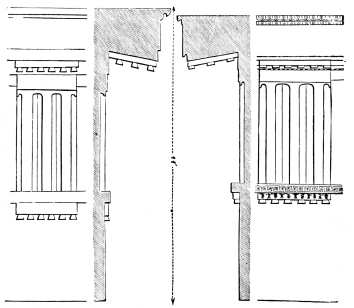
Fig. 155.—Entablatures of the Older and Present
Parthenon.
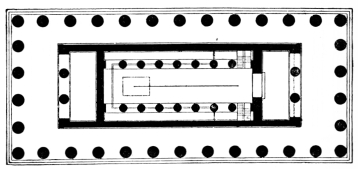
Fig. 156.—Plan of the Temple of Zeus at Olympia.
The exercise of the designer’s individual ability in these works,{222} and the hieratic retention of every constructive and æsthetic gain thus obtained, prepared for the fullest perfection of the Doric style. The advance was effected by a slight attenuation of the too massive columns, a further reduction of the height of the entablature, and an increase in the projection of the smaller decorative members. The temples built during, or shortly after, the time of the Persian wars show the gradual introduction of these changes. Among the Sicilian remains of this period are the uncompleted Temple of Segesta, the so-called Temple of Concordia at Acragas, and the six peripteral temples upon the acropolis and eastern plateau of Selinous not previously mentioned. Among those of Greece proper, the Temple of Athene upon Ægina and the Temple of Zeus at Olympia (Fig. 156) are most prominent. The frieze of triglyphs was omitted from the cella walls of the Temple of Ægina, but the regulas and trunnels were retained with curious effect: it is as though the designer were only slowly and with difficulty led to give up, one by one, the traditions of a primitive wooden construction. The date of the building of the Olympian temple is uncertain, but the name of its architect, Libon, of Elis, has been handed down, with one exception the earliest connected with Greek architecture. The recent excavations have entirely exposed the overthrown ruins. They show that the forms of the edifice are more primitive than would have been expected from the age in which Pheidias completed the celebrated chryselephantine statue of the temple deity. It is possible that the advance of the building was slow, or that there were{223} long interruptions of the work before its final completion. An especially important result of the investigations is the evidence that an enclosed ædicula for the statue of Zeus, hitherto advocated by restorers because of the supposed opening in the roof and ceiling for light, did not exist, the interior having been divided into three aisles like the great Temple of Pæstum. The proportions of the peripteros were of great vigor and beauty. It was built of poros, with the exception of the metope reliefs upon the fronts of the cella, and the carved gutter and roof tiles, which were of marble. This so-called poros, a stone almost exclusively employed for the earlier buildings of the Greeks, is a rough shell conglomerate, usually brought to a surface by a heavy priming of stucco. The floor of the pteroma of the great temple at Olympia was of a pebble cement, the small inner staircases of wood.
While the architecture of the Peloponnesos still retained traces of the archaic style, the highest perfection of Doric forms was attained in Attica, reaching its fulfilment at a time, after the Persian wars, when the political supremacy of Athens was far greater than that ever enjoyed by any state of the world so restricted in territory. The deserved sovereignty of Athens over Greece, its naval power, imposing even to the Orientals of Western Asia and Egypt, and, finally, the necessity and opportunity of rebuilding the Attic capital after its destruction by the Persians, before the decisive battle of Salamis, caused a monumental rebirth of the noble city, which not only became the classic model in those ages throughout the extent of Greece and its colonies upon distant shores, but the highest ideal of architecture to the present day and for the entire future of the human race. Attica was fitted to cultivate equally the artistic peculiarities of the two branches of the Hellenic stock, its Ionic population being intermingled, in a marked degree, with Doric elements. It had attained the highest development of civilization, and was the home of the most famed artists. By the taxes levied upon the eastern mainland and the islands of the Archipelago, Athens had almost unlimited means at its disposal. To this nature added the incomparable marble building-material, quarried almost before the gates of the city, which indeed possessed all the conditions requisite for the first monumental capital of Greece and of the civilized world. Familiarity{224} with the Ionic style did not permit that heaviness and clumsiness of architectural members observable upon the contemporaneous temples of the Peloponnesos. The columns of the Temple of Ægina had been allowed a height as great as 5.3 times their lower diameter. In the Doric buildings of Athens this was still further increased, the so-called Temple of Theseus having the proportion of 5.62 to 1, the Parthenon as 5.47 to 1. The diminution and entasis of the shaft were reduced to just relations; the delicate curve of the latter, as demanded by the optical deception it was to correct, was greatest below the half height of the column. The channellings no longer remained segmental arcs, but received an independently designed, elliptical profile. The echinos became steeper, rising in an almost straight line to the firm and sharp turn beneath the abacus. The triglyphs, returning slightly to former proportions, became broader than those of the preceding period; smaller members were diminished in height, but were made more projecting. The colors of the entablature became still more intense; blue and red predominated; green was also employed, and gilding appeared upon the trunnels and in the beautifully composed surface patterns. Ionic elements, almost entirely disused during the latter ages, reappeared in very general employment, especially in the deep cofferings of the pteroma ceiling and upon the capitals of the pilasters.
The typical monuments of this Attic Doric style are the so-called Theseion, and the Parthenon and Propylæa of the Athenian acropolis. The first of these buildings (Fig. 139) was certainly not sacred to Theseus; its dedication is not surely known. It preceded the highest perfection, still betraying some slight archaic influences. The triglyphs are too high, the smaller members, notably the regulas and trunnels, too heavy. Ionic elements are freely introduced. Besides the coffering of the pteroma ceiling and the before-mentioned pilaster capitals, there was an Ionic zophoros, or continuous frieze of figures, bordered above and below by leaved cyma-mouldings and astragals, in place of the Doric entablature usually employed, at least in part, upon the walls of the cella. The ornamental painting was extended to the capitals of the pteroma columns (Fig. 150), which bore a series of leaves, and to the walls, the interior of the naos having been prepared for{225} the reception of pigments. The perfect preservation of the building is owing to its early transformation into a Christian church.
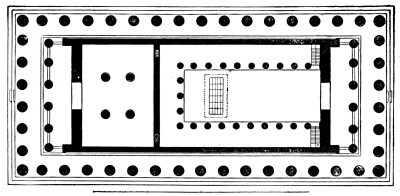
Fig. 157.—Plan of the Parthenon.
The Parthenon far surpassed the Theseion in artistic perfection; it was, indeed, worthy the superintendence of a Pheidias. Its architect, Ictinos, conceived his work to stand so high above contemporary buildings that he celebrated it in an especial monograph, mentioned by Vitruvius, though, unfortunately, not consulted by him. The dimensions of the octastyle temple were imposing; the edge of the stylobate measured about 30 by 68 m.; elevated upon the steep acropolis, it could be seen from a great distance. Though its site was not limited, the economy of space was carried to an extreme. The intercolumniations are narrow, especially those of the front; the pteroma was thus reduced in breadth to less than one and one half times the lower diameter of the columns. (Fig. 157.) The pronaos and epinaos had no side walls, the cella being amphiprostyle, enclosed by high grilles. The depth of these vestibules was less than one quarter of their breadth. The remaining interior was partitioned into two chambers of unequal size: the naos and the opisthodomos, the latter of which served as a treasury. The naos was divided by ranges of columns into three chief aisles, and the gallery over the sides was carried across the nave, next to the rear wall. The world-renowned chryselephantine statue of Athene, 12 m. high, stood before the transverse columns, between which and the partition there was allowed a passage, nearly equal in breadth to the{226} side aisles. The stairs to the gallery may, from the analogies of the great temples of Olympia and Pæstum, be assumed to have existed at either side of the entrance.
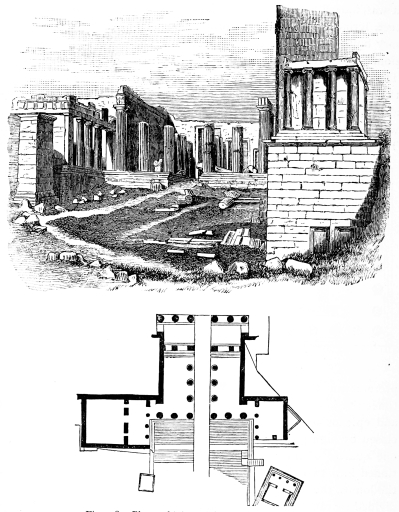
Fig. 158.—Plan and View of the Propylæa, Athens.
The Propylæa of the Athenian acropolis, by which the architect Mnesicles made his name immortal, were not less perfect than the Parthenon. Work upon them was begun shortly before the completion{227} of the latter building, in 438 B.C., and occupied five years. Ionic members had frequently been employed upon Doric structures, but the Propylæa offer the first instance of a combination of the styles in almost equal proportions: the interior of these gates was entirely Ionic, the exterior entirely Doric. (Figs. 120 and 158.) Six Ionic columns bore the famed marble ceiling of great span, while two Doric porticos formed the fronts. The stone-cutting of all the monuments upon the Athenian acropolis was incomparably exact and beautiful, as was the harmony of their proportions and forms.
The Temple of Phigalia, or Bassæ, in Arcadia, though stated to have been built by the architect of the Parthenon, shows that the perfection of the monuments last considered was possible only upon Attic ground. The sanctuary of Arcadia was dedicated to Apollo Epicourios in gratitude for the deliverance of the district from the plague of 431 B.C. Its plan (Fig. 159) was excessively long, having fifteen side columns, with a hexastyle front. The elevation offers a remarkable combination of archaic traditional forms and of exaggerated novelties. Though the three incisions of the capital necking are peculiarly primitive, the echinos has become even steeper than it was upon the Parthenon. Ionic sculptured ornaments begin to appear upon the entablature. The inward inclination of the axes of the columns and the curvature of the horizontals have been neglected in Bassæ, as if the architect had not considered it worth while to display such refinements to the uncultivated Arcadians. In the interior of the temple Ionic columns are engaged upon short transverse walls, which project from the sides. These are so remarkably archaic in form (Fig. 165) that it is difficult to explain how Athenian architects, who must have been familiar with the interior columns of the Propylæa and those of the Erechtheion, then in course of construction, could have prepared{228} the designs. An extremely ancient and undeveloped Corinthian capital (Fig. 176) has been found among the ruins of Bassæ; it will be referred to below. Many of the anomalies of the temple would be explained by the assumption that the building occupied the site of a former chapel, the entrance to which had naturally been upon the east, and that the lack of available ground prevented the retention of the original and usual orientation, making the peripteros, as the enlargement of a former fane, open the inner chamber of the naos upon one of the long sides.
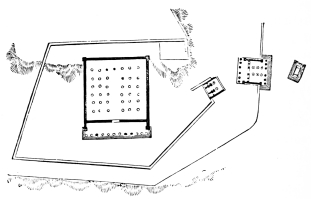
Fig. 160.—Plan of the Temenos of Eleusis.
Other Attic remains, some of which date from the end of the fifth century, also show traces of the deterioration of the art. Chief among these are the Propylæa of Eleusis and the house of assemblage for those initiated in the Eleusinian mysteries, known as the Telesterion, a square hypostyle hall, fronted by a portico of twelve columns, apparently without a gable. (Fig. 160.) It is not known how soon after the Persian wars the temples of Rhamnous and Sunion were rebuilt; they may have slightly preceded the age of decline. The increasing love of magnificence and luxury felt among the Greeks was not satisfied with the simple majesty of the Doric style; the Ionic was more and more frequently substituted in preference. The latter had been employed for the Propylæa of the Athenian acropolis, and had appeared independently in smaller temples, and, finally, in the national shrine of Attica, the Erechtheion. The Doric became restricted to porticos and peristyles, and, in{229} double-storied interiors, to the lower order, for which important constructional functions it was fitted by the great solidity of the column. But the desire to simplify the execution of Doric members, and reduce the expense which must have been attendant upon the delicate refinements of curvatures, introduced dry and hard geometrical forms, and the æsthetic value of the style was, for the greater part, lost. An example of this debasement is offered by the portico of Philip upon Delos, where the echinos projects in an absolutely straight line. (Fig. 151.) In the colonies, upon the other hand, even as late as the Roman period, the style was archaistically treated, with a provincial lack of good taste, illustrated by the weak echinos and apophyge of the capital of the so-called Temple of Demeter at Pæstum. (Fig. 152.)
An entirely different manner of building had early appeared by the side of the Doric style, which cannot be accounted of quite equal birth with that eldest male offspring of Hellenic civilization, but, to carry out the simile, should rather be considered as a step-sister. The development of the peripteral plan, the echinos coronation of the channelled shafts, and the entablature of triglyphs, metopes, and mutules, appear autochthonic and purely Greek; while the Ionic style, though adopting the plan and general disposition of the former, was, in its most characteristic details, an importation from Asia. It is not meant by this that the perfected style was not characteristically Hellenic. The Greeks accepted none of the products of their neighbors without a change—a transformation of disposition and detail by their peculiar genius. But the fundamental motives, the elements of the style, in as far as these are not identified with the Doric, had been taken from neighboring Eastern lands of primitive civilization: from the coasts of Asia Minor and Syria.
The Ionic column betrays this relationship in both base and capital. The former consists fundamentally of a tore elevated upon a drum, usually hollowed by a scotia. This tore was employed as a footing for the columns of Nineveh, and is familiar through one example and through representations upon reliefs. From thence it was transplanted to Persia, where, in the middle of the sixth century B.C., it appears with the horizontal channelling found upon the more primitive Ionic monuments. (Fig. 79.) The concave{230} profile of the under plinth is new and Hellenic. The delicate perception of the Greek designer recognized the advantage of this scotia over the clumsy heaviness which had resulted from the tore being placed immediately upon the ground or upon a rectangular slab, and the lower member was made to harmonize with the channelled moulding above it by the emphasis of horizontal lines. It is uncertain whether the slender proportions of the Ionic shaft, so marked in comparison with the strength of the Doric style, is to be attributed to Oriental influences. It agreed as well with the light Ionic entablature and ceiling as did the powerful Doric column with the great weight imposed upon it; and it may be regarded as one of the principles of architectural construction that the strength of the support has ever been originally determined by the weight of the ceiling and superstructure: the column has been adapted to the entablature, not the height of epistyle, frieze and cornice to the diameter of the shaft. With this consideration agreed the desire to attain great elegance and lightness of proportion, peculiar to the Ionic race. The Ionic column, thus made of greater proportional height, had diminution and entasis like the Doric. It differed remarkably in the fluting. A vertical grooving cannot be traced upon the columns of Assyria; upon those of Persia it is similar to the Doric channels, with sharp arrises. The development of the flute itself may perhaps be deemed peculiarly Greek. As painted ornaments were gradually given up, they were replaced by architectural carvings; such sculptured decorations were harmoniously introduced upon the shaft, and the channels were deepened to a semicircular profile. This rendered a change of the arrises necessary, for if the ends of the arcs were to have abutted, as upon the Doric column, the deep flute, with its extremely sharp edge, could only have been executed upon a plane. Upon a convexly curved surface, like that of the cylindrical drums, it would have been impossible to cut semicircular grooves immediately adjoining, as their outlines would have intersected. The sharp arrises were therefore relinquished, and a broad vertical band, the surface of the original cylinder, was left in its place, the play of light and shade which enlivened the body of the shaft being increased by these flutings, but the evidence of the derivation of the channelled column from the{231} polygonal pier was entirely sacrificed, the cylindrical form being characterized as original by the remaining fillets. The carving of the shaft was rendered more difficult from the slight projections left at the top and bottom as transitional members to the base and to the capital. This horizontal fillet was a further gain to the outline of the column, concave and convex surfaces thus alternating from floor to ceiling. The flutings were terminated above and below, before reaching this transverse member, by a semicircle, which agreed with their sectional outline.
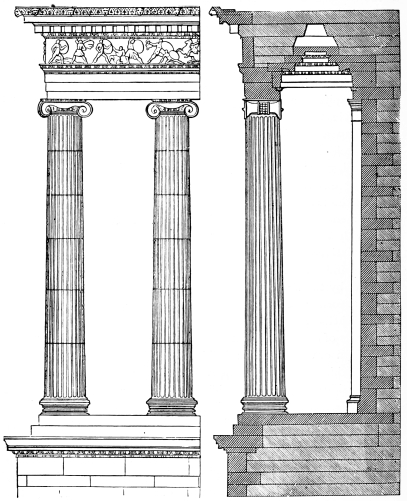
Fig. 161.—Ionic Order from the Peripteros of the
Mausoleum of Halicarnassos.
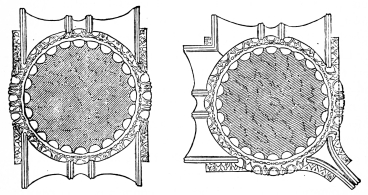
Fig. 162.—Plan of the Normal Ionic Capital.
Fig. 163.—Plan of the Corner Ionic Capital.
The capital consisted, in part, of an echinos, similar to that of the Doric style, the leaves, which, at least in one instance, had been painted upon it, being here carved, and an astragal taking the place of the necking rings. This echinos is almost entirely covered by a spiral roll, which gives to the style its most striking characteristic. With the discovery of the helix upon the capitals of Assyrian reliefs, all the labored explanations of the significance and derivation of this member have fallen to the ground. It is impossible to believe, with Vitruvius, that the Ionic column was considered as the representative of the fair sex: that the locks of hair were indicated by the spiral line of the capital, the folds of the wide garments and draperies by the flutes and fillets, and the sandals by the base. Nor are the theories more satisfactory which seek for such natural motives as spiral shells or twisted ram’s horns, assumed to have been primitive ornaments of the sanctuaries. And it is still worse to regard the peculiar form of the capital as decided by the conception of an elastic cushion, which, displaced by the weight of the entablature, curls again at either side of the echinos. The Ionic helix was a form of capital imported from the East, where it had been used by barbaric designers as a mere ornament upon upright legs of furniture (Fig. 81), or upon Persian columns (Fig. 80)—a form developed by the Greeks into an architectural member of the first importance. The Assyrians, by doubling the volutes, had formed with this motive a capital not particularly well adapted to the functions of a transitional member between vertical support and horizontal burden. The Hellenic architect perceived that a more decided projection was necessary, and therefore placed an echinos beneath the volute, leaving the roll as the medium between the circular shaft and oblong entablature,{232} which, in the Doric style, had been formed by the abacus. The horizontal lines of the abacus, thus supplanted, were represented upon the Ionic column only by a narrow moulding, curved to the profile of a cyma and sculptured with a leaved ornament. In the Greek capital the spirals became an elegantly curved roll, of greater length than breadth, with tightly curled ends, which were bound{233} together, upon either side of the echinos, by a band. The capital thus shows its true profile, the helices upon front and back, and upon the subordinate sides rolls of their thickness. (Fig. 161.) This difference between face and side resulted in one great difficulty upon the corners, which, like the irregularity of the division of the Doric frieze of triglyphs and metopes in the same place, proves that the Ionic style also did not originate upon the peripteral plan, but was adapted to it from a temple in antis. It was natural that the more ornamental side of the column should face the entrance front, and thus the capitals upon the longer sides of the building were forced to show their rolls, the partie honteuse, unless the corner capital assumed an unnatural deformation to present the helices upon two adjoining, instead of two opposite, faces. (Figs. 162 and 163.) The corner capital thus became a miserable hybrid, which, because of the impossibility of its execution in a natural manner, from the intersection of the outer volutes when these proceeded in a straight line parallel to the epistyle, lost not only all constructive significance and harmony with those next to it, but also its individual beauty. There was no other expedient than to bend the faces of the corner volutes outward in the line of the diagonal—a malformation visible at every standpoint. A further difficulty was presented by the corners of the spirals over the echinos, which required to be masked by floral decorations. Upon the narrow abacus moulding rested the entablature, remarkable for the Oriental character of{234} the details, and notably for reminiscences of primitive wooden construction, which are almost as evident in the Ionic as in the Doric style. The epistyle, formed in the latter by a single plane block, was here triply stepped to agree with the multiplied beams required by the nature of Oriental timber—generally provided by the various species of palms. According to the description of Vitruvius, the motive was also employed for the wooden epistyle beams of Etruscan temples. Each face projected slightly beyond the one beneath it, as previously customary in Asia, and shown by the ruins of the palace of Darius (Fig. 84) and the rock-cut façade of that monarch’s tomb (Fig. 83). The epistyle is terminated by a Lesbian cyma and an astragal, the latter being, in some instances, repeated upon every light step from beam to beam beneath. The frieze, known in this style as the zophoros, the bearer of figures, is an original Hellenic creation, the Oriental entablature consisting of only two members as representative of only two constructive features: the epistyle that connected the columns, and the ceiling and roof, which, in the rainless countries of the East, appear as one and the same member. In Greece the inclined roof was separated fundamentally from the horizontal ceiling, and the entablature consequently expressed a triple character. The naïve and truthful manner of this expression, peculiar to the Doric style, was not followed by the Ionic. The second member of the entablature, the frieze, should represent the ceiling, but the symbols of that constructive feature, the dentils, were crowded up among the details of the cornice, while the zophoros itself, perhaps as a result of the relief sculpture employed upon the Doric metopes, became a continuous decoration of carving. The dentils, as significant of the ends of the small ceiling-beams, were in their proper place, touching the epistyle, upon the monuments of Persia (Fig. 83), and also upon the tombs of Lycia (Figs. 110 and 111), so closely allied to the Mesopotamian tradition; they were there of far greater size than in the Greek Ionic, where their position and diminutive dimensions reduced them to a mere ornament. The members of the cornice stand in no such relation to the interior construction of beams and rafters as did the mutules and trunnels of the Doric temples. The curved gutter, however, is ornamented with lion’s-heads and anthemions, which seem in both{235} styles to have been derived from western Asia. The stone beams of the pteroma ceiling rest directly upon the epistyle, and are consequently as far below their exterior representatives, the cornice dentils, as, in the Doric, they were above the triglyphs. Between them are the rich cofferings, not with small lacunæ, calculated to produce an effect mainly by color, but in broad surfaces, frequently stepped, with carved cyma-mouldings in the angles. (Fig. 164.) The plan of the cella differed but slightly from that of Doric temples. The doors are usually provided with parotides, the doubly-spiral brackets which have remained a popular ornament beneath the coronations of door and window openings until the present day.
The historical development of the Ionic temple is not illustrated by as many examples as was that of the Doric style, and, indeed, there was no such marked and regular advance as that observable in the temples of Selinous, Olympia, and Athens. A great number of Ionic monuments stand in a district not as yet thoroughly examined: the southern coasts of Asia Minor. Towards the border of Lycia traces of an archaic or proto-Ionic style have been observed, more closely allied to Eastern motives than were the developed temples of Greece. The capitals of Lycian tombs (Fig. 110) have no{236} echinos, by the addition of which so great an advance was subsequently made; the formation of the rolls upon the sides was also primitive, they being at times perfectly straight, at times disproportionately curved. The difficult transition from the end of the shaft to the volutes was evaded, and masked by anthemions or other ornaments. The only example of such an imperfect formation in European Greece existed in the interior of the Temple of Apollo at Bassæ (Fig. 159); the date of its erection, however, shows this example not to have been archaic, but rather archaistic,—that is to say, intentionally and affectedly imitated from primitive peculiarities of form. (Fig. 165.) The columns, engaged to transverse walls, have bases of excessive projection, the thin and feeble tore being out of proportion to the high member beneath it. The lower end of the shaft itself forms a second projection, which greatly exceeds the usual congé and fillet of the bottom drum. The shallow flutings are continued up to the very top of the shaft, there being concluded by an almost straight line. The capital itself is most strikingly archaistic, presenting the helices upon each of its three exposed faces; it is an applied decoration which has given up all semblance of constructive unity or function, leaving the prismatic kernel, without an abacus moulding, to project above the curves and support the imposed entablature. The narrow space remaining between the two large spirals of each side is almost entirely filled by a decoration of anthemions, and the introduction of an echinos is thus rendered unnecessary. The sculptured zophoros of the interior entablature, now one of the chief treasures of the British Museum, betrays in its figures{237} the greatest freedom from convention, in marked contrast to the affectedly antique character of the architectural forms.
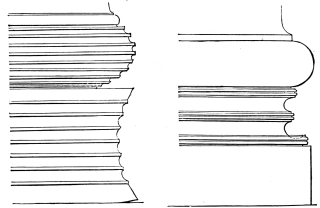
Fig. 166.—From the Heraion upon Samos.
Fig. 167.—From the Temple of Apollo Didymæos, Miletos.
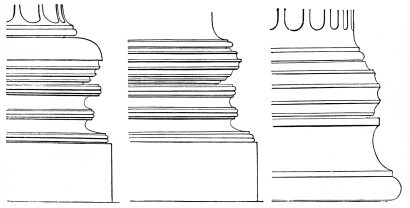
Fig. 168.—From the Temple of Athene at Priene.
Fig. 169.—From the Propylæa of Cnidos.
Fig. 170.—From the Temple of Wingless Victory, Athens.
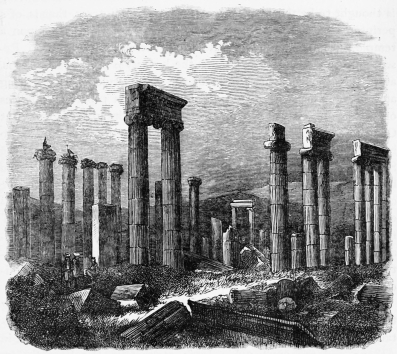
Fig. 171.—Temple Ruin at Aphrodisias.
The northern coast of Asia Minor, as far as it is at present known, offers few Ionic remains of the archaic period. The original Temple of Artemis, at Ephesos, according to Pliny the most ancient peripteros of the style, has been totally obliterated by frequent reconstructions and the famed conflagration of Herostratos. A second fane of{238} national importance, the Temple of Hera, at Samos, is at present known only by one unfluted column, 1.6 m. in lower diameter, and by horizontally fluted tores and plinths. These two buildings were of such interest that their architects saw fit to celebrate their constructive peculiarities in monographs, as had been done for the Doric Parthenon. The writings of Chersiphron and of the Cretan Metagenes upon the Artemision at Ephesos, and of Theodoros, the son of the Samian Illecles, upon the Heraion of that island, are mentioned as late as the time of the Roman emperors. These peripteral temples, built about the middle of the sixth century B.C., were of very considerable dimensions, but were far surpassed in size by a third national shrine of the Ionians, the Temple of Apollo Didymæos, rebuilt by Paionios of Ephesos and Daphnis of Miletos almost a century later than the former monuments, 470 B.C., upon the site of an ancient structure destroyed by the Persians. The temple was a dipteros decastylos, that is, had a double row of outstanding columns around the cella, with ten upon the front; it measured 91 m. in length and 49 m. in breadth. The columns were proportionately tall, 19 m. in height, which equals nine and a half lower diameters, and were placed closely together, the intercolumniations being only one and a half diameters wide. The scotia of the base was divided by a projecting moulding and elevated upon a square plinth; the tore had no horizontal flutings. (Fig. 167.) The capital had a straight connection between the spirals, and the epistyle was stepped but twice. The interior of the temple was provided with pilasters, the capitals of which are of an Oriental character, richly decorated with floral motives. A Corinthian capital also occurs upon the building (Fig. 177), which will be referred to below. The enormous temple of which there are fragmentary remains at Sardis, supposed to be that of Cybele, appears to have been erected during this period, and resembles the shrine of Apollo Didymæos at Miletos. The Temple of Athene Polias at Priene, the work of the architect Pythios, who celebrated its completion in a monograph, dates from the middle of the fourth century B.C., as it was dedicated by Alexander the Great. It was a hexastyle peripteros, of normal dimensions, 35 m. long and 19 m. broad. The plans of Ionic temples differed in proportion from those of the Doric style,{239} their length being less than twice their width. The base of the temple at Priene (Fig. 168) is peculiar, in that the horizontal flutings of the tore, entirely lacking in the Didymaion, were restricted to its lower half; this can hardly be taken to prove that the building was never completed, but is rather explained by the consideration that no escape was possible for the rain-water which dripped into the upper grooves. The connection between the spirals of the capital face is curved downward; the ornaments of the entablature are more florid, and the gutter is almost overladen with floral motives. The tetrastyle Ionic Propylæa of the same place appear to be of more recent date; the capitals of the inner pilasters are decorated similarly to those within the Didymaion. Another structure of this kind at Cnidos is of more beautiful detail, the base (Fig. 169) being particularly graceful in outline and proportions; the increased curve{240} of its tore obviated the trouble of water standing in the horizontal flutings. There are but few remains of the temples of Artemis Leucophryne at Magnesia, and of Dionysos at Teos, built towards the end of the fourth century B.C., and celebrated in monographs by the architect Hermogenes. The first of these was, according to Strabo, the third largest fane of Asia Minor, measuring 64 m. in length and 29 m. in breadth. The influence of Attic architecture is evident in the bases and in the rich decoration of the capital rolls. The building is thought to be the first example of a pseudodipteros, that is, of a peripteros having a pteroma equal to the breadth of that upon a temple with two ranges of outstanding columns, a dipteros. Resembling this, though smaller, was the hexastyle peripteros of Teos, at first intended to have been of the Doric style, the plan being altered to Ionic after all the material had been provided. Traces of decline in the art prove the octastyle peripteros of Apollo at Claros, near Colophon, and the temple at Pessinus, in Galatia, to have been more recent. The Temple of Panhellenic Zeus and the Sanctuary of Aphrodite at Aphrodisias (Fig. 171) are referred to the beginning of the Christian era. The excessive attenuation of the columns of the latter, which have a height equal to ten lower diameters, the extension of the floral ornaments even to the channels of the shaft and the connection of the capital spirals, the so-called egg-and-dart moulding in the cyma, the diminutive dentils and the introduction of consoles above them, all betray the tasteless magnificence of the Roman imperial period.
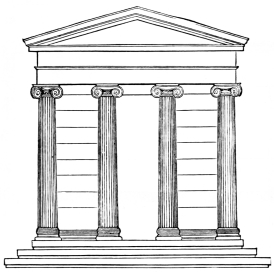
Fig. 172.—Temple upon the Ilissos.
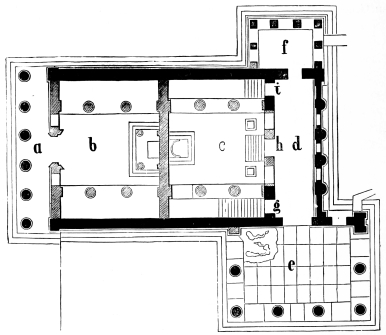
Fig. 173.—Plan of the Erechtheion. (Boetticher.)
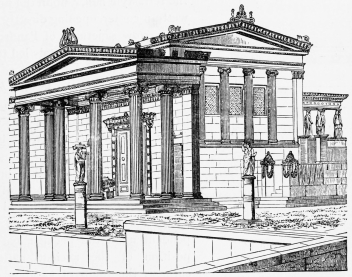
Fig. 174.—Northwestern View of the Erechtheion.
The Ionic style in Attica developed in a peculiar manner, being there superior, both as regards breadth of form and beauty of detail, to the works of Asia Minor. The Doric had been perfected in Athens, and the most noble Ionic monument, the Erechtheion, stood beside the Parthenon; the Athenian acropolis presented the noblest examples in both methods of building, standing unrivalled at the head of the Hellenic world in architectural, as in political and intellectual respects. Characteristic of the Attic Ionic are the so-called Attic base and the entablature without dentils. The former consists of a second tore beneath the concave plinth of the usual base; by this addition its symmetry was increased, and a rhythmical profile of great beauty was gained: two convex and two concave{241} members of harmonious proportion alternating from the upper slip to the commencement of the fluting. The Attic architect evidently did not accept the significance of the dentils as representatives of the ceiling-joists, and preferred to cut a decided drip upon the lower surface of the corona, which had so marked a slant in the more familiar Doric cornice. In the place of the dentils, a transition was provided by a cyma and astragal, which mouldings received in Athens their typical perfection. The few Ionic ruins of European Greece do not illustrate the historical development of the Attic Ionic style. The interior columns of the Temple of Apollo at Bassæ (Figs. 159 and 165) cannot be considered in this connection; their archaistic details by no means express the influence of Athens, notwithstanding that the work is attributed to the architect Ictinos. The peculiarities of Attic Ionic architecture are well exemplified by the small amphiprostyle temple upon the Ilissos, near Athens, which, though now entirely destroyed, was in existence up to the end of the last century, and was measured and drawn by Stuart and Revett. (Fig. 172.) The lower tore of the base is here small and weak, as if a hesitating attempt to improve the usual outline.{242} The shaft was short, perhaps from the influence of the Doric examples; the epistyle, from the same consideration, was without the characteristic steps. Similar to this is another tetrastyle amphiprostylos, the Temple of Wingless Victory before the Propylæa of the acropolis, which, as if to compensate for the loss of the temple upon the Ilissos, was rebuilt in 1835, with overthrown fragments rescued from a Turkish bastion, and has become one of the chief ornaments of the ascent. (Fig. 158.) The entire crepidoma is so small—8 m. long and 5.5 broad—that the cella, after the deduction of the front and rear porticos, is even broader than it is deep. The architectural details are of exceeding delicacy and perfection (Fig. 170); the sculptures of the zophoros and of the balustrade will be considered in the following section. The inner columns of the Athenian Propylæa show the lower tore fully developed, and the base-mouldings isolated by a plinth of slightly concave profile, elsewhere{243} adopted only at Eleusis, in imitation of this building. The highest perfection of the Ionic style was, as before said, attained in the second national sanctuary of the Athenians—the world-renowned Temple of Athene Polias upon the acropolis, the Erechtheion. The construction of the edifice seems to have been undertaken immediately after the burning of the ancient building by the Persians, in 480 B.C., but, in consequence of the miseries of the Peloponnesian war, its completion was delayed until eighty years after that date. It was a combination of several shrines which, necessarily constructed upon different levels, rendered a perfect symmetry of plan impossible. Other double temples, like those of Leto and Asclepios, and of Aphrodite and Ares at Mantinea, or of Apollo Carneios and of Hypnos at Sikyon, were not, upon the exterior, distinguishable from the common type, as, with an equal division of the cella, entrances could be allowed upon either front. In the Erechtheion this simple arrangement was not practicable, because of the complicated nature of the combined sanctuaries and the irregularity of the ground; yet this did not prove a disadvantage: to the architectural perfection of the monument was thus added a{244} charm of picturesque composition usually foreign to the temple buildings of Greek antiquity. The plan given (Fig. 173) is according to Boetticher’s restoration, but the mooted question of the interior division of the building is still far from being decided. Upon the principal eastern front was a hexastyle portico, a, through which entrance was given to the naos of Athene Polias, b, occupying nearly one half of the cella. Access to the other division was obtained through the tetrastyle hall, c, upon the northwestern corner, opening directly into the narrow sanctuary of Pandrosos, d, from which four portals led to as many chambers: the first, g, to the Chapel of Boutes; the second, h, by means of a short staircase, to the Crypt of Poseidon, e; from the third, i, was a descent to a corridor leading to a space under the Naos of Athene Polias; while the last, opposite the hall, led to the Porch of the Caryatides, f. This complicated disposition was, as has been said, dependent upon the peculiar natural position of the ancient national shrines: the tomb of Cecrops and the memorials of the contest between Poseidon and Athene for the possession of Athens,—the impression of the trident with which Poseidon smote the cliff, leaving a spring of salt water, and the olive-tree which, at the command of Athene, sprang from the same rock. Of the interior of the building there are almost no vestiges; but the form of the exterior is, in the main, clear. (Fig. 174.) The capitals upon the columns of the eastern portico (Fig. 175), and upon the pilasters of the western wall, which was pierced by windows, are of almost excessive magnificence. The{245} outlines of the spirals are doubled, the side-rolls are grooved, and ornamented with astragals; there is a band carved with a woven ornament above the egg-and-dart moulding of the echinos, and an entirely new feature has been added to the capital—a broad and rich necking of carved anthemions. The effect of this band was particularly favorable because the decoration upon it could be repeated beneath the capitals of the pilasters, and a greater harmony of the corresponding members thus secured. The columns of the northwestern porch are larger and even richer in detail, especially the bases, the upper tore being ornamented with a woven motive in place of the customary horizontal grooving. The entablature, from which the dentils are missing, is of the utmost elegance of proportion, the carving of its cyma-mouldings being the most delicate work of architectural carving known. The reliefs upon the zophoros were not cut from its substance, but were merely attached to its plane surface; few fragments have, consequently, been preserved. One of the most beautiful features of the building is the Porch of the Caryatides in the southwestern corner (F). In place of columns, the figures of virgins support the horizontal marble ceiling, which is of no great weight. The model for these was doubtless taken from the basket-bearing maidens of the Panathenaic procession, the Canephoræ. The origin of the term caryatides is not known. Both geographical and historical proofs are wanting to make probable the account given by Vitruvius,—that the motive for these figures was derived from the women of the Peloponnesian town Carya, who were condemned to slavery for treachery during the Persian war. From the baskets of the Canephoræ has been developed a capital member, like an echinos, decorated with the egg-and-dart moulding and an astragal, and provided with an abacus. The frieze is lacking from the entablature, in recognition of the fact that roof and ceiling are here one and the same member. The dentils appear in the cornice, it being possible for them to take their true position upon the epistyle. The faultless beauty of the decorative carving is particularly evident upon the casings of the portals.
Monuments of the Ionic style, not numerous in Attica, are rare in the Peloponnesos, and exceptional farther west, where the Doric element of the population predominated. When Ionic ruins{246} are found in the latter districts, they generally betray the influence of the Attic school, which is perceptible even in the Ionic order of Rome. It is not strange that, after the acquaintance of the Romans with Hellenic lands, this method of building should, in their universal eclecticism, have been frequently adopted. It will be seen in the following section how Italy, the heir of the decaying civilization of the East, reduced the forms of Ionic architecture to a facile and commonplace scheme.
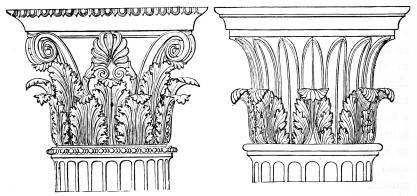
Fig. 177.—From the Temple of Apollo, near Miletos.
Fig. 178.—From the Tower of the Winds, Athens.
During the age of Pericles a foreign growth, the Corinthian capital, had been engrafted upon the Ionic style, which changed the character of the whole, the more decidedly because introduced upon the most prominent feature. This “Corinthian” innovation affected the capital alone, and cannot be considered as an order, still less as a style, when compared to the Doric and Ionic. It was a mere variety of the latter, which, in all other respects than the capital, remained unaltered. The new form is mentioned as an innovation of Callimachos, a sculptor celebrated for the magnificent golden lamp and funnel made by him for the Erechtheion. The name of that artificer may have given authority to the first introduction of the Corinthian capital into Greek lands; but the detailed account of Vitruvius in regard to its origin can hardly be deemed more than a fable. He relates that a loving nurse had placed a basket of toys, covered with a tile, upon the grave of a Corinthian girl, and that in the spring-time an acanthos-plant, upon which it stood, sent forth shoots covering the basket and curling beneath the tile, thus providing a model directly imitated by Callimachos. The calyx capitals of Egypt had long been known to the Greeks. In transferring this floral motive across the Mediterranean, the decorative foliage of papyrus and lotus had been given up, those unknown plants not being adapted to Hellenic conventionalization. National art ever seeks the subjects for floral ornament from the growths of its native soil. It was on this account that oak-leaves, thistles, grape-leaves, and ivy were employed in Gothic architecture; and, in a similar manner, the Greek could make no more fortunate choice than the Hellenic thistle, the acanthos, the forms of which even surpass in beauty the serrated outline of the grape-leaf. The Corinthian capital suited well the prevalent tendency to attenuate the shaft, and,{247} at the same time, it furthered an harmonious agreement between the capitals of columns and of pilasters. Its forms presented a better solution of the problem of the capital, and were more perfect in an abstract, if not in an artistic, point of view than any of the preceding varieties. The two functions of the transitional member—the projection, the oblique line between the vertical and the horizontal, and the change from a circular to a rectangular plan—had, in the Doric and Ionic capitals, been effected by two separate bodies; in the Corinthian they were accomplished by one alone. The kernel gave the projection, considerably steeper, according to its height, than the Doric or Ionic echinos. The oblique line, convex in the former style, is here slightly concave, although still sufficiently vigorous in character to bear the light entablature. The surrounding floral decoration effects the transition from the circle to the rectangle; the upper leaves project towards the corners of the thin abacus, under which they curl, giving to the capital, at some little distance below its plinth, a section nearly square. A canonical form of the Corinthian capital did not exist in progressive Hellenic art. This does not appear until the order was reduced to a system by the thought-saving and practical Romans. The completed type, so familiar in the monuments of Italy, and used for centuries since in all parts of the world, does not occur in Greece, the creation of the Corinthian order, as such, being emphatically a work of the Romans. The Corinthian capital was, in Hellenic architecture, merely a fanciful and ever-varied decoration of foliage around a concave calyx. The before-mentioned example from the Temple of Apollo in Bassæ shows how imperfect the arrangement was at first. (Fig. 176.) The single row of leaves at its base does not sufficiently ornament the kernel; the spirals upon the four corners and the anthemions between them leave too much of its surface uncovered. The thin abacus is neither provided with a profile moulding, nor at all carved; upon its edge is painted a Doric meander; its sides are curved in plan, advancing above the corner spirals so that these might project farther from the calyx. A decided advance is shown by the capital of an engaged column employed within the Temple of Apollo Didymaios at Miletos (Fig. 177), which appears to be of more recent date. A double wreath of acanthos-leaves surrounds{248} the calyx, those upon the corners being made sufficiently tall to support the spirals; between them are anthemions. Fragments brought from the ruins of Knidos to the British Museum are of similar form. These remains all resemble, in a more or less marked degree, the ultimate typical development of the Corinthian capital. Others, and among them some of a later period, lack important constituent parts. A second variety, discovered in the Didymaion, had only one wreath of leaves, and no connection with the square abacus by corner spirals. The capitals of the so-called Tower of the Winds in Athens (Fig. 178) resemble them. Behind the acanthos-leaves rises a simple row of lanceolate reeds, which follows the outline{249} of the calyx. The Choragic Monument of Lysicrates, built more than a century previous, in 334 B.C., presents a beautiful instance of a fanciful Corinthian capital. Between the shaft and the calyx there is a preparatory necking of small leaves, similar to those which existed upon the example within the temple at Bassæ. Above the low acanthos wreath rises a rich garland of foliage and flowers, with a central anthemion rising to the top of the abacus. The heavy corner volutes cannot compensate for the excessive contraction of the calyx, which takes away from the unity and force of the main transitional curve.
The Corinthian capital appears to have attained the form under which it is now known in the middle of the second century B.C. The Temple of Olympian Zeus in Athens received its peripteros of Corinthian columns under Antiochos Epiphanes, 176-164 B.C.; though its crepidoma, probably intended for an edifice of the Doric style, had been prepared as early as the time of Peisistratos. The architectural direction of the building had been intrusted to a Roman, Cossutius, and it was, in fact, destined to provide material for Rome itself, as, soon after its completion, the columns were carried away by Sulla and employed in the restoration of the temple upon the Roman Capitol, shortly before destroyed by fire. The capitals thus removed appear to have been regarded as models, and to have exercised a great influence upon the development of the Corinthian order, as cultivated, almost exclusively, by the Romans. The calyx decorated with acanthos foliage corresponded to the taste of the imperial epoch for architectural magnificence, and its employment was not embarrassed by the difficulties upon the corners of peripteral temples which have been discussed in the consideration of the Doric frieze and the Ionic capital. The floral decoration soon extended to the entablature, increasing the number and dimensions of its minor members. The most striking result was the transformation of the dentils into the richly carved consoles of doubly spiral profile, which were imitated from the parotides of the Ionic portal coronation, but were placed horizontally instead of vertically. The use of both dentils and consoles is a barbaric duplication, characteristic of the tasteless architectural magnificence of the Roman decline. The so-called Corinthian base is{250} no real characteristic of the order, being only a combination of Ionic and Attic forms, with a double scotia between the two tores.
Hellenic architecture has thus far been considered exclusively in its relations to sacred edifices, because the art of building, among nations whose civilization has been influenced by religious conceptions, is always best exemplified by temples. But it was natural that Doric and Ionic forms should be employed, though in a less conventional manner, for all the buildings of Greece, being richly elaborated in monumental works, and more or less simplified and adapted in structures intended for private or public usefulness, as economy and civic destination alike forced restrictions upon the disposition and decoration of the design.
The sacred nature of monumental tombs allied them most nearly to the temples. The conical tumulus had preceded the Hellenic peripteros, and when that helpless form was entirely given up, after the perfection of the columnar temple, the cinerary urn remained as a leading motive, which excluded the lengthened plan of the peripteral temple and rather tended to increase the height of the monument—otherwise a subordinate dimension. Graves of less importance were marked by columns, upright blocks of stone with an ornamental cap, or by steles, the angular termination of which often betrayed the influence of the temple gable, while the shaft retained the nature of the pier. More prominent sepulchres consisted of ranges of columns upon a cube, which, containing a sarcophagus, took the place of the cylinder beneath the conical tumulus. As the columns had, in general, only a decorative importance, it was not necessary to construct a cella in connection with them. This was only added when a chapel was required for funeral worship, or when, as in mausoleums of great dimensions, inner walls were needed to provide a bearing for the ceiling beams. The termination of these structures was characteristic. The sacred gable was generally avoided, in just appreciation of its significance, and the form of the tumulus was retained, so far as the rectangular plan would permit, a pyramidal superstructure taking the place of the cone.
That this pyramid was constructed in steps is evident from a small tomb without a cella at Mylassa (Fig. 179), and from that magnificent monument, the Mausoleum of Halicarnassos, one of the wonders{251} of the antique world. (Fig. 180.) The latter was erected by Artemisia, the widow and successor of King Mausolos, who called to her assistance the most celebrated architects of the time, Satyros and Pythios; as well as the greatest sculptors, Scopas, Bryaxis, Leochares, and Timotheos. It is known by the extensive English excavations of 1856 and 1857. Although the opinions of prominent authorities differ greatly as to its design, it is yet certain that upon the massive oblong foundation, 30 m. long, 24 m. broad, and over 15 m. high, which contained the small sepulchral chamber, there stood a cella surrounded by thirty-six Ionic columns, and terminated by a stepped pyramid, the truncated apex of which bore a colossal marble quadriga, with the statues of the queen and of a female charioteer, the whole attaining a height of 42 m. The works of sculpture{252}—the figures which stood in the intercolumniations and the reliefs upon the wall of the cella, and perhaps also upon the substructure—will be considered in the next section. It is possible that the destination of the edifice was not that usually attributed to it, Urlichs having argued that it was a heroön, and a memorial of victory.
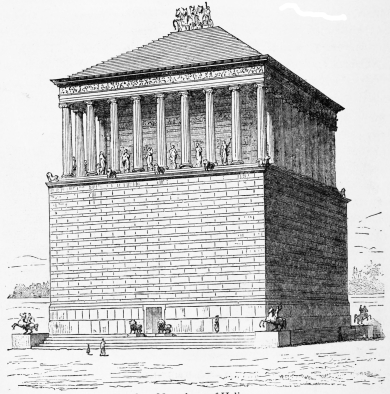
Fig. 180.—Mausoleum of Halicarnassos.
The Monument of the Nereides at Xanthos (Fig. 181) resembled the Mausoleum in many respects. It was a peristyle of sixteen Ionic columns elevated upon a massive foundation. Statues stood in its intercolumniations, while the zophoros and substructure were carved with reliefs. A gabled roof seems, however, to have indicated the sacred character of the edifice. The cella and the surrounding columns of this class of buildings were united in various manners,{253} a remarkable example of a pseudo-peripteros being offered by the so-called Tomb of Theron in Acragas in Sicily. In other instances three stories resulted from a duplication of the foundations beneath the peripteros, as in the alleged Tomb of Mikipsas at Constantina, the ancient Cirta in Numidia. This multiplication was particularly frequent in the Roman period. The tomb of this nature at Saint-Remi, in Southern France, the ancient Glanum, built during the reign of Augustus, is one of the most beautiful ruins known.
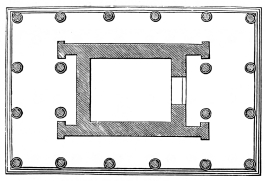
Fig. 181.—Monument of the Nereides at Xanthos.
Among the choragic monuments of Greece, the most interesting is that erected by Lysicrates in commemoration of the victory gained by a chorus of boys of the Phyle Acamantis led by him. It served as a pedestal for the prize bestowed, a tripod, and was a pseudo-monopteros of small dimensions and beautiful details. Engaged columns with Corinthian capitals supported a monolithic ceiling, the floral termination of which originally served as a base for the tripod. The so-called Tower of the Winds was a clepsydra, built by Andronicos Kyrrhestes, and was also furnished outside with dials and a weathercock. It is especially interesting on account of the peculiar forms of its Corinthian capitals. (Fig. 178.)
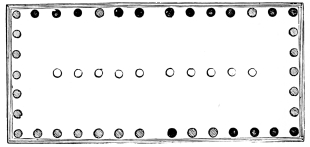
Fig. 182.—Stoa Diple at Thoricos.
The most extensive employment of columns in civic architecture was in the porticos, the stoas, which surrounded the market-places and extended through many streets, being connected with baths, gymnasions, palaestras, stadia, and hippodromes, and even appearing as independent buildings. The market-place, the agora, was, in ancient cities, commonly of an irregular form; when possible{254} it was surrounded by colonnades. In more recent settlements care was taken to provide a rectangular space for the purpose, in which double porticos of considerable extent were built for shelter in bad weather. In view of the effeminacy of the Ionians, it is easy to credit the account that this race first provided the chief places in towns with the protection of stoas, introducing this custom in Greece, where it soon became general. Extended colonnades were frequently connected with them, traversing the principal streets. The independent stoas, which were arranged in the greatest variety of combinations, are of particular interest. The Stoa Poikile (the many-colored), upon the market-place of Athens, was built by Peisianax, the brother-in-law of Cimon, this latter causing the walls to be decorated by Polygnotos and his assistants—upon one wing with scenes from the battle of Marathon, upon the other from that of Oinoe, while the long background of the principal hall was similarly treated. Upon the market-places the porticos were often increased in width by a second row of columns, and in later times a dividing-wall was frequently placed between these ranges as a spina. According to Pausanias, this was the case with the so-called Kerkyraion Hall of Elis. The form of a stoa diple, or double colonnade, was more customary; in it the central wall was replaced by a third range of columns, as the case appears to have been at Thoricos (Fig. 182), where the entrance was provided in the middle of the longer sides by wider intercolumniations. The enlargement was carried still farther by making the colonnade of three aisles, with two inner ranges of columns, as in the Stoa of the Hellanodikæ:{255} covered spaces of great breadth, open upon all sides, and admirably adapted to their purpose, were thus provided. It is natural to assume that the great grain market of the Piraios was such an extended stoa, as was likewise the so-called Basilica of Pæstum, a structure of three aisles, lacking exterior enclosure. The latter building is assuredly misnamed, the nature of a basilica being dependent upon outer walls. The prototype of the Roman and Christian basilicas is rather to be sought in the law courts of the Archon Basileus in Athens, a combination of enclosed halls and chambers, which, by their future development, received an historical and practical importance exceeding that of any other work of Hellenic architecture, not excepting the temples, which became useless with the extinction of Hellenic religious conceptions. The columns of stoas were multiplied above, as well as beside, one another, analogous to the galleries over the side aisles of the larger temples. This appears to have been the case upon the so-called Persian Hall at Sparta, where, instead of upper shafts, there were piers decorated with the statues of Persians, comparable to the corresponding architectural members of the Incantada at Thessalonica, though the figures of gods and heroes were, in the latter instance, attached to the supports in three-quarter relief, while the statues at Sparta appear to have been in the full round. It is evident from the Roman basilicas, to be considered in another section, that the employment of galleries was general in the enclosed stoas of Greece.
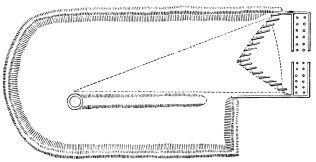
Fig. 184.—Hippodrome at Olympia.
Chief among the public buildings of Hellas, after the agoras and stoas, were the arrangements for the festive games. These were divided into two classes: bodily exercises and scenic representations. The former were the more important, forming a prominent part in the education of every Greek citizen. Palaistras and gymnasia were provided for the manœuvres, stadia and hippodromes for the public contests and races. In primitive times the palaistras had no architectural character; a meadow and a sandy reach, generally upon the bank of a brook and shaded by trees, sufficed as a training-ground. The private palaistras seem never to have exceeded this simplicity; but the great importance of drill for the military power of the State early demanded the erection of suitable structures, and there resulted the gymnasion, a combination{256} of covered chambers and halls with open courts, which provided separate and fitting spaces for the different gymnastic exercises and for the baths, as well as for the higher intellectual entertainments of the philosophers, rhetoricians, and poets. These structures were probably varied in character until the most suitable arrangement was decided by experience. It seems early to have become customary to surround a rectangular space by colonnades, to which were added extensive wings, semicircular exedras, and the like, for scientific and æsthetic instruction. Upon one side were grouped a number of chambers known as the Ephebeion, Apodyterion, Elaiothesion, Conisterion, Corykeion, Laconicon, Lutron, etc., serving the youths as places of assemblage, rooms for dressing and anointing, hot and cold baths, etc. Opposite to them extended the stadion, while, within the enclosure, promenades between groups of trees and beds of flowers alternated with grounds for shorter races, quoit-throwing, wrestling, and other contests. Some examples, like those of Ephesos, Hierapolis, and Alexandria, still display in their ruins the chief features of this arrangement, though more or less influenced by the customs of imperial Rome, where the baths had been in great measure separated from the gymnasia. The spirit of emulation was excited by the publicity of these institutions, and increased by the periodical festive competitions to a height far exceeding our modern{257} conceptions. A wreath of laurel or olive leaves, a small quantity of oil, a tripod, or other similar rewards of victory, such as were given as prizes in the games of Olympia, Delphi, Nemea, Corinth, and Athens, conferred almost divine honor, even the years being known by the name of the temporary hero of Olympia. The five chief divisions of the gymnastic exercises, the pentathlon—running, jumping, wrestling, boxing, and the throwing of the discos—were practised in the stadion, a space from 180 m. to 300 m. long, usually chosen close to the side of a hill, which, more or less prepared by terracing and grading, provided seats for spectators. If a narrow valley were near at hand, as in the case of the Athenian stadion of the suburb Agrae, the opposite slopes were thus occupied. The seats near the goal were naturally the more desirable, and it was here that the architectural features were concentrated, terraces being carried in a semicircle around this centre. Examples are not wanting, as in Aphrodisias in Asia Minor, where both ends were thus terminated, and the space for spectators carried around the entire race-course, thus pointing the way to a building of this form, the amphitheatre, which was to become the delight of the Roman world. The stadion of Messene (Fig. 183) shows how natural inclinations were followed and utilized, though at the expense of a symmetrical disposition; yet this example dates from the later extravagant period of Greek history, and is far removed from the patriarchal simplicity of primitive times. The stadion did not suffice for the races of horses and chariots which had been favorites with the Greeks since the Trojan war. In such early ages, any goal chosen in the plain was sufficient, like{258} the oak-trunk mentioned by Homer; but it could not have been long before the need was manifest of a sloping stand for the spectators and an enclosure for the contestants, and thus the hippodrome, the race-course, was developed similarly to the smaller stadion. The most celebrated, and perhaps the oldest, hippodrome of Greece, that of Olympia, is described by Pausanias. The right side, the longer, consisted of an artificial embankment of earth, while the slope of a hill was employed for the left; at the entrance was a colonnade devoted to the preparations of the charioteers. The starting-point, the aphesis, had, according to the expression of Pausanias, a form like the prow of a vessel—that is, advanced in a pointed form—to facilitate the start. The plan here given, Fig. 184, is altered from Visconti’s restoration by these gates being opened towards the first turning-point, the taraxippos, or terror of the horses.
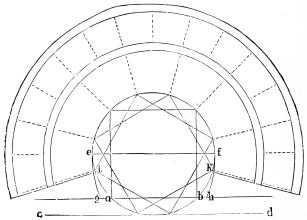
Fig. 185.—Scheme of the Greek Theatre, according to
Vitruvius.
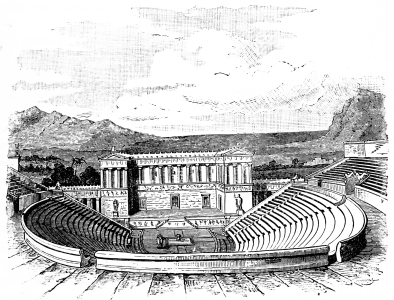
Fig. 186.—Restored View of the Theatre of Segesta.
The theatres, as enclosures for musical and scenic representations, offered greater scope for architectural development. When possible, the auditorium was in a situation where a natural semicircular inclination served instead of the immense foundations which would otherwise have been necessary for the elevated seats; the stage and surrounding buildings were, however, free-standing works of architecture. The arrangement of the Greek theatre is described by Vitruvius: three squares were inscribed in a circle, thus forming a{259} twelve-pointed star (Fig. 185); one of the sides, a b, served as the line of the front foundation of the stage. This platform, the logeion, was closed at the rear by a wall, treated like a façade, and forming a background, the skene; its position being decided by the tangent c d, parallel to the front side. The remainder of the circle, the orchestra, was reserved for the evolutions of the chorus and for the stand of the musicians, the thymele; it was not until the development of the Roman theatre that spectators were admitted to this enclosure. Its extent was slightly increased by drawing the outline from the diameter, e f, to the stage with a doubled radius. Around seven twelfths of the original circle was constructed the concentrical auditorium of ascending seats, divided by a platform at half-height, the diazoma, into two parts, and accessible by radial passages. The statement of Vitruvius, who, as usual, substitutes a thought-saving canon for the living individuality of Hellenic art, is not borne out by the numerous remains of Greek theatres. The orchestra and auditorium exceed the semicircle in every instance where local conformations have not rendered this impossible; but they either do this{260} by elongating the arc with tangents, as in the theatres of Segesta (Fig. 186), Syracuse, Tyndaris, and Tauromenion, or by continuing the circumference of the original circle without deviation, as in those of Athens, Epidauros, Megalopolis, Delos, Melos, Cnidos, Laodikeia, Side, Myra, Telmissos, Patara, Aizanis, etc. Among all known Greek theatres only two, those at Mantinea and Alabanda, are situated in the plain and entirely built of masonry; the others, contrary to Roman custom, utilize natural inclinations, as before explained. The seats were either cut in the native rock, or were walled and reveted with slabs of marble; when the slope was of earth, important foundations were undertaken.
The arrangements of odeions, or partially covered theatres for festive musical representations, appear to have preceded, and in some degree influenced, the architecture of the theatres. The oldest known example of these structures is the Skias in Sparta, a circular building provided with a pitched roof, which was probably built in accordance with forms customary in Asia Minor, as a Samian architect (Theodoros, the son of Telecles) was called from Samos to superintend its erection. The odeion upon the Ilissos near Athens appears to have been of similar disposition, and, like the former, constructed chiefly of wood.
The private dwellings of Greece stood in no relation to the monumental public buildings. That we are acquainted with no Greek house is a proof that these were of the same subordinate importance as was the family in the Hellenic state. The house was nothing more than the scene of the family labors, and turned modestly inward, confined and simple chambers being grouped around a central court. The life of the Greeks was, for the most part, spent away from home, upon the market-places and in the gymnasia and stoas; it was only at meal-times and for repose that he sought the retirement of his house. This was completely separated from the outer world, the dwelling-chambers having no windows upon the street and the façade being unimportant. The rooms, with the exception, perhaps, of the dining-hall, were but little developed, being generally lighted through the door alone. Their windowless walls presented no opportunity for architectural treatment, this being restricted to the court, a space of considerable size, surrounded by a{261} colonnade. For centuries there was nothing to lead to any increase of this simple dwelling, or to the development of a palace architecture; in the ages of the heroes and tyrants the constructive ability was insufficient, and later republican equality was inimical to all individual ostentation. It was not until royal power had, in the Macedonian epoch, taken the place of democracy that private architecture made a decided advance,—less, however, in monumental importance than in luxury and display. The chambers were multiplied by a repetition of the courts, the rooms still remaining small; while a refined extravagance, borrowing its decoration from the sister arts, took the place of architectural invention. Notwithstanding the Greek terms applied to various forms of rooms by Vitruvius, they appear to have been comparatively restricted in size. The so-called Corinthian hall, covered with a barrel-vault, is specifically a Roman creation; the Egyptian hall, with a clerestory over the central aisle, may have been built in remembrance of Alexandrian models, while that of Kyzicos is illustrative of methods customary in Asia Minor, and especially in Pergamon. The three chief cities of the Diadochi must have presented imposing monuments of private and palatial architecture: Alexandria, the Egyptian residence of the Ptolemies, had been founded by Alexander himself, and in great part designed by his architect, Deinocrates; Antioch, upon the Orontes in Syria, was built by Seleucos Nicator, with the aid of the architect Xenaios, and rapid increase soon quadrupled its original extent; Pergamon had been restored and enlarged by Eumenes. The wonderful works of that time show architecture to have lost all earnestness and truthfulness through the extravagant demands created by the luxurious courts of the Ptolemies, Seleucidæ, and Attalidæ; their sham theatrical pomp was surpassed only by the Oriental costliness and splendor of the materials. The monuments were expressive of the weakness and superficiality into which the Eastern Hellenic world had fallen, and for which the forms of Greek art were employed only as a transparent varnish. Alexander the Great had himself led the way to this profusion of monumental and private buildings. It was he, for instance, who had caused Deinocrates to erect a pyramidal pyre for the burning of the body of his favorite Hephaisteion, which was a marvel of tastelessness and{262} extravagance: the square substructure of brick masonry, with sides one stadion long, each ornamented with two hundred and forty golden prows of vessels and nine hundred and sixty statues, bore a second terrace decorated with golden wreathed torches; the third and fourth stages were reveted with reliefs of gold representing hunting scenes and the battles of the centaurs; the fifth with golden lions and bulls, upon which followed Macedonian arms and trophies taken from the barbarians. The whole was terminated by golden figures of sirens, the hollow bodies of which accommodated the singers of the funeral chant. A similar piece of display was the magnificent wagon for the funeral procession of Alexander. Other works were the gigantic tent for the Dionysian procession of Ptolemy II., Philadelphos, with its supports formed like palms and thyrses, with its cupola-shaped roof, secret grottoes, etc.; and the Thalamegos, or colossal Nile bark, a floating palace built by Ptolemy IV., Philopator, with its Temple of Aphrodite and many halls, one of which had chryselephantine Corinthian columns, and was decorated by a frieze of reliefs executed in ivory and affixed to a golden ground. A dining-saloon was built in the Egyptian manner, as a hypostyle, and the hall of Dionysos was provided with an apse formed like a grotto. At the same time, wonders of technical and mechanical skill divided attention with these works of barbarous luxury. As early as the time of Hiero II. of Syracuse, Archimedes and Archias built a monstrous ship, intended for the transportation of grain, which is said to have comprised an entire city, with a gymnasion, a public park, towers, reception-rooms, dining-halls, etc. It had three decks, and was propelled by twenty rows of oarsmen. Even this was surpassed by Ptolemy IV., who built a vessel with forty rows of oars. In short, gigantic dimensions and tasteless magnificence, favored by the insane competition among the followers of Alexander, extinguished true art, the more rapidly as works of these later ages were not executed with the solidity which preserved Roman architecture from similar decline, even though it accepted many unsound artistic influences from these Hellenic and barbarian despots.
{263}The sculpture deserves even more unlimited admiration than the architecture of Greece. Hellenic building shows monumental ideals such as the creative power of no other people has attained; yet the problems which presented themselves for solution were of a limited nature. In sculpture, on the other hand, a height was reached which the artists of all later times have scarcely been able to comprehend, far less to equal. For centuries cultivated nations have drawn from this inexhaustible fountain, in unconditional admiration,—learning from Greek statues, and acknowledging their matchless perfection. Although it may justly be concluded that a direct reconstruction of the architectural remains, as a whole, were it possible, is not to be recommended, still no one can hesitate to regard the best examples of Hellenic sculpture as a model worthy of direct emulation, the controlling influence of which upon the present age is only to be desired. And though the Gothic cathedral may appear to some a higher artistic conception than the Doric peripteros, no one would give preference to the sculptures of the ancient Orientals, of the Mediæval Christians, or even of the great masters of the Renaissance, over the marble treasures gathered in any of the larger collections of antiques.
As, among all the works of antiquity, it is to Hellenic sculpture that the undisputed palm of precedence is given, it is befitting that particular attention should be devoted to it—that it should be treated as the central point, the focus, of the history of ancient art. This is made possible by the accounts of classic authors handed down concerning it, and by the multitudinous remains preserved and accessible in the museums of all great cities; it is rendered easy by the circumstance that the attention and industry of the archæological explorer and of the student of art have been directed to no other field of antique life with equal zeal and with equally important results. The history of the development of Hellenic sculpture thus lies, in its main features, more clearly before us than does that of any other ancient art. Although different views still exist in regard to many particulars, the arguments advanced in their support only serve for greater general enlightenment. The lively discussion which the question of the beginnings of Greek sculpture has called forth may be considered as terminated, since the Egyptian origin, advocated by Thiersch, Ross, Feurbach, Julius Braun, Stahr,{264} and others, has been refuted, or at least reduced to the secondary and later influence assumed by Friedrichs. Indeed, the oldest Grecian sculptures, when compared with those of Egypt, display a complete contrast, and prove that such a connection, if it existed at all, was by no means intimate. Egyptian art worked upon purely mechanical principles, according to a typical network of lines. Sculpture was drawn into the province of architecture, and slavishly subordinated to it; carved figures became little else than architectural members through uniformity, symmetrical regularity, and multiplicity of repetition. Piers masked by the form of Osiris were thus substituted for columns, and long rows of sphinxes or colossal statues were set, like the obelisks, to decorate the avenues leading to the temples. The fixed standard after which the heads of such figures were patterned—more like the capitals of columns than imitations of life—and the members, without action, and constructed according to an established height or breadth, like the shafts of pillars, and similarly regulated in proportions by their diameter—took away all independence as works of sculpture, and caused the statues rather to appear as parts of an architectural composition. The ordinary Egyptian stone-cutter knew of only two positions, well established by custom; he renounced fundamentally the countless different appearances of life, and, with this, all representation of action and of individuality. Primitive Greek sculpture, on the contrary, arose from a sound naturalism, which directed the eye of the artist to real and peculiar appearances from the outset, often neglecting the proportions of the whole in the desire characteristically to express important details. The first Hellenic figures are wanting in that which was so prominent in the Egyptian: a correct, or at least a schooled, outline and modelling; while the pleasing imitation of life in detail, utterly foreign to Egyptian sculptures, is most forcibly presented. This naturalistic tendency prevented Hellenic sculpture from degenerating into an Egyptian formalism; the Greek artist did not blindly attach himself to a hieratic model, but studied organic life, thus keeping his works free from that ossified conventionalism common to all Eastern civilization. The very first carvings of Greece had a power of development which was wanting in all the other nations of that period.{265}
To these differences of artistic principle must be added differences in characteristic forms, dependent partly upon race and partly upon the different conceptions of the two nations—differences so marked as to enable us to distinguish their works without hesitation. The Egyptian head differs decidedly from the Greek head in the high position of the ear, the long, narrow, and somewhat obliquely placed eyes, the wide flat nose, and the thick lips. (Fig. 28.) The Egyptian figure is slim, the primitive Greek almost stunted; in the former the shoulders are high and broad, in the latter sloping and narrow; there the hips are small, here large. The garments of Egyptian works are either elastic, without natural folds, clinging so closely to the body as often to be recognizable only at the borders, or are heavily pressed together in broad and angular masses. The scanty clothing introduced into ancient Hellenic sculptures shows throughout a close observation of nature; and the drapery is pleasing even in unsuccessful imitations, because it betrays the loving care of the artist. In the oldest productions of Greece we perceive a slumbering genius and capacity for development which were wholly lacking in the trained handiwork of Egyptian art,—as the faulty free-hand drawing of an intelligent boy, who tries to show what he has seen, awakens greater interest and hope than do the labored copies and tracings of an illiterate mechanic.
When compared with these weighty reasons against the dependence of primitive Grecian sculpture upon that of Egypt, the arguments adduced in favor of the supposition seem insufficient. Chief among these is the opinion of several ancient writers who vaguely imply that the oldest sculpture of the Greeks was related to that of the Egyptians, and derived from it as a later production. But it is well known that Pausanias and Diodoros were not exacting as to proofs of their opinions in regard to the history of art. In this instance, they were deluded by the same outward resemblance which has been so deceptive in modern times,—a similarity dependent upon that stiffness of archaic statues common to every primitive art, and to the attenuation and union of the extremities, which resulted from the economy of material and labor natural to both countries. But though, in the beginning of Greek sculpture, certain difficulties of execution were avoided in the same manner as in Egypt, and the{266} material of the carved figures, whether wood or stone, was meted out as scantily as possible, it does not follow that they were directly dependent upon the Egyptian works which were influenced by like considerations.
It is otherwise with the relations between Western Asiatic art and the early sculpture of Greece. The preceding section has made it evident that the most prominent characteristics of the Ionic style were developed from this root, and the influence of Asiatic motives was as marked in regard to the sculpture as to the architecture of Hellas. The fully perfected flower, however, but little betrays an Oriental derivation in either province. The art of Asia Minor and of Syria had taken an essentially different starting-point from that of Egypt—one more nearly allied to the Greek point of view. Instead of formulating the human figure by a fixed canon after the manner of the Egyptians, it looked to nature itself, with a decided realistic tendency. But in its later development, as already shown, Mesopotamian art went as much too far beyond reality as that of Egypt had remained behind it; and the self-sufficiency of the Eastern despotisms resulted in that utter standstill which checked the life of art in Assyria, Persia, and Phœnicia. The acquired forms, as upon the Nile, stiffened into conventional types, with the difference that those of Egypt took more the character of a written chronicle, those of Mesopotamia and its dependencies more that of ornament. Hellenic genius could only remain upon such a low level during its immaturity; there are, therefore, almost no traces of direct Asiatic influence evident in the sculptures of Greece after the most primitive period, although in this it is unmistakable. We may call this period of development the heroic age, and understand by it the epoch from the earliest times to the first Olympiad, 776 B.C. Even the native legends concerning the beginning of Greek art point towards the East. The mythical founders of monumental buildings, the Cyclops, to whom were ascribed the oldest stone sculptures, like those upon the Lions’ Gate of Mykenæ, came from Lycia. The Dactylæ appear in groups upon the mountains of Phrygia and Crete often bearing names characteristic of their significance as cunning artisans—Kelmis, Damnameneus, and Acmon (hammer, tongs, and anvil); while the Telchinæ—Chryson, Argyron, and Chalkon (workers in{267} gold, silver, and copper)—inhabited Rhodes. The personification of various metal-workers in these mythical guilds is unequivocal, and the attributed locality of their dwellings has a corresponding meaning, pointing to the coasts of Western Asia, where the process of overlaying wooden carvings with beaten metal was predominant, as in Phœnicia and the intermediate island of Cyprus. This empaistic work, of plates shaped upon a model by hammer and punch, presupposes the carving of the model itself, without which the creation of the sphyrelaton was obviously impossible. The gold overlaying of Solomon’s Temple was formed upon reliefs carved in cedar-wood, and was, perhaps, beaten over them: before the discovery of bronze-casting, we may conclude this also to have been the case with works of statuary in the round. The art of sculpture in wood seems to have been native among the early Greeks; carved idols, xoana, soon appearing as substitutes for those stones and trunks of trees (Paus. vii. 22), which, provided at times with the attributes of trident, caduceus, lance, or sceptre, were at first worshipped as divine symbols. These were frequently so old that no account could be given of their origin, and they were consequently said to have fallen from the skies. It is difficult adequately to conceive the rudeness of these most ancient xoana. The arms were not at all separated from the body, and were indicated only in as far as was necessary to attach to them characteristic attributes, like the garment and spindle in one hand, and the lance in the other, of the Trojan Athene described by Homer. The sacred figure was frequently quite covered with real doll-like clothing, as is the Virgin or the Bambino in many modern places of pilgrimage provided by the Roman Catholic Church. The difficulty of representing the hair of these puppets appears, from the later treatment of the heads in marble, as seen in the Apollo of Tenea, to have been evaded by the use of a woolly covering like a wig. The want of definition in the faces is evident from the statement that some xoana had closed eyes. This is not to be explained by the pious legends of antiquity that the image had refused to look upon some deed of sacrilege,—such, for instance, as the rape of Cassandra,—but by the fact that the eye was indicated only by a horizontal painted line. It was from such rude figures that Daidalos advanced. It was not only said that he was the inventor of various instruments for wood-working,{268} such as the axe, saw, auger, and plummet; but certain improvements in the shaping of the statues were also ascribed to him, such as the opening—that is to say, the formation—of the eye, and the separating of feet, as if in the act of stepping. The progress cannot, in fact, have been great. The traditional account that the images had to be bound after the freeing of their legs, to prevent their running away, must not lead us to imagine an ideal perfection, or, indeed, any striking resemblance to life. The classical authorities who knew the works attributed to Daidalos say, indeed, that they were “wonderful to look upon,” and that “the master would have made himself ridiculous by such works in our day.” The personality of Daidalos is hardly better assured than that of the mythical workers in metal, the Dactylæ and Telchinæ; the name itself, signifying the cunning workman, is nothing else than a personification of artistic skill, a collective term for all primitive skill and activity in wood-carving. As this had developed from handiwork, the legend calls the father of Daidalos, Palamaon, the contriver, or Eupalamos, the skilful artisan. The travels which Daidalos is said to have made from Athens to Crete, Sicily, Thebes, Pisa, Egypt, etc., merely result from the appearance of so-called Daidalian works in those places. In the time of Homer, the ninth century B.C., these images were already regarded as of great age; so that the period of the beginning of Greek sculpture must be at least as remote as the tenth century B.C. The one statue directly mentioned in the Iliad, the sitting Athene at Troy, upon whose knees the Trojan women laid a garment, appeared to the author of the Homeric epics to be a work in the manner of Daidalos. If another passage (Iliad, i. 14) may be understood as referring to an image of Apollo, this must, like the Athene, have been at least partially covered with real clothing. Such figures were also overlaid with metal; it is not to be doubted that the gold and silver dogs, and the youthful torch-bearers of gold, in the Palace of Alkinoos were carved models of wood covered with beaten plate. The empaistic process, native to Phœnician countries, was early imitated in heroic Greece. Though the island of the Phæacians was idealized by the fancy of the poet, he yet cannot be supposed to have invented new technical processes in an account which was to be generally intelligible. It seems, however, that sculptural art had no great{269} range during the heroic ages; perhaps the works overlaid with beaten metal, which were known to Homer, may have been the results of an accidental and superficial knowledge gained by intercourse with the Oriental peoples inhabiting the coasts of Western Asia.
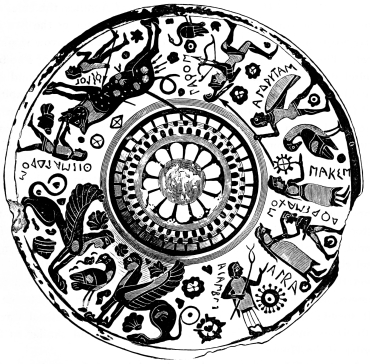
Fig. 187.—Cover of Dodwell’s Vase, in Munich. Full
size.
The manufacture of furniture and smaller decorative objects was probably more important. Homer was acquainted with the use of the lathe; while relief-carving in wood, and inlaying of metal, ivory, and amber, were early practised. The latter process can also be referred to Phœnician influence, in consideration both of the materials employed and of historical analogy. Even kings busied themselves with such handiwork, as the building of his nuptial couch by Odysseus proves; and royal ladies, such as Penelope, Andromache, and Helen, embroidered and wove elaborate textures. Professional workmen are also mentioned: Icmalios was the maker of Penelope’s seat; and some productions of this nature, like the chest of Kypselos, were as late as the beginning of the historical ages of Greece. Sculptured utensils of metal, vessels, tripods, and weapons, are particularly and distinctly described in the Homeric epics. The jars and vases described as “embossed with flowers” may be imagined as decorated with wreaths, like those found in Assyria and on Cyprus, and as similar to the early Italian bronzes. Cups with knobs (Iliad, xi. 633) were discovered in the excavations at Nineveh; conventionalized animals, serpents and birds (Iliad, xi. 17 and 634; Odyssey, xi. 610, and xix. 227), are to be found upon many primitive vases, and may be supposed to have existed as handles to vessels as well as upon clasps, sword-belts, and armor. References to the Asiatic derivation of the bronze-works known in prehistoric Greece are given by Homer, who mentions craters from Sidon and a Cyprian coat of mail. The shields were especially rich, being formed by several thin plates of metal secured one over the other; every disk was of greater circumference than that above it, only a narrow concentric rim of each thus remaining visible. The inner circle alone upon the comparatively simple shield of Agamemnon (Iliad, xi. 32) was ornamented with sculpture, in this case a Gorgoneion, the outer edges being provided with ten knobs of tin; upon the handle was a three-headed dragon. The shield of Achilles (Iliad, xviii. 468) was wonderfully elaborate, and, as the work of Hephaistos, probably exceeded by far the ordinary ornamentation{270} of heroic arms; but it does not, on this account, give less reliable information concerning the general form and nature of prehistoric armor. Five layers of metal were superimposed,—two of bronze, two of tin, perhaps alternating, that in the centre being of gold; four rings were thus formed around the inner circle, each covered with rich sculptural decoration. Symbols of earth, sea, and sky, with the sun, moon, and stars, were within the golden disk. Upon one side of the first concentric band was shown a city in time of peace, with a wedding procession and a court of justice; upon the other a besieged city, with a sally of the defenders and a general engagement. Upon the second ring were the four seasons, indicated by ploughing, harvesting, the vintage, and by a herd of peacefully grazing cattle attacked by lions. A harvest dance of youths and maidens, before whom was a singer with a harp, decorated the third ring; while the fourth and outermost, probably narrower than the others, was ornamented by waves representing the sea, which, according to the conception of the ancients, surrounded the circular land of the earth. The figures were cut from thin sheets of different metals, and were riveted to the ground; it is uncertain whether these were first beaten to a relief, or were left flat, giving the effect of a silhouette. The metals were naturally chosen of colors different from that of the band to which they were affixed, and the treatment, in principle, thus somewhat approached the art of painting. The ground and the vineyards, in the pictures of the seasons, were of gold, yet “the grapes shone blackish;” the poles appear to have been of silver, the trenches of iron, and the hedges of tin, while upon the dancers “hung golden daggers upon silver straps.” Such empaistic work must have been more closely related to surfaces of inlaid metal upon wooden forms than to the statuesque Phœnician sphyrelaton. Homer’s account of the shield of Achilles should be considered not from a technical, but from an artistic, point of view. The vivid description is, of course, due altogether to poetical license; but we may well believe that subjects like the harvest dances, festive processions, warlike scenes, symbols of the seasons, etc., may have been attempted upon utensils and weapons, though in a more simple and decorative manner, their object not being an artistic setting-forth of details, but an intelligible indication of the whole. With{271} what limited means this is possible is proved by Egyptian coilanaglyphics, Assyrian reliefs, and the paintings upon Greek vases of the most primitive style. (Fig. 187.) The artist of the heroic age cut his figures from thin sheets of metal, just as children snip paper, and set them together upon the background, filling up the intervening spaces as best he might with ornaments and names. Direct Oriental models were hardly needed for this; but it is probable that, as in the sphyrelaton, the influence of Asia Minor was felt: the conventional character of the types painted upon the oldest Greek vases bears distinct evidence of a Phœnician impulse. There was little that was artistic in the details of such early decorations, but all the more in the conception as a whole: the manner of expression was weak, but the thought was admirable. Figures appear upon Assyrian{272} sculptures, so similar to those described by the poet that by their help one might almost reconstruct the Homeric shield; in Mesopotamia, however, the representations lacked unity in the fundamental conception, they were not well grouped in the given space, and appear, as Brunn says, like a chronicle written in figures when compared with such a poem as the artistic compositions, made up, perhaps, of the same elements, described by Homer. The pseudo-Hesiodic shield of Heracles resembled that of Achilles, the chief difference in outward form being that the three inner of the five circular layers were bordered upon the outer edges by narrow rings of steel. The middle plate was decorated with the head of Phoibos, encircled by twelve serpents like a Gorgon. The next band displayed a warlike scene and one of peace: the combat of the Lapithæ and Centaurs in one half, and Apollo among the Muses in the other. The third had a like contrast between a besieged and a peaceful city, similar in composition to those upon the shield of Achilles; while the fourth was also a representation of the seasons, chiefly distinguished from those of Homer by the substitution of a hare-hunt as the symbol of winter. The reliefs upon the four narrow steel rings must have differed in action from the larger groups; in the latter the radial lines of the upright figures prevailed, in the former a contrary movement was predominant. On the innermost steel ring boars and lions moved concentrically around the shield; upon the next following was an arm of the sea, over which flew Perseus, pursued by the Gorgons. The third was a chariot-race at full speed; and upon the outer rim were conventionalized waves, with fishes and swans, forming an ornamental band similar to the border of the Homeric shield.
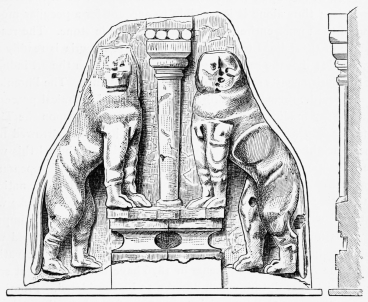
Fig. 188.—Relief from the Gate of the Lions at Mykenæ.
Our knowledge of the sculptural activity of Greece in the heroic ages has, up to the most recent times, been derived almost entirely from the poets, whose idealized descriptions are supported, in regard to form, only by the analogy of Assyrian reliefs and the paintings upon archaic vases. Works of a primitive period have, indeed, not been entirely wanting; but it being impossible to date them, they lend no aid to an historical consideration. The derivation and age of only two are assured, and the characteristic forms of one of these—the Niobe upon Mt. Sipylos, near Magnesia, mentioned{273} in the Iliad, xxiv. 613—are entirely obliterated. It is so rudely executed, or so weather-beaten, that even in antiquity it appeared to Pausanias, even when seen from the immediate vicinity, as but a shapeless rock, in which the human figure was scarcely to be recognized, while, at a distance, it resembled a woman bowed down with grief and weeping. The account has been verified in recent times by the discovery of a rock-cut relief of three times the size of life, so disintegrated that satisfactory drawings of its human forms could not be made. This renders the other pre-Homeric monument, the most ancient known sculpture of Greece and of Europe, all the more important—namely, the relief over the gate of Mykenæ, called by the poet that of the Lions—the chief portal of the fortress of the Atridæ, the witness of the departure of Agamemnon for the Trojan war, and of the downfall of his house on his return. (Figs. 188 and 126.) The structure has been already described from an architectural point of view. The relief upon the slab which closes the triangle above the lintel represents two lions standing{274} upright upon either side of a column; their heads, turned outward, were separate pieces, fastened with dowels to the background, and have disappeared. The designation of these animals need not be deemed erroneous because they have no manes. Pausanias speaks of them as lions (though this in itself may not be of great weight), and in the Phœnician examples of beaten metal-work, as in the archaic paintings upon Greek vases, the indication of hair is always wanting. The Asiatic influence which, in architectural respects, had made itself felt upon the Tholos of Atreus, must be acknowledged here also; thus alone is it possible to account for a peculiar modelling of the forms, entirely foreign to sculpture in stone. The resemblance of these lions to the animal figures of Assyria is readily recognizable; it is the same resemblance as that which the art industry of the Syrian coasts showed to that of Mesopotamia. The Phœnician tradespeople, themselves skilled in many novel technical processes, formed the medium between the cultured countries upon the Tigris and the Ægean Sea. The Lycian Cyclops had also borrowed from these neighbors, and to them was traditionally attributed this wonderful stone carving at Mykenæ, a work which, from all appearance, was an isolated attempt. Such sculptures could not become national and native so long as the requirements of the heroic Greeks were satisfied with the mere decoration of useful objects. The impulse towards monumental art seems first to have been awakened with the introduction of the columnar temple. Schliemann’s excavations upon the Acropolis of Mykenæ in 1876 have brought to light some few works of sculpture which deserve to be considered. Prominent among them are the memorial stones, two of which are shown in Fig. 189. They are remarkable for a naïve primitiveness of conception and the desire to display the subject chosen as distinctly as possible. A vigorous action and a certain observation of nature are not lacking, though the forms are incorrect, both in general effect and in detail. The similarity of these works to Asiatic sculptures is marked; but no trace of Egyptian influence is to be recognized in the attenuated figures. The same derivation is evident in the spiral ornaments, which closely resemble those upon the façade of the Tholos of Atreus, and upon Phœnician and Cyprian remains. All the reliefs imply models of beaten metal, and lend further support to the{275} hypothesis which connects the heroic age of Greece with the civilization of Western Asia, through the medium of Phœnician traders.
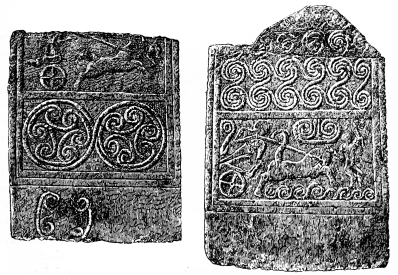
Fig. 189.—Steles from the Acropolis of Mykenæ.
The golden masks found in the graves are not less interesting, whether the assignment of these to the Homeric worthies—Agamemnon, Eurymedon, etc.—be accepted or not. (Fig. 190.) It is at least certain that they are memorials of the heroic age, and the great quantities of gold found in the sepulchres make it probable that they appertained to a royal race, and were buried at a time when the prosperity of Mykenæ was great and its power extensive. The masks, like the grave-stones, are formed with the helpless realism peculiar to the art of Western Asia, and entirely foreign to that of Egypt. It is easy to believe that they were imported directly from Phœnicia. This must certainly have been the case with the beautifully executed ornaments of gold—disks, diadems, stars, etc.—the beaten workmanship of which is of a perfection only possible to trained and practised manufacturers. The spirals and other linear designs are executed with exceeding accuracy, by peculiar instruments. Their motives are taken from the animal and vegetable world, from cuttle-fishes, butterflies, and various forms of leaves{276} and flowers. It is certain that the perforated cylinders, cut, like gems, in intaglio, with scenes of war and hunting, were introduced directly from Asia; they are strikingly similar to the rolling seals of carnelian and agate found in Mesopotamia. A small model of a temple is peculiarly Phœnician, like that repeated upon Paphian coins.
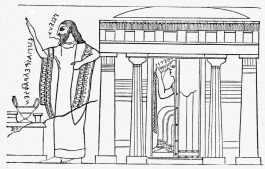
Fig. 191.—From the Vase of Clitias and Ergotimos.
During the first two historical centuries, after the commencement of reckoning time by Olympiads, the direction of activity in art appears to have changed but little. Sculpture, represented by guilds, or families, of handicraftsmen in Athens, Argos, and Sikyon, remained little else than decoration, though, at least in the selection of subjects, it opened for itself new fields. In the heroic ages the scenes were limited to the most immediate realities; but, after the Homeric epics had become the property of the nation, the picturesque treasures of many legends became available. Arctinos of Miletos, in the middle of the eighth century, and, somewhat later, Lesches of Lesbos, continuing the Iliad, sang of the downfall of Troy. Stasimos of Cyprus chose preceding events as his theme; while the myths of the Seven against Thebes, of the Titanomachia, and of the exploits of Heracles and Theseus found similar epic illustration. These poems not only provided the subjects for sculpture, but described them with plastic vividness. This is shown by the two chief works of this period,—the Chest of Kypselos and the Throne of Apollo at Amyclæ. The first was an oblong shrine of cedar-wood, which Kypselos, tyrant of Corinth, consecrated in the Heraion of Olympia, in memory of his preservation as a child, when, hidden in a fruit-box, he had escaped from the persecution of the{277} Bacchiadæ. This chest, either upon three sides—the fourth standing against the wall—or upon the long front side alone, was ornamented with carvings, in five bands, one over the other, probably of unequal height. The reliefs, partly inlaid with ivory and gold, must have been of a workmanship similar to that customary in the heroic ages. The uncommonly rich and varied representations, almost exclusively mythological and heroic, were taken from the before-mentioned cyclic poems (Pausanias, v. 17 to 19). The figures appear to have somewhat resembled in style those upon the Vase of Clitias and Ergotimos in Florence (Fig. 191), which, on account of its banded arrangement and the similarity of its mythical subject, deserves, rather than the cover of Dodwell’s vase given above (Fig. 187), to be compared to the Chest of Kypselos. The Throne of Apollo at Amyclæ, near Sparta, has been connected with the name of one of the oldest artists known, Bathycles of Magnesia, who lived half a century later than the maker of the Chest of Kypselos. This throne also has been minutely described by Pausanias (iii. 18 to 19). In regard to its sculptured decoration, his account of its construction is unintelligible; it is only clear that the framework was colossal, and that the ancient doll-like image stood within it, without any seat. Not less than forty-one scenes, besides the larger compositions upon the pedestal of the statue, covered the outer and inner sides of the throne with carvings in low-relief, similar in style to those of the Chest of Kypselos. Upon the legs in full, or at least in three-quarter, relief were figures of the Graces, the Hours, Tritons,{278} etc.; upon the back were portraits of the master and of his Magnesian assistants, besides sphinxes, panthers, and lions.
These works were still chiefly of a decorative character. Monumental sculpture had not yet freed itself from the trammels of inadequately developed technical processes. So long as the artisan had no choice other than the sphyrelaton and the xoanon, a material foundation was wanting for the development of an independently artistic sculpture. Even when isolated works of a higher order were attempted, as in the colossal Zeus, of beaten gold-plate over a wooden form, dedicated in Olympia by Kypselos or his son Periander, they can be considered, like the other sphyrelata of this and of the heroic age, only as figures of great material value but of little artistic importance. Want of skill in execution favored that clinging to old honored types of devotional figures inherent in the nature of all religions. These influences stood in such close, interchangeable relations that it is impossible to say whether, in the province of sculptured images, the slowness of progress should be placed more to the account of religious prejudices and the difficulties thrown in the way of all change by hieratic institutions, or of the technical limitations of doll-like xoana and sphyrelata.
New mechanical acquirements were needed for the furtherance of the art. Three great discoveries, or, to speak more correctly, the extended application of known processes, date from the beginning of the sixth century B.C.: the casting of bronze, the sculpture of marble, and chryselephantine work (the inlaying of gold and ivory upon a wooden kernel). Each of these had its gradual development, at least the first and the last being furthered by auxiliary inventions. It was indispensable for the casting of bronze that modelling in clay should have attained a certain perfection. The name of the Sikyonian potter Boutades is connected with the introduction of this branch of art; it appears to have been in the middle of the seventh century B.C. that he ornamented the acroteria and antefixes of the temple roof, first with low-relief (prostypon) and then with high-relief (ectypon). He also left a portrait panel in terra-cotta, shown in the Nymphaion of Corinth until the destruction of that city as the first work of its kind. In connection with it was told the pleasing anecdote that the daughter of Boutades, in taking{279} leave of her lover, sketched his shadow upon the wall with charcoal, the father afterwards filling out the outline with clay and burning the relief thus produced. Neither of these accounts are of great direct value, but that a potter could achieve a lasting reputation as an artist may perhaps show that modelling in clay had already made essential progress, and thus prepared the way for brass-founding, which requires an original and mould of this more plastic material. The discovery of soldering was also not without significance; it formed, in metal work, a connecting link between the riveting of the sphyrelaton and casting, even indispensable to larger statues of the latter process, which, at least in the beginning, were executed in pieces. Soldering seems first to have been employed upon iron. Glaucos of Chios attained great results by this means, and attracted general attention to it in the seventh century B.C. His iron crater-stand, dedicated at Delphi by Alyattes, was an elaborate work, ornamented upon the legs and clasps with sculptured animals and plants.
The way was thus prepared for monumental bronze-founding, which was not, indeed, discovered by the Samians Rhoicos and Theodoros, the sons of Phileas and Telecles, to whom it was attributed by antiquity,—for, as has been seen, it was practised by the Phœnicians,—but was by them first introduced into Greek art. The dates assigned to their epoch vary from the beginning of the seventh to the middle of the sixth century B.C.; but it is the more reasonable to place them, with Brunn, at the close of this period, without supposing that there were two masters by the name of Theodoros, a father and a son. The innovation probably began with the solid casting of smaller works, but whether Rhoicos and Theodoros were limited to this is at least doubtful. Economy of material and the lessening of weight in figures of great dimensions must soon have led to hollow casting upon a fire-proof kernel; it is possible that it was this very progress that made the two artists celebrated as discoverers. The development of their technical improvements seems at first to have impaired the artistic aspects of the works; Pausanias says of a female statue by Rhoicos, probably in the Temple of Artemis at Ephesos, that it was even more archaic and rude than a figure of Athene in Amphissa which was there held to be Trojan. That the two Samians also practised in beaten metal work is clear from the{280} colossal silver mixing-vessel, containing six hundred amphoras (about 200,000 litres), executed by Theodoros and dedicated at Delphi by Crœsus, from a golden vine with grapes of mounted jewels, and a golden plane-tree in the possession of the Persian kings; the latter works remind us of examples of similar workmanship in the Assyrian palaces, the existence of which has been proved by the fragments of palms in gold-plate, lately found by Place upon a portal in the palace of Sargon, at Corsabad. If Theodoros worked thus extensively in the precious metals, it is not surprising that he produced such small toreutic objects as those indicated by the legend of the ring of Polycrates, ascribed to him, and the fabulous portrait statue of a man, with a quadriga in his hand which a fly might have covered with its wings.
A still more brilliant future was open to the second innovation, that of sculpture in marble. Chios was the birthplace of Hellenic marble statuary, as Samos had been of bronze-casting. Coarse stone had been employed from the earliest times, in isolated instances like the relief over the Gate of the Lions at Mykenæ, for figures and for small images; and the introduction of marble statuary was older than bronze-founding, for Melas, ancestor of a long race of sculptors in Chios, lived about the middle of the seventh century B.C. Of Melas himself and his son Mickiades little except the names are known; an artist of the third generation, Achermos, could venture to represent a winged Victory, yet even he was surpassed by his sons Boupalos and Athenis. It is evident, from several notices, that marble sculpture flourished greatly under these latter, who, living about 540 B.C., had become very particular in the choice of material—using only the fine-grained and translucent Parian lychnites. No one venturing to dispute their precedence, they could place upon their sculptures, exhibited in Delos, the self-conscious inscription: “Chios is celebrated, not alone for its vineyards, but for the works of the sons of Achermos.” Numerous works by them are mentioned by ancient visitors, being collected in later times by princely dilettanti. Augustus employed such sculptures upon the exterior of many of his buildings, notably in the gable of the Palatine temple of Apollo; he had an especial and, as it appears, a not ill-founded liking for them, and these works could not have been a disfigurement,{281} even to the universal magnificence of imperial Rome. An explanation of this marked advance at so early a date is given by this very fancy of Augustus: the works thus architecturally utilized could not have been devotional images of the deities; they must have been decorative sculptures. The former class, from reasons already touched upon, were hindered in artistic progress; the latter being beyond the jurisdiction of hieratic institutions, developed untrammelled. It was only in ornamental figures that the assiduous and talented sculptors of early times found free scope, and it was fortunate that the demand for these architectural and decorative works must naturally have been greater than for the more rare devotional images, which were piously transferred from the older sanctuaries to the new buildings which took their place. The gable groups of Ægina show how unequally art advanced in these different and distinct fields.
During the time of Boupalos and Athenis, art began to flourish in other places than Chios. First in Sikyon, with the two Cretans Dipoinos and Skyllis, who may have been even older than the last Chian masters. They were called, it seems, to Sikyon, and there chiefly employed their energies in founding a school, changing at times the site of their labors to Argos, Cleonæ, and Ambrakia. Like the masters of Chios, they chiefly employed the marble of Paros, and it appears, from the accounts of a group representing Apollo, Artemis, Athene, and Heracles, that they too sought their fame less in devotional images for the interior of temples than in monumental compositions for architectural ornament. Although these Cretan sculptors, according to the testimony of Pliny, acquired great celebrity in marble working, they are more important as the founders of the third among the statuesque arts above mentioned—that process of gold and ivory overlaying which culminated in the greatest masterpieces of Pheidias. It seems to have originated from the native xoana of early times, by transferring the inlaid decoration observed upon the furniture of the heroic ages to sculpture in the round. It developed in plainly distinguishable stages. Dipoinos and Skyllis still only in part covered the carved core of wood, and restricted this overlaying to ivory. This is illustrated by the accounts of a group of the mounted Dioscuri, with their mistresses{282} Hilasia and Phœbe, and their sons Anaxis and Mnasinos, in the Temple of the Isius at Argos, which was cut out of common wood and ebony, the former being covered with ivory. Statues were made by Hegylos and his son Theocles, scholars of Dipoinos and Skyllis, for the treasure-house of the Epidamnians in Olympia, which represented Heracles with the Nymphs of the Hesperides, and Atlas bearing the heavenly globe; Pausanias describes this work as cut from cedar-wood, and the serpent and the tree with the golden apples of the Hesperides must certainly have required the inlaying of gold, if not of ivory. The author particularly mentions the employment of gold upon another group: the struggle of Heracles with Acheloos for Deianeira, the work of Donycleidas and Dontas of Lacedæmonia, also scholars of the Cretan masters. The perfection of the chryselephantine process seems early to have been obtained, the wood, before in great part visible, was by the latter artists used only as a kernel, being completely covered with ivory and gold. This was, at least, the case with the Themis of Donycleidas in the Temple of Hera at Olympia. That Pausanias considers these statues extremely archaic must be understood as a relative judgment; it is to be borne in mind that works by which a new process is introduced are always of a primitive and imperfect appearance, if not artistically backward. A sphyrelaton of beaten copper-plates riveted together was still possible to this school, for a figure of Athene Chalkioicos at Sparta was the work of Clearchos of Rhegion, a member of this guild. The sphyrelaton was, indeed, nearly related to chryselephantine work which was virtually a combination of the sphyrelaton with the ancient xoanon. The Æginetan Smilis, of this group of scholars, was celebrated as the first great artist of his island. His connection with the Cretans is more certain than with the later sculptors of Ægina; if he should prove to be older than the native Sikyonian masters, as has recently been asserted, this would add another site to the primitive schools of Greek art.
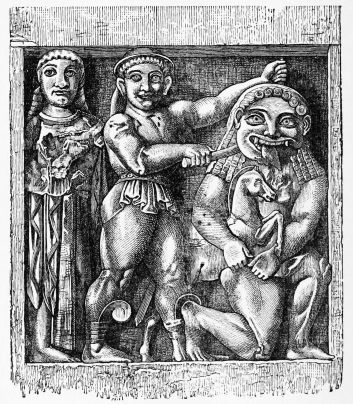
Fig. 192.—Metope Relief from the Middle Temple of the
Acropolis of Selinous.
The history of sculpture, drawn from the remarks of ancient writers, would bear only upon the development of these technical processes, and would give but little information concerning the style of this period, if it were not possible to compare their accounts with several ancient monuments which by great good-fortune have been{283} preserved to our own time. But it is necessary here not to overlook one point which is frequently lost sight of altogether—namely, the local differences betrayed by works of one or the same epoch. Examples of archaic stone sculpture are presented by European Greece, by the Hellenic colonies of the East in Asia Minor, and by those of the West in Sicily, which show the two latter provinces to have followed a somewhat different course of artistic development, and even the works of the Peloponnesos early to have betrayed considerable variations, in conception and in principle, from those of the more northern tracts of the Continent. Among the provincial monuments, the first to be noted, because the oldest known, are the metope reliefs upon the middle temple of the Acropolis of Selinous in Sicily. The city was founded about 628 B.C., and, though this temple may not have been the first built in the new colony, it must be considered as dating at least from the first half of the sixth century. Among numerous fragments of the metope sculptures two tablets have been preserved almost uninjured which are of the greatest value from the plainness with which they express both the artistic advance and the imperfections of this early age. It would be a mistake, however, to see in them representatives of the sculptural style of Greece proper, for they betray in many respects the peculiar influences of Sicilian Doric. In as far as the artistic understanding of the works permitted, they evince a fresh and sound naturalism, and a careful observation of the living model. But this did not extend beyond the more independent members; while arms and legs, hands and feet, are relatively excellent, the body and head are disagreeably heavy, rude, and ill-proportioned. This contrast is particularly noticeable in that of the two reliefs which represent Heracles carrying upon his bow the two Kercopes. The more successful modelling of the details of the limbs shows it to have been the work of an abler artist than the other (Fig. 192), where Perseus, in the presence of Athene, cuts off the head of Medusa. The deity, with naïve helplessness, turns her right foot sideways, though otherwise facing entirely towards the front; the insufficient depth rendered it impossible otherwise to give the foot its full length, and the artist was perhaps withheld from a more correct form by an unconscious dependence upon the more familiar style of low relief.{284} The left leg of the Medusa appears, on account of the confining frame, too short by half, and the little Pegasos stands upon long, kangaroo-like hinder legs, in order that the body may come within reach of the arm of Medusa. Yet the weakness of the transition from the front view of the upper body to the profile of the legs is less striking than in the Egyptian and Assyrian sculptures, and both Perseus and Heracles are wholly free from that typical petrifaction which characterized the art of the Nile and of the Tigris. In spite of the first impression made by the monstrous and disproportioned figures, these works have, with all their imperfections, the peculiar charm of earnest effort, which is the guarantee of ultimate success.{285}
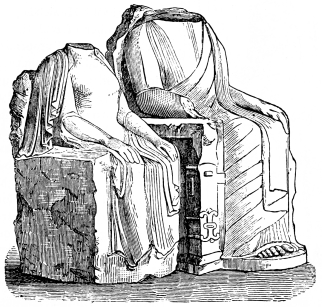
Fig. 193.—Statues from Miletos. British Museum.
The most ancient Hellenic sculptures of Asia Minor do not show the same self-reliance and direct study of nature. There the influence of Mesopotamia, Phœnicia, Cyprus, and even of Egypt was so strongly felt that art could not remain wholly free from canonical tendencies, and did not develop simply and directly from natural models. The sitting colossal statues which flanked the sacred way from the port of Panormos to the Temple of Apollo Didymaios near Miletos, and, according to the characters of the inscriptions, date from about 540 B.C., show the naturalistic elements of Greek work in the treatment of the bodies, and especially in the garments, with their scanty but correct folds; though it is not to be denied that the arrangement in rows like the avenues of sphinxes, and the enthroned, Memnon-like position of the priests and priestesses betray reminiscences of Egyptian conceptions,—while the fulness of the bodies and the technical details of the seats are more similar to the traditional forms of Assyria and Phœnicia. The Asiatic influence is still more evident in the epistyle and metope{286} reliefs of the remarkable Doric temple at Assos, now in the Louvre; though the rudeness of their forms may be in part owing to the loss of the stucco coating with which the coarse and excessively hard stone was doubtless overlayed and in which many of the finer details may have been executed. A similarity to the beaten work of metal plate peculiar to Phœnicia is easily recognizable, and reliefs analogous in style, and even in subject, to the sculptures of Assos are offered by the Etruscan bronze-work of a chariot found in Perugia, now in the Munich Glyptothek.
A number of sculptures found in various parts of European Greece are wholly different from these provincial works. Chief among them are entirely nude youthful figures standing in a stiff position, the arms hanging close to the body, and the legs separated—the left being generally a little advanced; the head, with receding brow, is slightly inclined, and looks directly forward; the eyes are large and protruding; the smiling mouth drawn outward at the corners; while the wig-like hair falls low over the shoulders. They are commonly designated as statues of Apollo, although the want of all attributes, such as were so universally employed by primitive art for the figures of deities, and which were so necessary for their characterization, makes this more than uncertain. Moreover, according to Plutarch, a Delian statue of Apollo, the work of Tectaios and Angelion, teachers of the Æginetan Callon, and consequently of this period, showed the god with outstretched hands; a position which was typical in early antiquity, and seems long to have been retained, as in the Milesian Apollo of Canachos, and the small bronze figure in the Louvre. The{287} supposition appears plausible that these figures are those of victors in the national games of Greece; such votive offerings are known to have been carved of wood in the earliest times, but, after 560 B.C., they appear to have been of stone, like that of Arrhachion in Phigalia, described by Pausanias (viii. 40). The Apollo of Thera, now in Athens (Fig. 194), is one of the more ancient of these works; the soft and yet not voluptuous forms of the body, the beauty of outline, united with an evident uncertainty, do not denote a later phase of artistic development than the hard sharpness and strict conventionalism of the greater number of archaic statues. The beginning of this discipline is shown by the Apollo of Tenea, now at Munich, in which there is but little grace and artistic beauty, but all the more an earnest striving after close correctness of modelling, which is more successfully attained in the limbs than in the trunk. Of this epoch, and similar in style, though approaching more nearly to the Apollo of Thera, are the marble statues of Orchomenos, preserved only to the knees, and the torsos of Megara and Naxos, now in Athens. The more ancient sculptures found in Greece proper are less antique in style than the sculptures and reliefs already mentioned, with the exception of some marble steles from Sparta, the most important of which represents upon the one side the meeting of Orestes and Iphigenia, upon the other the murder of Clytaimnestra (Fig. 195). The rude, short figures are somewhat similar to those in the metopes of the middle temple upon the Acropolis of Selinous. This excessive heaviness and awkwardness appears almost entirely overcome in the stele of Aristion, found in northern Attica, and now in Athens. The low relief (Fig. 196), designated as the work of Aristocles, represents a man armed as a hoplite, and is similar, in many important respects, to the Apollo of Tenea, though a decided advance beyond that work. The Attic relief of a woman mounting a chariot, notwithstanding a primitive harshness of form, shows, in the graceful drapery, the inclination of{288} the head and the position of the arms, as well as in the greater certainty of the drawing, qualities which cannot be ascribed exclusively to the superior perception of the inhabitants of Attica, but must be due, at least in part, to a later and more advanced stage of development. With these works may be compared the so-called Leucothea relief in the Villa Albani, which does not, indeed, equal them in composition, but is superior in grace of bearing and beauty of detail. Another sculpture represents the bringing of a child to a female figure seated upon a throne, perhaps the dead mother, and is similar in subject to the celebrated reliefs of the Monument of the Harpies at Xanthos, now in the British Museum, where the Harpies bear children or souls to the deities of the lower world. The former, by greater fulness and softness, as also by less clearness and understanding in the general treatment, seems to precede the latter in point of time, dating from the period between the Milesian colossal figures and the Attic reliefs described, that is to say, from 520 to 500 B.C.
The older metopes of Selinous, the statues of Miletos, the reliefs of Assos, and even the so-called figures of Apollo from Thera, Naxos, Orchomenos, and Tenea, betray great looseness and uncertainty of form; like the productions of every period of experiment, they give no evidence of systematical and accepted principles—the canonical establishment of a certain degree of perfection. In the subsequent period there was, in various cities, an earnest endeavor to make an end to this want of training by thorough and academic discipline. These efforts could not, in Greece, result in that typical lifelessness, that faulty execution and mannerism, universal in Egypt and the despotic lands of the East, which operated against all direct study of nature; but, by the combination{289} of individual observations and improvements, they increased and purified the artistic appreciation, no longer restricting it to details, to the partial, but directing it to the complete. Athens was most active in this advance, as is evident from several ancient works closely related to that of the woman mounting the chariot. The progress is illustrated by the statue of Athene found upon the northern side of the Athenian Acropolis. A strict treatment of details, like the aigis, the folds of the garments, the hair, etc., is united to a considerable understanding of the forms of the body and the functions of the limbs, which are sharply and perhaps a little hardly modelled; while the work has in great measure freed itself from the exactions of conventional symmetry, so markedly exemplified by the sitting statues of Miletos and the Apollo of Tenea. The figure of Hermes bearing a calf, found in Athens, is a somewhat similar work; its head and hair are hard even to ugliness, but decided ability is shown in the formation of the back and hams, and in the truth to nature of the calf, held by the legs and pressed close to the neck. The progress is not less plain in the bronze statuette of Apollo in the Louvre, nearly one meter high, with the Greek inscription “to Athene from the tithes;” provided, indeed, that the period of its origin is certain, and the work does not belong to the extensive group of archaistic imitations.
The reliefs from the beginning of the fifth century are similar in character. That upon a marble fountain-drum from Corinth represents the meeting of Heracles and Hebe; it still preserves the silhouette-like outline, the small parallel folds and general ornamental style of the drapery, and the stepping of both feet flatly upon the soles; while the unschooled endeavor and evident embarrassment of the artist does not give an unpleasing expression of awkwardness to the figures, which have a certain dignity and grace, especially remarkable in the garments and in the action of the extremities. Here is attained at last that strict and completed style which has cast off all loose uncertainty, and has adopted a conventional form for accessories in order to secure the harmonious execution of the whole. This is also noticeable upon a relief discovered in Thasos, now in the Louvre, which, when compared with the before-mentioned Corinthian relief, and with the monument of the Harpies, displays the influence{290} of the neighboring coasts of northern Asia Minor, together with a certain picturesqueness of conception peculiar to northern Greece. A beautiful stele, found in Orchomenos, the work of Alxenor, an artist from Naxos, instead of giving to the portrait figure the stiff position of parade, formerly universal, represents it with crossed legs, lazily leaning upon a gnarled stick. The archaic meagreness is, however, still to be seen in the form of the hand, and in the folds of the cloak (Fig. 197). The stele from the Borgia collection, at present in Naples, resembles it in general style. All the merits and defects of the period are to be seen also in a number of terra-cotta reliefs from Melos, not to mention some small figures in clay and bronze, for the most part superficially executed, the clumsiness of which may be ascribed to the maker’s individual want of ability.
The growth of art in Asia Minor, Sicily, and Lower Italy, in so far as these lands were Hellenic, does not appear to have kept equal pace with that of Greece proper; yet the intercourse, during the last decades of the sixth century, was so active that they could not remain far behind. The most remarkable examples of the sculptures of this class, perhaps of a little later date than the Attic works described, are the metope reliefs from the Middle Temple of the Eastern Plateau at Selinous, representing the gigantomachia, as preserved in scanty fragments. Although the crudeness of outline and modelling in the bodies of the fallen giants in many respects recalls the older metopes of the corresponding temple of the acropolis, the draperies of the goddesses, on the other hand, show{291} a skill exceeding in truth and beauty many of the archaic works of Greece itself. The one remaining head of a giant, wounded and outstretched in death (Fig. 198), shows, in spite of the antique hardness in the form of the face and treatment of the hair, an expression which could have resulted only from the intelligent study of nature. A relief from Aricia, now in Palma, upon the island of Mallorca, representing the murder of Ægisthos by Orestes, is known only through insufficient representations; it shows weakness in composition and inequality in rendering, the garments being sensibly inferior to the treatment of the nude.
Before mentioning by name those artists who carried art beyond this stage of development, another class of monuments, numerically very important, should be considered. It is well known that in all ages antiquity has had a certain charm, either as appearing strange and interesting in comparison with existing circumstances, or from religious associations. When a devotional figure, with which many legends have become associated, as is the case to-day with the altar-pieces of our churches, was particularly reverenced on account of its antiquity, there was a desire to preserve its primitive type, even from recognized improvements. Hence arose an imitation of the original work, called archaistic in contradistinction from the archaic, or really old. This imitative style became fashionable in later times; while an amateur with the means of the Emperor Augustus was able to acquire an original Boupalos or Athenis, other lovers of the antique were obliged to content themselves with copies, or with works conventionalized after the manner of the early masters. These products are not always to be distinguished from the truly archaic, as is also the case with some modern imitations; but usually some conventional, technical, or circumstantial oversight or anachronism{292} furnishes an easy criterion. There can be no doubt, for example, concerning the age of a work of sculpture in which a Roman Corinthian temple stands in the background, as upon a well-known relief representing Victory filling a cup for Apollo Kitharoidos, who is followed by Artemis and Leto. In other cases the head, hands, or feet,—the expression or gesture,—or the step, which in ancient works characteristically rests upon both soles,—betray a much later period than the hard or regular folds of the drapery, as is the case with the Artemis at Naples. (Fig. 199.) Sometimes the accessories are of a later style, as in the ten scenes from the Gigantomachia upon the border of the garment of Athene in Dresden; or, finally, the drapery upon one figure of a group is strictly antique, while that of the others is free, as upon a tripod of the same museum,—not to mention other less important inconsistencies.
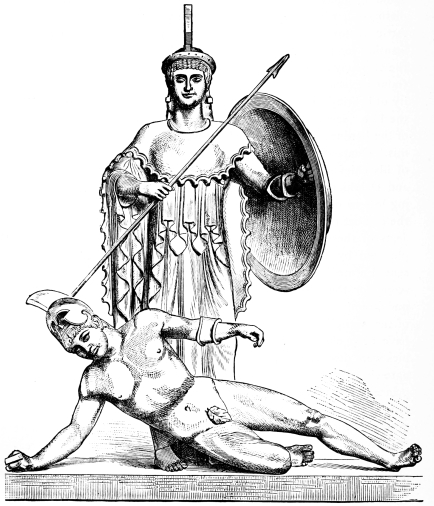
Fig. 200.—Central Figures of the Western Gable, Temple
of Athene upon Ægina.
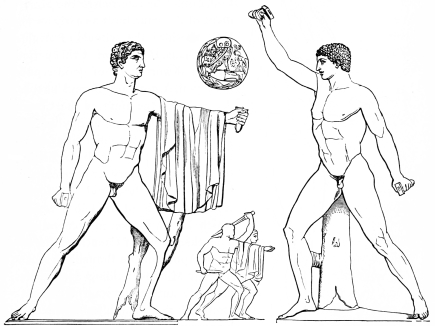
Fig. 201.—Harmodios and Aristogeiton. (Copies in
Naples.)
An established conventionalism,—that contentment with the mere handiwork of acquired forms which existed for centuries in the lands of the Nile and Tigris,—was not possible in the early art of progressive Greece. Upon the foundation of the artistic ability already attained at this period, various local schools and individual sculptors rose to a higher level, and effected an advance, partly by{293} opening new channels for the artistic industry of all Hellas, partly by pursuing paths which remained peculiar to themselves. Athens and Ægina are especially prominent in this activity; but, notwithstanding many scholarly researches, the history of art is not able to distinguish with certainty between the works of the two cities, an Attic example analogous to the chief work of the island being wanting for instructive comparison. The chief difference between the two may have been that the former school had a less strict and trained execution than the latter, with more grace of form and nobility of bearing. Callon and Onatas were prominent artists of Ægina, the latter seeming to have been the more celebrated. On account of the hardness of their work, both were considered inferior to Calamis. Onatas is particularly interesting from our knowledge of two of his chief sculptures—extensive dedicatory offerings to Olympia and Delphi, one of which represented the Greeks before Troy, casting lots to determine upon an opponent for Hector, and the other the combat over the fallen King of the Tapygians, Opis. The subjects of these works, especially the latter, and the peculiarity emphasized by Pausanias that the heroes before Troy were represented armed only with helmet, spear, and shield, probably to give scope for the display of the artist’s skill in the treatment of the nude, remind us of the two well-preserved groups from the gables of the Temple of Athene at Ægina, which, in point of style, must have been closely allied to those of Onatas. These priceless marbles were discovered in 1811, and the next year, by a chain of fortunate circumstances, came into the possession of Louis I., then Crown-prince of Bavaria. Ten of the remaining statues belong to the western gable, and five to the eastern; the greater part of the former group is thus preserved, and, as the scenes in both gables are almost entirely alike, their general arrangement may be restored with reasonable certainty. That over the chief front represents the struggle for a fallen hero, probably Oicles in the contest of Heracles and the Æginetan Telamon with Laomedon of Troy. In the rear tympanon the scene is the recovery of the body of Achilles or of Patroclos. Subjects so closely allied could lead to no great difference of composition, at most to such slight variations as the characterization of Heracles in the first group or of Paris in the second, if this latter{294} be considered an episode in which that hero took part. In both gables the fallen warrior lay at the feet of the protecting Athene (Fig. 200), while on each side, symmetrically disposed, a combatant of either party endeavors to seize the body and drag it forth from the fray. Above these stooping figures warriors threaten each other with lances; but it is not certain whether there were two or four{295} of these actively engaged. The latter number has been recently assumed from numerous fragmentary remains, which, if appertaining to the group at all, it is impossible otherwise to locate; the refutation of this theory of Lange, which has been attempted by Julius, does not terminate the vexed question. These warriors were followed, according to Brunn’s arrangement, by two kneeling lance-bearers, perhaps protecting the two archers in similar position with their shields. One of the archers is shown by a leathern cuirass and the so-called Phrygian cap to be an Oriental, perhaps Paris. With the exception of Heracles in the eastern gable, who is characterized by his lion’s skin, none of the other combatants are personally distinguishable. The corners of the triangle are filled by two fallen warriors. The whole group is thus composed with strict reference to symmetrical correspondence, and to the conditions imposed by the gable; all attempt to attain relative action and realism is abandoned, and the impression of a pantomime is inevitable. The outlines of the bodies, their position and action, are correct even to the minutest details, and show a certainty of form and a technical perfection, which, in the absence of all support for the bodies, or for the extreme thinness of the shields, is truly astonishing. The figures of the eastern gable appear particularly perfect, and are apparently the works of later sculptors, less limited, in point of style and artistic ability, than the master, or masters, of the western group. If in the latter, as before remarked, it is natural to think of Onatas, the former is correspondingly attributable to Calliteles, the son, scholar, and assistant of Onatas, who worked in great measure like his father, but also under the progressive influence of a younger generation. In remarkable contrast to the excellent and, in formal characterization, almost faultless, anatomical treatment of the bodies, two things appear particularly important as indicating the limits of the artistic ability of the time—namely, all the heads and the two statues of the deity Athene. The former are without ideal beauty or expression, for which the sculptor evidently felt himself incapable. He therefore carved the features according to a certain formula, and the apparent smile, resulting from the mouth being drawn outward and the corners of the eyelids extended, is to be regarded as a meaningless reminiscence of the older style. The eyes are too{296} protruding and the chin too pointed and small, defects of the earlier practice, not as yet entirely overcome. The Athene shows how obstinately the devotional images were denied the advances made in other sculptures, so that the traditional and hallowed type might be preserved, as much as possible, from change. While for the other statues the artist had before his eyes the living combatants of the palaistra, his model for this was the sacred image standing within the temple. The evident contrast between the stiff bearing and archaic garments of the Athene and the rest of the group is thus more naturally explained than by the view that, in the artist’s conception, the goddess did not need any real action, that a slight lifting of the shield, as a divine “thus far and no farther,” was sufficient to show her supernatural power and to protect the fallen. The awkward turn of the feet, which was owing less to the limitations of space than to the reminiscence of an antique devotional image, might the more safely be ventured, because it could not be seen at all from below. That the sculptor, however, in his loving devotion to his work, took small advantage of this last consideration, is clear from the fact that the bodies are as carefully finished upon the back as upon the front, although one half of this labor could never have been appreciated from the first installation of the figures until their discovery among the overthrown ruins and their reception in the Munich Glyptothek. The effect of the whole was essentially heightened by the bronze accessories, such as lances, belts with swords, bows, arrows, a Gorgoneion and serpents upon the aigis of Athene, etc.; and even more by the intense red, blue, and other colors upon the helmets and waving crests, shields, and borders of the garments, sandals, and leather-work, as well as by the tinting of the hair, eyes, and lips—all which painting was probably in strict harmony with the neighboring architectural members, which were doubtless treated with similar pigments. Of other statues of archaic stamp only one has proved to be contemporaneous with, and of the same school as, the gable sculptures of Ægina—namely, the so-called Strangford youth in the British Museum. The work is more closely allied to the statues of the western than to those of the later eastern gable of the temple; but, notwithstanding a marked similarity in the treatment of the torso, the formation of the features{297} differs so distinctly that the figure can hardly be ascribed to the same master. When Pausanias says of Onatas that, although belonging to Ægina, he still does not rank him below any contemporaneous sculptor of Attica, this summary praise speaks less directly for the individuality of Onatas than for the decided relative position of the two schools. It shows that in general the style of Ægina was esteemed inferior. It may be concluded that there were at least three Athenian sculptors of this time who surpassed the artists of the gable groups of the temple upon Ægina, namely, Hegias (Hegesias), Critios, and Nesiotes, not to mention the somewhat older Endoios, Antenor, and Amphicrates. Literary notices of their works do not convey any valuable information; but Friedrichs has discovered in the sculptures of the Museum of Naples which hitherto had passed under the name of the Gladiators, copies from one of the best works of Critios and Nesiotes. (Fig. 201.) They represent Harmodios and Aristogeiton, the assassins of the tyrant Hipparchos,—a{298} group recognized by an Attic tetradrachm, by the relief ornamenting a marble seat at Athens, and by a weaker reproduction now in the Giardino Boboli at Florence. As copies of this kind do not allow definite conclusions concerning the style of celebrated monuments, we must regard in them only the general composition. They suffice, however, to show that the figures, which are of a free and bold action, cannot be referred to the Monument of Antenor, built as early as 509 B.C. Besides the schools of Ægina and Athens, there were at this period sculptural workshops of good repute in Sikyon, Argos, Corinth, and Thebes. As early as the time of the Cretan Daidalidæ Dipoinos and Skyllis, Sikyon was one of the chief cities of artistic industry; and at the beginning of the fifth century two celebrated brothers, Canachos and Aristocles, stood at the head of a local school which lasted for seven generations. The chief work of Canachos, the colossal Apollo of the Branchidæ sanctuary in Miletos, holding a movable, probably automatic, stag in the outstretched right hand, is known only by representations upon coins, and by a bronze statuette in the British Museum (Fig. 202); the latter shows that the master was but little removed from the archaic hardness of earlier times, though endeavoring to attain greater power and nobility of form, particularly in the head and features. Another colossal Apollo by Canachos in Thebes differed from the figure in Miletos in being made of wood. The chryselephantine Aphrodite in Sikyon, represented with the polos upon the{299} head and with poppy flower and apples in the hands, must have been particularly archaic in conception. Two other works, more removed from hieratic influences and limitations, were probably of a less restricted style; namely, the Muse with the Syrinx, executed with two others by the master’s brother, Aristocles, and the Young Racers.
The school of Argos is celebrated by one great name, immediately connected with the highest development of art, Ageladas, the contemporary of the masters of Ægina, Athens, and Sikyon previously mentioned. From the silence of ancient authors in regard to this master’s style, little information can be given concerning it; it is only known that the Muse with the Barbiton, his many figures of Zeus and Heracles, various statues of victors, quadrigas, and groups of votive offerings in Delphi, were of bronze. Ageladas was the teacher of three of the greatest sculptors of Greece—Myron, Polycleitos, and Pheidias; and he must, if on this account alone, be ranked above his contemporaries. The history of art would receive but little furtherance by a detailed consideration of the other Argive sculptors, Aristomedon, Glaucos, and Dionysios; of the Corinthians, Diyllos, Amyclaios, and Chionis; of the Thebans, Aristomedos, Socrates, and others; of Callon of Elis; or of the Spartan Gitiades. Prominent as these must have been, they appear rather to have demonstrated the vigor of their schools, and the influence of those of Ægina and Athens, than by individual gifts to have raised themselves above the academic art of their time. As masters of personal importance, in whom the progress made by their own genius far exceeded their early training, may be mentioned three younger sculptors: Calamis, probably of Athens; Pythagoras of Rhegion, in Magna Græcia; and Myron of Eleutheræ, on the borders of Bœotia. Calamis worked chiefly in devotional figures, and in these could not entirely throw off the hieratic limitations in regard to position and treatment of details. He was accounted somewhat less hard in style than Canachos or Callon, but inferior to Myron in truthfulness to nature. This master seems to have made little advance in the modelling of the body as a whole, though Lucian praises the rhythmical position of the feet and the beauty of the joints of his Sosandra; but in the representation of the head he succeeded{300} in making decided progress when compared with the artists of the gable groups of Ægina. In this respect his Alcmene must have been highly important; but chief among the works of Calamis was the Sosandra, probably an Aphrodite, which became proverbial on account of its grace and beauty. Lucian, when comparing the most distinguished examples among all the works of art to illustrate perfect beauty, did this with the significant words, “Calamis may ornament our ideal with chaste modesty, and its smile may be honorable and unconscious as that of Sosandra.” In view of this judgment, it is plain that the stiff, ugly heads of the Æginetan marbles are not to be imputed to the works of Calamis; that the graceful and beautiful formation of the features was one of the chief improvements effected by him. The limitations of his art are indicated by another notice. Pliny relates that Calamis was unsurpassed in his representations of horses; but Praxiteles removed a charioteer from one of the older quadrigas, and created another in its place, “that the men of Calamis might not appear inferior to his animals.” His charioteer must consequently have contrasted unfavorably with the horses and disturbed the harmony of the whole; this need by no means be considered as contradictory to the accounts of the beauty of his devotional images, for the charming grace which distinguished the quiet figures of deities and heroes was to be exchanged in the charioteer for an athletic life, corresponding, in position and action, to the exciting situation, and such representations evidently were beyond the powers of the otherwise able master. Examples authentically referable to Calamis do not exist, though the statue of Apollo upon the Omphalos, found in Athens, shows at once the archaic limitations and the advancing mastery which may be ascribed to this period of Greek sculpture; while the so-called Vesta, now in the possession of Torlonia, may have preserved reminiscences of the Sosandra. Both these works are evidently the products of artists who did not conceive the gods as merely graceful and pleasing, but as strict and serious beings. Statues of Apollo by Calamis are known to have been brought from the Kerameicos in Athens, and from a city upon the shores of the Pontos, to the Roman capitol; but this can hardly be adduced as an argument in favor of the authenticity of the figure upon the Omphalos.{301}
To those very points in which Calamis failed, the two other artists named devoted themselves with signal success. The works of Pythagoras of Rhegion, who limited himself to bronze as a material, while Calamis worked in marble, gold, and ivory, betray no connection with those of the latter in regard to subjects, for the greater number were statues of victors and representations of heroes in somewhat genre-like conception. Of the former, Pausanias and Pliny praise the Enthymos as one of the most excellent among the forest of images dedicated at Olympia; of the latter, the limping Philoctetes was celebrated by many epigrams, as causing the observer to himself feel the pain of the wounded foot. To attain such an expression, it is not sufficient to characterize the suffering in the affected limb alone, but the pain must be evident in the entire body, in bearing as well as in step; in the continued tension of all the muscles, and in the one-sided strain upon the sound leg. The Philoctetes illustrates an otherwise incomprehensible account of the master’s ability. Diogenes of Laerte says that Pythagoras, of all sculptors, first regarded rhythm and symmetry. This unity of motion or rhythm, with the equipoise or symmetry which alone lends a feeling of security and harmonious perfection to the different members of figures under excitement, is that which made the work so effective. The same principles must have distinguished the statues of victors, which were apparently intended rather as examples of the various modes of combat, or the preparations therefor, than as individual portraits. The chief merit of this master appears, according to this, to have consisted in the organic truthfulness to nature of his figures, and this is by no means contradicted by the rather trivial judgment of Pliny that Pythagoras was the first to indicate sinews and veins, and to more carefully model the hair; for increased anatomical correctness came naturally with the organic action and realism of these works.
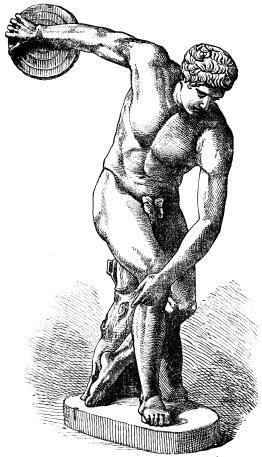
In this expression of the movement by every part of the body exercised, Pythagoras was still surpassed by Myron. A founder of metal, like the former, he acquired his fame chiefly as a maker of the statues of victors, although, with acknowledged versatility, he executed numerous images of deities and heroes. Two of the first were highly celebrated—the Runner Ladas and the Discos-thrower; both of them belonging to that class of works which illustrated the{302} nature of the game itself. For Ladas was shown at the moment when, after overstrained effort, he had reached the goal, and there, as victor, had fallen dead: according to the expression of an epigram upon the work, it was as if the last breath from the empty lungs were passing his lips. For such a creation even the most perfect position of running, and indication of relative action in trunk and arms, were not sufficient; the great point lay in the panting breast and the open mouth and nostrils: the last effort of the lungs must have been wonderfully shown. Another epigram speaks of the “breather,” not of the runner, Ladas. That this marvellous representation of concentrated action was not to the disadvantage of the outer members is shown by the other victor before mentioned, the discos-thrower, the fame of which is demonstrated not only by the praise of Lucian, but by the numerous copies made during antiquity. Many of the latter have been preserved, marbles of the size of the original, and bronze statuettes, giving evidence of the fascinating action in the swing of the discos; the athletic body of the youth bending forward to gain greater impetus; the toes of one foot clinging to the{303} ground, those of the other slid along its surface; and everything prepared for the fling which is instantly to follow. And yet the best-preserved copy, that in the Palazzo Massimi (Fig. 203), must certainly be in every respect inferior to the original. A mythological genre-group by Myron appears from existing copies to have been equally effective: it illustrated the legend of the flute, invented and cast away with a curse by Athene, and found by the unfortunate Marsyas. Statues in the Lateran and British Museum show the Satyr starting back in surprise, the momentary action of desire and fear being seized and expressed with as consummate mastery as were the athletic movements of the runner and the discos-thrower. It was this same spirit of life that caused Myron’s cow to be so celebrated in antiquity that no less than thirty-six epigrams have been handed down concerning it. Petronius, in praising this master, says that, in representing animals, Myron seemed to enclose the very breath of life in the bronze; and when Pliny says that he multiplied nature, he can have no other meaning than that the artist attained so life-like an effect that his works appeared rather to have grown than to have been an artistic creation.
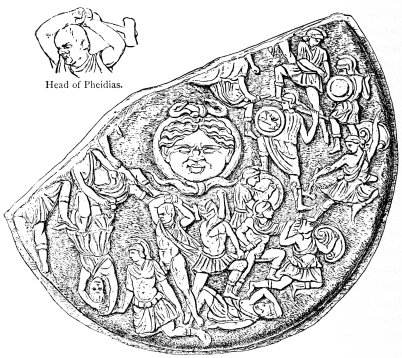
Fig. 205.—Fragment in the British Museum, imitated from
the Shield of the Athene Parthenos.
The schools of Ægina, Athens, Sikyon, Argos, Rhegion, and the other cities where art had chiefly centred, flourished during the Persian wars—that greatest period of Greece, from 490 to 450 B.C., when Myron, the scholar of Ageladas, was still young. The unequalled grandeur of this age, which resulted in the splendid culmination of all Hellenic life, must have furthered art, all the more as the devastation of the war, and the subsequent enrichment of the victors, offered full opportunity and means for monumental activity. What influence this had upon architectural industry has been described in a foregoing section, and it may be easily understood that sculpture went hand-in-hand with this; the larger temples needed their images of the gods, their gable groups, metope reliefs, and friezes, as also their complement of sculptural votive offerings, prompted by the gratitude of the victors. Athens, more than any other place in Greece, found occasion and means for these works, having been laid waste in 480 and 479 B.C. by Xerxes and Mardonios as no other large city of Greece had been. By means of the taxes levied upon the confederated states after the siege of Mycale,{304} its possessions were greater than those of all the other Hellenic republics together. Athens therefore saw the most perfect flower of Grecian architecture come forth from the ashes of the Persian catastrophe, and by its side appeared the grandest creations of sculpture. Yet neither of these arose like magic from the wasted ground; it was necessary that the nation should first take breath, should recover from the almost supernatural exertions made during the war, and provide for defence and shelter by the building of fortifications and dwellings. It was not until after this that they could devote themselves to great monumental undertakings, the perfect completion of which required more than one generation, and sculptured ornamentation was thus still further postponed. The older masters hitherto considered had little or no part in the chief works of this period. The mind of Themistocles was so practical, and so much directed towards fortifications, that he could have little thought for occupying the artists with monumental sculpture. His successor, Kimon, son of Miltiades, began to build anew the places of worship, but did not go so far as to institute sculptural ornament, at least in its chief constituent, statuary. This first ripened to perfection in the reign of Pericles, and a favorable fate ordained that, just at this time, when it was needed as never before, a genius appeared under whose guidance the most complete development was attained. This greatest of sculptors was Pheidias, the son of Charmides, an Athenian by birth. When a boy of ten years, he had seen his countrymen, under Miltiades, go forth to Marathon, and, as a youth, had shared in the rejoicing over the glorious victory of Salamis. At that time, having probably left the school of Hegias, his first teacher, he turned towards Ageladas the Argive, who may have come to Athens in order that, in the rebuilding of the city, he might employ his art in works which have remained unknown to us. When Pericles entered upon his much celebrated presidency (444 B.C.), Pheidias, already advanced in years, enjoyed a fame so great throughout all Greece that, as soon as Pericles had installed him at the head of the entire monumental work of Athens, artists of distinguished rank placed themselves, without envy, under his lead. With only the scanty and scattered literary notices that we possess, it is impossible, from the works of this master, to illustrate his life before the{305} time of Pericles, these being not only imperfectly known, but connected with but few chronological facts. Chief among his productions is to be mentioned a group in bronze consecrated at Delphi by the Athenians under Kimon, from a tithe of the booty taken at Marathon. It represented Miltiades between Athene and Apollo, surrounded by the ancestral heroes of the ten Attic Phylæ. In artistic respects nothing more is known of this than of the statue of a youth crowning himself with the victor’s band in Olympia; of a wounded Amazon, a work prepared for a competition in which Pheidias was surpassed by Polycleitos; of a marble Hermes in Thebes; or of three draped statues of Aphrodite, one of which, that in Elis, was chryselephantine, the other two having been of marble. The artist employed his powers mostly in a higher province—in figures of Athene and of Zeus. Six of the former are more or less known; the most celebrated was the bronze Athene of Lemnos upon the Acropolis of Athens, so called because dedicated by Attic colonists from that place, and distinguished by the name of “the beautiful;” a second was the colossal statue, likewise of bronze, standing between the Erechtheion and the Propylæa, whose helmet-crest and lance-point gleamed above the roof of the Parthenon, twenty metres high, and was visible at sea as far as the promontory of Sunion. The shield standing upon the ground—and perhaps a later creation—was ornamented by Mys, after a design by Parrhasios, with an embossed centauromachia. Not to speak of the Athene Areia at Platæa, a colossal wooden figure with garments of gold, the nude parts being of marble, we come finally to the incomparable chryselephantine figure in the Parthenon at Athens, in which the type of Athene was forever firmly established. Some few accounts—a marble statuette{306} lately found in Athens (Fig. 204), a miserably careless imitation; and also a poor copy in marble of the shield, discovered soon after, in the British Museum (Fig. 205)—render it possible to understand the composition in its chief outlines. Standing erect, the head slightly inclined forward, clothed with the sleeveless chiton and the ægis, the helmet decorated with the sphinx, she supported her left arm upon the shield, at the same time holding the lance, which leaned against her shoulder and bore the serpent of Erichthonios, coiling upward; the right arm, outstretched, carried a figure of Victory, two metres in height, which, turned towards the goddess, offered her a wreath of gold. The base of the statue, and even the rims of the thick-soled sandals, were ornamented with reliefs. The golden shield showed, within, the gigantomachia, and, without, the{307} battle of the Amazons, concerning which we have further information from the discovery above mentioned. The fatal portrait of the artist himself may be plainly recognized in the strongly individualized features of a bald-headed man with the battle-axe in his uplifted hands, prominent because of his almost entire nakedness among the completely equipped youths. This portrait caused the merciless persecution of the sculptor and his patrons; after the charge of embezzling the gold upon the garments of the Athene had been proved groundless by the removal and weighing of the metal, this figure gave opportunity for complaint of sacrilege, and the artist was forced to pass the remainder of his life in a prison. The Athene Parthenos was surpassed by the colossal statue of the Panhellenic Zeus in Olympia, likewise chryselephantine, which exhibited the highest triumph of Pheidias. The god, with a green enamelled olive-wreath crowning his golden locks, and in garments brightly bordered with gold, was seated upon a magnificent throne, the legs of which were ornamented with figures of Victory in two rows, and the arms with sphinxes, while the back was terminated with groups of Horæ and Charites, the steps, cross-bars, sheathing-boards, etc., of the support being decorated with many other sculptures in the round and in relief. In his right hand, turning towards him, was a Victory, and in his left a sceptre, tipped with the eagle, formed from a combination of many metals. This figure was majestic, with an expression mild, yet so powerful that a gesture would seem sufficient to make earth and heaven tremble. The artist had made this double expression his aim, guided in his creation by the lines of Homer where he portrays the God of gods nodding in assent to Thetis, who begs for the glorification of her son Achilles:
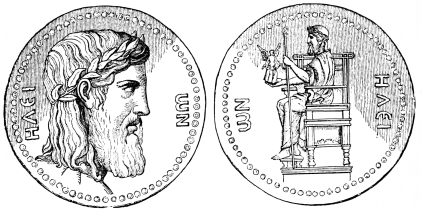
Fig. 206.—Coins of Elis. One third enlarged.
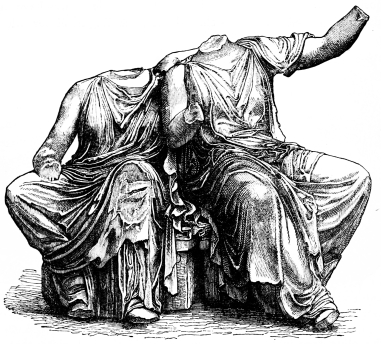
Fig. 207.—From the Eastern Gable of the Parthenon.
Demeter and Persephone.
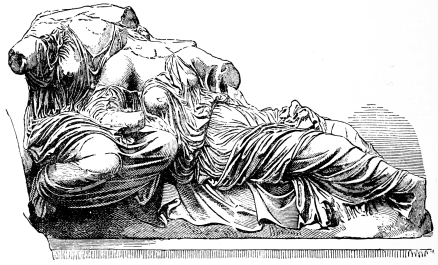
Fig. 208.—From the Eastern Gable of the Parthenon.
Aphrodite and Peitho.
That Pheidias attained his ideal was unanimously attested by his own time, and by the later world so long as it had opportunity to see this wonderful production. Even divinity itself must have approved, since, according to the beautiful legend, as the master, at the perfecting of his work, prayed for a sign of favor from heaven, a stroke of lightning entered the temple and fell upon the floor in{308} a spot which was marked in later times as sacred. A feeling pervaded all antiquity that the Olympian Zeus of Pheidias was the grandest and most divine of all works of art, which not to have seen was a misfortune to be lamented, and the sight of which lifted from the soul its cares and sorrows. Instead, therefore, of dwelling upon the praises given by the ancients to the details, we should seek rather to understand the principal traits which justified this opinion, and which were characteristic of the master. The archaic constraint prevalent in works of Ageladas and Calamis had been overcome; but the combination of all previous results, and a nearly absolute correctness of form, united to an ideal beauty quite beyond any real experience, could not have been the chief causes of this admiration. These were, indeed, important, especially in view of the enormous difficulties presented by the chryselephantine process—in the working of gold-plate; in the preparation, shaving, and uniting of the ivory, so unpliant to the chisel, and, finally, in securing it to the wooden form. But the essential and characteristic merit lay in the bodily incarnation of a grand and truly godlike ideal, employing the human form only as a word through which the elevated thought found expression. The artist had set before himself the most exalted aim—namely, to present to the eyes of the world the highest conception of divinity as seen in Athene, the goddess of the mind, and in Zeus, the king of gods. Hence the large number of Athenes executed by Pheidias, and the Aphrodite Urania, the great “heavenly” goddess, the feminine principle of the universe; hence, also, the fewer representations of masculine or heroic forms, or of subordinate deities, in which this master might be excelled—as by Polycleitos in his Amazon—because they did not accord with his nature, or contain within themselves that ideal greatness which he wished to unfold. Although the two chryselephantine colossal statues, notwithstanding the perishable nature of their construction, were comparatively long preserved—being in existence at the end of the fourth century A.D.—still, there are no copies which show more than their general composition. The marble statuette of Athene (Fig. 204) has already been mentioned; in regard to the Olympian Zeus, a copy upon a coin of Hadrian, which shows the usual carelessness and weakness (Fig. 206), has in later times been justly preferred{309} to the mask of Zeus from Otricoli, formerly considered a copy after Pheidias. Though the classical notices frequently give the only information concerning the masterpieces of Pheidias, numerous original remains from his workshop still exist. We cannot adduce as examples the glorious metopes and frieze of the so-called Theseion in Athens, perfect as appear these representations of the deeds of Heracles and Theseus upon the former, and of the battle of the Centaurs and Titans upon the latter; for as it is not known when this temple was dedicated, it cannot be shown that its ornaments were executed in the period which came under the artistic direction of Pheidias. Nor can we attribute to this school the sculptures of the Erechtheion, which were not completed until 408—the beautiful caryatides of the portico, or the remnants of relief from the frieze, preserved, unfortunately, only in scanty fragments. These figures, indeed, instead of being carved from the blocks of the frieze itself, were formed piecewise of Pentilic marble, and fastened upon a dark ground of Eleusinian stone, probably for the effect of color. As little may we cite the better-preserved reliefs upon the frieze and balustrade of the small temple of Wingless Victory before the Propylæa, which, from their great likeness to the sculptures upon the mausoleum of Halicarnassus, seem rather to belong to the following period. Overbeck thinks it probable that the frieze has reference to the battle at Platæa; and the balustrade, according to{310} Kekule, may have something to do with the return of Alkibiades. In judging the Pheidian school, the Parthenon offers, however, abundant material in the three kinds of sculpture—round statues, high and low relief; although the unhappy bombardment of Athens by the Venetians in 1687, when the bursting of a bomb in the beautiful temple, then used as a powder-magazine, and the succeeding explosion, destroyed more than half the work. The last two centuries also have not passed without leaving their mark; so that Lord Elgin’s robbery may, after all, have proved an advantage, the greater part of the sculptures having been protected and rendered accessible, since the beginning of this century, in the halls of the British Museum. It is particularly unfortunate that the gable groups have suffered most; for the perfection of these chief works must have appeared of the greatest importance to the artist, and these colossal statues would have given the best exposition of his ability. Before the catastrophe above mentioned, however, these were badly injured in consequence of the Temple of Athene Parthenos having been transformed into the Church of Maria Parthenos, and later into a mosque, the destruction appearing also to have been aided by the wilful malice of Christian and Moslem fanatics. They were still further reduced after the explosion by the unsuccessful attempt of the Venetians to carry off as trophy a marble chariot and horses. The few notes of Pausanias upon the subjects of the gable groups, the drawings of a French artist, Carrey (taken not long before the bombardment), and the remains preserved in the British Museum are sufficient to convey a conception of the general composition. The eastern gable represented the birth of Athene; not the unfortunate, artificial scene where the goddess springs, ready equipped, from the head of Zeus, as frequently shown in pictures upon vases and bronze mirrors, but the moment after, when she appears before the deities of Olympos. The entire central part of the group including the highest deities, the chief feature of the composition, is lost; the rest is in greater part preserved. As the scene was in Olympos, Helios and Selene, with their quadrigas, were fittingly chosen as the limits of the composition; the former rising from the sea, in the left angle of the gable, the latter sinking in the right; night disappearing before the dawn. The adjoining{311} statues, though much mutilated, have been preserved. Next to Helios was Dionysos, resting upon his tiger’s skin; with two sitting female figures, Demeter and Persephone (Fig. 207), to whom hastens Iris, announcing the birth of Athene. Upon the other side, next to Selene, lay Aphrodite in the lap of Peitho (Fig. 208); and then Hestia, to whom Hermes, as the other messenger, brings the glad tidings: these latter sculptures were almost entirely destroyed in the time of Carrey. Nike—Victory—remaining only as a torso, appears to have followed with Ares, advancing towards the middle of the gable bringing greetings to the newly born goddess. All the rest was destroyed before 1680 A.D., and the principal figures of the composition are consequently unknown; but it is probable that between the Victory and Athene stood Hephaistos, recoiling after having delivered the blow upon the head of Zeus. Athene stood beside her father, but it is not certain whether the latter was exactly{312} in the centre of the gable, or whether the two figures were equally removed from it. If this last were the case, which is perhaps probable, the division of the space would require still another deity upon the right side. The remaining gods of Olympos, Poseidon, Artemis, and Apollo, were probably arranged in this order between Zeus and Iris. The group of the western gable represented the contest of Athene and Poseidon for the Attic land. The composition is reasonably certain, though the middle figures have here also disappeared. The two chief deities, standing at either side of the olive-tree in the centre, turn towards their chariots, that of Athene being driven by Victory, that of Poseidon by Amphitrite; horses were harnessed to both, that of Poseidon not having been drawn by dolphins or hippocamps, as formerly supposed. The consciousness of victory was expressed by the bearing of Athene and of her steeds, while the bowed head of Poseidon acknowledged his defeat: the exclusion of the salt waves of the sea from the blooming meadows and groves watered by the Kephissos. The angles of the gable beyond the chariots were occupied by the retinue of the contestants, and by local deities; the accurate determination of{313} these is impossible, though upon the side of Athene may have been grouped the representatives of the Athenian continent, and upon that of Poseidon those of the sea and the islands; while the figure of Kephissos is supposed to have filled the extreme corner at the left, and Ilissos with Callirrhoe that of the right. The scene was laid in Attica; and, as the earthly locality was to be clearly characterized and populated, it was advisable not to introduce again all the Olympian deities of the eastern gable. It is probable that during antiquity the landscape seen from this chief front of the Acropolis was famous for many local myths no longer familiar to the scholar, in ignorance of which an adequate explanation is impossible. The compositions alone give evidence of the grandeur and elevation of the master who produced and arranged them, in a truthfulness to nature at once ornamental and unconstrained. The remains, with great simplicity and breadth of detail, show a force and majesty which raise them above all known works of sculpture. In their loving and perfect modelling of the nude and of the drapery, in their freedom from affectation of motive or of rendering, and in their utter lack of any striving after meretricious effects, they appear rather the creations of magic than the labored carvings of men.
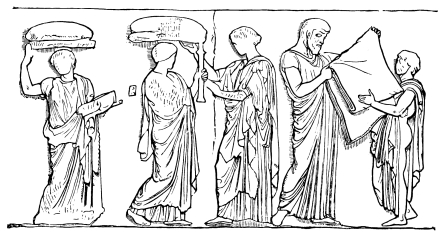
Fig. 209.—Fragment from the Frieze of the Parthenon
Cella.
The glorious and celebrated frieze, or, to speak more correctly, zophoros, surrounded the entire cella. It is preserved in nearly four fifths of its entire length, the chief part of the remains being in the British Museum. It is evident that but little, if any, of this extensive decorative work could have been executed by the hand of Pheidias himself; but the grand design may be assumed to have been his, and the carving was certainly done under his supervision. The scene represented is the festive Pan-Athenaic processions, an imposing consecration of elaborate gifts to the guardian deity, and probably also a division of prizes to the victors in the various hippic, gymnastic, and musical games. The movement of the train commences upon the southwestern corner of the cella, and advances thence to the east, the entrance side of the temple. It is thus naturally divided into two parts, one of which occupies the western and northern, the other the southern side of the cella; these are united above the pronaos, where the double procession is{314} shown as having arrived at the temenos before the temple; a priest and priestess, with the persons directly employed in the sacrifice, are preparing themselves for the sacred act—the former by laying aside his upper garment, which he gives to the youth standing beside him, the latter by taking a folding-seat from a female servant. (Fig. 209.) Between this central group and the remainder of the divided procession several deities, turned from the former figures, are watching the approach of the train. At the left sits Zeus, enthroned, beside the veiled Hera; these are followed by the Winged Victory, Ares clasping his right knee with both hands, Demeter with the torch, and Dionysos, who rests his right arm carelessly upon the shoulder of Hermes. Upon the right, next to the high priest, was naturally the place of Athene, and upon her left hand are still traces of the fallen Ægis; beside her was Hephaistos, leaning upon his knotted stick; then, looking towards him, Apollo, and further Peitho, Aphrodite, and Eros, the latter carrying a shade for the sun. The gods sit comfortably as spectators who feel themselves to be invisible. The first figures of the train, the leaders, have already attained their destination, and stand quietly conversing, supported upon their wands. In the succeeding women and virgins, who bear vases, cups, cooling-vessels, braziers for incense, and baskets—a wonderful train of perfectly beautiful forms—the advance{315} decreases in movement as they approach the centre. Upon the two long sides follow herds of animals for sacrifice; the cows, proceeding quietly, scarcely need guidance, while the bulls are more or less restless, reminding one, in their forcible and momentary action, of the life-like works of Myron. After them follows the music of the procession—players upon the flute and lyre and the festive chorus; then begins the long line of chariots and of horses with their riders, which fill the greater part of the zophoros upon the longer sides and all of that over the epinaos. The beauty and truth in the action of these figures are unsurpassed; the most manifold variation of position is combined with perfect adaptation to the peculiar style of low-relief, and the wisest reference to the fitting of the composition within the space defined by the architectural lines. While upon the eastern front the procession had arrived at its destination, on the western the scene was still at the place of assemblage and marshalling. Here the horses are bridled and arranged in ranks; but the groups of men and youths stand in disorder, some hastily arming themselves, others binding their sandals or adjusting their mantles. Every action and gesture is simple and full of meaning; they never mar the unity of the whole nor interfere with the neighboring figures. The nude forms and the drapery are most carefully and equally executed throughout; the accessories are forcibly, though less elaborately, indicated. When the ceremonial reliefs of Assyria or Persia are compared with the frieze of the Parthenon, it becomes strikingly evident that the magnificence of personal accoutrements and inanimate objects which was so painfully and minutely detailed by the Asiatic sculptor, and elevated even above his schematic representations of deities and human beings, was as nothing to the Greek artist in comparison with the intellectual and physical beauty to which the great Hellenic race gave their chief interest.
The third group of Parthenon sculptures, the ornaments of the metopes, must least have harmonized with the nature of Pheidias. The architectural framework must have become a hindrance and a fetter, and the problem how to fill ninety-two square tablets of exactly the same size with similar representations must indeed have appeared a thankless task. These reliefs are in greater part lost, or so mutilated as to be unintelligible; but as far as can be judged by{316} the scanty remains, the subject of the metopes upon the eastern side was the gigantomachia, that of both long sides principally the Centauromachia, while that of the western side was either the battle of the Amazons or of the Persians. In contrast to the low-relief of the frieze, these, originally colored, were—on account of the conditions of light—worked in such high-relief as even, in some parts, to be freed from the ground. The variation of subjects bearing so strong a resemblance is wonderful, especially in the struggling Centaurs and Greeks, where but little scope in the victory of one or the other combatant was possible: these are interrupted by the rape of virgins and other scenes not surely to be determined. Naturally, this desperate task would not have been completed without some few artistic inequalities, repetitions, and far-fetched modifications, especially as much of the execution must necessarily have been submitted to inferior sculptors; but some of the metope reliefs appear, in point of composition within the given space, and in grand, characteristic drawing, scarcely less admirable than the frieze of the cella. From all these works the spirit of the school of Pheidias is manifest in its imposing majesty and ideal simplicity; at times, also, traces of the forcible action of Myron may be observed.
These extensive productions of the school and workshop of Pheidias cannot be directly attributed to any of the known scholars and assistants of the master, many of whom attained individual celebrity. In the first rank of these should be mentioned Agoracritos{317} of Paros, the favorite pupil of Pheidias, whose works were so perfect that the ancients were frequently in doubt to which of these sculptors they should be ascribed; it is possible, however, that this doubt may have arisen from the predominant impression left upon some of the statues by the guidance and assistance of the master. The chief creations of Agoracritos were two Athenes, a Zeus, and notably the colossal figure of Nemesis at Rhamnous, supposed to have developed from the unsuccessful Aphrodite prepared for the competition with Alcamenes. Another scholar and assistant of Pheidias was Colotes of Paros, a sculptor who appears to have restricted himself to the chryselephantine process, and who is especially noted for the part taken by him in the execution of the great Olympian Zeus. Other works in gold and ivory by Colotes were the Athene upon the Acropolis of Elis, an Asclepios erected in the vicinity, and the sacred table in the great Temple of Zeus, for the division of prizes after the Olympic games, the sides of which were ornamented with reliefs.
Alcamenes of Athens, or Lemnos, and Paionios of Mende have hitherto been considered as chief among the scholars of Pheidias; but the recent excavations at Olympia have done much to refute this opinion, unless, as is very possible, Pausanias makes a mistake (v. 10) in assigning to Alcamenes the sculptures in the front gable of the Temple of Zeus, instead of the acroteria above them, which alone is mentioned in an inscription as his work. No one can detect{318} in the discovered fragments of these gable sculptures, more numerous than those of the Parthenon, the slightest dependence upon the art of Pheidias, which they appear to precede in point of development. The group of the eastern front, ascribed by Pausanias to Paionios, represented the instant before the chariot race of Oinomaos and Pelops (Fig. 210); that of the western the struggle of the Lapithæ and Centaurs at the wedding of Peirithoos. (Figs. 211 and 212.) The character of these works seems rather to connect them with the school of Calamis than with that of Pheidias, this being especially the case with the metopes. (Fig. 213.) The question will hardly be decided until authenticated sculptures by Calamis, or remains of the gable groups of the temple at Delphi, which were the production of his scholars Praxias and Androsthenes of Athens, have become known to science. In the meantime, it is impossible to disprove the hypothesis of Brunn, who sees in those of Olympia examples of an art peculiar to Northern Greece, remarkable for its picturesque realism and lack of artistic and ideal conventionalization. It is only certain that these groups are far inferior to those of the Parthenon, and, indeed, to those produced by any workshop of Athens after the time of Pheidias. Even if the questionable account of Pausanias prove to be true, it is certain that a judgment of the artistic style of Alcamenes and Paionios cannot be formed upon these decorative sculptures alone. Works of the stage of development shown by the western gable of Olympia could not have ranked with the bronze Pentathlos of the former artist, which was known in antiquity by the predicate “exemplary;” nor could an Aphrodite of Alcamenes have been preferred to a statue by Agoracritos, which{319} had been retouched by Pheidias himself. The extensive employment of Alcamenes in Athens among the greatest successors of Pheidias and Myron would have been impossible had not his works been far higher in every respect than those attributed to him among the recent discoveries in Olympia, in view of which it is inconceivable how Pausanias could speak of Alcamenes and Pheidias almost as equals. The same argument applies to Paionios, of whose works a fortunate illustration has been provided by one of the most important discoveries made in the Altis, the Victory (Fig. 214), authenticated by an inscription upon the high triangular pedestal. This figure does indeed recall the spirit and methods of the Pheidian sculpture, and differs greatly from the remains of the eastern gable, as may readily be seen by comparison of Figs. 210 and 214. This contrast is only to be explained by a gigantic and almost inconceivable progress, or by the assumption that they were the works of different artists and periods.
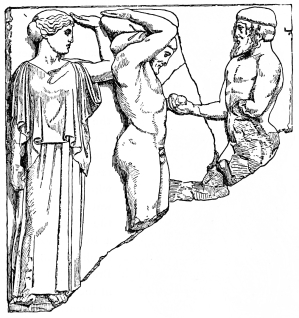
Fig. 213.—Metope from the Cella of the Great Temple of
Olympia. Atlas, Heracles, and the Nymph of the Hesperides.
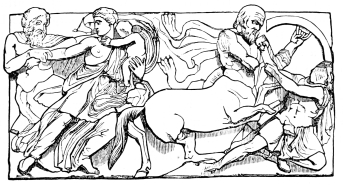
Fig. 215.—From the Frieze of the Temple of Phigalia.
If the Attic artists of this age be likened to planets revolving about the Pheidian sun, there were not wanting stars of the second magnitude, belonging to other systems and moving in other circles. Especially prominent among these latter was the direct and indirect school of Myron, an artist so pronounced in his wonderful naturalism that his style could not be extinguished even by the dominating idealism of Pheidias. Lykios, son of Myron, appears, from two celebrated works, to have followed closely in the footsteps of his father. These were the statues upon the Acropolis of Athens representing two boys, one of whom bore a basin for holy-water, while the other blew the coals in a censer into a lively glow. The latter reminds one of Myron’s Breathing Ladas; in this, as in the Runner, the quickened breath was the essential thing, and was not confined alone to the swollen cheeks, but must have been evident in the breast and body. The figure bearing the font was a zealous choir-boy, panting under a too heavy burden; and this also recalls the Ladas. Still another statue, the Pancratiast Autolicos, claimed by Urlich for Lykios, seems to have resembled the Discos-thrower of Myron. That Lykios did not confine{321} himself to such genre-like specialties is shown by groups like the Argonauts, and by the votive offering of the citizens of Apollonia at Olympia, a truly grand composition representing Zeus deciding the result of the strife between Memnon and Achilles, according to the Æthiopis of Arctinos. In connection with Lykios may be mentioned Styppax of Cyprus, whose masterpiece, the Splanchnoptes—the entrail-roaster, a man fanning a fire—recalls in turn the choir-boy blowing the coals. Similar to the Dying Ladas, though less directly connected than these last examples, was the mortally wounded warrior of Cresilas, in which, according to classical accounts, the last moments of life could be measured; his wounded Amazon also appears to have been more in the style of Myron and Pythagoras than of Pheidias. No works by the immediate followers of Myron now remain, nor any attested copy; still there can be little hesitation in ascribing to this school an important achievement, not perhaps belonging to it so fully as do the architectural sculptures of the Parthenon to the workshop of Pheidias, yet having more in common with the school of Myron than with that of any previous master. This is the frieze of the Temple of Apollo at Phigalia—now in the British Museum—the architectural position of which has already been defined. The temple is said to have been built under the direction of an Athenian architect; it is probable, therefore, that Attic sculptors were employed for its ornamentation, especially as the sculptures betray no trace of the Argive influence which prevailed{322} elsewhere in the Peloponnesos, and which will be further treated below. Though the subjects were Attic, as battles of Amazons and Centaurs, they cannot be likened to the school of Pheidias, for, instead of the passionless grandeur and ideal simplicity which characterized the sculptures of the Parthenon, there is in them a vehemence and excitement known at this period only in the works influenced by Myron. It is not strange that this excessively passionate action should sometimes be wanting in beauty; the power of execution at command in the remote city among the Arcadian mountains was not of the first rank, and the guidance of a master, like him who directed the sculptural work of the Parthenon, was wanting.
Two artists of this period were entirely independent, proceeding in degenerate directions; first, Callimachos, noted as an artisan in metal-work, who executed the rich and elegant lamp of the Erechtheion, and was said to have originated the Corinthian capital; but who, as a sculptor, carried a refined delicacy and formal perfection even to an extreme. This won for him the cognomen of Catatexitechnos—the unreasonably careful. Callimachos did not, like Apelles, know when to withdraw his hand from his work, which agrees with Pliny’s judgment concerning him, that, by over-exactness in execution, all grace was lost. A still more questionable tendency is shown by Demetrios of Alopeke, in Attica, the first realist. Pre-eminently a sculptor of portraits, he affected striking characteristics at the expense of beauty, and made it his specialty to represent the likenesses of decrepit men and women. A priestess sixty-four years old, and an aged Corinthian field-officer, Pelichos—“a bald-head with a pot-belly, tangled and flying beard, and veins projecting roundly under the withered skin,” according to the description of Lucian—must have been so far from ideal and refreshing beauty that it would seem rather to have been the aim of the artist to illustrate age as its destroyer. Thus, in comparison with Pheidias and Myron, Demetrios resembled Thersites among the heroes of Troy.
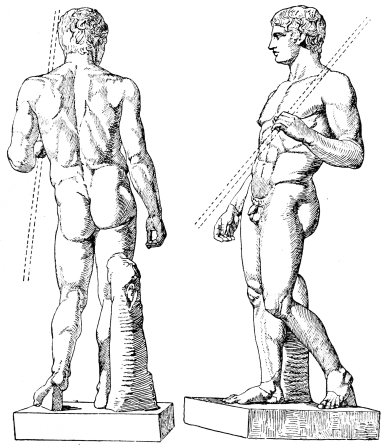
Fig. 216.—Copy of the Doryphoros in the Museum of
Naples.
Argos deserves the second place as the site of the artistic industry of this period, which had then been greatly advanced by Polycleitos of Sikyon, a fourth scholar of Ageladas, and somewhat younger contemporary of Pheidias, but in a direction different from that of the Attic school. Myron had characterized intense and momentary{323} animal life, Pheidias that of absolutely ideal and divine being. Polycleitos chose as his aim the artistic representation of the highest human beauty—a positive type of bodily perfection. The Doryphoros, known in antiquity as the masterpiece of the latter, and celebrated as a canon, was a youth in a quiet position, bearing a lance; it was considered the embodiment of perfect form, the master himself having written a treatise upon the proportions of the human figure in illustration of this statue. It is not improbable that Polycleitos, in this work, desired to set a pattern before his numerous scholars; that{324} he was himself too dependent upon this academical tendency may be judged from the slightly disparaging words of Pliny that “his works were almost as if taken from one model.” According to the intention of the artist and to the general conviction of his time, the Doryphoros represented absolute perfection of the human body; and this left the master but little scope for the varying of his model, if he would not prove untrue to that beauty which Cicero has praised so highly in all his works. The so-called Apoxyomenos—an athlete scraping himself with a strigil—similar in subject to the statue of Lysippos (Fig. 229), was also a figure placed in the quiet attitude of parade, if not, like the Doryphoros, with an academic purpose. A third work, the so-called Diadoumenos, a boy binding his head with a fillet—sometimes considered as a companion piece to the Doryphoros—appears to have shown a more youthful and less athletic development of form. It is not strange that archaeologists have taken great pains to identify, among the numberless works of Roman sculptors, imitations of these two canonical figures, the existence of which was naturally assumed from the great celebrity of the Greek originals. The scholars Friederichs, Schwabe, Michaelis, Helbig, Kekule, and Benndorf have accordingly discovered six repetitions of the Doryphoros, preserved in Cassel, Naples, Florence, the Vatican, and the Villa Medici; while several other statues in Dresden, the Louvre, the Vatican, and the Villa Albani have been recognized as variations differing more or less from this type (Fig. 216). In like manner, copies of the Diadoumenos have been found in Madrid, in two marbles of the British Museum, in a bronze statuette of the National Library of Paris, and in a relief of the Vatican: all of which are allied in point of conception and artistic character. Still it is inexplicable how these thick-set and muscular forms could be spoken of by Pliny as viriliter puer and as molliter juvenis, or by Lucian as graceful dancers; though it is possible that, in these academical studies, the canonical perfection of form decided by Polycleitos was not so well embodied as in the bronze Idolino of the Florentine Museum. The question is far from settled, and it should not be forgotten that eminent authorities doubt this origin, Conze imputing them rather to the school of Cresilas, while Petersen even maintains the type to have been a Roman invention.{325}
An Amazon in a quiet pose gave Polycleitos an opportunity for portraying a female form of muscular development, yet of typical beauty. It is not difficult to believe that this statue was adjudged even superior to the similar productions of Pheidias, Cresilas, and Phradmon, which could hardly have been the case if the subject treated had been a deity or a figure of momentary action. (Fig. 217.) The artist could even better follow his academic aim in the two Canephoræ—basket-bearers—whose quiet pose and want of inner expression were so well suited to display an outward, formal beauty and correctness of modelling. But the Astragalizontes—the boy throwing dice of knuckle-bones—which, according to Pliny, was the most perfect work of art in Greece, should not be imagined in an excited, striking situation, or as a street scene conceived with a truthfulness to nature characteristic of Murillo, but as representing the consummation of boyish beauty.
When Quintilian says that Polycleitos elevated the human figure above what is seen in nature, and yet, contrary to Pheidias in his statues of the deities, had not attained to the majesty of the gods, this signifies that he had not so fully represented the divine nature. His devotional images are few and without especial fame, with exception of the colossal chryselephantine Hera in the temple between Argos and Mykenæ. The goddess, seated upon a throne, was draped{326} in garments of gold, with only the head and arms bare; the sceptre in her right hand was crowned with the cuckoo, symbol of conjugal fidelity, and in her left was a pomegranate; at her side stood Hebe, the work of Naukydes, the master’s best assistant. As the Pheidian head of Zeus has been recognized in the mask of Otricoli, so the splendid colossal mask of the Ludovisi Juno (Fig. 219) has been referred to an original by Polycleitos. But it is probable that the head of Hera, in the museum at Naples (Fig. 218) came nearer to this original (Brunn). Though it be asserted that all the heads of Zeus may be referred to the complete and established type of Pheidias, the ideal of Polycleitos, by no means divine, renders it doubtful whether his Hera acquired a similar position among the succeeding representations of that goddess.
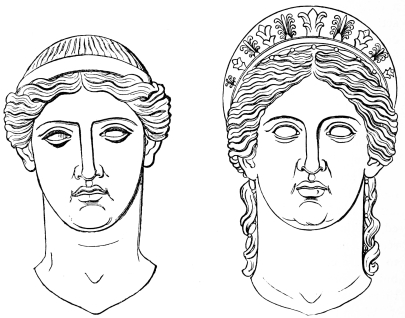
Fig. 218.—Head of Hera, in Naples.
Fig. 219.—So-called Juno Ludovisi, in Rome.
The effort after perfection of form sufficed to make the master of Argos a pre-eminent teacher; yet none of his many direct scholars, with the exception perhaps of the before-mentioned Naukydes, acquired{327} such fame as the associates of Pheidias, perhaps on account of this very schooling and discipline, the rigid constraint of a canon fettering the wings of artistic individuality. We are not able to judge how far this tendency was furthered during the short period of Theban ascendency by the somewhat later branch of the Theban school, although, among many others, the Theban artists Hypatodoros and Aristogeiton were of considerable importance. The groups consecrated at Delphi about 380 B.C. were of particular interest; they represented the advance of the Seven against Thebes, and the successful repetition of the invasion by the sons of those warriors. It was not until Lysippos, an indirect scholar of Polycleitos, in his desire to represent men as they should be, had raised himself entirely above the canon of his master, who aimed to show them as they are, that another artist of the first rank appeared. Examples from the workshop of Polycleitos still exist, though unfortunately scarcely recognizable in the mutilated fragments of sculpture from the Temple of Hera, discovered by Rangabe and Bursian in 1854—works which were doubtless executed under the direct guidance of the Argive master, as those of the Parthenon were under that of Pheidias.
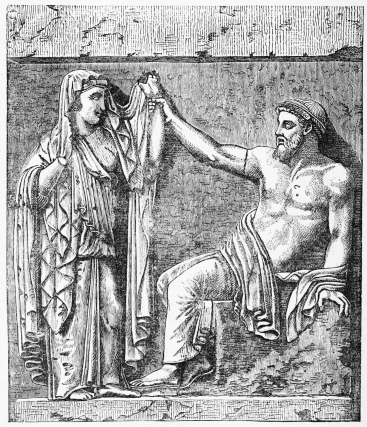
Fig. 220.—Metope of the Southern Temple upon the Eastern
Plateau of Selinous.
The influence of Attica and Argos not only prevailed in Greece proper, but made itself felt even in the most remote colonies. The Zeus upon one of the metopes of the southern temple on the eastern plateau of Selinous (Fig. 220) may have been developed from the figures of Zeus by Ageladas, and suggests the sculptures of the Olympian temple which was completed about the same time. This metope represents Zeus fascinated by Hera upon Mount Ida (Il. xiv. 300), and the artist, in his figure of the god, has surpassed his former efforts, but the Hera is harder and more antique. The other well-preserved metopes of this temple—one of which shows a Heracles in strife with Amazons, and the other Actaion lacerated by dogs—though not without provincial weakness, have an unmistakable affinity to those of the Theseion. These were nearly contemporaneous, but an entire generation later there appeared at Messene, in the most remote part of the Peloponnesos, the sculptor Damophon, an artist decidedly of the Pheidian style, on account of which he was called to restore the Olympian statue, already warped and disjointed.{328} Although a sculptor of ability, it would seem that he did not entirely withstand the current of a new direction in art; besides the statues in the Pheidian circle of divinities, others were ascribed to him, of a nature similar to those cultivated by preference during the succeeding period of Attic sculpture. The progressive force inherent in the people and in the art of Greece did not rest until the highest point had everywhere been reached. This impulse afterwards led to excess and decadence, permitting no lasting enjoyment of the previous gains. The art of Polycleitos prevailed somewhat longer in the Peloponnesos, the Dorians being by nature conservative,{329} but in Attica the new elements early obtained a sway which could not but essentially change the character of all Hellenic sculpture. The frieze upon the Temple of the Wingless Victory in Athens, and the somewhat coarser one within the naos of Phigalea, began already to give evidence of an inclination towards the pathetic and passionate; the sculptures also upon the balustrade of the Athenian temple, executed probably about 390 to 380 B.C., appear to be the unmistakable forerunners of a new style. The Athenian Kephisodotos the elder stood, so to speak, upon the threshold of this transformation. His position in the history of art is assured by the fortunate discovery of a copy of his Eirene with Ploutos, now in the Glyptothek at Munich (Fig. 221). This work combined the tendencies of the new Attic style with those of Pheidias. Though the noble simplicity and grandeur, the earnestness and strictness, of the earlier period still remained, there had already dawned an expression of deeper feeling, and of a more spiritual life.
The representation, as Friederichs says, of the deep interchange{330} of affection between mother and child, as shown in the Eirene of Kephisodotos, united with much of the hardness of the older works, culminated in two masters—the Parian Scopas and the Athenian Praxiteles, the latter possibly the son of Kephisodotos. Their productions were so nearly related that, even in antiquity, it was doubtful whether a work of celebrity should be ascribed to one or to the other. The chief creations of both were statues of the deities, both worked in marble, choosing this material not by chance, but from the nature of their subjects. With the exception of such colossal figures, of a highly monumental character, as the chryselephantine statues of Zeus and Athene Parthenos by Pheidias, and the Hera by Polycleitos, the delicate beauty of soft and transparent stone was best fitted for the images of deities enshrined within the temple; bronze, on the contrary, is peculiarly suited to statues of victors and athletes intended for outdoor exposure. It was on this account that it had been so largely employed by Myron and Polycleitos.
The Raging Bacchante, designated by epigrams and descriptions as the most celebrated work of Scopas, was one of the first masterpieces of antiquity. The head was thrown back in an ecstasy of passion, the hair loosened, and the long garment fluttering in the wind; thus did the Mainad appear rushing to the heights of Kithairon, holding in her hands the kid rent in her fury. If the rhetor Kallistratos was, as he says, speechless at sight of the countenance, admiring particularly the expression of a soul stung into madness, we can well believe that passion itself was embodied in this work. The excitement was more moderate in the Apollo of the Temple of Nemesis at Rhamnous, brought by Augustus to the Palatine,{331} playing the lyre and singing with lyric inspiration. It is not improbable that the motive of the Apollo in the Vatican, with the long flowing garments (Fig. 222), may be referred to this original. The entire bearing more closely resembles that of the figures of the children of Niobe. We can hardly think without enthusiasm of the Bithynian Achilles group, placed in later times in the Temple of Neptune, near the Circus Flaminius in Rome, which, according to Pliny, would have made the master celebrated even though he had created nothing else during his lifetime. It represented Achilles upon the island of Leuke after his death, and his reception among the deities, and displayed, besides Thetis and Poseidon, numerous fantastic creatures of the sea. Some idea of these last may be gained from a magnificent frieze found in the vicinity of the Temple of Neptune, and now in the Glyptothek at Munich. But it cannot belong to this group, and, in its main features, has no close relations with it.
Delicate beauty and warmth of feeling must be ascribed to the works of Scopas, otherwise Pliny could not have placed the Aphrodite found in the Temple of Mars, near the Circus Flaminius, above that of Praxiteles. Nor can we imagine the groups at Megara—Eros, Himeros, and Pothos (Love, Yearning, and Desire)—described by Pausanias; or Aphrodite, with her priestly lover Phaethon; or Pothos, in Samothrace, to have been without these traits. The group of Leto with the nurse Ortygia carrying the children, Apollo and Artemis, as the personification of a mother’s joy and pride, must have been full of deep meaning. It is evident, from the long list of his{332} works, that his power was many-sided: his peculiar style is best exemplified in a grand composition, the group of the Niobids, though Pliny is in doubt whether it should be ascribed to Scopas or to Praxiteles. The original of this no longer exists, and even the very unequally executed pieces—to be found chiefly in the Uffizi at Florence, and in various repetitions in different museums—are not complete; still even thus they betray the greatness and individuality of this wonderful work. Niobe, wife of King Amphion of Thebes, and mother of fourteen children, in a boastful spirit, inherited from her father Tantalos, compared herself with Leto, who had only two, and ordered sacrifices to be made to herself rather than to that goddess. For this she was terribly chastised by Apollo and Artemis, her children being all slain before her eyes by the avenging arrows of the two deities. She herself, trying in vain to protect her youngest daughter, pressing against her, makes an attempt to draw her mantle over her head to hide the expression of despairing woe which, according to the legend, in a few moments turned her to stone. The figure, in its royal nobility and motherly despair, yet so free from contortion, has wonderful effect. (Figs. 223 and 224.) The children, already wounded and hurrying towards her, show pain, fear, and need of help in different degrees, but with that dignity and fine control which render it a tragedy in the highest sense. The various{333} struggles of feeling in the beautiful young faces; the excited wrestling with an invisible, unconquerable, relentless power, in every gesture, and in every motion of the swaying garments; the plaintive character of the lines throughout the whole composition, entirely opposed to the vertical tendency of the statuesque, and especially of the architectural art; the wavy flow which distinguishes it from the group at Ægina, and even from the quiet action of the figures in the gables of the Parthenon—are all so peculiar to this pathetic school, and so characteristic of its productions, that the Niobe will ever be considered the greatest example of its style.
In a study of the artistic character of Scopas, we must content ourselves, for the most part, with a few copies, and some not very full accounts. Still, original remains from his hand are not altogether wanting. We have seen that he was engaged in the sculptural ornamentation upon the eastern side of the Mausoleum of Halicarnassos; while upon the south and north sides his younger associates were employed—Timotheos, Bryaxis, and Leochares, the latter known to us by a copy in the Vatican of his Ganymede Carried Away by the Eagle of Zeus. But the greater part of the recognizable reliefs upon the frieze, the most important group of which represents the so often recurring battle of the Amazons, notwithstanding the wonderful beauty and pathos of the action, peculiar to the sculptured art of this period, is the work of artisans, and certainly not by the hand of a master of the first rank. (Fig. 225.) Among the numerous fragments of the statues found in the English excavations of 1856, which, from analogy with the mausoleums of the Roman emperors, may have stood between the columns, one at least, a well-preserved torso, probably of Zeus, found upon the eastern side, has been ascribed to Scopas. The others are, unfortunately, too much mutilated to allow of any reliable judgment, as the varying views of different authorities testify. At all events, these decorative works cannot be ranked with the more celebrated examples of this master.
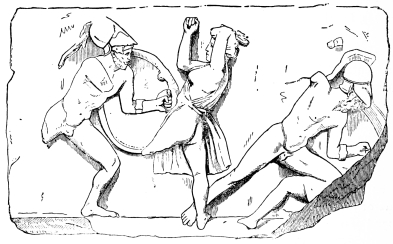
Fig. 225.—Fragment of the Frieze from the Mausoleum of
Halicarnassos.
An acquaintance with the art of Scopas is extended by the study of his younger and still more important contemporary Praxiteles. The masterpieces of this artist are similar in character, and betray all the preference of the former for the ideal beauty of youth. Not less than five statues of Aphrodite by Praxiteles are known to have{334} existed, among which the famous statue at Cnidos was regarded as one of the wonders of the world, and was ranked with the Olympian Zeus. It was so highly prized among lovers of art that King Nicomedes of Bithynia, for instance, in vain offered to the people of Cnidos the entire amount of their State debt in exchange for it. The brow, the moist glowing eyes, and soft smile of the slightly parted lips are described as wonderful; the whole figure being so executed as to cause the marble to be forgotten and the goddess of love to appear a reality. Coins of Cnidos show the figure to have been entirely nude, the left hand holding her drapery, partly lying upon a vase, and the right shielding herself in modesty. The best in this style among the numerous remaining statues were the Braschi Aphrodite, now in the Glyptothek at Munich, and that of the Vatican, which is, however, inferior in execution, and is, unfortunately, disfigured in the lower part by hard, modern drapery. Next to that of Cnidos in nobility and beauty must have been a draped Aphrodite from Cos, provided the people of that place had any understanding of art; for, when the choice between the two was offered them by the artist, they gave the preference to this. Of the three others, less known, the Thespian was placed next to the statue of Phryne, as contrasting divine with human beauty. To Praxiteles were ascribed, also, at{335} least two representations of Eros—blooming, youthful figures, of which the most celebrated seems to have been the Thespian or Bœotian one, which was installed between the Phryne and the Aphrodite. Epigrams and accounts describing the god as wounding not with the arrow, but the eye, appear to relate to this figure; for the second statue from Parion, in Mysia, according to the coins, showed the god unarmed, and with head uplifted.
A tender and almost effeminate character was exhibited in these beautiful figures of youth, similar to which were the Sauroctonos—the lizard-killer—the best copy of which is in the Louvre; the dreamily reposing Satyr, of which there are copies in various museums; and the smiling, sentimental Dionysos with the doeskin, leaning upon the thyrsos. Great depth of suffering and sorrow is the fundamental feature of two groups, one representing the rape of Proserpine, the other her delivery by Demeter to the lower world, to which she returned after every harvest, as a symbol of the following fruitless season.
This last was as pathetic an illustration of a sorely tested mother as could be found in any other work of Praxiteles. The mild Demeter was not less frequently presented by this master than was Aphrodite.
That greatest of all modern discoveries, the Hermes with the infant Dionysos, found in the Heraion at Olympia (Figs. 227 and 228), has proved the error of imputing to all the works of Praxiteles a delicate gracefulness verging upon weakness, which had arisen from the study of the only examples hitherto known—the copies of the Sauroctonos, the Satyr, and the Aphrodite. The manly force of this statue, in character midway between the conceptions of Pheidias and Lysippos,{336} is, indeed, so surprising that some scholars have even been inclined to assume a second sculptor by the name of Praxiteles, there being no reason to doubt the direct testimony of Pausanias as to the authorship of this work. The beauty of this torso exceeds that of all other antique statues known; the expression of the head conveys that intense sympathy between the loving protector and the child which must have characterized the work of Kephisodotos referred to above. It is possible that the Hermes was the product of an earlier period of the sculptor’s development, more closely related to the tendency and ideals of Pheidian art. When it is considered that this torso is the only surely authenticated original production of any great master of Greek sculpture—for it is by no means certain that the gable groups of the Parthenon are by the hand of Pheidias himself—there is no need for further discussion of the fundamental importance of this most fortunate discovery.
Notwithstanding the astonishing many-sided genius and productivity of Praxiteles, nearly all the Olympian deities appearing in the half hundred of his works, it must still be acknowledged that, besides his pathetic tendency, he particularly affected that province in which the figures of maidens or youths gave opportunity for the development of the greatest charms. His works portray a sensual loveliness distinguished{337} alike from that hard and abstract beauty, that outward perfection of form sought and attained by Polycleitos, and from that elevated, godlike being ideally embodied by Pheidias in his Zeus and his Athene. Neither entirely human, as with Polycleitos, nor divine, as with Pheidias, this emotional loveliness seemed created for the world of gods, but little raised above the sight and experience of men; and this type appears to have been as well established by Praxiteles as that of the higher deities by Pheidias. Its examples are the Aphrodite and Eros, the youthful Dionysos with his train, the Demeter, and the Eleusinian circle.
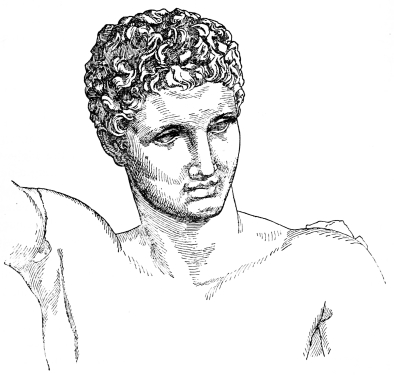
Fig. 228.—Head of the Hermes of Praxiteles.
However important the school of these two masters of pathos may have been, but few among the numerous names that have been preserved became prominent. The chief exceptions are the above-mentioned{338} assistants of Scopas upon the mausoleum, and the two sons of Praxiteles, Kephisodotos the younger, and Timarchos. Two of the greatest works of statuary, however, may be ascribed to their most vigorous scholars—the Venus of Melos in the Louvre (Fig. 229) and the so-called Ilioneus in the Glyptothek at Munich. If the doubtful inscription of the artist upon the former be credited, which, in characters of the first century B.C., designated it as the production of |Ale|xandros, son of Menides of Antioch upon the Meander, but which, together with the corresponding part of the plinth, has disappeared, we should possess in this work an inexplicable anachronism, a creation of the highest rank in art produced during a period of decided decadence. As, however, through this loss, this assumption cannot be verified, science must proceed to judge it by its style alone. Its grandeur and dignity, in contrast to the immodest coquetry of later works; the fulness of the flesh in this body of ever-blooming youth, in comparison with their attenuated grace; the mild softness of the surface beside the cold polish of the other figures of Aphrodite—would place this statue between the period of highest perfection at the time of Praxiteles, and that of the Roman reproductions. The reference of the Venus of Melos to the school of Praxiteles has found a justification not to be undervalued in the discovery of the Hermes at Olympia, this figure of manly youth forming as complete a pendant to the maidenly Venus as could be imagined. In artistic character{339} this is far more nearly related to the Hermes than is any other statue of Aphrodite, not excepting the undoubted Roman reproduction of that of Cnidos. At any rate, it is clearly an Hellenic original, not belonging to the period of later Hellenistic art.
Unfortunately, no explanation of this statue hitherto advanced has been entirely satisfactory. The two arms are wanting, and the fallen drapery covering the lower limbs has hidden from us the only accessory evidence—namely, the object upon which the lifted left leg is supported; so that even the name of Venus is not to be applied with the usual certainty. The Roman types of Victory, also half nude, with the same garments and position, and with the shield upon which the conquest is inscribed, suggest an Aphrodite-Victory analogous to the Attic Athene-Victory. The restorations all present points of difficulty; among them may be mentioned that commonly received, where the goddess contemplates herself in the shield of Ares, supported by the analogy of a statue mentioned by Pausanias (ii. 5), an interpretation equally applicable to the Venus of Capua, now in Naples; that also of Wiesler, with the lance in the uplifted left hand; and the combination of the goddess in a group with Ares by Quatremère de Quincy.
It is even less easy to find a reliable explanation of the beautiful torso in the Glyptothek at Munich, formerly held, falsely, to be Ilioneus among the Niobids, and even believed to be an original. As the Venus of Melos is an illustration of ripened womanly beauty, the entirely nude, cowering figure, without head or arms, represents the perfection of youth; and the position suggests a subject equal in pathetic import to that of the children of Niobe.
As the works of Scopas and Praxiteles frequently found their way to the islands of the Ægean Sea, and as the former, at least, had certainly dwelt for some time in Asia Minor, the influence of these two masters appears to have extended eastward, and their style to have had decided sway even longer there than in Greece proper. The farthest outlying examples are presented by the fragmentary statues of the Nereids from the Monument of Xanthos, to which they have given the name.
At that period, even in Athens, some highly esteemed artists{340} not only partially followed their own ways, but in these surpassed the former masters, and pursued aims which did not become generally prevalent until the middle of the fourth century, and then in quite other localities. These were Silanion of Athens and Euphranor of the Isthmos. The first devoted himself chiefly to portraits and representations of victors, and was so especially successful in the former as to make them a real embodiment of personal character; as, for instance, the portrait of the passionate sculptor Apollodoros was made to appear a personification of sudden rage. Silanion distinguished himself from Praxiteles in the subjects of his art, in which he had much in common with Lysippos. Euphranor was also, perhaps in a still greater degree, a painter, and, in the coarser power of his creations, was opposed to the delicate style of Praxiteles, showing more affinity with Lysippos, so far, at least, as we can judge of his sculptures by the accounts of his paintings.
Similar to the transitional position between Pheidias and Scopas, held by the elder Kephisodotos, was the position taken by these two sculptors between the art of Scopas and Praxiteles and that of Lysippos, for whom the studies and innovations in the canons of human proportions prepared the way. Though self-taught, for as a youth he had been a hand-worker in brass, and from this had raised himself to the position of an artist, he was still not without connection with the schools, since he took as his model the Doryphoros of Polycleitos, the academic pattern mentioned above, and also worked in bronze, the material most favored by Polycleitos and the artists of the Peloponnesos. He cannot, however, be called a direct scholar of Polycleitos, whose canon he corrected and even replaced by a new one, better adapted to the artistic aims of the younger masters. The model of Polycleitos was the human body, but Lysippos felt that he must set his ideal of humanity higher than in the average of real examples, because he considered these, in comparison with the perfect figure, to be degenerate and dwarfed. Although he worked with reference to this view, still he developed his types from the real appearances of nature; and when asked by the painter Eupompos of Sikyon for advice as to the best teacher, he pointed to an assemblage of people. He wished to represent man, however, not as he is, but as he should be, and employed{341} only those features which did not fall below the average determined by Polycleitos. His ideal type of the human body became more slender and larger, the size being especially apparent because the head and extremities, which take their proportions from the whole, were made smaller.
Lysippos, however, followed the footsteps of Polycleitos in considering the establishment of a canon as the greatest essential in art, and exercised his powers chiefly in the province of humanity. His Apoxyomenos—the athlete scraping himself with the strigil, a marble copy of which is in the Vatican—is the most celebrated among his statues of athletes and victors. (Fig. 230.) In this he seems to have set forth his new confession of faith, in opposition to that of Polycleitos. This aim must have had the most important influence upon portrait-sculpture, the chief field of his activity. It is clear from the accounts of some likenesses of persons long dead, or even legendary, that he fully expressed the character in the features, as in the Apollodoros of Silanion, and did not aim at that over-scrupulous reproduction of details and attention to circumstantial matters which endeavor to attain a likeness by sharp observation of external things, unessential to the whole. This inferior style{342} of portraiture was pursued by Lysistratos, the brother of Lysippos, who formed his figures after plaster casts from nature. Although earlier portraits might have informed the sculptor in regard to the true features of some historical personages, certainly this could not have been the case with Æsop, or the Seven Wise Men, for whose individuality and intellectual tendencies he was obliged to create a characteristic type. In the portrait which he most frequently executed, that of Alexander the Great, it was of especial importance to illuminate the ugly and faulty formation of the monarch’s face by the expression of his powerful character, and to execute it so appropriately that even the likeness was increased by such depth of appreciation. The artist thus produced portraits of the conqueror which differed as much, and as favorably, from the realistic and chance appearance of the king as the historic illustration of a great personage does from the knowledge of that individual in every-day life. Alexander, accordingly, would be represented in sculpture by no one except Lysippos, as he would be painted by none but Apelles. Even that best-preserved portrait of Alexander, the bust in the Capitol, does not suffice to make clear the whole conception of Lysippos. How grand such monumental portraitures really were may be gathered from the account of the group at Dium—afterwards transferred to the Portico of Octavia in Rome—illustrating a scene from the battle upon the Granicos, where twenty-five warriors on horseback and nine on foot were grouped about the king, to which many of the enemy may doubtless be added.
The work next in importance after this was the representation of Heracles by this master. Not in the elevation of the ideal above the human, but rather in the emphasizing of this latter quality, did the Heracles of Lysippos stand in distinct opposition alike to the merely human model of Polycleitos, to the superhuman and godlike beings of Pheidias, and especially to the divinely charming beauty of the Aphrodite and the Eros, as seen in the best creations of Scopas and Praxiteles. The Heracles of Lysippos, the embodiment of strength developed beyond human possibility, appeared colossal, whether the absolute dimensions were really great—like the statue from Tarention which represented him resting upon a basket after the labor of cleansing the Augean stables—or whether in miniature,{343} suitable for a table ornament—like the celebrated Epitrapezios, showing the hero as a drinker. Copies, in part, still remain of the Labors of Heracles, executed in twelve groups for Alyzia, in Acarnania. They show the same type that is reproduced in the affected, overstrained statue of the later Athenian artist Glycon—the so-called Farnese Hercules in Naples. (Fig. 231.)
Besides these prominent groups by Lysippos, evidences of his creative energy, the figures of the deities appear to have been few in number. That examples from the circle of young and beautiful divinities, which formed the principal field for the art of Praxiteles, should be almost entirely wanting, was to be expected, he who had perfected the type of Heracles naturally preferring a powerful figure. Four statues of Zeus are mentioned. Though the colossal size of these seems to have been a prominent feature—the Zeus of Tarention measuring eighteen metres in height—still they should not be considered as executed after a conventional pattern, and consequently offering nothing worthy of remark. In view of all that is known of Lysippos, it seems not improbable that the Zeus of Otricoli (Fig. 232), formerly referred{344} to the Pheidian type, may be more nearly related to its modification by Lysippos. The Helios upon the quadriga in Rhodes, besides its human beauty, may possibly have been of great importance in type and conception; but this is not assured by the fact that Nero prized it highly, and ordered it to be gilded. If it be added that Lysippos worked more industriously and rapidly than any other known sculptor—provided the account be true that the number of his productions amounted to fifteen hundred—it cannot be supposed that the time required for new conception and careful execution would be given to them all.
The school of Lysippos was not wanting in names of renown. His most gifted son, Euthycrates, appears to have equalled his father in groups of portrait statues, like the Gathering of Riders and a Hunt of Alexander in Thespia; while another son, Boidas, awakens our interest from the circumstance that the celebrated Praying Boy, in the museum at Berlin, may possibly be referred to him. Chares of Lindos produced the greatest known work of Greek sculpture in regard to size—namely, the colossal statue of the sun at Rhodes, over thirty metres high. Pliny describes it as already fallen and in ruins, therefore his words give us no information as to the conception and style; and the current account of its having stood so high above the entrance to the harbor that vessels sailed between the legs is a fabulous reminiscence of the figure projected at Mount Athos by Deinocrates. Among the scholars of Lysippos, Eutychides seems to have been the most independent; the goddess Anticheia, a copy of which is in the Vatican, was distinguished by excellence in the motive, ease of position, and effective drapery; but, in its genre-like treatment, it excluded all thought of religious{345} art, to which a certain strictness and dignity should pertain. This goddess was seated with dignity, like a city itself, while another personification—the river-god—appeared “more flowing than water.” This marked significance in both cannot be ascribed to a happy chance, but must be regarded as evidence of that highly developed characterization by which the great Sikyonian master endeavored to conceive the whole being and to embody it in his portraits and representative figures. Among the nameless works from the school of Lysippos, creations are to be found of the highest merit. The originator of the Barberini Faun, now in the Glyptothek at Munich, whoever he may have been, should be ranked among the greatest masters of all times.
With Lysippos the development of art in its principal directions was terminated. As Overbeck says, “the summit lies behind us; we descend, and our way downwards may still lead through charming landscapes; but the pure, clear ether soon ceases to surround us, and, before the far-reaching glance, rises from the mist of centuries the flat and endless desert, in the sands of which the stream of Grecian art is quenched.” Alexander himself was the patron of the last of the seven great masters of sculpture; with him ended the fresh directness of Hellenic creations, as well as the greatness of Greece itself. He and his successors built temples afterwards to be furnished, as before, with statues of the deities and outwardly ornamented with sculptures; but they took their models from those earlier works which, elevated to a typical and canonical importance, were not to be surpassed, and employed themselves simply in reproducing. They followed more willingly the easy path open to them because, in the Alexandrian period, scepticism, empty formalism, and chilling indifference had already laid the ravaging axe to the Hellenic religion. With the spread of Hellenic power into the heart of Asia, its art, like its polity, lost its individuality, becoming expansive instead of intense, in decorative subjection to the requirements of elegance and use. Losing its former independent nobility, sculpture soon fell from the height which it had occupied for a century and a half. Athens, Sikyon, and Argos, hitherto central points of development, where art had brought forth its richest fruits as a model for the entire Hellenic world, now became provincial cities of the{346} Macedonian kingdom, and lost their glory—some for a long period, and others forever. Following the example of Lysippos, artists preferred wandering from court to court of Alexander’s successors; and in Alexandria, Antioch, Seleucia, in Nicomedia, Pergamon, Ambrakia, mostly new and elegant cities of royal residence, occupation could not have been wanting, though the quantity of work may have tended to hasten the decline. How extensive and extravagant were the artistic requirements of the Diadochi, how excessive the incense of flattery offered them, is shown in the description of the luxurious works of the Ptolemies and of the Seleucidæ, and by the three hundred statues erected to Demetrius Phalereus in Athens alone. These last may have been somewhat better than the representation of the winds upon the clepsydra and vane of Andronicos Kyrrhestios (Figs. 233 and 234), but even they must be classed as mere artisan-work. Much was done in portrait-statuary after the time of Alexander, who turned art in this direction; and the successive dynasties also encouraged it, as may easily be imagined. This is evident from the statues still preserved, from the Ptolemaic cameos, and especially the coins of the Diadochi. The heads of these kings have never been equalled, for fine and lifelike characterization and modelling, in all the portrait coins and medallions which have been struck down to the present time. (Fig. 235.){347}
Though a great deal was produced in the period of the Diadochi, and, in the line of portraiture, much that was good, still there must have been truth in the saying of Pliny that “after the 121st Olympiad (290 B.C.) art ceased, and revived again only in the 156th (150 B.C.).” It ceased, namely, in so far as it was made subservient to courts and decoration; but upon the soil of Greece itself, and among the people, it grew, and strove after higher aims. The production continued, but its artisan-like elaboration did not make good the lost artistic originality. Men of vigorous talent followed in the paths of Praxiteles and Lysippos, producing works which are the ornaments of our antique collections; but the character of reproductions, clinging to their creations, robs them of the name of artist in the full sense of the word. The scanty notices of Pliny are, in general, correct; but he omits to mention some exceptions which represent a further development of sculpture, not quite unimportant, though questionable in principle.

Antiochos I. of Syria. 281 to 262.
Philip V. of Macedon. 220 to 178.
Perseus of Macedon. 178 to 168.
Fig. 235.—Coins of the Diadochi.
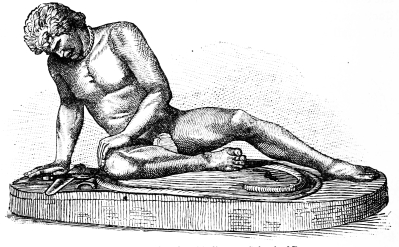
Fig. 236.—The So-called Dying Gladiator. School of
Pergamon.
In two places, at the royal court of Pergamon and in the republic of Rhodes, productive art rose again to a certain independence and originality. Pliny himself, in another place, says that “several artists illustrated the battles of Attalos and Eumenes against the Gauls; namely, Isigonos, Phycomachos, Stratonicos, and Antigonos.” The great victory over these barbarians was fought in 229 B.C. by Attalos, with which Eumenes, by a misunderstanding easily to be explained, appears to have been connected. Attalos erected in his capital a grand monument to his victory, and, not contenting himself with this, consecrated another upon the Acropolis at Athens,{348} perhaps in part a copy of that in Pergamon. Remnants of both monuments still exist which give a comparatively good knowledge of the artistic peculiarities of this school. The investigations upon this site, now approaching completion, have unearthed hundreds of fragments in high-relief, part of a gigantomachia originally forming the decoration of an altar. The altar was surrounded by Ionic colonnades, the high stereobate of which was ornamented with sculptures in high-relief, the whole being elevated upon a gigantic terrace, 38 m. long, and 34 m. broad. The frieze, representing the gigantomachia, stands midway between the works of Lysippos and the Laocoon, and forms the most extensive and important monument of sculpture remaining from the time of the Diadochi; it is in many respects a parallel to that of the Mausoleum of Halicarnassos which represents the decorative work of the school of Scopas and Praxiteles. These works have now found their way to Berlin, but a critical account of them will be possible only when they shall have been made generally accessible by an official publication. The statue of the so-called Dying Gladiator of the Capitol belonged to the group in Pergamon already known (Fig. 236); as did the two figures in the Villa Ludovisi, representing a Gaul who, to escape the shame of slavery, has stabbed his wife, who sinks beside him, and is{349} about to thrust the sword into his own neck. In the so-called Dying Gladiator, the rough hair growing low upon the neck, the strongly marked indentation between the brow and the projecting Northern nose, the beard shorn to the upper lip, the heavy cheek-bones, the fleshy and somewhat clumsily formed body, the hard and calloused skin upon the hands and feet, the twisted neckband, and the curved battle-horn have long since shown the meaning of this statue. In the group in the Ludovisi Villa, the same marble, a like and peculiar treatment of the forms, with the same type of head, leave no doubt that this also belonged to a large group representing a victory over the Gauls. From its style, it cannot be considered as a Roman monument, particularly as some notices of the Athenian Votive Offering of Attalos clearly identify it.
The most striking novelty in these monuments, and also in the school of art at Pergamon, is the characteristic following-out of ethnographical differences. Previously, when artists would distinguish barbarians, they were content to make the nationality clear by costume and accessories; but this could not suffice for Lysippos, who had carried individual characterization to such a height in his portrait-statues, and who probably, in his group of the battle upon the Granicos, illustrated the peculiarities of the Persian race. In groups of portrait-statues it was necessary to treat the action with absolute truthfulness, thus leading the way to historic art. This is perfected in the monument in question, the ideal battle scene being based upon real details; it was not merely a strife among men, but Greeks and Celts stood opposed, each nation with its marked features and peculiarities, the barbarians distinguished not outwardly alone, but by their natural wildness.
This is evident from a number of figures of the Athenian votive offering of Attalos, still preserved; our knowledge of their connection with the Dying Gladiator and the school of Pergamon is due to Brunn. According to Pausanias, this votive offering consisted of figures half the size of life, in four groups, showing the gigantomachia, the combat of the Amazons, the battle of Marathon, and the victory of Attalos. Figures exist from them all; from the first, a giant, dead and outstretched, is in the museum at Naples, as also one of the second, a fallen Amazon; from the third, a dead body clad in{350} breeches, and two nude Persians kneeling, are in Naples, the Vatican, and in the possession of Signor Castellani. From the fourth, a kneeling figure, at Paris, and one kneeling and one falling backward, at Venice, are unmistakable Gauls; while a sitting figure, wounded, also at Venice, and a youthful one, dead, at Naples, are probably also of that race. Judging from these remains, the composition must have included numerous figures, as the five existing Gauls—perhaps also several more—bespeak a corresponding number at Pergamon, and forty is the lowest that can be reckoned for the whole. Their position was probably upon the steps of the monument, which possibly bore the statue of the founder. It must have stood near the wall of the Acropolis, since it has been said that a figure from the gigantomachia was thrown by a storm into the theatre which stood at the foot of this fortress. That only the conquered are found among the pieces preserved seems to be an evidence that these remnants are from the original rather than from any copy, because, aside from the improbability that so extensive a work would have been copied in later times, the effect of the storm suggests the thought that the erect statues of the victors would have been less likely to last through so many centuries than the lying and cowering figures, not so easily injured on account of their closer connection with the base. Notwithstanding their relation in style to the Capitoline statue and to the group in the Ludovisi Villa, these are distinctly inferior and harder. Brunn is probably right in his supposition that they are the work of scholars, and a contemporaneous reproduction from the studio of that master, who himself executed the monument at Pergamon, the figures of which ranked in merit with the Dying Gladiator. Many deficiencies may be accounted for by its reduction to half life-size; its repetition at this scale, for the Athenian votive offering, appearing to have satisfied the king.
The work most nearly related to this, also in marble, and perfectly similar in conception, is a figure of the Marsyas group, the celebrated Knife-sharpener in the Uffizi at Florence. This is also a representative of barbarism, probably a Scythian, the others having been Gauls; but, artistically, this makes no difference. No originals remain of the other figures in the group, of which the barbarian,{351} cowering upon the ground and sharpening the knife for the flaying of Marsyas, probably formed no very important part. Another aim, the careful anatomical treatment of the body, is ostentatiously displayed in the copies of this work now in Berlin and Florence. The group suggests another locality, and forms a connecting medium between those two most important centres of art in that period, Pergamon and Rhodes.
Among the few republics of the time, the island of Rhodes was able to rival the brilliant courts of kings, in regard to artistic treasures, by its wealth of commerce and its political neutrality—the latter being rendered possible, as nowhere else, by its situation and importance. That the influence of Lysippos prevailed there is clear from the fact that, after this master had sent thither his Phoibos upon the quadriga, the Rhodian Chares went to learn of him, and afterwards executed for his native city the above-mentioned colossus. This was followed in the same place by a hundred other colossal figures, which were probably related, in point of style, to the works of Lysippos. The statement of Pliny that each, singly, would have sufficed to make the place of its exposition famous is hardly intelligible. Numerous names of artists, mostly of Rhodes, found partly in inscriptions upon the bases, and partly mentioned by Pliny, might here be mentioned.
The multiplied productions of colossal works, however, would not suffice to give a very favorable idea of the state of art in Rhodes, were it not for the preservation of two examples, prominent among many, which were famous even in antiquity. These were the group of the Laocoon, in the Vatican, and the so-called Farnese Bull, in Naples. The first (Fig. 237), which Pliny, with extravagant praise, calls the work of three Rhodians, Agesandros, Athanodoros, and Polydoros, was found in 1506—not in one piece, as he describes it, but in six—among the ruins of the house of Titus, in whose palace Pliny says it was placed. It represents the priest Laocoon, who sinned at the altar through love, and whom Apollo chastised by means of two serpents. This expiation became tragic, from its having taken place at the moment when Laocoon had resolved to save his native city, Troy; and also from the suffering of the children, innocent, though born in sin. The serpents have encircled the three figures;{352} the youngest is falling from the deadly sting; the father, sinking upon the altar after a desperate defence, is no longer able to protect himself; while the elder son, not yet threatened with instant death, but hopelessly entangled in the coils of the serpent, turns upon his father a look of despairing horror.
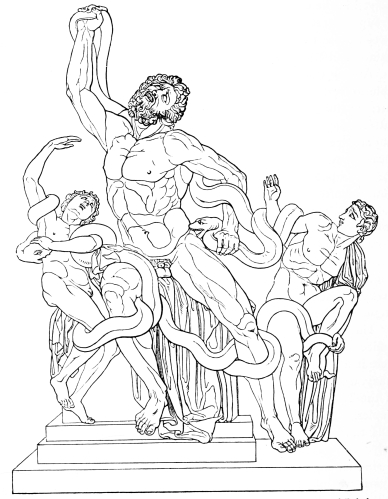
Fig. 237.—Group of Laocoon and his Sons, by Agesandros,
Athanodoros, and Polydoros.
(Vatican.)
{353}This grand work, though from Pliny down to later times esteemed beyond its real merit, still makes evident to us peculiarities in the art of Rhodes which, in many respects, render it of independent value. We find in it a choice of subject new in sculpture, the technical and artistic difficulties of which appear almost insurmountable, so that it could only be treated by ability well trained and long experienced. It gave opportunity to surpass all existing productions in its display of artistic technical superiority. When the body of the Laocoon is compared with the type of Heracles, it cannot be doubted that the canon of Lysippos was followed; but the forms, which with him were developed from the living model, in this, as in the Marsyas of Pergamon, are taken from anatomical studies, and are wanting in fulness of life: the overdetailed muscles are too studied, distinct, and separated; they are marble, and not flesh. The composition would, in real life, be impracticable; the action is visibly so ordered that it never could be possible, and is throughout developed with an aim towards the greatest effect. But this effect is by no means merely formal, limited to the restless and disquieting play of the lines of the limbs and trunks, and of the coils of the serpents. It is in the highest degree pathetic. Thus this element of the school of Praxiteles existed in this work, both the leading characteristics of that master being here displayed with an excessive ostentation. The pathos confronts us too exclusively, not modified by any ethic principle. The work does not, therefore, have the tragic power which lies in the descriptions of Sophocles, because, in the group, only the effect is to be seen; we have no hint as to the cause. The pathetic blends far more with the pathological event than with the ethical. The mastery of rendering, the composition, the effect—everything is wonderful; but it all lies in the realm of display: our admiration is given to the artist rather than to the work. It cannot be denied that this effective treatment was the dominant feature in the art of Rhodes; but it set technical mastery in the foreground, to the neglect of absolute and intrinsic merit.
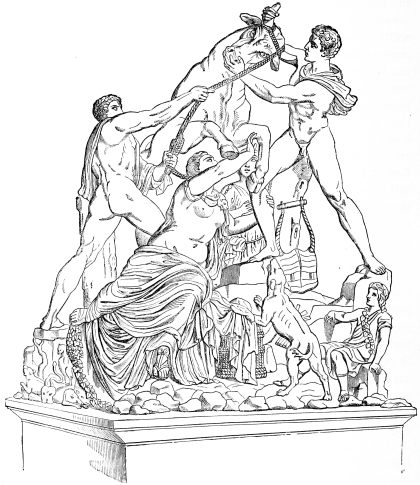
Fig. 238.—The Farnese Bull of Apollonios and Tauriscos.
(In Naples.)
This applies equally to the second great work, the so-called Farnese Bull (Fig. 238), the creation of two artists from Tralles, Apollonios and Tauriscos, who may have worked in Rhodes, as, according to Pliny, the group was to be seen there before it was brought to Rome under Augustus. This large group was found in the Baths{354} of Caracalla soon after the discovery of the Laocoon, and was transported to Naples, where it now stands in the Museo Nazionale. The scene is probably taken from the Antiope, a tragedy of Euripides, and an understanding of the story is necessary to its comprehension. Antiope was the daughter of King Nycteus of Thebes; he being angry with her because of the love of Zeus, and incredulous as to the cause of her pregnancy, she fled to Mount Kithairon, where she{355} bore the twins Zethos and Amphion. Having given these to the care of a shepherd, she was received by King Epopeus of Sikyon; but Lycos, the brother and successor of Nycteus, carried on the hateful persecution, even to the extent of making war against her protector. Sikyon was destroyed, and Antiope returned as a slave to Thebes, where the ill-treatment of Dirke, wife of Lycos, obliged her to fly once more to the mountains. There, at a festival of Bacchus, she was found again by her persecutor, and, for her flight, was given the terrible punishment of being dragged to death by a bull. Zethos and Amphion were ready to execute the command when a recognition took place, and a just vengeance brought the fate intended for Antiope upon the head of Dirke. This moment forms the imposing scene of the group. The raging bull is only with difficulty held by the avenging sons; Dirke, a most beautiful woman, praying in vain for grace, clasps the knee of one while the other is ready to throw around her the noose by which she is to be dragged over the rough ground of Kithairon. The passion of the avenging sons, and the fear of Dirke, make the work highly pathetic and impressive; but it is not so really tragic as the Laocoon, because the motive of the evidently brutal deed, though not entirely neglected, as in the former, is still not entirely comprehensible. Antiope, the heroine of the tragedy, is indeed present. But she is not brought into the action, and stands, in fact, behind the principal characters. She is therefore hardly more than a lay figure, expressing nothing. It might perhaps have been better to omit Antiope altogether, and to leave the action without any motive at all. The figure has, however, an interest of its own, being in an excellent state of preservation, while the others have suffered by restoration and by retouching. The composition, with its numerous figures, admirably executed, has a picturesque effect which is somewhat new in the history of Greek sculpture. This is enhanced by the accessories of the story, the rocky ground, and many local details symbolical of the occasion. Besides a fine large dog, really belonging to the group, there are a chaplet and a basket, a disproportionately small boy ornamented with a wreath, and, still more inferior in size, two lions seizing a bull and a horse. There are also two boars coming out from a grotto, a lioness, a stag, a hind, a ram, an eagle with a snake, and a falcon{356} over a dead bird; even turtles, snakes, and snails are represented. The mastery over the technical and artistic difficulties in this work is scarcely less admirable than in the Laocoon, and it gives the same impression of a successful piece of bravura, astonishing and quite fascinating for its novelty, boldness, and versatile power. The age, indeed, satiated with the best products of various schools, demanded the stimulus of an excessive appeal to superficial sources of interest. The group of the Marsyas is attributed to artists of Pergamon, and the Wrestlers in the Uffizi at Florence (Fig. 239) may, with greater certainty, be ascribed to those of Rhodes.
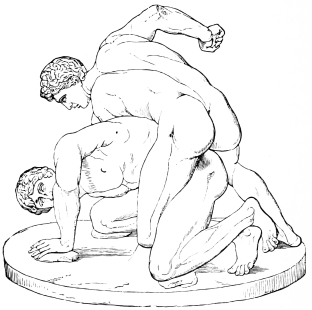
Fig. 239.—The Wrestlers. (In the Uffizi, Florence.)
Before we pass to the last active period of Hellenic art, one other work, preserved from this age, the Apollo Belvedere of the Vatican (Fig. 240), still claims our consideration. Though without the name of the artist, or of the place of its origin, and not, perhaps, to be classed directly with the greatest productions of Pergamon and Rhodes, it is yet not unworthy to rank by their side. It is, like the Laocoon, one of the best-known statues among the existing treasures{357} of antiquity, and scarcely needs a minute description. The splendid triumphant head looking into the distance, the slender figure, as fine in modelling as it is noble, the pleasing grace of the light step, assure for it an admiration, the more universal as these beauties—the combined result of the schools of Lysippos and of Praxiteles—are just those which are the most generally recognized. It is not an original work, in the full sense of the word, but an early Roman copy from the bronze, and seems to bear a closer relation to it than does the lately discovered head which is now in the museum at Basle. This latter has lost the characteristic features of the bronze style, and from the greater freedom of its treatment may be called a translation into marble, in distinction from the copy in the Vatican. Another reproduction of this work recently made known by Stephani, a bronze statuette in the Strogonoff collection, at St. Petersburg, has given an additional explanation of the action in which the god was represented. In the marble the left hand was wanting, and in the restoration this was supplied with a bow; but in the Strogonoff Apollo remains are still to be seen of the ægis, held in the hand, with which the deity drove back the Greeks, as described by Homer, Il. xv. 306. If the far-shooter be thus changed into the ægis-bearer, the shaking of the ægis symbolizing the storm, a plain reference{358} may be found to the original motive of the work. When the Gauls threatened Delphi in 279 B.C., the defence of the Greeks was effectively assisted by a terrible storm, which threw the barbarians into a fearful panic, and which was regarded by the Greeks as caused by the personal intervention of Apollo, Athene, and Artemis. This might well have had an effect upon art similar to that of the victory of Attalos over the Gauls in Asia Minor. The Ætolians, indeed, proposed to erect at Delphi a votive offering, with figures of field-officers and of the three gods, while a statue of Apollo was erected in Patrae from a similar reason. In view of this, Overbeck has ventured to combine the Apollo Belvedere, the Artemis of Versailles (Fig. 241), and the striding Athene of the Capitoline Museum into one group, to which ideal union the unsimilarity of the workmanship, and even of the scale of the three statues, is not so much opposed—since these are all copies that have come down to us from different times—as is the movement of the Apollo, the middle figure, towards the right. This difficulty might be met by changing the positions, so that Athene should stand at the right and Artemis at the left, whereby the action of the figures might be from, rather than towards, each other, Artemis being turned decidedly more towards the front. If, however, this work originated in consequence of the victory in 279 B.C., it shows that a generation before the time of Attalos, at least in Greece proper, although attention had already been devoted to momentary action, art nevertheless still stood upon an ideal height, and could still delineate gods worthy of admiration.
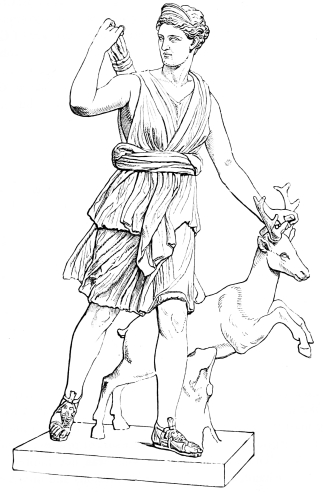
Fig. 241.—Artemis of Versailles.
These artistic efforts do not, on the whole, refute the opinion of Pliny that art ceased from the 121st to the 156th Olympiad—that is, from 300 to 150 B.C. The chief localities of its activity, Pergamon and Rhodes, may be considered only as asylums found by the higher sculpture after it had lost all foothold in its native home. But when he says it took a new flight at the close of that period, we must acknowledge that the result was not of that kind which could charm us as it did the Roman narrator. As Brunn remarks, the date of Pliny agrees with that period when Hellenic art attained a decided mastery in Rome. Scarcely any evidences of the monumental art of Greece were to be recognized in Rome before the conquest of Syracuse in 212 B.C. After this time the Roman triumphs{359} brought forth, one after another, an almost oppressive number of productions, so that the art of the Greek colonies, and of Greece itself, overflowed Rome in a broad stream. Not to mention the plundering of Capua, Tarention, and numerous Grecian cities in Lower Italy, we have an example in the triumphs of Quintius Flaminius, the conqueror of Kynoskephalæ, 197 B.C., when the transportation{360} of the statues lasted an entire day. The booty taken from Western Greece by M. Fulvius Nobilior, in 189 B.C., also contained not less than five hundred and fifteen statues. These extensive plunderings were at least equalled by the triumphs of L. Cornelius Scipio, the victor over Antiochos; of Æmilius Paulus, conqueror of Perseus; of Metellus Macedonicus, and of the destroyer of Corinth, Mummius, who has become proverbial for his barbarous robberies. It was not strange that at last a living art followed the triumphal chariot of Roman victories. Metellus employed many Grecian artists in the erection and ornamentation of his new buildings in Rome.
The scene of artistic industry thus became changed, and Rome, a foreign city, became the central point—first of possession, and afterwards of artistic activity. It might therefore be questioned whether what follows were not better suited to the chapter upon Rome; but it must be considered that the Romans were, from our present point of view, only wealthy collectors and patrons of art, and that the artists employed were still Grecian, and of the Hellenic school. This was not altered by their working in Rome, or even by their learning from the numberless productions accumulated there.
Roman grandeur was long contented with artistic booty for the ornamenting of its forums, temples, and public buildings; the immense wealth of the empire and proconsulate giving opportunity for procuring celebrated works by force, by purchase, or as honorary gifts. This brought forth dilettanteism, which led to the study of art, and to a zeal for collecting which made every new acquisition an additional incentive to covetousness. Study choked that impulse which, in a degenerate way, had endeavored to outdo what had been done by masters of the best period, and, accounting their method to be exclusively good, turned art back by a sort of reaction upon those earlier paths. The passion for collecting was not limited to the works ready at hand, but would have restorations and imitations by contemporary artists, made in the spirit of the originals. It could not have been otherwise than that art, after having exhausted the originals, and attained its aims in all directions, should react upon itself; but doubtless the circumstances of Rome had an essential influence upon the manner in which this took place, and greatly furthered{361} this renaissance—to use a somewhat unsuitable term which, in its restricted sense, has been adopted for the far more original awakening of art at the close of the Middle Ages.
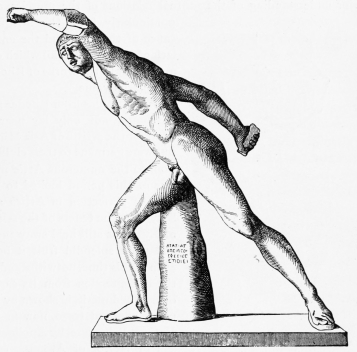
Fig. 242.—Borghese Gladiator of Agasias. (In the
Louvre.)
In the desire to enliven the different phases of artistic development, it was natural not to return to first principles, but rather to take those creations which lay near at hand, and try to find in them the way to improvement. The period under consideration, up to the commencement of the empire, offers examples of every stage of development, the dates of which can only here and there be given; but it seems that the way for an Hellenic renaissance was, during this period, partially opened.
Agasias of Ephesos appears as successor to the master of the Laocoon and of the Farnese Bull. The celebrated Borghese Gladiator in the Louvre, which represents a warrior in fictitious battle with a horseman, may be referred to the school of Rhodes. (Fig.{362} 242.) As the statue did not belong to a group, but was independent, we see in it nothing but a show figure, in which the artist only sought for a position where he might outdo all that had gone before, and give opportunity to parade his technical mastery and his anatomical knowledge. That the work should be placed in this time, and not in the best period of the Rhodian school, is plain from the later character of the writing in the artist’s inscription, from the inferior understanding of the mutual relations of the muscles, and particularly from the insignificance of the idea, and the entire lack of the pathetic, all which elements lent to the works of Rhodes an especial value.
As examples from Rhodes and Pergamon not only lay near at hand for the artists of Asia Minor, but were germane to their civilization, so the numerous Attic masters of this period looked to the time of perfection in Attica and Sikyon. The tenets of the school of Lysippos still held sway there, and what splendid fruit it bore, even at this time, notwithstanding the retrogression from its earlier overvalued merit, is shown by the much admired torso, now in the Vatican Belvedere, by Apollonios, son of Nestor of Athens. (Fig. 243.) This must certainly have been a sitting Heracles, a motive repeatedly treated by Lysippos, though no restoration of it has yet been decidedly successful. The most probable is the latest by Petersen, which represents him as playing the kithara. The somewhat later statue by Glycon of Athens, the Heracles, who stands leaning upon his club (Fig. 231), though approaching somewhat in conception to a work of Lysippos, is far inferior. With this may be mentioned a still poorer repetition, the Heracles of the Pitti Palace in Florence, through a false inscription ascribed to Lysippos.
Besides Apollonios, who was distinguished also by his youthful satyr and an Apollo, which are too little known for a more minute description, the school of Scopas and Praxiteles was followed by the son of Apollodoros of Athens, Cleomenes, the sculptor of the Venus de’ Medici. When compared with the divine figure of the Venus of Melos, though pleasing, it appears degenerate. The godlike beauty which we impute to the Cnidian Aphrodite, and find in the Venus of Melos, is lost by the continual emphasis of sensuous effects, notwithstanding all the mastery and delicate feeling for beauty. With the exception of the Braschi Venus at Munich and the Venus of the Capitol, which are more nearly related to that of Cnidos, nearly all the nude figures of Venus in the various museums belong to the same circle and stage of development, even when they betray later work. The masters by no means appear to have been mere copyists; but the works of Praxiteles were altered, to suit the taste of the times, by artists in whom individuality was not quite extinct.
The school of Pheidias, with its high ideal, of which the age in question had little understanding, could never have become popular in the same degree. Rome possessed but few works of this master which could have served as examples, and those not the most important. Still, reminiscences of the best Attic style were not wanting, especially in those figures of the gods the type of which had been established by Pheidias, as in the statues of Zeus and Athene. The chryselephantine Zeus, by Polycles and Dionysios, in Metellus’s Temple of Jupiter, as also the Capitoline of the same material by Apollonios, may justly be referred to the Olympian original; the former at least with the more certainty, when it is considered that the sons of Polycles—Timocles and Timarchides—copied the sculptures upon a shield of the Parthenos for an Athene, designed for Elateia in Phokis. It is possible—and this may, perhaps, be still further established by Brunn, who has pointed out this connection—that the Pallas in the Villa Ludovisi, by Antiochos of Athens, which has been estimated below its worth, may be a reproduction of the Parthenos, modified and perhaps formed from memory. The treatment of the garments, and the whole position of this otherwise ill-executed figure, remind us of the chryselephantine works, and possess something of the dignity and nobility of the better period.{364}
At a time when Cicero could say that in his opinion “the works of Polycleitos were perfectly beautiful” the master from Argos must have come into fashion. The artistic representative of this stage of appreciative development was Pasiteles, who worked in the time of Pompey, and whose important school has left traces of this influence in examples that have been preserved. The pathetic tendency was not entirely to be avoided, and, though not so evident in the academic male figure of the Villa Albani, which bears the name of Stephanos, the scholar of Pasiteles, is yet undeniable in the groups of Orestes and Electra in Naples, and of Orestes and Pylades in the Louvre. This trait is still more marked in a work of Menelaos, the scholar of Stephanos, the beautiful and celebrated group in the Villa Ludovisi (Fig. 244), designated by Winckelmann and Welcker as Electra and Orestes; by Jahn, as Merope and Cresphontes; by Kekulé, as Deianeira and Hyllos; and by Schulze and Burckhardt, as Penelope and Telemachos. Though the artist has here made concessions to more recent influences, they did not give the work an eclectic character, as asserted by Kekulé, but rather displayed a somewhat archaistic conception, and the short proportions of Polycleitos, long since abandoned for the canon of Lysippos. On the other hand, the remark of Kekulé appears just, that the characters do not seem conceived{365} and modelled after nature, but rather as seen through the medium of the tragedy of Euripides.
When the reproductions had run through the entire circle of styles from the best period of art, the archaic was at last brought forward. It is known that Augustus ornamented his buildings, particularly the gable of the Palatine Temple of Apollo, with sculptures of the masters from Chios, Boupalos and Athenis, and that he also carried away from Tegea the Athene of the old Attic Endoios. Archaic art, always possessing a charm for devotional images which was doubled in a time of such satiety, came thus into fashion. A large number of archaistic works appeared, imitated after the antique, as has already been mentioned. They not seldom betray the influence of single figures from larger compositions in relief, as in the instance of the Amphora of the Athenian Sosibios in the Louvre.
The more or less free reproductiveness of this period, which we have to thank for a large proportion of the contents of our museums, naturally came to a conclusion in that unbridled mixture of style which combined in the same relief not only the various aims of different schools, but their well-known motives, as is the case with the relief of the Salpion upon the font of Gaeta. There was very little originality, and that was limited to genre, particularly to the idyllic, as in the play of Cupids, the best of which might be referred to old models. It is not known whether{366} this was the case with the lioness of Arkesilaos, in the possession of Varro, which, according to Pliny’s description, bound by Cupids, was drinking from a horn, with mittens upon the paws to render them harmless. Models for this may be sought in the paintings of Alexandria. It is certain that the centaurs, bound and worried by Cupids, the best examples of which are preserved in the Louvre, the Vatican, the Doria Palace, and the Capitoline Museum, with that of Aristeas and Papias from Aphrodisias, are imitations of bronze originals. (Fig. 245.)
Hellenic architecture and sculpture, from their unsurpassed perfection, require a more comprehensive treatment than that accorded to those arts in any other ancient nation. This is especially the case with sculpture, because, in Greece, the demands of its nature were more completely fulfilled by the Greeks than has ever happened, at any time, with any other people; while Grecian architecture, notwithstanding its wonderful monumental perfection, did not deal with all the possibilities of the art. Both, however, demand our attention in a greater degree than does Hellenic painting. Architecture has left great masses of ruins, and sculpture numerous collections of antique treasures; but of Grecian painting there are no remains; its history is accordingly a history rather of artists than of art. If this necessitates for painting a more limited treatment, we must not therefore conclude that its development was, in reality, inferior to that of its sister arts, since, in fact, it fully equalled that of architecture and sculpture. This has often been unjustly doubted, but it would be fully evident were nothing more known than the almost measureless fame of the first masters.
The course of development of Grecian painting is by no means so obvious as that of sculpture: we have no sure date of its beginning, but it is at least equally remote. Conze shows painting to have been even the most primitive, it having existed among the aborigines in the decoration of pottery and terra-cotta. The notes of Pliny upon the matter (xxxv. 15) appear to be hardly more than a supplementary reconstruction of a conjectured state of development, garnished vaguely with the names of ancient artists. The first stages, the employment of a simple tone in the filling of outline figures with{367} a color of brick-dust, called monochromatic painting, had long since been mastered by the neighboring peoples—the Mesopotamians, Phœnicians, and Egyptians, who were acquainted also with the use of bright colors. This work must early have been known to the Greeks through imported articles—Homer mentioning vessels and fabrics—even though they could not apply it to the productions of their own land. Monochromatic painting upon pottery, familiar to the primitive Ionians, seems to have originated upon the Syro-Phœnician coasts. A faint reminiscence of the ancient, widely extended employment of color may be found in Pliny, who designates an Egyptian, bearing the Greek name of Philocles, as the discoverer of linear painting. Works of this kind, however, were purely decorative, like the older Greek vase-paintings (Figs. 187 and 191), and of great similarity; it seems unnecessary to offer conjectures as to the source whence this impulse came. Of still less significance are the names of artists which have been fabulously attached to the various inventions, such as Cleanthes, Aridikes, and Ecphantos, of Corinth; Telephanes and Craton, of Sikyon; and Saurias, of Samos. Unless, from the fact that several are mentioned as dwelling in Corinth and Sikyon, it may be concluded that decorative painting probably flourished in those cities before the sixtieth Olympiad (530 B.C.). What Pliny says of Eumaros of Athens does not justify the supposition of any considerable progress, although, in figures, he distinguished between male and female, expressed in some slight degree age and characteristic peculiarities, and, at least, made an end to that crudeness which found satisfaction in writing names over forms otherwise precisely alike. Greater progress was made by his successor, Kimon of Cleonæ—500 to 480 B.C.—who improved the former sack-like garments (Fig. 191) by folds, and gave a more detailed drawing to the nude, placing the eye in a profile head also in profile, instead of making it look towards the front, as in the figure mentioned above. With him began truthfulness to nature, and correctness of drawing, at a time when sculpture in Ægina, Athens, Sikyon, and Argos was preparing for that highest perfection attained afterwards by Pheidias.
After the Persian war, through two generations, the progress of painting was proportionate to its former backwardness, until it attained{368} a height little short of that reached by sculpture. The first master worthy of mention—and likewise one of the greatest artists we know—demands particular attention, from having been the founder of painting as an art. Polygnotos of Thasos (475 to 455 B.C.), the son of Aglaophon, who also is mentioned as a painter, executed the greater number of his works in Athens, where he was much respected by Kimon. Of the pictures in the Stoa Poikile, painted under his direction, at least the Conquest of Troy, and the Council of Princes sitting in judgment upon the sacrilege committed by Ajax against Cassandra, were by his hand. The Battle of the Amazons was by Micon, the Battle of Marathon by Panainos and Micon; the fourth, perhaps the latest, was the Battle between the Athenians and Lacedæmonians near Oinoe: the artist is not known. Polygnotos worked, together with Micon, upon other Athenian frescos, scenes from the lives of heroes in the Temple of Theseus. In the Temple of the Dioscuri he painted the Rape of the Daughters of Leukippos, next to which was the Return of the Argonauts, by Micon. In the Pinacotheca of the Propylæa was a series of representations, among which Brunn has recognized as companion pieces Diomedes Robbing Philoctetes of his Bow, and Odysseus Seizing the Palladion; the Murder of Ægisthos by Orestes, and the Sacrifice of Polyxena; Odysseus Appearing before Nausicaa and her Companions, and Achilles among the Daughters of Lycomedes. Of the other works by this master may be mentioned those at Thespeia and Plataia; that in the Temple of Athene at the latter place represented Odysseus attacking the suitors. The best of all the creations of Polygnotos, the paintings in the Lesche of the Cnidians at Delphi, illustrating the conquest of Ilion and the nether world, are so minutely described by Pausanias (x. 25-31) that they furnish the most important material for an understanding of his art.
We should hardly be able justly to estimate this master were it not for the descriptions of Pausanias; for the other classic authors, with some exceptions in Aristotle, deal only with secondary matters. In regard to his coloring, Cicero, in his “Four Colors,” says nothing, speaking only of his drawing, while Quintilian merely wonders how, in his time, there could still be admirers of such primitive painting. It was merely a coloring without light and shade, a simple treatment{369} by local tones of surfaces within outlines. That these tones were not unbroken, as upon the Nile and Tigris, but finely graded and everywhere characteristic, we learn from the special mention of the doves, of the shaded coloring of the fish in the Acheron, of the blackish-blue color of the corpse-devouring Eurynomos, and of the gray of the shipwrecked Ajax. The red cheeks of Cassandra, admired by Lucian, give evidence of several colors within the same outline. But though Cicero praises the drawing, the little which is intelligible in Pliny’s account of the master tends the other way. Still, it must be acknowledged that more is implied by the motive of the Olympian Jupiter, by the encomium upon Cassandra’s eyebrows by Lucian, and by the exaggerated expression of an epigram—“in the lids of Polyxena lay the whole Trojan war”—than the petty peculiarities with which Pliny invests the painter would lead us to expect. Ælian praises the strict carefulness and fineness of the outline drawing, the expression, and the garments. But the most remarkable testimony concerning this master is that of Aristotle, who describes his figures as surpassing nature; while artists like Dionysios contented themselves with equalling it, and others, like Pauson, were content to remain below it. Elsewhere he calls him the painter of ethics—that is, of character—in a grand style which the works of Zeuxis failed to attain. Combining this judgment with that of Ælian, who ascribes grandeur to Polygnotos, we may conclude that this artist drew in a broad and ideal style. That to this were united an epic clearness and liveliness of treatment, not only in the single figures and groups, but in the entire composition, is fully evident from the description which Pausanias gives of the paintings in the Lesche. In short, correctness, richness, and grandeur of composition must be accounted the chief merits of Polygnotos—merits to which none of his successors attained, though they may have far surpassed him in execution, as painters in a more restricted sense. Less painter than artist, he pursued, in his wall decorations, a thoroughly monumental direction, which after his time, through change of aim, was neglected.
The most celebrated companions of Polygnotos, but, as Ælian remarks, not equalling him in greatness, were Micon of Athens, whose name has already been mentioned, and Panainos, a cousin of Pheidias,{370} who, besides the battle of Marathon in the Poikile, executed the paintings upon the throne of the Pheidian Zeus in Olympia. Dionysios of Colophon and Pauson have already been spoken of. The first seems to have carried out the strict carefulness of his model, Polygnotos, to a degree which was naturally unfavorable alike to grace and to greatness of style. Pauson, though accounted an artist by Aristotle, may be compared to Buffalmacco, scorned and derided, among the companions of Giotto; not fitted for productions of a grand style, he did not attempt them, and his nude paintings, without ethical significance, were harmful to young observers.
Among the other distinguished masters of this time, Calliphon appears most nearly to have followed in the footsteps of Polygnotos; but his brother Aristophon, who brought painting upon panels into general use, pursued technical methods opposed to this school. The style of Polygnotos was also abandoned by the Samian Agatharchos, a self-instructed decorator and scene-painter who, in an essay upon scenographic painting, established principles upon which, after his time, this art was further developed. In scene-painting the indispensable aim after illusory appearances must have led to the observation and imitation of the effect of more or less light—that is to say, of paler or deeper shades in the local color—and thus have brought painting to a point of development not hitherto attained by any nation of antiquity.
The important advance indicated by Agatharchos in scenography was made in the painting of figures by Apollodoros of Athens. The accounts of him are few, and in part incomprehensible; but Plutarch says plainly that he discovered the mixing of colors and the variation of shade upon them, and Pliny calls him the first master of illusion. Strictly speaking, he was not the sole author of the innovation, since Agatharchos went before him; and if he received the cognomen of skiagraphos—painter in light and shade—it must be understood that the word skiagraphia was used to signify scenography. But he was, at all events, the first to apply these principles to figure-painting, developing a treatment quite different from that employed in the architectural painting so extensively in use for the stage. The important result of this innovation may well be imagined, and it is not strange that the ground thus gained should{371} have been promptly occupied by other masters of the art, who rapidly brought painting to a perfection almost equal to that of sculpture.
These were Zeuxis of Heraclea, in Lower Italy, and Parrhasios of Ephesos. The teachers of the former are not of importance; the impulse through which Zeuxis became one of the most brilliant geniuses of Greece not having been given by these, but rather by Apollodoros, who is not mentioned among them. His fame was at its height during the Peloponnesian war, and in the following ten years; so that we can easily understand why Zeuxis did not establish himself in Athens, where Polygnotos and Apollodoros had raised painting to an art, but, after many wanderings, found an asylum in Ephesos. His works, in contrast to the wall-paintings of Polygnotos, were chiefly upon panels, as, according to Pliny, we may suppose those of Apollodoros to have been. Among those of Zeuxis, the Olympos was exceptional in regard to subject; of the deities, Zeus is particularly celebrated. The only other representations of the deities we find are the Rose-crowned Eros, and Apollo Chastising Marsyas. Neither Pan, nor Heracles Strangling the Serpents in his Infancy, can be reckoned in this category. The Trojan legends appear in three of his more celebrated pictures—Helen in Crotona, the Weeping Menelaos Bringing his Brother the Offering for the Dead, and Penelope, “in whom propriety itself is embodied.” If we may connect with the Odyssey, the Storm at Sea, in which Boreas and Triton are mentioned, it will form a fourth. In his athletes he seems to have intended to establish a canon for painting, as Polycleitos had done for sculpture. Two others, the Family of Centaurs, and the Boy bearing Grapes, are genre pictures.
It is not by chance that we have the fullest accounts of Zeuxis; his aim not being so high as that of Polygnotos, he took his motives from other fields more favorable to the new methods. Historic painting, the foundation of that higher kind of monumental art which gives grand representations of character, was forsaken; as Aristotle expresses it, the works of Zeuxis were wanting in ethic significance. Excessive striving after illusion, after the semblance of reality, brings forward outward and momentary appearances, supplanting the inwardly essential and lasting. Penelope seems to speak, and yet we{372} know not in what situation she is delineated; the weeping of Menelaos certainly does not give his character; and as little does the merry play of the Centaurs with their young, go charmingly described by Lucian, represent the mythological nature of these monsters. Still less can we rank the Helen of Zeuxis, in conception, upon a level with the female figures in the Conquest of Troy by Polygnotos, since we know that Zeuxis chose as models the loveliest virgins of Crotona; that is to say, sought after perfect outward female beauty in truthfulness to nature, but not after that breadth and grandeur expressed in the brow of Cassandra, or which spoke in the glance of Polyxena.
If, at times, Zeuxis took a higher flight, he still differed from the epic character of Polygnotos in his tendency to dramatic effect, which, according to its nature, is transient. This is shown, for example, by the celebrated play of countenance in the Family of Centaurs, the weeping of Menelaos, the horror of Alcmene and Amphitryon at sight of the serpents encircling the young Heracles, and by the actors as well as spectators in the chastisement of Marsyas: these are all scenes which, with slight modification, might be shown in dramatic action upon the stage. With Zeuxis, contrary to Polygnotos, the subject was of less importance than the manner of presenting it, the what less than the how; in short, the composition, in which the picturesque sufficed, was subordinate to the painting. The master himself was displeased when the novelty of the subject, in his family of Centaurs, caused the technical finish to be overlooked. The expression of Pliny was therefore a just one, that Zeuxis had given great glory to the brush. The judgment of Quintilian that Zeuxis originated the correct application of light and shade is not to be disputed, in so far as this refers to the consequent achievement of expression. The degree of perfection he attained in illusive effects, by chiaroscuro, reflections, and the like, is illustrated by the anecdote of the boy with grapes, so deceptive that the birds flew towards them; at the same time, the limitation is shown, as the artist himself acknowledged, in that the illusion had not succeeded in making the boy capable of frightening the birds. It was because of the painter’s power in this realism that his contemporaries regarded him with almost boundless admiration. His fame was exceeded{373} only by his vanity. In later years he presented his pictures as gifts, because it was impossible to recompense them with money; he appeared at Olympia clothed with a garment upon which his name was embroidered in golden letters. The history of Greek sculpture has no parallel to such conceits.
Zeuxis himself, notwithstanding his pride, was forced to acknowledge that he was excelled by his contemporary Parrhasios of Ephesos, who, in regard to style, was akin to him in many respects. In subject the works of Parrhasios may be divided like those of Zeuxis. The deities were seldom chosen; his Dionysios with Arete was not one of his most celebrated productions, and his Hermes was really a portrait of the artist himself. Among the heroes represented were Prometheus, Heracles, Meleager, Perseus, and Theseus. The greater part of his productions refer to the Trojan epics, as the Assumed Madness of Odysseus, the Healing of Telephos, the Strife of Ajax with Odysseus for the Armor of Achilles, Philoctetes upon Lemnos, and Æneas. The others are the Demos of Athens, and portraits like the comedian Philiscos, the Archigallos, a ship-captain, a Thracian nurse with a child; and, finally, pictures like the priest with a temple-boy, two boys, two heavily armed warriors, and lewd genre paintings, closing with the celebrated “curtain” of the master. In many respects these betray a relationship to Zeuxis, and yet much that is independent. There are numerous characteristic heads illustrative of temperament, and other psychological subjects, among the fore-most of which should be named the Demos, who, according to Pliny, was shown as changeable, angry, unjust, inconstant; also as exorable, kind, compassionate, boastful, sublime, low, undisciplined, and fickle. This would be so impossible in a single head, without making it a chaotic, incomprehensible caricature, that the author has no hesitation in describing the painting as a group, in each figure of which one of the characteristics named was expressed. That representing the assumed madness of Odysseus must have had great psychological meaning, as also the Prometheus, Philoctetes upon Lemnos, and the Telephos. Parrhasios had by these works placed himself above Zeuxis through more correct and careful drawing, and a marked technical progress in the art. Pliny says that, according to the judgment of artists, Parrhasios had reached the highest perfection in the{374} representation of figures; that previously painters had succeeded in giving only to the outlines of the figure a truthful appearance and action, but that the edges of color should be so rounded that one might be led to imagine the continuation of the body upon the other side, suggesting what could not be seen. This may be conceived to mean that, by attention to chiaroscuro and reflections, the illusive effect was increased from that of a relief to that of a figure in the round, whereby figures first appeared to free themselves from the background; that, for instance, he made clear to the observer the distinction between a globe, only one side of which is seen, and a hemisphere affixed to a plane. The illusion consequently became more perfect, the capacity for motion being thus brought into the “outstepping” figures. The grapes of Zeuxis did not need this power of action to tempt the birds as did the boy in order to frighten them. The curtain of Parrhasios possessed this capacity for movement, with the freeing of the objects from the background, and could therefore deceive even Zeuxis himself, who thought it possible really to withdraw it from the panel.
If his proud rival Zeuxis bowed before this skill, it cannot be thought strange that such a result should have moved Parrhasios to outdo his competitor in arrogance also. Among other follies, he proclaimed himself a descendant of Apollo; as King of Art he was crowned with a diadem and golden wreath, and donned the purple mantle of royalty. By adopting the cognomen of Habrodiaitos, or high-liver, he brought upon himself the nickname of Rhabdodiaitos, or brush-man. Parrhasios also was surpassed by a younger contemporary, though, as it appears, only in a single instance. Timanthes of Kythnos won the victory in a competition—the Strife of Ajax and Odysseus for the Armor of Achilles. Pliny gives preference to the latter, because his compositions were so arranged that more might be perceived in them than at first sight appeared. There was withal a deeper motive than Zeuxis and Parrhasios had shown; this was evident in the sacrifice of Iphigeneia, in which every degree of suffering was presented: Calchas being sad, Odysseus painfully moved, Ajax crying aloud, Menelaos in an ecstasy of grief; but, as the expression of anguish could not be carried beyond that of the latter, the father, Agamemnon, was shown hiding his face. The{375} murder of Palamedes, perhaps, gave scope for the same depth of motive. A small genre picture was conceived in a more jesting tone, representing a sleeping Cyclops, and a satyr measuring the length of the giant’s thumb with a thyrsos, thus adding a living scale of comparative dimensions. The hero of Timanthes and the athlete of Zeuxis were equally celebrated among Grecian paintings as ideals of manly form.
It would seem that Timanthes passed the latter part of his life in Sikyon. The art of painting found a home in Ephesos during the Peloponnesian war, but did not connect itself with any school, and returned to Greece after the close of that disastrous conflict. Athens could not at once recover the commanding position it had held under Polygnotos and Apollodoros; but artistic activity, with its increasing requirements, was concentrated in Sikyon and Thebes, where flourishing academies were established with different aims.
Eupompos appeared about this time in the former city, as the founder of an important school, but, with the exception of a few superficial notices, we know nothing of him. His pupil, Pamphilos of Amphipolis or Nicopolis, flourishing from 390 to 360 B.C., was at the head of this school. His works are little known, having been described only by Pliny, so scantily and unintelligibly that one may be taken for a family picture, another as the appearance of Leucothea to Odysseus after the shipwreck near the island of the Phæacians, and a third possibly as the victory of the Athenians at Phlious. Pliny is more to the point when he relates that Pamphilos considered education in science, particularly in mathematics and geometry, indispensable to artistic work. As he thought drawing an essential part of cultivation, he exerted himself, with good result, to have it taught in the higher schools. He believed that from this alone could proceed a rational conception of art grounded upon science, in which the mutual relations of teacher and scholar should be considered; and that Sikyon was the place best adapted to this purpose. At a somewhat earlier period Polycleitos had established a canon for sculpture by his system of proportions. Pamphilos, following in the footsteps of Eupompos, now took the same position in respect to Greek painting, with, perhaps, even greater success. He was pre-eminently a teacher, and, as such, appears to have striven after correctness{376} in composition, drawing, and painting, to the disadvantage, it may be, of freedom in artistic development. But this aim, which won for the school of Sikyon the name of Chrestographia (correct drawing), operating upon the pupil from the beginning to the close of his scholarship, must have been serviceable both in laying a foundation and in purifying and restraining. It certainly was for the advantage of Apelles to have finished his studies in this school, which must indeed have had a salutary influence upon the general development of Grecian painting. The element of degeneracy in the tone of Zeuxis and Parrhasios was long held in restraint among their followers by the academic authority of Sikyon. Pamphilos turned his attention chiefly towards correctness of execution in details, and, following Polycleitos, towards the human figure. His pupil Melanthios was a master of composition; this, however, in accordance with the whole character of the school, seems to have consisted less in the choice of scenic situation and action than in a formal distribution and balance of the grouping.
Pausias, a fellow-pupil of Melanthios, distinguished himself from this somewhat doctrinal art by greater freedom of creation. The subjects of his works show this by their individuality, as, for instance, the Boy, painted in a day, the Girl Binding a Wreath, Methe Drinking from a Glass, and a flower piece, which, from the descriptions, appears to have resembled our still-life pictures. His Sacrifice of a Bull displayed a new mastery; the animal, foreshortened from the front, as Pliny remarks, showed his entire length. Pausias was the first to win fame in encaustic painting, although its technical processes had for some time been known. Of this it is only certain that the colors, mixed with wax, were melted by a rod of metal, and thus affixed to the ground. This process, because of the more brilliant, transparent, and deeper hue given by the wax, was as far superior to the former distemper as our own more convenient oil-painting is to every other method. That such peculiarities of subject and treatment did not lead the master to renounce the artistic earnestness of the school of Sikyon is shown in the direction imparted to his pupils. The works of the most celebrated among these, Nicophanes, were extremely labored; but, from the predominant brown, hard in color. Aristolaos, the son of Pausias, was rigid and academical.{377}
During this period a second school of painting, not less prominent, flourished in Thebes, and, after the hastily acquired importance of this city had as rapidly declined, was transferred to Athens. At its head was Nicomachos—360 B.C.—son and pupil of the otherwise unknown artist, Aristiæos. Eight of his pictures are mentioned; but, though he was accounted one of the greatest masters, we have little information in regard to the painter himself. As contrasted with the quiet, stately works of the Sikyonians, we may conclude, from the subjects, that there was greater excitement and action in those of Nicomachos, among which are mentioned the Rape of Proserpine, Victory Ascending with a Quadriga, and Bacchantins Surprised by Satyrs. His unsurpassed rapidity in painting was praiseworthy only because united to great talents, with an unusual and masterly sureness of hand. The character of his pupil Aristides is more intelligible, and more important. If ever there was a painter whose subjects alone sufficed to give an idea of his chief aim, it was Aristides. One of his most celebrated works was the Conquest of a City: a wounded mother, lying upon the ground, sees her infant creeping towards her breast, and visibly betrays the fear that, when the milk fails, the child will take the blood. Another, a woman who, “for love of her brother, gives herself up to death.” A third, according to Pliny most highly prized, represented a sick man. In these, and in one more, perhaps also to be ascribed to Aristides, the Heracles Suffering from the Poisoned Garment of Deianeira, a fundamental tone of great pathos is unmistakable. In the praying man, whose voice one almost seemed to hear, and in the old man teaching a boy to play upon the harp, the predominant expression of feeling was unmistakable. The latter reminds us of that beautiful Pompeian wall-painting of the Centaur Cheiron instructing the boy Achilles. Pliny distinctly says that Aristides aimed at the pathetic, by which is meant the expression of tender as well as painful and passionate emotions. In this master, therefore, may be recognized one whose aims were similar to those of Scopas and Praxiteles.
Euphranor, a pupil of Aristides—360 to 330 B.C.—was a remarkable phenomenon in the domain of art. Few, either in sculpture or in painting, have been so many-sided, and yet, though standing in the first rank, the insufficient accounts of his pictures that have come{378} down to us prevent our forming any positive judgment about them. A certain indication, however, lies in the remark of the artist himself, that the Theseus of Parrhasios looked as if fed upon roses; his own, on the contrary, as though nourished by the flesh of oxen. This comparison must have included two points, color and drawing; the likeness to roses would have been inapt if Parrhasios had not failed in depth of flesh-tint; on the other hand, besides the healthy color, the strong nourishment suggested by the Theseus of Euphranor proved an energetic development of muscles. It was probably a somewhat massive figure, characteristic of Euphranor, and, with certain limitations, reminding us of the Heracles of Lysippos. It may be understood, from the noble expression of the Theseus, how Euphranor brought his heroes to a typical perfection. In a similar sense he had raised his Poseidon to such power that there remained no further means at his command for surpassing it in his conception of Zeus. The remark of Euphranor expressed not only the difference, and his own superiority to Parrhasios, but suggested a certain relationship in subject and aim, both masters having painted the Theseus, and the Assumed Madness of Odysseus.
The Isthmian Euphranor had changed the scene of his labors, and, at the same time, the centre of the entire school, to Athens, which continued to be the artistic metropolis for his scholars and successors. Among the latter, Nikias is especially celebrated—340 to 300 B.C. He devoted his attention chiefly to feminine beauty, somewhat influenced, perhaps, by his older contemporary Praxiteles, in connection with whom he is mentioned. His taste was for extensive compositions, surprising for their novelty of conception, and, like Parrhasios, he endeavored to give roundness to his figures. The lack in the Theban-Attic school of that individuality which existed in the Sikyonian was completely overcome by Euphranor, and gave place to a more universal aim. He and Nikias were artists whose tone came less from their school than from their own personal convictions. They early learned to understand technical and artistic acquisitions of all kinds, and to carry them forward independently. We may conceive them as holding the same loose relations towards their teachers which existed between the Sikyonian master Pamphilos and their contemporary Apelles.{379}
Apelles was destined to bear away the palm from all his predecessors and successors. Although three cities—Colophon, Ephesos, and Cos—claimed the honor of calling him their own, it is reasonably certain that the first was the place of his birth, the second that where his labors commenced, and the third may not improbably have been that of his death. The Ephesian Euphoros is named as his first teacher, but his fame dates from the time when he left the academy of Pamphilos for that of Sikyon. Perhaps the fact that Pamphilos was a Macedonian by birth may have paved the way for Apelles to the royal court at Pella, whence he appears to have returned to Ephesos among the followers of Alexander the Great. He seems never to have founded a permanent school; at least, we gather from classical notices that he worked transiently at Athens, Corinth, Rhodes, and even in Alexandria. We learn also that he outlived, by a considerable time, his great patron Alexander. His works are to be divided into three groups—paintings of gods and heroes, allegories, and portraits; these were also sometimes combined. At the head of the first group stands the Aphrodite Anadyomene, one of the most celebrated pictures of antiquity. It was transferred to Augustus for the remission of one hundred talents of taxes; by him carried to Rome and placed in Cæsar’s Temple of Venus, where it became so much injured—thus obtaining the sobriquet Monocmenon, one-legged—that Nero had it taken away and replaced by a copy. She was represented as the “sea-born,” nude, and pressing with her hands her dripping hair. Far from being an ideal figure, it was rather patterned after the celebrated courtesans of the time, two of whom are named—Pancaste, or Pancaspe, the paramour of Alexander, who afterwards presented her to the artist himself; and Cratine, or Phryne, mistress of Apelles, who may have been the more direct model for the Venus, as, at the festival of Poseidon at Eleusis, she bathed, naked, in the sea before the eyes of the assemblage. A second Aphrodite, in which Apelles hoped to surpass the first, remained unfinished at his death. Of these representations the first was certainly without any devotional or even ethic character; but the Artemis, in the Sacrifice of the Virgins, was something more than a genre piece with a mythological motive; and his heroes, who, according to Pliny, challenged nature itself, were more than mere stately portraits.{380}
The Heracles may be regarded as a study. Charis and Tyche were allegories, the latter having been represented sitting “because happiness does not stand fast.” The most celebrated of them all, Calumny, is minutely described by Lucian. It portrayed a man, whose inclination to credit evil reports was characterized by large ears, sitting between two women, Ignorance and Mistrust, and receiving Calumny, a magnificent woman excited with passion, preceded by Envy; she drags in a youth by the hair, who vainly, with hands uplifted, calls the gods to witness. Behind the train advances Repentance, a mourning female figure in black, looking back with pain and shame upon the tardy appearance of Truth. Similar in character is the picture of the chained war demon, belonging partly to the group of portraits. A third allegory, of little intrinsic worth, is set forth with great artistic ability—Bronte, Astrape, and Keraunobolia—thunder, with the flash and stroke of lightning.
Among the portraits, allegorical in nature, was the famous picture in which Alexander, with lightning in his right hand, was represented as Jupiter. The monarch himself was so well pleased with this that he said there were two Alexanders—one the unconquered son of Philip, the other the inimitable creation of Apelles. But little is known of the king’s portraits, whether equestrian, in triumphal chariots, or surrounded by deities and allegorical figures; nor of those of Philip and his generals, of the tragic actor Gorgosthenes of Habron, nor of that of the artist himself.
If Apelles be scrutinized more closely in order to make clear the chief characteristics by which he won such brilliant renown, it will be found that it was not in composition. In this, as in treatment of perspective, he gave precedence to his fellow-pupils Melanthios and Asclepiodoros. That he was aware of this weakness, and avoided occasion for manifesting it, is shown by the fact that most of his paintings contained few figures. When more appeared, instead of being picturesquely grouped and treated, they were ranged in rows, almost like reliefs, better suited to the allegorical subjects so prevalent with Apelles, and so common in his time, than to mythological and historical representations. Though allegory may, in great measure, be unfavorable to true art, because, as Winckelmann says, it forces the painter “to tint his brush with reason,” still that of Apelles{381} has lately been too much depreciated. The Calumny has been pronounced an error of fancy, rough symbolism, and an inharmonious assemblage of persons and personifications. But these were the legitimate materials of the artist, and he succeeded, at least, in the representation of character and in truthfulness of drawing. The lightning group was something more than a piece of technical bravura. Who would prize the picture less because thunder and lightning were represented instead of Zeus, a deity who would have been attempted by no painter of antiquity, or, indeed, of later times? Though his motive may have been purely intellectual, the painter remained the same, whether he portrayed a Cassandra or a Diabole—whether he more or less displayed his astounding mastery. Apelles will be more rightly judged if he be treated as a painter rather than an artist; as such we recognize in him a technical and many-sided perfection. Different accounts speak of him as rapid and sure in drawing, his lines being not only correct, but in the highest degree characteristic. The maxim of Apelles “No day without a line”—that is, without exercise in drawing—has become a proverb, if not quite in its original sense. Through this incessant practice his hand acquired such sureness that it followed the will implicitly, and made possible even the hair-splitting execution related in an anecdote which has been unjustly discredited by critics. Apelles entered one day the workshop of Protogenes, in the absence of the latter, and made known his visit by drawing a line upon a tablet at hand with such swing and surety, such purity and smoothness, that the Rhodian master, upon his return, recognized the hand of Apelles. In order to show himself equal, Protogenes split the line by a second one in a different color, but acknowledged himself defeated when Apelles divided this through its entire length by a third. An evidence of the sharpness and certainty of his characterization with simple lines is given in the story of a servant who had injured him, and whom Apelles, though he had seen him only once, so sketched with charcoal upon the wall that the likeness was recognized by King Ptolemy after the first strokes. It will readily be understood that such capacity must have fitted the artist especially for portraiture; and his portraits attained such striking likeness and truthfulness that a physiognomist assumed to be able, by them, to discern not{382} only the exact age of the subject, but even the time of his future death. No further testimony is needed than the Anadyomene to prove that his works were perfect in correctness and expression as well as in beauty.
The employment of color had fully kept pace with this matchless drawing, though Apelles seems to have been limited to painting in distemper, without the use of encaustic. The softened glazings are particularly mentioned, which made the unbroken light all the more brilliant. In the portrait of Alexander, the hand, outstretched with the lightning, appeared to stand quite out from the panel, a result perhaps equally owing to masterly foreshortening in the drawing. The beauty of his color was noted, and especially its vigor; the fame of the Aphrodite cannot be understood without the former, nor that of the Alexander and the Lightning without the latter. This many-sided, technical perfectness, unattained before Apelles, and in which Pliny says that he excelled all other painters together, may have had its germ in the school of Pamphilos, as the Sikyonians devoted especial attention to artistic execution. To these eminent qualities, however, were added the intrinsic merits of the master himself, upon which he laid the greatest stress, and which he ascribed to that charm understood by the Greeks in the word charis. That this was chiefly to be found in the just measure of completeness was explained by Apelles when he declared himself to have been surpassed by Protogenes in all but the knowledge of the right moment to lay aside the brush, without which this charm, through overmuch care, is lost.
By this technical mastery, clearness of characterization and grace, Apelles so delighted all who saw his works that, according to the numerous anecdotes that illustrate his position, he was the most popular artist of all antiquity. In face of such authority, it would be unjust to see in him, as some have done, the beginnings of the decline of art. Though his artistic efforts may not have equalled those of Polygnotos, because he could more easily satisfy the ethical demands of his time, still it must be acknowledged that, as a painter, he surpassed him as far as, in sculpture, Praxiteles surpassed Calamis and the other predecessors of Pheidias. But in Pheidias a high ideal was united to an absolute perfection of execution which, in{383} painting, Polygnotos was far from having attained. “In the history of painting,” says Brunn, “each of these two fields has its separate point of greatest elevation; the fame, therefore, which, in sculpture, undoubtedly raised Pheidias above all others, appeared, in painting, divided between Polygnotos and Apelles.”
Protogenes of Caunos, or rather, with reference to his work, of Rhodes, was a rival of Apelles. He seems to have been self-taught, or, at least, to have been the pupil of an entirely obscure master. The admiration of Apelles for Protogenes was so great that he expressed a desire to buy up his works and publish them as his own; but numerous anecdotes show that Apelles was in the way of bestowing his flattery upon every great and celebrated man. Protogenes is said to have painted over his Ialysos four times, the better to secure it from destruction, so that, on the peeling of the outer layer of pigment, the surface below might present the same color. But this can only be a foolish legend, invented to illustrate his extreme care. Similar tales of a later time reported him to have worked upon the Ialysos seven or eleven years, and to have fed upon nothing but lupines, for fear that luxury might blunt the acuteness of his senses. Perhaps this means that the painter’s genius was not recognized until late in life, up to which time he had lived in great poverty. Of his picture in the Propylæa at Athens, representing Paralos and Hammonias—personifications of Athenian ships—there is an equally idle story that he did not paint the ships themselves because, until his fifteenth year, he had earned his bread as a ship-painter.
In Protogenes we may conceive a perfection such as only the most unwearied care could attain. This perfection was neither in the ideas nor in the composition; for the subjects of his pictures, known to us as heroic or historical portraits, or, at most, as groups of few persons without action, were in themselves far less important than those of Apelles. But the illusive effect must have been complete if, as Petronius says, one could not look even at the sketches without a feeling of awe on account of their truthfulness to nature. This carefulness extended even to the smallest accessories, like the wonder of the partridge at the reclining satyr, and the foam on the mouth of the dog in the Ialysos; an effect which, it is said, was at{384} last accomplished by the pressure—not the throwing—of a sponge. Yet the wearisomeness of this perfection was not to be denied, and here, in the eyes of Apelles, lay the weakness of this master.
The relations of Apelles with another rival, the Egyptian Antiphilos, were not so friendly. The great celebrity of this painter rested upon a peculiarity directly contrary to that of Protogenes, designated by Quintilian as facility; that is, a freshness and genial security of conception and treatment in everything which his brush touched. His range of subjects exceeded that of Protogenes, or even of Apelles; for he painted with equal excellence pictures of the deities, mythological scenes, portraits, genre pieces, such as the Wool-comber and the Boy Blowing the Fire; and even caricatures, such as that of Gryllos, with a face reminding one of the significance of his own name—the Porker; whence it comes that all caricatures were, in antiquity, called Grylli. That he was fond of startling effects of light is evident from the Boy Blowing the Fire, the glow of which was reflected upon his face; also from his renowned satyr Aposcopeuon—the Gazer—whose glance the shielding hand seemed at once to intensify and to conceal.
Aetion, according to Brunn, also belongs to the group of artists contemporary with Apelles. His importance can be measured only by the esteem of antiquity, and by the minute descriptions of one of his pictures. This represented the marriage of Alexander and Roxana; the latter, sitting modestly upon a couch, is served by Cupids, who take the veil from her head and loosen her sandals. The king, accompanied by Hephaistion as attendant, with torches, is led towards the bride by an Eros; two more, panting under the weight of the shaft, bear the lance of the conqueror, while others carry by the handles a shield; and one Cupid, who has crept into a coat of mail, seems, from his hiding-place, to lie in wait for those about to pass. It is not strange that this composition, so charming in the description of Lucian, should have led modern painters to attempt to reproduce it; as in the frescos of Raphael in the Borghese Gallery, and those of Razzi in the Farnesina.
Among other masters of the time of Alexander were the Athenian Asclepiodoros, of whom we know little more than that Apelles gave him the preference in composition; and Theon of Samos, whose{385} works degenerated into an attempt to secure a theatrical rather than a natural effect. Besides tragic scenes, like the murder of his mother by Orestes, and the blinding of the singer Thamyris, this is shown in the heavily armed warrior called by Quintilian his masterpiece—a man in the violence of attack with a drawn sword. To increase the theatrical effect, this picture was exhibited by the artist accompanied with the flourish of trumpets. If we here bear in mind the so-called Borghese warrior of Agasias—that sculptural cousin of the Hoplite—we cannot mistake the spirit of a time which, after the inner significance had perished, clung entirely to the external, and, renouncing truthfulness in composition, which here would have demanded a group, was satisfied with a theatrical sham. The farthest remove from the conceptions of Polygnotos had now been reached.
Hellenism, by which is meant the civilization of the period after Alexander, when the Grecian kingdom had become cosmopolitan, satisfied its artistic requirements by a repetition of what the previous centuries had produced. The attempt was made, in sculpture and in painting, to combine results already won, generally in a shallow eclecticism. Of the numerous painters in that decorative period few names have been handed down. The most was accomplished by the masters of Sikyon where the tradition of the energetic school of Pamphilos was not yet lost. Protogenes in Rhodes, and Antiphilos in Egypt, also had some followers who were not quite without fame. Timomachos of Byzantion, at least, was equal to his great predecessors of the time of Alexander. His Medea was purchased by Cæsar for eighty talents, and his other works are not less praised; among them one, perhaps historical, showing two men in conversation, and the Gorgo, may be connected with an event related by Herodotos (v. 51). If, as we are told, there was a Medea represented before the murder of her children, in a struggle between hatred of her husband and motherly love—a subject treated in a Pompeian wall-painting in the museum at Naples; an Ajax, after his fury, meditating suicide; and an Iphigeneia in Tauris, perhaps recognizing her brother, we may conclude that Timomachos had returned to the pathetic element, and that he united with it, so far as possible, the technical perfection of the Alexandrian period. It is possible that the painter stood in the same artistic relation to the{386} sculptors Pasiteles, Stephanos, and Menelaos as did Theon to Agasias.
After Parrhasios, side by side with the grander style had developed a species of cabinet-painting which seems to have been devoted especially to obscene subjects (Pornographia). Already in the time of Alexander, pictures of a small size were much in favor; besides the Egyptian Antiphilos already mentioned as celebrated in this direction, Callicles and Calates worked in it exclusively, and Peiræicos had great fame as a painter of this kind. His subjects were not of a lewd nature, but were taken from the lower ranks of life, such as booths of barbers and cobblers, donkeys, eatables, etc.; by which one is reminded of the genre pieces and still-life paintings of the Netherlands. Pornographia was thus changed to Rhopographia, painting of small wares. In later times the term employed for obscene painting seems to have been Rhyparographia.
This trivial painting naturally continued to be prevalent in the periods of the Diadochi and the Romans, since art, when reduced to mere decoration, cultivated by preference graceful and lively subjects. It was extended even to the floors, for which mosaic had been used as early as the time of the royal court of Pergamon. If the decoration of walls is based upon tapestry, as Semper has made evident, this is especially the case with colored floors. The effect of mosaic, in which form painting now took possession of the pavement, differed little from that of weaving and embroidery. Sosos was considered as the oldest and most celebrated master of this process, perhaps because he first carried it beyond simple patterns. He represented, in the so-called “unswept hall” at Pergamon, remnants of food, fruit-rinds, etc., as if scattered upon the floor; also a dove drinking from a shell. The celebrity of these works makes it natural that several repetitions of the dove should have been found. It seems, however, that the practice of this art was not in extensive use before the time of the Roman empire, when it spread over all the floors, as painting did over all the walls. The mosaics in the Temple of Zeus at Olympia, which are composed of rough pebbles, may, however, be even more ancient than the works of Sosos in Pergamon.{387}
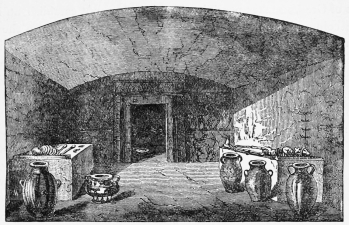
Fig. 246.—The Campana Tomb at Veii.
AT the time when Hellenic influence had developed to its fullest extent in Magna Græcia, the Etruscans had long passed their highest point of perfection. Roman tradition gives no little significance to their civilization, in its artistic as well as in its political aspects, though it was far less grand and brilliant than that of their neighbors in the south of the Italian peninsula. But as Rome rose, Etruria fell; and in the time of the Peloponnesian war it had but a shadow of its former dominant position in Italy.
Whether this people were related to the ancient Greeks, or merely mixed with the Pelasgic and Hellenic element through emigration from the western coasts of Greece, it is certain that the older culture of the nation shows a great resemblance to that of the countries beyond the Adriatic. This may have been owing partly to common Oriental prototypes, and to native imitation of these, and partly to the fact that certain primitive results of civilization, under like material premises, naturally assume a more or less similar form without any real historical connection.
The method of building the Etruscan walls is particularly a case in point. The resemblance of these to the most ancient fortifications{388} of Greece makes possible, though it does not establish, an intimate communication between the two races, to which also the use of Greek letters for the strange Etruscan language certainly points. The so-called Cyclopean jointing, however, presents itself in every civilized land where rock is found which naturally breaks in polygonal forms. So also square-stone masonry early appears wherever the material, quarried without difficulty in rectangular forms, favors this more satisfactory method. Besides both these varieties, the Etruscans made use of bricks, as shown by the foundations of the walls of Veii, which above-ground are mainly built of cut stone. These are at least as ancient as the time of the later kings.
Some of the remaining ruins of Etruria, and of Central Italy—for the peculiar civilization of that region is not strictly confined to the limits of the Etruscan language—show in the building of gates a new technical element. It has been seen how the Greeks in vain sought a substitute for the arch, to them an inadmissible, if not an unattainable, feature; and exhausted every conceivable method of horizontal stone-laying in order to cover their gateways. Similar evasive attempts are not wanting in Etruria; the Cyclopean walls, especially, present portal constructions similar to those of Mykenæ. But through the perfection of stone-cutting, and building with rectangular blocks, the ceiling of the passage by means of the arch was early attained. That this step was taken before the invasion of the Gauls is shown by the still remaining{389} Gate of Falerii (Fig. 247), which city, as is well known, lost its importance under Camillus. It is not certain whence the people of Central Italy attained their knowledge of the arch. Though it had been familiar to the Assyrians as early as the ninth century B.C., it is possible that they made this important discovery independently, perhaps somewhat later than the Mesopotamians. The vault of the Cloaca Maxima in Rome dates from the sixth century B.C., but it shows, even at this early period, a perfection which gives evidence of long previous use. Canal-building was one of the first conditions of existence on the western coast of Central Italy, where the drainage of the swamps—the neglect of which, since the Middle Ages, has reduced the once populous Maremma to a pestilential desert—the discharge of the mountain lakes, which otherwise overflow from time to time, desolating the lower country, and the regulation of the river-courses, alone made possible the settlement of a people and the founding of flourishing cities west of the Apennines. It is therefore not improbable that the great canal discovered by Dennis, which once drained the swampy Valley of the Marta, preceded the Cloaca Maxima, and, indeed, antedated the Roman period altogether. (Fig. 248.){390} The enormous stones employed in its construction, and its great extent, display, even in this primitive age, that marked inclination for works of general usefulness which distinguished the people of Italy above all others of antiquity.
Of the long-forgotten cities, discovered in the present century by their walls, little else remains than extensive cemeteries, which, as repeatedly happens among the ruined places of the earth, have outlasted by more than two thousand years the dwellings of the living. The streets and buildings of these settlements, already in ruins under the Romans, have disappeared almost without a trace; while the monuments of the dead are so well preserved as frequently to give information concerning even the domestic architecture of their builders. By far the greater number of the tombs were tumuli, conical hills of earth, which generally, as in Lydia, were elevated upon a low cylinder and reveted by an outer course of stone. These have now almost all been reduced to the appearance of natural mounds. Their dimensions in some instances are almost as great as those of the smaller Egyptian pyramids. The base of the monument at Poggio Gajella, near Chiusi, formerly falsely held to be the tomb of Porsena, measures 256 m. in its circumference, while that at Monteroni, between Rome and Civita Vecchia, is 195 m. These gigantic foundations at times bore several cones. This appears to have been the case with the so-called tomb of Cucumella at Vulci, where two tall tower-like elevations still remain, which doubtless served as substructures for the terminating piers. The cippus may be imagined to have been analogous to the upper members of the tombs in Lydia, or, perhaps, to have resembled a pear-shaped capital, like the fragment found near the ruins of the so-called tomb of Pythagoras, or the imitations upon terra-cotta reliefs—similar to the cone which so generally terminated Roman tholos roofs. When several cones were placed upon one base, the angle of elevation was made steeper, as may probably have been the case with the tomb of Porsena at Clusium, the description of which is given by Pliny (xxxvi. 3) after Varro. If the tombs called those of the Horatii and Curiatii at Albano, which display many Etruscan reminiscences, be compared with this account, it is possible to present a restoration of the structure, correct in at least its principal aspects. Upon the{391} corners of the triply stepped, diminishing substructure stood twelve cones, the thirteenth being in the centre of the upper terrace. (Fig. 249.)
The fundamental idea of the Etruscan tombs was not alone the creation of a monument which, covering the remains and protecting them from desecration, should plainly mark the place of interment, but the survivors sought, at the same time, to provide a room in which the dead might dwell in a manner corresponding to their circumstances during life. This conception was foreign to the Greeks, who seldom employed burial chambers of great size; but it was prevalent among the Egyptians, Persians, Lycians, and other nations of antiquity, though not by them carried out so logically as by the Etruscans, who usually placed the bodies upon stone benches, shaped like a bed, as if sleeping. Sarcophagi, when existing at all, appear to have been added upon further use of the sepulchre. It is thus, for instance, with the tomb of Veii—of which Fig. 246, at the head of this section, gives an inner view—with the tomb called that of Regulini-Galassi at Cære, and with numerous other sepulchres discovered in various cemeteries, notably of Southern Etruria. There, however, the chambers have mostly proved to have been plundered in former centuries.
The dwelling-rooms represented are as diverse as those of the living must naturally have been. No great width of these spaces was possible, because of the imposed weight of the tumulus; and the{392} apartments consequently became narrow passages, ceiled by stone lintels, by blocks leaning against each other as a gable, or by the gradual approach of the horizontal courses by the projection of each over that beneath it. Examples of all these methods are provided by the tombs of Alsium, the present Monteroni; and the before-mentioned Regulini-Galassi tomb of Cære, the present Cervetri. The latter, so called after its discoverers, has furnished numerous treasures to the Etruscan Museum of the Vatican; it consisted of a corridor separated by a wall into compartments, with rock-cut lateral chambers of oval plan.
When the burial-chamber was a grotto—that is to say, was wholly excavated from the native rock—a greater width could be obtained. The ceiling was then carved, either to the outline of a low vault, as in the Campana tomb at Veii, or, more commonly, in imitation of the beams of a wooden ceiling. In the latter case various forms appear; for small inner chambers a simple horizontal ceiling sufficed, and a simple cross-timbering, overlaid with boards, was chosen as a pattern. The spacious vestibules frequently have an inclined roof, when ridge-beams, rafters, and the slats laid upon them are carefully and truthfully imitated. (Fig. 250.) A noteworthy example at Corneto (Fig. 255) shows in its outer room a plain imitation of the Italian atrium, or court, of the kind termed by Vitruvius cavædia displuviata. It is roofed by four main beams, laid diagonally and inclined outward, which support the framework of a middle orifice for light and air, and shed the water without instead of within. From this instance it appears that the fundamental idea of the chief sepulchral chamber was the atrium, which was the common gathering-place of the Italian house, as was the peristyle of the Greek; while the inner chambers represented the various rooms.
This imitation of an Etruscan dwelling—a remarkable counterpart,{393} in architectural respects, to the copies of the exterior of wooden houses in the Lycian rock-cut tombs—was further carried out by a corresponding ornamentation of the rooms. The couches hewn from the rock, upon which the bodies rested, were at times a close imitation of cushions and pillows; the supports beneath were sculptured like bedsteads, while stone easy-chairs and footstools stood near to increase the apparent comfort. The apertures in the wall which separates the two spaces are reproductions of the framework of doors and windows. (Fig. 251.) The sides of the chambers are stuccoed with plaster of Paris, and covered with cheerful paintings, illustrating feasts, dances, sacred festivals, and games. Every conceivable variety of household utensils hang upon the walls or stand leaning against them, with great numbers of the well-known painted vases and other works of pottery. These objects, when not provided in reality, are imitated in stucco-relief and brilliantly painted, as in a tomb at Cervetri (Fig. 252), where walls and piers are covered with the representations of familiar household articles and weapons.
Although the tumuli were the more common funeral monuments, there were parts of Etruria, among the Apennines, where the limited extent of the level ground offered no spacious cemetery for{394} the mounds, and where rocky mountains and abrupt cliffs led to a different form of sepulchre. A façade was cut upon the background provided by nature, where the appearance of a dwelling could be imitated with little expenditure of labor. The most numerous examples of these fronts are in the cemeteries of Castel d’Asso, near Viterbo. The forms are plain, and not particularly characteristic; a blind niche, the only architectural feature of the lower surface, was substituted for a door, the real entrance being through an insignificant shaft beneath the earth; and the façade was terminated by a complicated cornice—a confused mass of roundlets, cyma-mouldings, and rectangular bands, almost without projection. A stairway was often cut upon one or both sides of the tomb, leading to a platform or to other sepulchres situated upon a higher level.
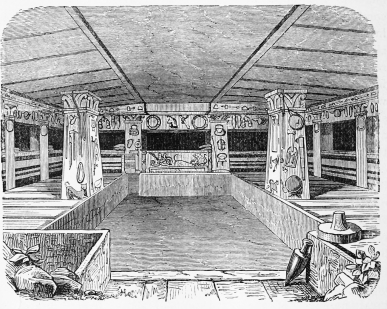
Fig. 252.—Interior of a Tomb at Cervetri.
More remarkable than these monuments at Castel d’Asso are the rock-cut façades of Norchia, to the west of Viterbo, upon which are imitated the fronts of temples. The four columns or pilasters, now destroyed, were placed wide apart, according to the proportions of{395} the Tuscan order. The entablature consists of a narrow epistyle and a frieze decorated with clumsy triglyphs, or rather diglyphs, with pointed trunnels under the regula, above which follows a weak cornice with dentils. The gable is still more peculiar. Its outer ends curl into a volute, with a Gorgoneion in its centre, which originally served as a base for the acroteria; the triangle is filled with reliefs. The whole front gives the impression of a barbarous mixture of indigenous elements with Grecian forms, ill understood and roughly rendered. (Fig. 253.)
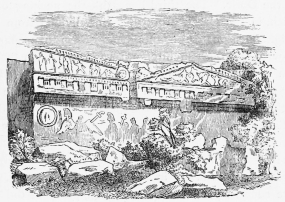
Fig. 253.—Temple Tomb at Norchia.
These remains are interesting, but elements seem to have crept in which could not originally have belonged to the Etruscan style, and the façades of Norchia can hence be deemed of but secondary importance in the study of the temple structures. The plan of these was quite different from that of the Doric temple. Instead of the length being at least double the width of the front, as in Greece, the breadth was here to the length as five to six. The cella did not form a centre around which stood the columns, but it entirely occupied the rear half of the area, while the front remained open as a columned porch. Three cellas, with the images of nearly related deities, were usually grouped together, the middle one being the largest, and also of the greatest hieratic importance. In some instances rows of columns were ranged upon the two long sides of a cella; but the rear wall was always bare. All artistic effect was here abandoned, and the building was, on this account, often so{396} placed as to abut immediately against an enclosing rampart, or against a natural cliff.
The plan and general arrangement were thus entirely different from those of the Greek temple. But the same thing is by no means to be said in regard to the architectural details and members of the building. The Etruscan column was closely allied to the Doric, and greatly resembled it, in spite of some marked variations arising from the lingering influence of the original timbered construction, and the inferior perception of artistic proportions. The Etruscan shaft, in contrast to the Doric, had a base consisting of a circular plinth and a tore, both of equal height. The capital was formed of three parts, equally high, of which the two upper, the echinos and abacus, were similar to the Doric. The third beneath—the necking of the column—which, in the Greek prototype, was divided from the shaft only by slight incisions or an apophyge, was in this separated by a roundlet; what in Greek architecture was based upon technical necessities, in Etruria became an unmeaning decoration. The shaft, apparently not channelled, rose in a lightness akin to the Ionic, tapering to three quarters of its lower diameter, and reached a height of seven diameters. The unusually wide distance between the columns—seven times the lower diameter of the shaft—in contrast to that in the intercolumniation of the Doric style, which rarely equalled two diameters, had its origin in the light wooden beams, which did not require such frequent and powerful supports as did the stone epistyle of the Greeks.
The entablature consisted of wooden epistyle beams placed one over another, fastened together by iron clamps, in at least two courses. From the text of Vitruvius—from whom the entire description must be taken, since, on account of the wooden beams, there are no remains of Etruscan temples—we cannot learn whether these smooth layers took the place of both architrave and frieze, or whether the upper member resembled the Doric frieze with triglyphs. From a remark of this writer, the former appears more probable, as many epistyle timbers being fastened one above another as the size of the building seemed to require; moreover, notwithstanding the Hellenic influence, triglyphs were not always introduced into the Roman Tuscan order. The arrangement of the roof{397} rafters was doubtless such that their support upon the beams of the epistyle beneath was hidden, and perhaps rendered more solid by mortising or dovetailing. Upon the longer sides the roof projected considerably, fully one quarter of the height of the columns. By this means the size of the gable was decidedly increased. These gables may have been decorated with sculptural ornament in the tympanon, of clay or bronze, and with acroteria, as may be gathered from several notices, as well as from the rock-tombs of Norchia. Concerning these decorations Vitruvius is silent; but they could not have altered the heavy, low, and clumsy character of which he complains, and which is apparent in the restorations that have been made according to his theory. (Fig. 254.) The Etruscan temple could not become really monumental so long as it retained the wooden construction in its most essential constituents, and this seems never to have been given up in the entablature, even when the direct Grecian influence first made itself felt among the Romans. How this ultimately changed the fundamental architectural forms of Central Italy will be explained in the section upon Roman building, which united the traditions of Etruscan and Hellenic art.
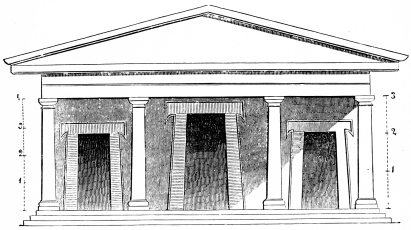
Fig. 254.—Elevation of the Etruscan Temple according to
Vitruvius.
One of the chief features of the Etruscan or primitive Italian dwelling-house, the inner court, has already been mentioned in the consideration of the tombs. As in Hellenic architecture, so{398} here this formed the central point, the chief space of the dwelling, around which were grouped the ceiled chambers, subordinate in dimensions and in importance. As the court was intended to be the chief gathering-place, a partial covering could not have sufficed in these northern Apennines, as did the Grecian peristyle; for continued rain, snow, and piercing winter frost were not so rare here as in the lands upon the Kephissos and Meander. The central aperture was diminished, and the effect of storms or cold more completely excluded. The Italian atrium, or cavædium, acquired thus a form essentially different from the Grecian court. If the aperture open to the sky were reduced to a small orifice for light and air, only large enough to carry off the smoke from the hearth and provide sufficient illumination, columnar supports would not be needed, the rafters being inclined outward, and framed into the square of the opening, as is conspicuously the case in the tomb at Corneto (Fig. 255), and as is also described by Vitruvius (vi. 3). Vertical props obstructing the space would be the less necessary, inasmuch as the dimensions of the court were small, on account of the lower temperature{399} of the region. The Italian court thus differed from that of Greece by an entire absence of columns, as well as by the outward inclination of the roof. The latter peculiarity had the advantage that, notwithstanding the restriction of the central aperture, more light was admitted, the slanting rays of the sun falling high upon the walls; while, on the other hand, the interior of the house was free from the objectionable rain-drip, and, by covering the orifice in bad weather or at night, could be entirely isolated and protected. A remarkable copy of a roof upon an Etruscan clay sarcophagus (Fig. 256) shows the outward aspects of the dwellings of Central Italy, as the tomb at Corneto (Fig. 255) does the interior. The roof of the atrium, rising like a clere-story, inclined outward, while the covering of the chambers surrounding this space carried the drip still farther from the central aperture. The practical sense of the Italians was thus expressed, as opposed to the more cheerful and elevated ideals of form among the Greeks. These constructive advantages were attained, however, at the cost of that artistic, or at least tasteful, development of the whole which was characteristic of the Greeks, even when striving mainly after public usefulness or private comfort.
The remaining monuments of Etruria are almost entirely limited to tombs, among which it is not possible to recognize progressive stages of architectural design. Still it is evident that examples like the Regulini-Galassi tomb of Cære, which shows a most primitive covering of the chambers, and that of Alsium, or the Campana tomb at Veii, must belong to an earlier period than do those sepulchres in which the imitation of a dwelling-house, particularly in regard to the roof-timbering, shows an advanced intelligence and great technical skill. This skill is equally evident in the decorative members: pilasters before the piers, the carvings of the coffin-benches, and utensils upon the walls, with Hellenic features of a late and advanced period.{400} A further division of Etruscan monuments into chronological periods is not possible; it is only to be concluded that the most primitive are less ancient than has usually been supposed, and are probably to be referred to the seventh century B.C., while the later and more perfected tombs may date from 250 to 150 B.C.
The numerous sculptural productions of Etruria may be better grouped. They are preserved in the Gregorian Museum of the Vatican, the British Museum, the earlier Campana collection in the Louvre, and special collections in various towns in Tuscany, particularly at Perugia. Others are scattered among the many museums of Europe. As the practical character of the Italians might lead us to expect, the greater part of these works consist of utensils and implements; those which bear the stamp of the greatest antiquity belonging almost exclusively to this class. The earliest period may be called the decorative, in which art was employed only for the ornamentation of useful articles. The most ancient specimens of this handiwork are those in the British Museum, found in the Grotto dell’ Iside of Vulci, and those in the Gregorian Museum of the Vatican, from the Regulini-Galassi tomb at Cære. The material is gold, silver, and bronze—occasionally amber and ivory; the objects are ornaments, such as breastplates, ear-rings, bracelets of gold wire and thinly beaten gold; also golden and amber necklaces, silver bowls, candelabra, kettles, tripods, couches, censers, and shields of bronze. All these are evident imitations of imported wares. The beaten figures of the breast ornaments remind one of the vessels excavated at Nineveh, Cyprus, and Mykenæ; the decorations of the silver bowls are more like the discoveries in Cyprus and Phœnicia; the bulb-like candelabra are similar to the Cyprian bronze utensils, and also to the seven-armed candlestick of the Temple of Jerusalem. Having already designated the vessels of Nineveh and those of Mykenæ as of Phœnician workmanship, and the Egyptianized ivoryware found upon the Tigris as having been brought into Mesopotamia by the Phœnicians as an article of trade, there can be no hesitation in referring the objects discovered in Etruria to the same origin. The beaten work in sheet-metal was among the best-executed productions of the Phœnicians, and among their most important{401} articles of commerce; and intercourse between the Phœnicians and the Etruscans is known to have been active. Through this current of trade must also have come the vials and alabasters with Egyptian hieroglyphics and symbols; the gilded bronze birds with the pshent upon their heads, like those from the Grotto dell’ Iside; and the beetle-shaped bodies of clay, like the scarabæus, found in different places, for the Etruscans had no direct intercourse with Egypt. It is possible, however, that some of the objects which bear the characteristic forms of those countries are to be regarded as Etruscan manufactures, adhering closely to the imported patterns.
The era next following is distinguished as being emancipated from the earlier dependence upon the East, the Asiatic influence being gradually replaced by that of Hellas. Here may be mentioned the half-mythical report that, about 650 B.C., the Corinthian artists Eucheir, Diopos, and Eugrammos—whose names, as personification of handiwork in art, give little confidence—emigrated to Italy and there introduced sculpture. Though this may be taken to indicate an active artistic impulse, it cannot alone explain the great and decided advance that we find. In Southern Etruria monumental sculpture must early have attained a certain importance, since Tarquinius Priscus ordered from Vulca, or Vulcanius of Veii, a statue of the Capitoline Jupiter, and a quadriga for the gable ridge of his temple. The material for such colossal works was terra-cotta with a painting, perhaps monochromatic; at least, the nude parts of the image of Jupiter were repeatedly tinted with a red color. The roughness of such conventionalized work can hardly be conceived; the trunk, in a sitting figure, was not detailed; the extremities, on the contrary, had all the ugliness of realism; the head was sharply individualized, verging upon portraiture. As the oldest example of this treatment of the head may be mentioned the bust found in the Grotto dell’ Iside at Vulci (Fig. 257), which shows, at the same time, that the germ of that specific Etruscan motive—the conception of the individual, to the neglect of the general or ideal—existed even in the period of dependence upon Asiatic influence. This characteristic Etruscan formation of the head, though in a less artistic and more superficial style, is also shown in the so-called canopi of Chiusi—jugs with portrait heads upon the lids. These are distantly{402} related to the Egyptian jars of the kind, but show scarcely a trace of the early conventional influence of ideal Greek sculpture; the heads, of extreme rudeness, are yet sharp and hard in modelling; coarse caricatures of the round skull and low, retreating forehead, which yet betray a certain observation of nature.
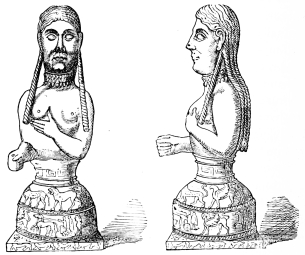
Fig. 257.—Bust from the Grotto dell’ Iside in Vulci.
Greek influence is first apparent, though still overbalanced by native individualization and realistic elements, in a somewhat later sarcophagus of terra-cotta, found in Cære, now one of the chief treasures of the Campana collection in the Louvre. (Fig. 258.) The sarcophagus itself shows a draped couch with technical and ornamental details similar to those found upon the furniture of Assyrian, Xanthian, and ancient Greek reliefs, and particularly upon archaic vase-paintings. A man and woman of life-size, leaning with their left elbows upon leathern cushions, form the lid. If, at first sight, this group has a somewhat frightful and repellent character, not felt in the most shocking distortions of primitive art, the cause lies in its prosaic realism, strikingly heightened by color. Notwithstanding many failures in point of detail, the effect of life was given by the artist without additions or idealizations. Rather inclined to caricature—that is, to the exaggeration of individual characteristics—the Etruscan{403} artist sensibly failed in the reproduction of the head, because wanting in that training in fundamental correctness, through the canonical formation of a true type, which preceded the Grecian perfection. The representation of the individual, instead of being the first aim, should have been left to the last, and it was on this account that the skulls were deformed by various peculiar defects, while the eyes and mouth were drawn upward in a manner that is natural only to the Mongolian race. The same is true in regard to the terra-cotta reliefs of this period, in which the striving after action and naturalness of appearance caused an excessive restlessness in all the motions of the dislocated arms and hands, particularly evident in the ivory reliefs upon a number of caskets.
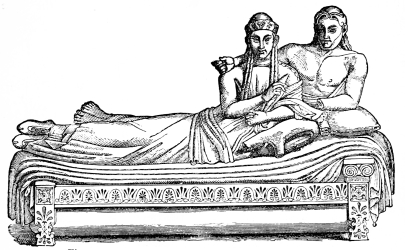
Fig. 258.—Sarcophagus of Terra-cotta from Cære.
(Louvre.)
Sculpture in marble at this period, about 550 to 300 B.C., was less developed; single archaic reliefs in this material—of which Southern Etruria offers but few—appear flat, and entirely under the influence of painting. The inadequacy of the artistic ability of this time is shown, for example, in a relief of Chiusi, representing the lamentation for the dead, where expression of sorrow is combined with caricatured individual features, very rude in drawing and form. (Fig. 259.)
The bronze-work, which is closely connected with the terra-cotta work, was of greater importance, and betrays a more decided and{404} enduring Phœnician influence than do the terra-cotta statues. This is shown in the beaten bronzes, thin plates of which were used to overlay wooden forms. The most important example, the remains of a chariot found at Perugia, is preserved in the Glyptothek and Antiquarium at Munich. The representations of a sea-horse, a woman with fins, sphinxes, and a man who holds or strangles two lions, give evidence rather of Oriental than of Hellenic prototypes. The uncertainty in form and proportions, the ungainliness of the figures, and the awkwardness of the entire composition are in no wise compensated by the careful execution of the finely engraved details to be seen only upon close inspection. A tripod, found at the same time in Perugia, also now in Munich, shows a certain advance. Its three sides have representations of Hercules, and the Italian Juno Sospita, with the so-called Bœotian shield and pointed shoes, in somewhat higher beaten reliefs, very carefully engraved. This tripod is distinguished from the preceding examples as being the work of a more skilful artist, but differs little, or perhaps not at all, in point of age. The upper part of this vessel, now lacking, was mostly of bronze casting; the borders of the seat and the ends of the shafts upon the Perugian chariot were decorated with statuettes of solid metal; but these, as well as the handles upon utensils, seem to have been mere artisan work, not unlike the ornaments upon the{405} handles, the furniture, chariots, etc., shown by the reliefs of Nineveh.
Works in bronze of considerable size must have been numerous at that period, as, in 260 B.C., Volsinii alone was in possession of two thousand bronze statues; but only a single example remains of well-attested Etruscan origin, the Capitoline Wolf (Fig. 260); probably the same which, soon after 300 B.C., was consecrated in Rome under the Ruminal fig-tree. It is a hollow cast, which, with great hardness and carefulness of treatment, gives the well-understood character of this animal excellently, almost to the point of caricature. It well illustrates the peculiarities of Etruscan art above described, inasmuch as it sacrifices to realism all artistic beauty. The chimera of Arezzo in Florence, and a griffin in Leyden, are similar in style; but, notwithstanding their Etruscan inscriptions, it is doubtful whether they are of Tuscan workmanship.
Here should be mentioned the bronze utensils ornamented by drawings—sgraffiti—particularly the mirrors, generally in the form of plates, one side of which had a polished surface, while the other was engraved. The handles upon these either represented figures like caryatides, or, more commonly, ended in a deer’s head. Toilet cistas, a further variety of these works, were of cylindrical form, usually with the claws of animals for feet, and a group of human figures upon the cover as a handle; but these, on account of their engravings, should rather be considered in the section upon painting,{406} and are mentioned here merely because of the accompanying castings. Only a small part of them belongs to the archaic period.
About 300 B.C. the art of Etruria appears to have reached its highest point of independence and perfection, which, in sculpture, is illustrated by the terra-cotta sarcophagus of Cære in the Louvre, and by the Capitoline Wolf. The old ignorance of proportions had disappeared, and a tolerable correctness was attained; the realistic tendency no longer struggled with unpliant forms, as in the former period, when it might have been likened to the lisping and stammering of children. Yet the Etruscan artists never succeeded in harmonious combinations, or in mastery and surety of form. The stream of Grecian art, long restrained, or, so far as possible, turned aside, at length overcame all obstacles. Up to this time the taste of the Etruscans for the archaic and the archaistic, aided by the importations of that character, had given to their art an antiquity of aspect in form and in painting far beyond its true age. But when political Etruria ceased to exist, as its walls were destroyed at the opening of the cities by the Romans, Grecian art, of the period of the Diadochi, entered from the coasts of Magna Græcia.
This is first noticeable in the sculptured lids of the sarcophagi of this Hellenistic period. That of Cære, mentioned above, was executed in almost entire independence of the influence of Greece: a copy was made directly from life, with a prosaic realism which, without restraint or culture, and with no feeling for the beautiful, was still fascinating from its naturalness. In later times this unpoetical sobriety and truthfulness to individual peculiarities still existed; but they were affected by Hellenic forms and formulas, which, being without organic unity or intrinsic significance, and void of capacity for development, were merely an exterior varnish. This period is most clearly represented by the lids of three sarcophagi carved in alabaster and a soft stone. Of these, one bears a reclining image with five statues in the full round at the head and feet (Fig. 261); the two others, from Vulci, represent a man and woman upon the marriage bed, wrought in high-relief. The portraiture of the chief personages is by no means limited to the heads. Apart from the accessories, chosen from the purely human sphere of daily existence, the position and modelling of the nude portions of the body were evidently{407} taken from living models. The secondary figures and the drapery show a decided Grecian influence, in visible contrast to the inherent realism. Organic connection and unity of style are wanting, and this want leaves it to be regretted that Greek forms should ever have found admission into Etruria, for by them the native tendency towards the realistic was checked, while the originality sacrificed was not compensated by a merely external Greek formalism, never essentially understood.
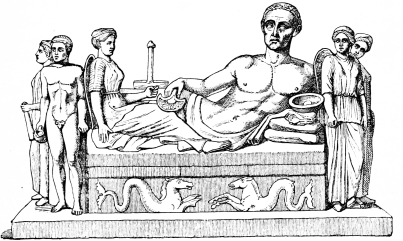
Fig. 261.—Etruscan Stone Sarcophagus.
This condition of things is most strikingly exemplified by the reliefs upon the two sarcophagi of Vulci, the lids of which have been referred to above. Upon the front of one is shown a wedding procession, and upon the end a funeral chariot drawn by mules, with the married pair seated under a canopy. In the arrangement and drapery they somewhat resemble Grecian sculptures, but the heads, especially of the important figures, are portraits, with traits of realistic coarseness in all the nude parts. Even in subject, as Brunn remarks, this naturalism is apparent. While the Greeks would have chosen to represent a mythological wedding like that of Heracles, Peleus, or Cadmus, and the Romans would have illustrated the bridal pair—in a conception more theological than mythological—by Victory, Juno, and Venus, with the Graces in their train, the Etruscans{408} show the marriage in a literal manner, the united pair being followed by servants, with couch, sun-shade, wash-basin, crook, horn, flutes, and harp. In the reliefs upon the other sarcophagus the subjects selected offered no opportunity for purely Etruscan motives; battles of the Amazons, and heroic encounters of naked youths, on foot and upon horse, gave no scope to realistic treatment. They consequently appear almost entirely Greek, but clumsy and superficial, justifying, by the slavishness of their imitation and the weakness of their composition, the suggestion of Brunn, that the Etruscan artists not only made use of Hellenic designs as a kind of pattern-book, but, when they would illustrate some scene for which they had no complete guide, combined separate groups from different examples. In the steer seized by lions, and the horse lacerated by griffins, upon the small sides of the same sarcophagus, may be recognized not only Oriental conceptions, but an Asiatic treatment.
The terra-cotta sculptures of this period show the same Hellenic tendency, with, the same superficiality and relation to the late Greek degeneracy. Examples of this are to be found in the antefixes of a sarcophagus from Vulci, and some fine urns belonging particularly to Northern Etruria—Volterra, Clusium, and Perugia—which appear in tufa and travertine, and represent the latest period—150 to 100 B.C. Grecian legendary scenes have been observed upon earlier works, and afterwards they became more general; but a certain preference for particular and better known fables is evident, and native additions are easily recognized.
Not to speak of later examples in bronze, and the engraved drawings upon cistas and mirrors, which will be treated of below, the most important statue is the so-called Mars from Todi, now in the Vatican museum. According to its inscription, it is Umbrian, but it is properly to be considered here, because for the too limited term Etruscan art might well be substituted Italian, or at least Central Italian. Vigorous in all its details, and betraying throughout the later Hellenic style, the Mars is yet stiff, heavy, and without organic understanding. Similar to it are other figures of warriors; but the Boy with the Duck, in the museum at Leyden, in spite of the stiff and hard features, would, perhaps, not be recognized as Etruscan at all, were it not for the inscription upon his right leg, and the bulla{409} upon his neck-band. The life-like statue of an orator in Florence might, in like manner, pass for Roman, were there not something in the head, and in the lame position of the legs, particularly hard and commonplace, a quality which, in the Roman works of this kind, is always tempered by some degree of heroic conception. The difference is less evident because the primitive art of the Romans and Etruscans was much the same, and the Greek influence the same in both, though this was earlier and more active in Rome.
The painting of Etruria naturally followed a process of development similar to that of the sculpture. In the earliest times it appears that painting was rare in comparison with the decorative works of beaten metal plate, and that the little there was followed Phœnician and Egyptian models, in so far, at least, as may be judged from the few utensils which have been found in the so-called Grotto dell’ Iside in Vulci. These are ornamented partly with painting, partly with colored enamel. This decorative and dependent period lasted at least until the beginning of the sixth century; and the Oriental tendency towards decoration was by no means lost with its transition into the independent monumental and realistic style, as is proved by the pictures of the Campana tomb at Veii, with their attenuated animal figures. But the obtrusive archaistic ornament upon the human figures began already to show the native realistic tendency, which obtained complete mastery in the two tombs of Corneto, called the Tomba del Morto, and Tomba delle Inscrizioni, of about the same date. A painting upon slabs of terra-cotta from Cære (Fig. 262) is perhaps still older. In the former examples, though known to be antique, the treatment was more archaistic than archaic, and the monstrous decorative style of Asia was apparent, like that upon ancient vase-paintings. But in the Cære slabs the fundamental principle was realistic imitation of the life. The influence of Hellenic art, increasing because of the importation of Greek vases, is first evident upon a number of clay figures from Cære. There is little unity in the subjects: they appear to be devotional and ceremonial rather than mythological, the demoniacal and funereal elements predominating. The colors are sombre, with no decided blue, red, or green; only brown, yellow, reddish brown, gray, and{410} black were employed upon a white ground. No trace of shading is perceptible, and the drawing, with exception of the outline, is limited to the indication of the almond-shaped eyes, and to slight suggestions of the knees, elbows, and nails. The forms are heavy and without dignity, the motions stiff, and the step as though climbing, with the arms thrown violently upward, as if running in the greatest haste. Still, they give evidence of great observation of nature, with the avoidance of a systematic uniformity in drawing, motion, and gesture; but the imitation is hardly successful, though in the reclining figures, for which a living model was most easily obtained, there is a certain degree of truthfulness. In the picture from Cære the many-colored altar, with its peculiar top reminding one of the profiles of Castel d’Asso, is very characteristic. The wall-paintings in the older tombs of Corneto, already mentioned, are somewhat more advanced in regard to understanding of form and truthfulness in the expression of the heads; also in the soles of the feet being no longer so flatly set. At the same time, Grecian influence is very distinctly visible. One of these, the Tomba del Morto, represents a death-bed and its surroundings, with a group of dancers and drinkers; the other, the Tomba delle Inscrizioni, shows racing, boxing, wrestling, and preparations for a feast. A third sepulchre at Corneto,{411} the so-called Tomba del Barone, is, perhaps, still further developed, with the strictness of the archaic Hellenic vase-painting. Youthful riders, men and women with bowls, and finely modelled garments are separated by small trees.
This archaic hardness was again modified in the next later group of four tombs: the Grotto delle Bighe, the Grotto del Citharedo, the Grotto Marzi, or del Triclinio, and the Grotto Querciola, mostly named from some chief motive of the representation within. The garments allow the outlines of the figure to be seen: the forms have become more slender, the position of the limbs, step, and action more correct; while the color, from the use of red and green, is brighter. Although the archaic tendency still prevails, as may be seen from the more marked Hellenic influence, a decided effort to develop the native realism is evident in the contemporary paintings from Chiusi, of the Tomba Ciaja, the Tomba di 1833, and the Tomba François. These certainly do not show the fine modulation and clearness of the Corneto paintings, but, instead, a greater variety, originality, and truth. In the Tomba di 1833, for example, the eye appears drawn in profile. These works are the perfection of the second period, the time of independent realistic development, dating from the fifth to the fourth century B.C.
The last phase of Etruscan painting, when the Hellenic influence predominated as largely as in the sculptural works of the third and second centuries B.C., commenced with the extensive adoption of the Greek myths, previously but seldom employed. This epoch is illustrated by coins, occasionally found in tombs, which still show the native naturalistic traits, and a certain quaint sobriety not overcome by the exaggeration of gesture. The effect is far more picturesque than that of the older works, from a very moderate but still appreciative use of light and shade. The close of the period is marked by a novelty of subject, the introduction of Italian legends, such as the half-historical personifications of Mastarna (or Servius Tullius) and Cælius Vibenna. The art, which, more or less substantially, outlived the independence of its narrow home, thus acquired a Roman character.
Numerous and varied products testify to the Etruscan industry{412} in artistic manufactures; the bronze utensils in the tombs, with sgraffiti, or engraved drawings, bore the same historical relation to ancient paintings that copper-plate engraving does to the modern. Of the thousand hand-mirrors known, only a few belong to the earlier period; but in the subjects of the more developed archaic examples, Greek character predominates. The frequently recurring representations of Bacchus and Eros and of the Judgment of Paris remind one of the festival and morning toilets; Ariadne and the female deities suggest womanly customs. A great portion of the Greek mythology is illustrated upon the mirrors of the third period, which show extreme Hellenic influence. Most of these productions are naturally mere handiwork, and artistically valueless; but single specimens, from their extraordinary beauty, might pass for Grecian work did not the inscriptions and accessories, specifically Etruscan, like the bullæ, prevent this assumption. For example, the unequalled mirror, in which Semele embraces the youthful Dionysos in so charming a manner, represents the heroine in such noble proportions that it may, without hesitation, be reckoned among the most beautiful results of artistic industry. Similar in character are the engraved cistas, cylindrical toilet-cases, which illustrated Grecian myths, like those of Perseus and Prometheus, the Judgment of Paris, and the rites over the body of Patroclos, in a careful manner and with vigorous drawing, but not without the hardness peculiar to Etruscan composition. Italian myths also appear, like that of Æneas; and Latin inscriptions, as those upon the magnificent cista of Ficoroni, ornamented with illustrations of the legend of the Argonauts, show that this process of engraving was also employed with success by the early Romans.
A consideration of Etruscan art is important, because, without it, an understanding of Roman art is not possible, at least in the fields of architecture and sculpture. Up to a certain point of time, Roman art was entirely developed from Etruscan art, or, perhaps, went hand in hand with it, as will be more particularly shown in the following section. The subject should be more closely investigated, especially in the province of painting, with the hope that, from analogous illustrations, much which still remains dark in primitive Hellenic art may also be made clear.{413}
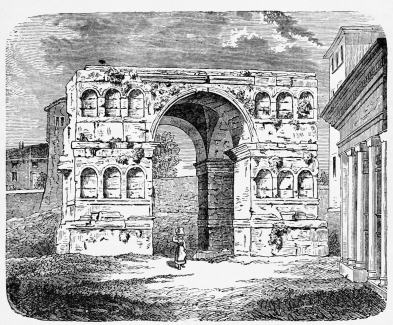
Fig. 263.—Janus Quadrifrons in the Forum Boarium.
IT has been remarked in the preceding section that the term “Etruscan art” admits, in many respects, of no definite restriction. The southern boundaries of the country between the Po and the Gulf of Tarention had early been colonized by the Greeks, but its artistic industry was, in the primitive historical ages, chiefly in the hands of the Etruscans, and their name alone has on this account been applied to the architecture, sculpture, and painting of all Central Italy. But neighboring races, notably the Umbrians, Latins, and Sabines, also took part in the development of this artistic civilization—advancing, in great measure, from common starting-points, and with like results. The migrations and commerce of the nations inhabiting the Italian peninsula were not less extended and active than were those of the people occupying the Peloponnesos and the islands of the Ægean Sea: the relations to the Orient, through the{414} medium of Phœnician traders, were much the same in both cases, and it is not strange that similar phases of advance are noticeable, though restricted in rapidity and degree, among tribes dwelling in the regions more remote from the sea.
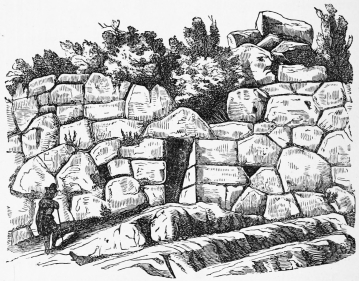
Fig. 264.—Gate of the Walls of Norba.
Between the Tiber and Garigliano, as well as between the Arno and Tiber, there exist extensive remains of Cyclopean masonry, as well as walls of hewn and squared stones. The former were predominant in the mountainous interior, as at Alatrium, Arpinum, Aurunca, Cora, Cures, Ecetræ, Ferentinum, Medullia, Norba, Præneste, Signia, Sora, Tibur, Verulæ, etc.; the latter in the low rolling land between the Apennines and the Tyrrhenian Sea, as at Æsernia, Antium, Ardea, Aricia, Aufidena, Lavinium, Politorium or Apiolæ, Satricum, Scaptia, Tellenæ, Tusculum, and Rome. They frequently occur in contemporary works, as, for example, in the well-preserved polygonal ruins of Norba and Signia (the present Norma and Segni) and the horizontal courses of the Servian fortification, both of which constructions date from the period of the later kings. The age of these works can usually be roughly estimated: the Cyclopean walls of Olevano, of enormous unhewn boulders, like the fortifications of{415} Tiryns, are evidently of greater antiquity than the carefully fitted polygonal masonry of Norba and Signia (Fig. 264), where the separate stones are tooled to plane faces and sides; while the irregular horizontal courses of unequal thickness, which form the older Latin ramparts, precede, in point of time, the exactly jointed blocks of the Servian walls of Rome. A more exact classification or chronological determination is not possible.
Among all the remains of primitive walls in Italy, those of Rome are naturally the most interesting. It unfortunately cannot be definitely proved that a part of a rampart upon the western corner of the Palatine, excavated thirty years ago from the rubbish and brick revetment of the imperial period, appertained to the fortifications which surrounded the city of Romulus. But this masonry, though not perhaps attributable to the eighth century, is certainly of an early age of Roman history. It is formed of oblong stones, exactly hewn, and laid in courses of stretchers and headers, without the use of mortar, the careful jointing showing a high degree of technical perfection. The better-authenticated remains of the circuit wall of Servius Tullius are similar in character. They have been best preserved upon the southern slope of the Aventine, east of the Via di S. Prisca, where they attain a height of 10 m., with a length of 30 m. (Fig. 265.) The arrangement of the jointing, however, is not so well considered as that in the former example, the vertical interstices of adjoining courses being frequently continuous.
The passage formed a small vestibule or chamber in the thickness{416} of the wall, which required inner and outer portals, like those of the Temple of Janus upon the Velabrum, which, long after the ruin of the Servian fortifications, and even down to the time of the empire, were sacredly preserved as relics. A similar arrangement existed in Etruria even more frequently than in the Latin cities.
The Roman gates were so doubled as to form two passages side by side—one for entrance, the other for exit; a comparatively narrow opening could thus provide ample space for those moving only in the same direction. It is not certainly known how these Roman gates were covered. The oldest vestiges of masonry in Latium show no traces of vaulting, while other means of accomplishing the connection have been preserved almost intact, such as the heavy lintels upon vertical or inclined jambs, as at Segni, Circello, Alatri, and Olevano; or the gradual projection of the horizontal courses beyond those beneath them, as at Arpino. The primitive houses for springs, and the so-called Mamertine Prison, show that vaulting was not practised in Rome or the neighboring Latin cities during the early ages; the Prison, probably built in the time of Servius Tullius, appears to have been somewhat similar in construction to the Greek tholos. A further example of this kind is the chamber for a fountain in Tusculum, where the stone slabs of the ceiling lean so as to form a sort of continuous gable.
Rome owed more to the last fifty years of its hated kings than to the two following centuries. From the royal period dates one of the most important monuments of vaulted construction, the Cloaca Maxima of Rome, built in the reign of Tarquinius Superbus, and probably under the direction of engineers from his native Etruria. To this gigantic work, admired even in the time of the magnificent Roman empire, is undoubtedly owing the preservation of the Eternal City, which it has secured from the swamping that has befallen its neighboring plains. Its quarried stones are still visible beneath the later brick arches in the vicinity of S. Giorgio in Velabro. (Fig. 266.) The building of drains naturally led to extensive works upon the banks of the river, which protected the thickly populated city; it was forgotten that, in earlier ages, it had often been necessary to traverse the Velabrum in boats, and that the spring freshets had extended a sheet of water between the Palatine and Capitoline hills.{417}
All these structures were emphatically works of engineering; the building of walls, gateways, drains, and vaulted roofs presented nothing to elevate them into independent and artistic monuments of architecture. Among the Roman temples of this period only two appear to have been of importance for the history of art—the national shrine of Diana upon the Aventine, and the Temple of Jupiter Capitolinus; both built by the last three kings, Tarquinius Priscus, Servius Tullius, and Tarquinius Superbus. The first of these structures has been compared to the Artemesion at Ephesos, the national sanctuary of the Ionians; but it would be wrong to draw from this a conclusion in regard to the style of the Latin temple of the same goddess, which was most probably Tuscan, as that of the Temple of Jupiter is known to have been, from descriptions given by ancient writers as well as from the recent excavations of Jordan. According to Dionysios of Halicarnassos, the substructure of this latter building—eight hundred Roman feet in circumference—was only fifteen feet greater in length than in width; these dimensions agree well with the proportion of five to six given by Vitruvius for the temple architecture of the Etruscans. The cella of the Capitoline temple was divided into three ædiculæ, another peculiarity assigned by the Roman writer to the sacred edifices of Etruria; it had three ranges of columns, of six each, before the cella, which provided a portico equal in depth to half the entire length of the building. The{418} ornamentation, which will be treated more fully in the section upon Roman sculpture, was wholly the work of the Etruscans. This race had, indeed, settled in Rome between the Capitol and the Palatine, where the name of Vicus Tuscus preserved, until late historical times, the memory of their settlement and of the considerable part taken by them in the peopling of ancient Rome. It is even stated by Pliny (xxxv. 12, 45, and 154) that, for seventeen years after the expulsion of the kings—namely, until the building of the Temple of Ceres upon the Circus—all the sanctuaries of Rome were Etruscan; that is to say, were not only built in the Tuscan style, which might more properly be called the ancient Italian, but were erected by Etruscan artificers, or, at least, under the direction of Etruscan artists.
Even the Temple of Ceres appears to have been Tuscan in general disposition, its cella having been triply divided and its intercolumniations excessively great, as may be seen by the remains of a later restoration still existing in S. Maria in Cosmedin. In this temple, however, the influence of Greek architecture, introduced through the Hellenic colonies of Magna Græcia, had already begun to gain ground in the arrangement and the details, though the ancient Italian traditions were too deeply rooted to permit it essentially to alter the original distribution. The structure remained nearly square, being equally divided between the portico and the cella. This is illustrated by the Temple of Concord, erected by Camillus upon the Forum at the foot of the Capitol in 367 B.C. The limited area, defined by the neighboring buildings and by the steep slope of the hill against which it stood, prevented even later restorations from elongating its plan. The extended oblong of the Hellenic temple was naturally adopted, in place of the heavy proportions of the Tuscan temples, as soon as the execution of the entablature in stone rendered the excessively wide intercolumniations impossible, and placed insurmountable difficulties in the way of the broad front. Still, the Etruscan or ancient Italian division of the building was retained, inasmuch as the columns were usually restricted to a pronaos of great depth, such as is shown by the ruins of four temples in the Forum Romanum. The Roman prostylos, as Vitruvius terms a temple thus planned, may be regarded as the first compromise effected{419} between the ancient Italian and the Hellenic disposition. (Figs. 267 and 271.)
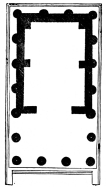
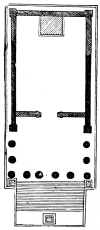
Fig. 267.—Temple of Fortuna Virilis.
Fig. 268.—Temple of Antoninus and Faustina.
The early Italian manner of abutting the undeveloped back of the building upon the circuit wall of the temenos, or against a cliff, seems to have long remained in practice; but, in cases where this was impossible, the bare sides and rear of the cella appeared intolerable when compared with the outstanding wings of the Greek peripteros. Although, in some instances, the prostylos plan was adopted in later ages, as in the Temple of Antoninus and Faustina (Fig. 268) in the Forum, where the enclosing walls of the cella are treated with pilasters, this was only in cases where the sanctuary was so crowded by adjoining buildings that little else than the portico could be seen. In completely isolated structures the desire of approaching the peripteral effect led to the application of engaged columns to the side and rear walls of the cella, thus attaining, in the so-called prostylos pseudoperipteros, the highest stage of that development of sacred architecture which was peculiar to Rome. The purely peripteral form was naturally adopted in later times, primitive cellas being enclosed by outstanding ranges of columns; but two fundamental peculiarities were always retained: the pronaos always formed a deep portico, and the naos always remained a spacious hall, the peripteral{420} columns being fitted to it, and made of subordinate importance. The dimensions of the cella were thus not restricted by the pteroma, as was the case in the temples of Greece, and especially in those of Sicily; for the chief difference between the architectural tendencies of the Greeks and the Romans was that the former devoted their attention almost exclusively to the perfection of external appearance, creating monuments of unequalled beauty, while the latter held material usefulness to be of the first importance, assigning to technical excellence a second place, and to artistic design but a third, thus creating imposing interiors admirably adapted to their purposes.
The details of their architecture were with the Romans purely decorative and applied. The Doric style, which had predominated in Lower Italy and Sicily, and must have offered the most numerous models near at hand, was nevertheless least employed. It would be difficult to decide whether this is to be ascribed to the similarity of the Tuscan and Doric styles, and their derivation from a common prototype, or to the development of the two manners of building in different directions; certain it is that the channelled shaft was not employed, and the Doric entablature appeared only in an attenuated and purely ornamental imitation, above the wide intercolumniations of the ancient Italian façade. The Tuscan (Fig. 269) became somewhat higher in proportion to its diameter, and was slightly altered in detail. The epistyle was diminished to a narrow band, and, in the smaller temples, was usually carved from one stone with the frieze of triglyphs, thus destroying the separate importance of these two members. The diminutive triglyphs were frequently increased in number above the intercolumniations; the chamferings were terminated above by a straight line, while the guttæ were lengthened and had a more marked conical form. The proportionally small metopes were either entirely without sculptured ornament, or were provided with rosettes, disks, and the heads of oxen;{421} which last were introduced as a reminiscence of the barbaric custom, prevalent in early times, of affixing the skulls of the sacrificed animals to the wooden entablature. The corona was usually not inclined like this member in the Doric cornice; the mutules lost their guttæ, and became simplified to plain consoles. (Fig. 270.) In some instances Ionic elements were introduced into the Doric entablature, as in the sarcophagus—now in the Vatican—of L. Corn. Scipio Barbatus, who was consul in 298 B.C., where an Ionic cornice surmounts the frieze of triglyphs, and Ionic spirals decorate the lid. The Theatre of Marcellus displays a similar combination; and, in other cases, Doric forms are entirely supplanted by simplified Ionic members.
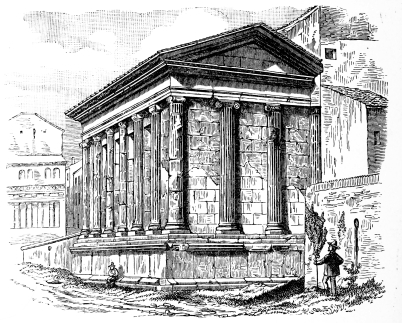
Fig. 271.—Temple of Fortuna Virilis.
Towards the end of the third century B.C. the Ionic style was generally introduced; yet, according to the nature of Roman architecture, which did but borrow external features from foreign nations, itself supplying the general disposition and constructive forms, it{422} became nothing more than a decorative adjunct: the Grecian style became a Roman order. Attic Ionic influences were naturally more prevalent than those of Asia Minor. This was particularly fortunate, because a canon of mathematical rules early took the place of independent development, hardening the forms into formulas. This mechanical method of design was favored by the extended application of engaged columns and pilasters which did not require the complete execution of the elaborate capital, while, in the decoration of colossal buildings of several stories, the distance from the eye rendered a simplification of the Ionic helices natural, as well as more suitable to the coarse and porous stone employed by the Roman builders. (Fig. 271.) The complicated corner capital of the Ionic style could not, however, be avoided upon the free-standing columns of the temple fronts, and the execution of this member must have been exceedingly troublesome to artisans accustomed to work everything after one model. It is therefore to be regarded as a direct{423} consequence of the Roman architectural system that a variety of the Ionic capitals appeared in later times which omitted the rolls and displayed the spirals upon all four sides. This form, as exemplified by the Temple of Saturn upon the Clivus Capitolinus, seems to have arisen by repeating the two outer sides of the corner capital upon those remaining. The entablature was of great simplicity, perhaps because the comparatively rare employment of this order left it undeveloped.
Before the Roman had decided upon the practical but inartistic repetition of the volutes upon all four sides—by which the nature of the Ionic capital was destroyed, and the spiral treated in the early Asiatic manner as mere ornament—the Corinthian capital had come into general and popular use. It has already been explained, in the section upon Hellenic architecture, that the Corinthian capital attained no typical form in its native country, and could not be ranked with the Doric and Ionic styles, being a mere variety of the Ionic capital without any individual formation of the shaft and entablature. The Corinthian columns of the uncompleted Temple of the Olympian Zeus at Athens, which Sulla transported to Rome about the year 84 B.C. for the rebuilding of the Temple of Jupiter Capitolinus, were, if not the first in Rome, at least those which were in later times taken by Roman architects as typical examples of their style. The Roman architect justly preferred the Corinthian capital because of its capacity for more varied application, without that fatal difficulty at the corners inherent in the Ionic style, and because of its rich effect, even when less carefully and delicately detailed. The preference for the Corinthian may be justifiable, but that form of Composite capital into which it developed, by a multiplication of its ornaments and the addition of four spirals upon the corners, must be regarded as a debasement. (Fig. 273.) The fact should not be overlooked that this arrangement of acanthus around a concave kernel best solves the problem of the capital as a mediating member between the vertical support and the horizontal entablature, as well as between the circular plan of the shaft and the rectangle of the epistyle. (Fig. 272.)
The leaves and tendrils of the capital were at last introduced into the entablature, which thereby assumed a peculiar character, and permitted{424} the Romans, for whom the forms of Hellenic architecture were nothing more than a decorative mask, to place the Corinthian, as an independent order, by the side of the Ionic and the Tuscan or Doric. As the Corinthian base had been formed by a combination of the Ionic and Attic mouldings, the consoles of the cornice resulted from a fusion of Ionic dentils and Doric mutules. The simplicity and slight projection of the dentils did not suffice for the requirements of florid Roman architecture; the horizontal mutules without guttæ, characteristic of the later Tuscan style, consequently took their place, supported by the spiral brackets which had been already employed as the parotides beneath the cornices over Ionic doorways. A richly foliated ornamentation fully harmonized these new members with the acanthus capital, and gave to the entire cornice an independent importance and a certain lavish elegance, soon, however, debased by the extravagance of the decorators. Continued increase of ornament resulted in a want of attention to the general composition—a loss which the multiplication of the details could ill supply, especially as they were without even formal beauty.
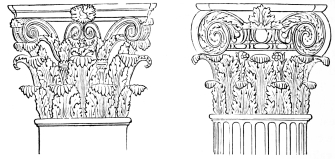
Fig. 272.—Corinthian Capital from the Pantheon.
Fig. 273.—Composite Capital.
The sacred buildings of the Romans have been considered thus at length because offering the best opportunity for a characterization of the orders; yet the significance of their national architecture is not to be found in the temples, but rather in their structures for public utility and comfort. In these the technical naturally far exceeded the artistic element, and it is consequently in points of construction that the great advances of the Romans appear. In these{425} methods they were almost wholly independent, and were by far the most important people of antiquity. Masonry of brick and hewn stones early attained great extent and perfection, furthered by the excellent materials at hand—the hard Tiburtine and Travertine limestones, the tufa so easily carved, the unequalled clay for bricks, and the famous volcanic sand and pozzuolana which, when combined with lime, harden to the firmest stone. Vaulting was generally introduced as early as the time of the kings, the walls and ceiling forming an uninterrupted mass of homogeneous materials; the vertical and horizontal members, support and covering, being blended together without marked transition. Before this system of construction was invented the spacious and monumental development of protected rooms had been possible only under great limitations; without it these chief ends of Roman architecture could not have been attained.
The building of barrel vaults with hewn stones, as observed in the Cloaca Maxima, was attended with certain difficulties; the great weight of the masonry permitted a moderately large span only when immense and cumbrous buttresses were provided. This objection was, in a great degree, obviated by the employment of bricks, but the size of the spaces covered was limited by the necessity of heavy supporting-walls at the sides. The full scope of vaulted construction was not recognized until the introduction, by the Romans, of the intersecting or cross vaults, or the so-called groined arch. This replaced the two side walls previously necessary to support the barrel vault, by piers upon the four corners, at the same time opening the covered space on all four sides. The way was thus prepared for an indefinite series of such quadrangular compartments, or bays, covering a continuous space. A third development of this principle, the hemispherical vault or cupola, was of more restricted application, having been employed only for circular buildings, or, when bisected, for apses, or semicircular additions to the plans of rectangular temples and halls. The date of the first appearance of the cross-vault can hardly have been earlier than the second century B.C.
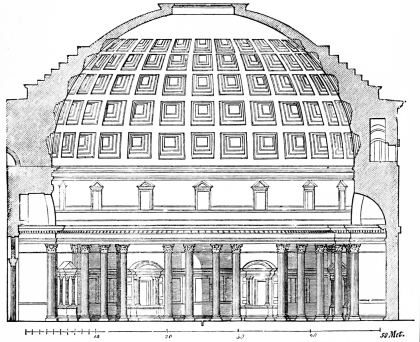
Fig. 275.—Section of the Pantheon, in its Present
Condition.
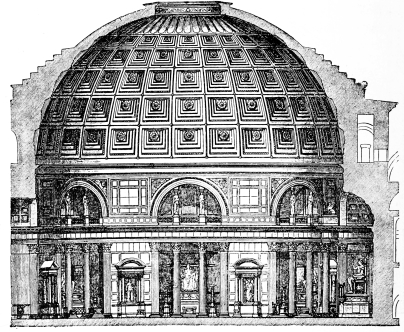
Fig. 276.—Section of the Pantheon. Restoration by
Adler.
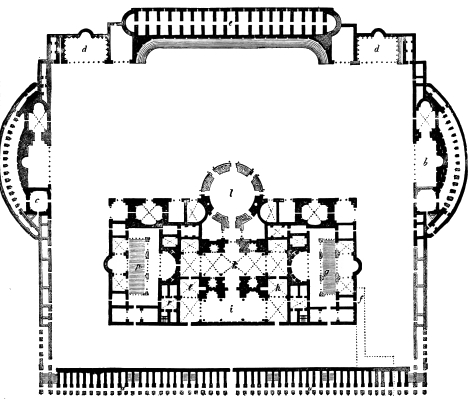
Fig. 277.—Plan of the Baths of Caracalla.
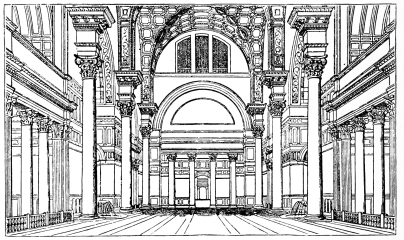
Fig. 278.—Chief Hall of the Baths of Caracalla.
The first secular buildings which attained monumental importance were undoubtedly those erected for public usefulness, like the extensive covered canals so requisite to the very existence of Rome.{426} On the one hand, it was necessary, by means of gigantic sewers, to drain the low land, which was not only full of springs, but was periodically flooded by the Tiber; on the other, to provide the metropolis with good water by aqueducts extending to great distances. Still, it was not until the year 312 B.C., more than two centuries after the building of the Cloaca Maxima, that the first work of this kind, the Aqua Appia, was completed, simultaneously with the first great military road, by the famous censor Appius Claudius Cæcus. This entirely subterranean aqueduct, eight Roman miles long, was followed, down to the time of Diocletian, by no less than thirteen similar constructions of increased dimensions and magnificence. (Fig. 274.) Almost all extended to the mountains which surround the Campagna, even reaching a length of forty-two Roman miles. They provided so great a quantity of excellent water that one third part of it would have been more than sufficient for the real necessities of the city. Stupendous arches raised the conduits high above the ground, while valleys and ravines were spanned by mighty works of engineering, even rivalling the bridges upon the great military roads. The greater part of the water thus obtained was used for the baths, which were increased under the emperors to a measureless luxury, and provided the chief means by which these rulers purchased the favor of the populace. There were in Rome no less than eight hundred and fifty-six private baths open to the use of every citizen for a certain price, besides the great imperial structures which were free to the public. The first founder of these free baths was Agrippa, in 25 B.C., who appears to have followed, in their general arrangement, the type of a Greek gymnasion. The bodily exercises of early times, by which the military power of the State had been trained,{427} were succeeded under the empire by a luxurious care for physical well-being; gymnastic drill appeared unnecessary to the sovereigns of all the known world, while the bath and the toilet became more and more important. Thus, in the Roman baths, the spaces for serious athletic contests, which had formed the principal part of the Greek gymnasion, were wholly subordinated to the departments for indolent luxury and light amusements. The primitive bathing-chambers were enlarged to magnificent halls, which offered the greatest scope for the development of that interior architecture which was cultivated with such great success by the Romans. This grandeur is evident in the imposing rotunda still remaining from the Baths of Agrippa, the remarkable circular structure which, because of its beauty, was transformed by Agrippa himself into a temple—the Pantheon—by the addition of Corinthian columns. (Figs. 275 and 276.) The building, not having been originally{428} planned for an isolated position, is wholly undeveloped upon the exterior, but its massive construction and harmonious proportions have merited the admiration accorded to it in all ages. From the existing remains it cannot be surely determined whether the Baths of Nero, Titus, Trajan, and Commodus, which followed the great creation of Agrippa, surpassed it in dimensions and magnificence; but it is certain that this was the case with the enormous structures of Caracalla and of Diocletian, as the entire plan of the former, with parts of the mosaic pavements, still remains; while the main hall of the latter, in almost perfect preservation, forms the chief part of the Church of S. Maria degli Angeli. The principal structure was usually surrounded by an extensive enclosure, which, in the case of the Baths of Caracalla (Fig. 277), was formed upon the front (a) by a series of separate cabinets. Upon the sides were segmental projections, or exedras (b), with various chambers (c), probably intended{429} for intellectual entertainments, such as rhetorical and poetical dissertations, etc.; while the rectangle was closed by a one-sided stadion, with spaces for gymnastic purposes (d), and a reservoir for water (e). The central building provided upon either side enormous halls for games, preparatory to the ablutions (g, p), between them (i, k, l) the spaces for the cold, tepid, and hot baths; while the adjoining smaller chambers served as rooms for dressing and the manifold processes of the toilet. Between this chief structure and the enclosure race-courses and promenades, with fountains and beds of flowers, added the charms of nature to the magnificence of architecture. The public Baths of Alexander Severus, Decius, and Constantine appear to have been less extended; but these were far surpassed{430} in size by the constructions of Diocletian, which could accommodate three thousand bathers. The Roman buildings for the circus, the theatres, and amphitheatres were of scarcely less importance. The extreme simplicity of the Circus Maximus recalls the early Greek hippodrome; the slopes of the Palatine and Aventine served as a station for the spectators, while the level ground in the valley between formed the arena. It was not until 327 B. C. that the barriers (carceres) were architecturally embellished, and even the rebuilding of the whole by Cæsar was limited to the erection of the lower stories of the auditorium in stone. The wooden superstructure was not replaced by a more permanent and monumental construction until the time of Domitian and Trajan. The general plan was adopted from the Greek model, the peculiarities of the Roman arrangement being a low division wall, or spina, the position of the barriers, and the moat which surrounded the arena (euripis), intended to protect the lower tiers of spectators during the combats of wild beasts. The spina, connecting the two turning-posts (metæ), was ornamented with memorial columns, altars, ædiculas, statues, obelisks, and the like; it did not follow a direction precisely parallel to the side seats, but allowed a considerably broader space upon the right than upon the left, so that the many chariots here crowded together early in the{431} race might not be too greatly impeded. That all the competitors might have an equally favorable position when brought into line, it was necessary that the starting-points should be arranged in the segment of a circle, the centre of which was a little to the right of the spina. This plan may be recognized in the best-preserved Roman circuses, as, for instance, in that at Bovillæ, near Albano, and that of Romulus, the son of Maxentius, upon the Via Appia. (Fig. 279.) The Circus Maximus, like all the other structures of its kind in Rome, has been entirely destroyed.
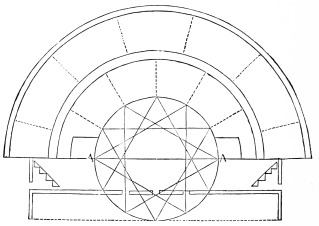
Fig. 280.—Scheme of the Roman Theatre, according to
Vitruvius.
In the earlier periods of Roman history, the theatre did not receive the recognition and assistance of the government; and the law in force until the end of the republic, which permitted no theatre with seats to be constructed within the limits of the city, prevented any monumental development in this direction. Dramatic representations, however, were not to be suppressed after an acquaintance with the Greek drama had once been formed. Comedy was especially popular, and Roman authors devoted their attention to it with success. But these plays were performed only upon festival days, and were undertaken by individuals. The creation of the improvised stage, for transient usage, thus fell to the lot of those politicians whose desire it was to win the favor of the populace. In the latter days of the republic structures were reared which equalled the extravagant magnificence of the Diadochi; the ædile M. Scaurus, for instance, erected a gigantic theatre, to stand only a few days, which provided seats for no less than eighty thousand spectators, the stage being ornamented by three hundred and sixty marble columns and three{432} thousand bronze statues. This boundless waste was brought to an end through the building of the first stone theatre in Rome, by Pompey, who, notwithstanding his great political power, could succeed in silencing the objections made by the conservative party against this innovation only by the pretence that the stone seats were the steps of a temple, which he erected upon the summit of the cavea. This first permanent structure was succeeded during the reign of Augustus by two other theatres, those of Marcellus and of Balbus; the first could seat but a quarter as many spectators as did the theatre of Pompey—namely, twenty thousand—while that of Balbus provided places for only eleven thousand six hundred. In later imperial times even this capacity was found too great. The theatre lost much of its attraction after the Roman people had once seen blood flow in the arena. Yet in all the Roman empire there was scarcely a city of importance where a stone theatre was not erected during the reign of Augustus; even small towns like Tusculum, where the remains are particularly well preserved, boasted of these monuments. The characteristic differences between the Roman theatre and the Greek, its prototype, were that the orchestra did not exceed a semicircle, the front of the stage (A A) being so advanced as to form its diameter, which thus brought the actors nearer to the spectators. (Fig. 280.) The open half of the circle was not, as in Greece, reserved for the{433} evolutions of the chorus, but was occupied by the senators and the higher classes of citizens, who brought thither their own seats. The auditorium, which, with the orchestra, had been restricted to a semicircle, assumed a peculiar form upon the exterior, the entire building standing in a plain, and only rarely, as in Tusculum, occupying a natural slope. With the introduction of vaulting, massive foundations of masonry were rendered unnecessary. Barrel vaults were placed one above another, terminating upon the exterior in a series of arcades, the decorative features of Roman architecture being usually so applied that the lower story displayed engaged Tuscan columns, the second Ionic, and the third Corinthian pilasters, with their respective entablatures. This treatment of the exterior is shown in the best preservation by the remaining amphitheatres; but vestiges of theatres may still be seen sufficient to serve as illustrations, like that of Marcellus (Fig. 281), and those at Orange in Southern France, at Aspendos in Asia Minor, etc.
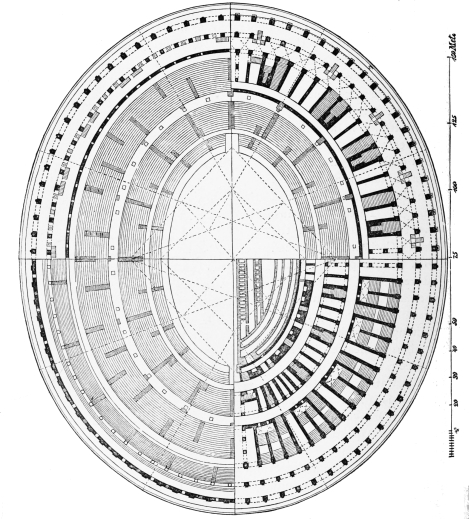
Fig. 282.—Plan of the Flavian Amphitheatre.
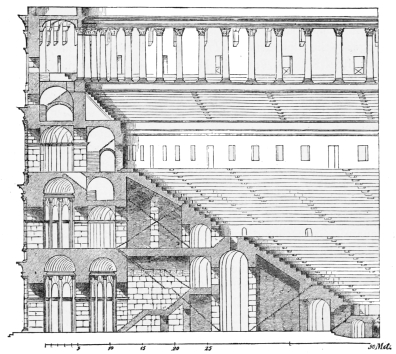
Fig. 283.—Section of the Auditorium of the Flavian
Amphitheatre.
Imposing as the architectural appearance of the Roman theatre was, magnificently and suitably as it was planned, it could never attain great national, and consequently historical, importance, because tragedy was never popular and comedy never political. The warlike and bloody scenes presented by the mortal combats of gladiators and wild beasts had a far greater attraction for a people who, by nature, felt more reverence for Mars than for the Muses. It was{434} long, however, before these exhibitions were provided with especial arenas. After the introduction of the gladiatorial contests by Marcus and Decius Brutus, in 264 B.C., upon the occasion of funeral games, the prisoners of war had fought together upon the Forum;{435} and the slaughter of powerful animals, inaugurated under Metellus by the killing of elephants taken from the Carthaginians in 252 B.C., and continued under Æmilius Paullus by the sacrifice of deserters to beasts of prey, had taken place in the Circus. But this could not have been well suited to the purpose, as its limited width was impeded by the spina, and its side barriers could not have offered sufficient protection to the spectators from the desperate attempts of the infuriated animals to escape. As early as 59 B.C., Caius Curio had surprised the Roman people with two wooden theatres, built back to back, and arranged so as to turn bodily upon their axes after the conclusion of the scenic performances, so that the two auditories faced one another, and left between them an arena for the succeeding combats of gladiators. It is not certain whether this was the original of the amphitheatre, or whether the oval plan arose from{436} simply giving broader proportions to that form of stadion, like the one at Aphrodisias in Caria, which was terminated by a semicircle at each end. But it is scarcely to be doubted that the wooden Theatrum Venatorium of Cæsar had the disposition which was repeated, with but few alterations, in the stone amphitheatre of Statilius Taurus, built during the reign of Augustus, and in those of wood erected by Augustus, Tiberius, and Nero. By the time of the Flavians it was recognized that no gift was so acceptable to the Roman populace as the provision of a magnificent place fitted for these inhuman games, and thus arose that most gigantic edifice of all ages—the Colosseum. (Figs. 282 and 283.) Even provincial towns like Reggio, Pompeii, Herculaneum, Albanum, Tusculum, Sutri, Pola, Verona, Nismes, Treves, Constantine, etc., were provided with edifices of this kind, fully as important in proportion to the number of their inhabitants.
The mausoleums and monuments erected in honor of prominent citizens constitute an important class in the architectural history of Rome. In early times a tumulus form, similar to that of the Etruscan tombs, seems to have predominated. The older monuments in the vicinity of Rome were thus constructed. A tumulus, the lower cylinder of which appears to have been elevated upon a square substructure decorated with Tuscan pilasters, may be assumed to have existed above the remarkable sepulchral labyrinth of the Scipios, outside the Porta Appia, and within the present Porta S. Sebastiano. In course of time the circular drum of masonry increased, while the original cone was diminished to a pointed roof; the magnificent tombs of Cæcilia Metella, the wife of Crassus, and of the Plautii upon the Via Appia and Via Tiburtina, show it as already preponderating. The tumulus of Augustus upon the Via Flaminia, at present within the Porta del Popolo, displays a cylinder of 24 m. in diameter, decorated by thirteen niches once provided with statues; while the cone of earth above, which was archaistic agreeably to the affectation of Augustus, was planted with cyprus-trees and terminated by a colossal image of the imperial builder. Even more gigantic was the mausoleum built by Hadrian, the lower portion of which now forms the substructure of the Castle of S. Angelo. It was once surmounted by a second smaller cylinder bearing a conical{437} roof. When the area at disposal was too limited for the adoption of so extended a base, the monument rose, like a tower, to a great height, in successive stories of decreasing dimensions, with or without columns, as in the fine example of St. Remy in Southern France. The endless rows of tombs upon the Via Appia vary from simple piers and subterranean burial-chambers (called columbaria, from the thousands of niches for funeral urns resembling the nests of doves) to colossal mausoleums. The remains of bulwarks prove that many of these elevations were utilized for mediæval fortresses. Even foreign forms were employed; the so-called Tomb of the Horatii at Albano resembles that of Porsena, while the Egyptian pyramid is reproduced in the mausoleum of C. Cestius near the Porta di S. Paolo. The conformation of the land presented but little opportunity for the execution of rock-cut tombs with a front carved in the cliff; but one remarkable example has been preserved upon the Lake of Albano, called, from the twelve fasces introduced in its decoration, the Tomb of the Consuls. In the mountainous provinces of the East these sepulchres were more common, as, for instance, in Petra, where numbers of façades hewn in the rock, with a kind of decorative temple-like architecture, betray magnificence rather than good taste. (Fig. 284.)
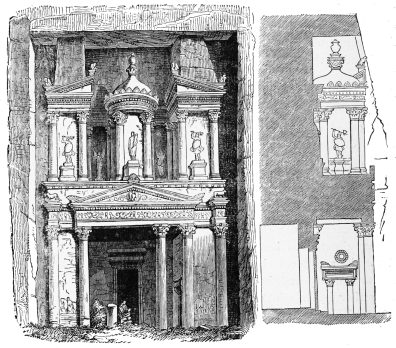
Fig. 284.—Façade and Section of a Rock-cut Tomb at
Petra.
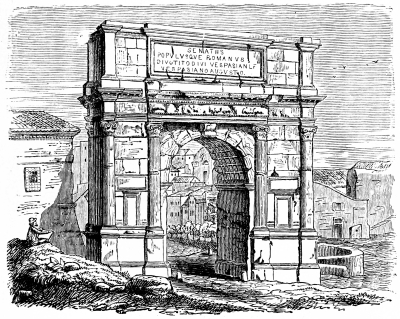
Fig. 285.—Triumphal Arch of Titus.
The monuments commemorative of individuals do not, as in Greece, deserve to be treated in the section upon sculpture; in Rome the architectural pedestal was more important than the statuesque carving, and, indeed, the image was frequently supplanted altogether by inscriptions. Statues were often placed upon columns. These were often provided with characteristic decorations—as is the case with the prows of vessels upon the shaft of Duilius, erected in 260 B.C.—and were often of gigantic dimensions, thus withdrawing the figures upon their summits from close inspection. The most sumptuous example of these monuments is presented by Trajan’s Column, the base of which contained the sarcophagus of that emperor. The surface of the shaft was either covered with reliefs of many figures which, like the interior staircase, ascended spirally upward, as upon the Columns of Trajan and of Marcus Aurelius, or were merely treated with architectural forms like the granite column of Antoninus Pius, the relief upon the pedestal of which is{438} given below. (Fig. 304.) There are similar shafts, dating from the Roman occupation, at Cussi in France, at Alexandria, Constantinople, and Ancyra. In all these works the portrait was far exceeded in importance by the monument; sculpture was rendered subordinate to architecture. This was the case in a still greater degree in the triumphal and commemorative arches. As the equestrian statues and quadrigas have disappeared from all the works of this kind now preserved, it might easily be forgotten that these figures were in reality the principal part of the composition, and the arches beneath them little else than pedestals placed above the streets, and consequently provided with passages. Festive portals constructed of light timbers and decorated for gala-days doubtless afforded the prototype for these works. Triumphal arches were comparatively rare in the time of the republic, but very common under the emperors.{439} They express the nature of Roman art better, perhaps, than any other class of structures: the mass of masonry, encased in columns and entablatures which were merely ornamental features without constructive functions; the reliefs of small figures crowded together as in a chronicle; the numerous decorative statues above the columns as well as upon the top; the extended inscriptions upon the attic above the arches, which thus formed, in a more restricted sense, the pedestal of the crowning group—these all express characteristic tendencies, and present the best example of the solid but ostentatious construction which predominated in Roman architecture, subordinating ideal beauty to the temporary purpose. Augustus, Trajan, and Hadrian were the chief builders of these monuments, which have remained in all the provinces of Rome: at Benevento, Ancona, Rimini, Susa, and Aosta in Italy; at St. Remy, Orange, Besançon, Cavaillon, and Rheims in France; at Alcantara, Merida, Bara, and Caparra in Spain; at Theveste and El Casr in Africa, etc. There are{440} four of these arches in Rome—two with a single passage (those of Drusus and of Titus [Fig. 285]), and two (those of Septimius Severus [Fig. 286] and of Constantine) with additional openings on either side. The Arch of Constantine surpasses its known predecessors in beauty of composition and proportion only because it was patterned after an arch of Trajan, and even built with the same materials. This arch is at once the memorial of one of the most important victories recorded by history, the battle near the Milvian Bridge, and of that unexampled poverty of artistic invention, or rather want of productive energy, which characterized all Roman intellectual life after the time of Constantine.
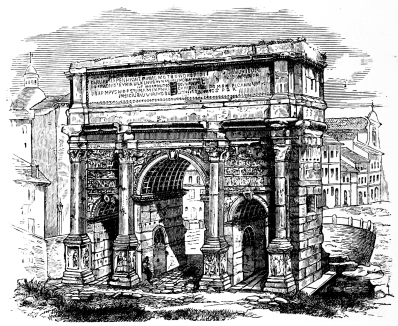
Fig. 286.—Triumphal Arch of Septimius Severus.
The so-called Janus portals were erected above the streets and squares of Rome, much in the same manner as the triumphal arches. They were commonly simple, like the three Jani upon the Forum Romanum, but were increased at street-crossings to extensive quadrifrontes,{441} or structures presenting the same face upon all four sides. The former bore two-faced Jani upon their summits, the latter a four-faced combination like that upon some figures of Hermes—an image well adapted to represent the watcher over the crowded thoroughfares. The Janus Quadrifrons upon the Forum Boarium (Fig. 263) is, with exception of the attic, particularly well preserved; it was richly ornamented by the statues of deities, no less than thirty-two niches being provided upon its walls.
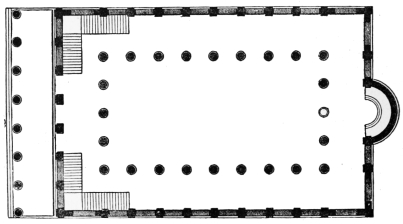
Fig. 288.—Plan of the Primitive Roman Basilica.
Restoration by Reber.
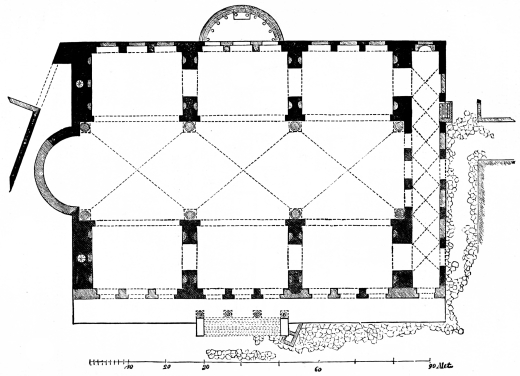
Fig. 289.—Plan of the Basilica of Maxentius.
The buildings which surrounded the public squares corresponded in lavish magnificence to the altars, statues, dedicatory columns, and triumphal arches. Broad colonnades with shops formed the enclosure, interrupted by temples, and courts of justice, or curias, which can have differed but little in external appearance from the sacred edifices. Most important among these public buildings were the basilicas, which, in name, purpose, and form, were derived from Greek prototypes. As halls of justice and places for commercial traffic, they may be regarded as covered extensions of the open squares. Several of these buildings, erected during the imperial epoch, are known by considerable remains, but they deviate so greatly in disposition as to have no plan in common beyond that of a hall surrounded by narrow aisles. The oldest Roman structure of this kind, the Basilica Porcia built by Cato in 185 B.C., was of an oblong shape, abutting with one of its ends upon the Forum, while the other was enlarged by a small exedra, or apse. (Figs. 287 and 288.) The chief space was surrounded upon all four sides by two-storied aisles, the central hall, however, not rising above them, as in the Christian basilica, this being difficult of construction because of the slightness of the shafts, and not necessary for the introduction of light. A portico with a flat roof was erected above the entrance, enlivening the bare and extended front wall. Thus the Basilica Porcia did not differ in principle from the early Christian church, and the similarity appears also in the other basilicas of the Roman republic, all of which had their front upon the smaller side. In the courts of the imperial epoch, however, this primitive type was treated with great freedom, and nothing remained of the original arrangement but a large central hall surrounded by a double passage of arcades upon piers, without columns and without an apse. The normal{442} basilica, described by Vitruvius, with two-storied side aisles, faced with its greatest length upon the public square, and had an apse; the basilica at Fanum, built by the Roman writer, was similarly arranged upon the facade, but a clere-story supported upon gigantic columns rose above the lateral passages. These passages opened, from the end opposite the entrance, into an adjoining temple, the pronaos of which served as the tribune of the forensic court. The basilica at Pompeii, of which the narrow side was the front, had no apse, while the Basilica Ulpia had great exedras upon both ends, with the entrance portal upon the longer side. The Basilica of Maxentius (Fig. 289), which was completed by Constantine, was an{443} exception in every respect, being entirely vaulted, and having two apses upon adjoining sides opposite to the two chief entrances. The whole formed one of the most remarkable and important halls of antiquity, with the consideration of which the history of Roman architecture may well be terminated. The original type of the basilica was wholly neglected by later architects, who treated the{444} problem of a forensic hall without restrictions, utilizing the accidental formations of the ground, while endeavoring to combine suitability and the display of ingenious constructions with magnificent novelties of their own invention.
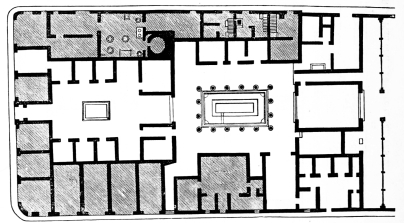
Fig. 291.—Plan of the House of Pansa in Pompeii.
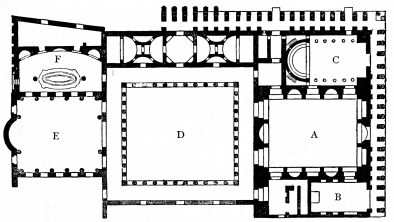
Fig. 292.—Flavian Palace.
A. Tablinum; B. Lavarium; C. Basilica; D. Atrium; E. Dining-hall
(Œcus); F. Nymphæum.
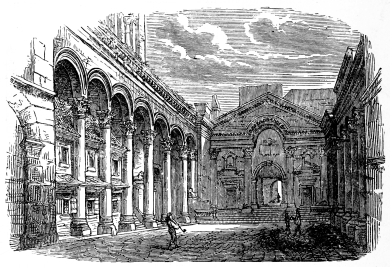
Fig. 293.—Court of the Palace of Diocletian at
Spalatro.
The Roman dwelling-house was, in the earliest ages, identical with that of Etruria, and, indeed, of all Central Italy. Although related to Hellenic prototypes, the peculiarly Italian atrium, without columnar supports for the roof, remained in use even after the general introduction of the Greek peristyle. At Pompeii a combination of these two varieties of court is met with, the front space being a simple atrium, and that further within a peristyle. Each enclosure was surrounded by chambers. (Figs. 290 and 291.) The mosaic and painted decoration of the floors and walls will be treated in a later section. The small chambers were lighted only through doors opening from the inner courts, and did not share in the architectural importance{445} assigned to the larger halls, which, in the last years of the republic and in the imperial period, transformed the houses of the wealthy into veritable palaces. With the luxury of the table, the magnificence of the dining-room was increased; and, with the growing taste for literature and art, extensive libraries and galleries of pictures became prominent features. Many of the forms adopted for this palatial architecture appear to have been derived from the later Greeks; the designation of halls, as those of Egypt and of Kyzicos, employed by Vitruvius, pointing to the sovereignties of the Diadochi. This enlargement of extensive rooms by columns was, however, in a great degree supplanted by vaulting, in which case the columns were introduced merely as decorative members. Much attention was devoted to a lavish enrichment of these rooms, the shafts being colored marble monoliths, the lacunæ of the vaulted ceilings overlaid with bronze or richly gilded, and the capitals being sometimes formed of solid metal. One of the halls in these palatial residences, the private basilica, though it may not have been universal, deserves especial consideration because of its great importance in later times. Such courts of justice are mentioned by writers of the Augustan age as forming part of the dwellings of men of condition, “because in their houses councils were held upon public and private{446} matters, and civil cases decided.” These halls were naturally modelled in a great degree after the public basilicas upon the forums, such as the Porcian, Æmilian, Sempronian, and Opimian basilicas, which had been built during the republic; but they appear, when compared with the primitive type of the Roman basilica, to have differed fundamentally in two respects. In the first place, the hall, being surrounded by the chambers of the dwelling, could not be provided with windows like the free-standing, forensic basilicas, and a clerestory rising above the adjoining rooms was consequently adopted. This rendered necessary a second modification. To impose a heavy wall of masonry, besides the timbered ceiling and roof, upon a double story of columns must have seemed inadmissible to the Roman taste for substantial construction. The aisles upon the front and rear were consequently given up, the columns and galleries remaining upon the sides only, the massive masonry of the enclosure thus receiving the thrust of the clere-story wall, and greatly increasing its stability. (Fig. 292.) This loss of continuity could have been of no great disadvantage in the private basilica, as it did not serve, like the free-standing public structures, for traffic and promenades, as{447} well as for sessions of justice. The galleries over the side aisles were frequently omitted, and it appears to have been in these halls that the connection of columns by arches, in the place of lintels, was first introduced. Such archivolts are first known by examples built during the reign of Diocletian, as at Spalatro (Fig. 293); but they soon came into general usage, their practical advantages outweighing the want of æsthetic fitness inherent in such curved entablatures. It was from these private basilicas that the first Christian churches were architecturally developed. The believers had assembled, during the imperial ages, in the houses of wealthy converts; and as these halls of justice had been used for religious services during times of persecution, it is not strange that, after the recognition of Christianity by the Roman government, their arrangement and even their name should have been retained.
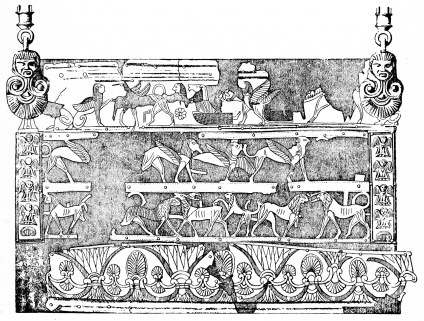
Fig. 294.—Fragment of the Cista Prænestina.
In Roman architecture were found great intelligence in the solution{448} of the constructive problems involved in the enclosing of large spaces, great independence in the development of technical perfection, and a masterly conformity to the purpose of the structure; but Roman sculpture, although of very extended application, had less independence and significance. The Romans, originally too practical to provide a place for the beautiful beside the useful, first gave decided admission to this art when the political growth of the world’s metropolis had reached the acme of its power; and even then they transferred the question of sculpture to foreign artists in their employ. In the earlier republican period, their practice of this art was scarcely worthy of mention; in the time of the kings, or, at least, until the year 170 of the city, sculpture seems not to have existed in Rome, or only to have been employed in the ornamentation of utensils like the Cista Prænestina (Fig. 294) with Phœnician-Etruscan anthemions and figures of animals riveted on. If these may be considered rather as a direct importation from Etruria and the neighboring Grecian and Phoenician colonies than as their own work, it may be said that the Romans of this period had no images of the gods.
The first work of statuary which appears to have been exhibited in Rome was by an Etruscan, Volcanius, or Volca, from Veii. This was the colossal Jupiter sitting upon a throne, ordered by Tarquinius Priscus for the Capitoline Temple. Formed of terra-cotta, the face colored red, and wearing upon the head a chaplet of oak-leaves—originally, perhaps, of bronze, but afterwards of gold—it appears, with the exception of the head, to have been but slightly modelled, as it was covered with an embroidered garment. A Hercules within, and the quadriga upon the gable of the same temple, both also of terra-cotta, are ascribed to this artist. The chariot was, in 296 B.C., replaced by a bronze, which ninety years later was gilded.
Even from the beginning the tone of Roman sculpture was affected by Grecian as well as by Etruscan influences. The image in the Temple of Diana built by Servius Tullius upon the Aventine{449} was a xoanon—a rude puppet of wood imitated from the Artemis of Massalia (Marseilles)—a work after the manner of the Ephesian Artemis, and consequently still undeveloped, and, at the best, Daidalian. Two generations later a more advanced Hellenic style obtained, when, in 493 B.C., two Greeks of Lower Italy, Gorgasos and Damophilos, decorated the Temple of Ceres with paintings and figures of terra-cotta. Eight years later, these were followed by the three divinities of the temple—Ceres, Liber, and Libera—which were the first bronze statues in Rome. But, at the same time with the work of the Grecian artists, and as if to prevent a decided Hellenic preponderance, the wooden image of Juno Regina was brought from Veii to Rome; and this cannot have been without effect upon the figures of Fortuna Muliebris, consecrated four or five years later, in 487 or 486 B.C. In the epoch next following, rife with civil wars and misfortunes of every kind, the pursuit of art seems to have languished, and its necessities to have been met chiefly by booty from the conquered cities of Etruria, though many of the subjects were Roman, like the Janus Geminus, copies of which have been preserved upon coins. (Fig. 295.) Of this period are the Vertumnus and the Lavinian Penates, and especially the first portrait statues of heroes like those of the Ephesian Hermodorus, the interpreter among the lawgivers of the Decemvirate, in 450 B.C.; of Ahala and L. Minucius, as protectors from usurpation, in 439 B.C.; and of the four ambassadors murdered by the Fidenates, in 438 B.C.
Art first became more active when, at the close of the Samnite war, in 288 B.C., the Roman authority began to make itself felt in the Grecian towns of Lower Italy. Then originated the rich sculptured ornaments of the Forum—the statues in honor of Mænius, Camillus, Tremulus, and Duilius, and also of the Greeks Pythagoras and Alkibiades, commanded by the oracle; further, as shown by Detlefsen to be probable, portraits of the Sibyls, and of Attus Navius, Horatius Cocles, M. Scævola, and Porsena, falsely attributed to earlier times. The Capitol was decorated by statues of the seven kings, and of Tatius and Brutus; and the Via Sacra, besides those of Romulus and Tatius, with an equestrian statue of Clœlia. Nothing remains of these works, which were almost exclusively of bronze, and only one sacred figure gives any illustration of their technicalities{450} and style—the Wolf—now preserved in the Capitol. Although the two sucking children are lost, it is probably the one consecrated by Ogulnius under the Ruminal fig-tree, in 295 B.C. (Fig. 260.) Without doubt, the characteristics of this period were more Italian, or, according to the usual term, Etruscan, than Greek; and, in considering the sculptures generally, the predominant influence in the portrait-statues may be ascribed to the Etruscans, and, in those of a devotional character, to the Greeks, since it was from the Greeks that the Romans chiefly borrowed this type.
Two other works preserved from the third century B.C., and designated in the inscription as by Roman artists, show plainly the conflict of the two tendencies. The first of these is the celebrated Cista of Ficoroni, made in Rome, with the inscription of Novius Plautius engraved in the ancient character, found near Palestrina (the ancient Præneste), and now in the Kircherian Museum in Rome. Its chief feature, an episode from the legend of the Argonauts, represented in sgraffito upon the vessel, is so purely Greek that it might be regarded as imported ware were it not for the accessories—the bulla, bracelet, and shoes—which point to Italy, perhaps to Lower Italy. According to Mommsen, Plautius was from Campania. The handle and feet, on the contrary, are entirely Etruscan, and exhibit quite a different tendency. Though the name of the artist and the dedicatory inscription are placed upon the handle, they cannot relate to these castings, which are of quite ordinary manufacture, but rather to the engraving, Plautius having obtained the vessel ready-made in Rome, where he worked. The second of these works, nearly contemporary{451} with the other, is a small head of Medusa, in high-relief, with the artist’s name upon it, C. Ovius, from the Tribus Aufentina. In this the two factors, Grecian and ancient Italian, which formerly stood side by side, appear to blend, and thus to perfect what must be designated as the specifically Roman style.
But at the close of the second Punic war, about 200 B.C., began the extensive importation of statues, first from the Grecian cities of Italy, afterwards from Greece proper. It has been related how Rome, in 150 B.C., became the central point of Grecian activity in art, and the seat of that renaissance which followed the past stages of Hellenic artistic development in reversed succession. As the Roman deities had become throughout almost identical with those of the Greeks, and as the statuary that ornamented the squares, streets, gardens, baths, fountains, houses, and villas were either Grecian spoil or copied from celebrated Hellenic originals, there remained for the peculiarly Roman art, as it had arisen from the combination of Etruscan and Hellenic elements, only a comparatively small field.
The Grecian stamp was given, so far as might be, even to those deities, such as Juno Lanuvina, who, on account of their decided individuality, could not be exchanged with those of the Greeks, nor with the gods borrowed from the Oriental mythology. This did not, indeed, flourish in the West until the late times of Hellenism, two centuries B.C., and appeared, for the most part, still later in Rome, as shown by the worship of Isis, and the frequent statues of that goddess (Fig. 296) and of Harpocrates, and by the Persian homage to Mithras, with its sacrifice of bulls. (Fig. 297.) It was the same with the uncommonly numerous Roman personifications and allegories,{452} the individual type of which was, as a rule, quite commonplace and without expression, the intention of the artist being recognizable only by attributes. A draped female figure, such as the Flora or Pudicitia, might be a Concordia, Constantia, or Fides; a Pax, Libertas, or Securitas; a Virtus, Justitia, or Æquitas; a Salus, Pietas, or Annona—according to what was placed in the hand, upon the head, or at the feet; the age, garments, or position being rarely taken into consideration. With the male representations the difference in regard to nudity and manner of clothing (Figs. 298 and 299) was greater, and the interchange of related deities facilitated, as in the use of Hermes for Bonus Eventus. In personifications the character, garments, and attributes were doubtless more marked. To the most celebrated works of this kind belong the figures of the fourteen nations conquered by Pompey in the Porticus ad Nationes. These were executed by Coponius, the only distinguished sculptor certainly known with a Roman name. We may, perhaps, consider these as analogous to the Germania Devicta (Thusnelda) in Florence, but probably, after the manner of representations of Asiatic cities upon the base of Puteolani, they were more varied and less cold than the mere allegories of abstract ideas. Generally, in carrying out these conceptions, individuality of characterization in the figure or the action was not attempted, a certain common correctness, grace, and superficial beauty being held to suffice.
In portraiture, the Roman sculpture developed far more speciality and meaning. The early tendency of ancient Italian art towards the individual has already been described, and it may easily be understood that, in the line of portraiture, this had an important influence, even after Hellenic art had completely established itself upon the Tiber. In this province it best served its purpose. Still, it is evident that the vacant, external individualization peculiar to the primitive works of Etruria and Rome, such as the wax masks of their ancestors, required improvement by greater expression of life and character, for which Lysippos, in portrait-sculpture, had so decidedly opened the way. By the combination of these two elements, the portraits became the most successful works of Roman sculpture. The Hellenic tendency to idealize prevailed in those statues which presented the person heroically—as Achilles, for instance—or were rendered divine by attributes of Zeus, or Apollo, Juno, Ceres, Venus, and others. The figure was then usually nude, and was only so far imitated from life as to give to the head the true features, with a certain transfiguration. This treatment, exemplified in many of the statues of Antinous, had prevailed in Hellenic art since the time of Lysippos, the great master of portrait-sculpture. The native Italian tendency, on the contrary, had sway in the so-called “iconic” statues; in those, namely, in which the personal and human character was carried out. In these the clothing was given with more detail and significance; as, for example, in the figures of the emperors wearing the toga (statuæ togatæ), or the presidents of the senate. Others are represented as high-priests, with the drapery drawn over the back of the head; others (statuæ thoracatæ) as field-officers, in coats of mail, as, among many examples, in the celebrated Augustus of the Vatican, found, in 1863, before the Porta del Popolo. (Fig. 300.) In these the action generally chosen seems to have been that of address to the senate or to the army. Equestrian statues belonged{454} chiefly to the thoracatæ, though they appear also in conception like Achilles, nude, or clothed only with the himation. As they were all of bronze, few remain; so that the Marcus Aurelius upon the Capitoline, notwithstanding its hardness and other faults, is the most celebrated, and has become the standard for countless modern statues. The figures upon chariots, on the contrary, and especially those which ornamented the triumphal arches, were, for the most part, togatæ. The mention of triumphal groups with six pairs of horses, or of elephants, shows to what extreme of tastelessness Roman art had become debased in the time of the emperors. The better works of this class are most suitably represented by the four bronze horses, falsely ascribed to Lysippos, which were brought by the Venetians from Constantinople in 1204, and which have been placed over the portal of St. Mark’s Church in Venice. Iconic female statues are distinguished by careful imitation of garments falling in rich folds, and, even in the early times, by exaggerated head-dresses, which gave them the appearance of fashion-plates. Noble ladies, sitting comfortably, and{455} with dignity, in arm-chairs, are among the most successful of Roman works. Yet there is in all these portrait-statues, especially in the usual oratorical gestures, a typical character as little to be mistaken as is the softening influence of Hellenic idealism in most of the heads. Without injuring the individuality, it increases the beauty and heroic elevation of the entire figure. Not unfrequently, however, instead of inner significance, we find merely richness of drapery and detailed accessories, particularly in reliefs upon coats of mail, etc.
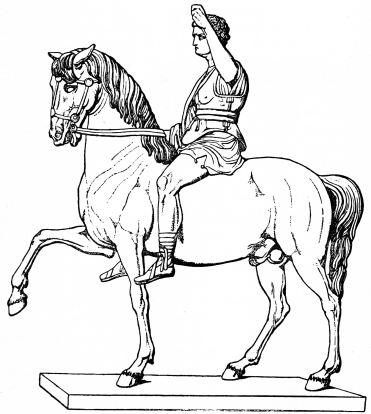
Fig. 301.—Equestrian Statue of Nonius Balbus, Jun.
(Sculptor unknown.)
The same combination of native Italian tendency with Hellenic enlightenment, found in portrait-sculpture, is shown in the reliefs{456} which thereby became specifically Roman. These appear to have been very numerous, as it pleased this people to leave few vacant surfaces upon their monuments, which were not only ornamented, but literally covered with reliefs and inscriptions. Thus sculpture became as much a written chronicle as a decoration. In limited spaces, such as pedestals and capitals, and the key-stones of arches, it became merely ornamental; the subjects of the ornamentation, in keeping with the style, being chiefly allegorical, such as Victories bearing trophies, the Seasons, etc. Upon large surfaces sculpture completely took the nature of chronicles and inscriptions, and thus were developed the truly Roman historical reliefs in connection with inscriptions.
These, in accordance with the Italian view of art in general, rested almost entirely upon a realistic foundation. Mythology disappeared, and allegory alone still exercised a small influence; as, for example, the Genius of Immortality bearing upward a deified emperor, Roma with the triumphal quadriga, Victory upon a shield perpetuating the memory of conquest; while personifications of cities or rivers, and even of swamps, indicated the locality of the action, or Jupiter Pluvius signified the coming of the saving rain. After the Antonines, the events are related with simple truth to nature, as a mere chronicle, without any idealization at all. The subjects of Roman reliefs are distinguished from the Grecian only by the Greeks having substituted, whenever possible, mythological for human or common events; and there was no less difference in the artistic treatment. The Greek never lost sight of that conventional law in sculptural reliefs by which the figures are conceived in a situation to give the most pleasing outline. The whole procession of persons, one behind the other, excluding all effect of foreshortening and perspective, was displayed upon a surface, and developed, so far as the figure would permit, in harmonious unity, and, whether represented sitting on horseback, or on foot, occupying the same space in regard to height and in regard to the depth of relief. It resulted that the design was arranged in reference to two planes only—the original surface of the stone, which disappeared with the work (except in the highest points), and the common background. Roman sculpture, on the other hand, freed itself from all such laws of style.{457} The profile position no longer predominated, and the figures in the mutilated remnants, where the details are lost, appear like formless masses, which, in the Hellenic system, would have been impossible. The outline loses its significance, and the figures are arranged with such disregard of the surface upon which they are placed that they rather resemble portions of statues. The projection from the background also varies, many parts, particularly the head and arms, standing entirely disengaged. In the arrangement of several figures, one behind another, against a landscape or architectural background, an attempt was made to distinguish the forms in front from those behind by higher or lower relief, with something of the effect of perspective. (Fig. 302.) From this ensued a confusion of lines and a want of clearness, atmospheric effect not assisting in sculpture, as in painting, to separate the farther object from the nearer, and thus to define the distance. This crowding was still more objectionable when, besides being grouped one behind another, the figures were placed one over another, representing the scene as if from a bird’s-eye view.
It thus happened that Roman sculpture in relief was characterized rather by a realistic and picturesque tendency than by well-conventionalized composition. But the forms remained Hellenic, at least so far as the circumstances represented in Grecian examples would permit. When, however, a river was to be represented, for which the Greeks always placed a local deity as symbol, or when the besieging of towns, castles, or bridges was given, the Romans approached more nearly to the conception of Oriental nations. As the subject was of more importance than the composition, the deed than the artistic illustration, a certain common and formal correctness sufficed—an artistic handwriting, so to speak, which might be easily read. Their work might be termed an unconscious translation from the Assyrian or Egyptian into the Roman language.
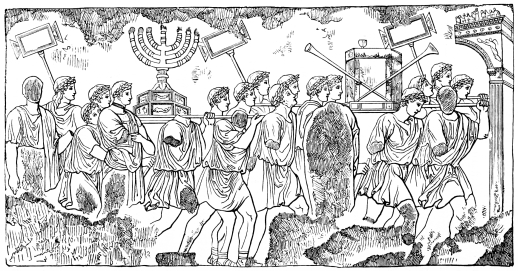
Fig. 302.—Relief from the Arch of Titus in Rome.
It does not appear that the sculpture of historical reliefs was developed much before the time of the Empire; at least, not more of these remain than of the Roman portrait-statues that can be imputed to a more remote period. Historic sculpture was best exhibited in triumphal monuments. To this class belong the two world-renowned columns of Trajan and of Marcus Aurelius. With{458} more than five thousand figures and over two hundred scenes, they are among the most magnificent sculptural representations of all times. Upon these ascending spiral reliefs are unrolled the chronicles of the Dacian and Marcomannic wars. The main events are recognizable throughout, and the barbaric tribes may be distinguished by{459} their costumes, arms, and physiognomy; so that if written history were wanting, the reliefs upon Trajan’s Column would be an important source of information in regard to the biography of this emperor and Roman imperial history. Vigorous in treatment and skilful in drawing as it must be admitted that they are, still their artistic value, from want of style in composition, is very small.
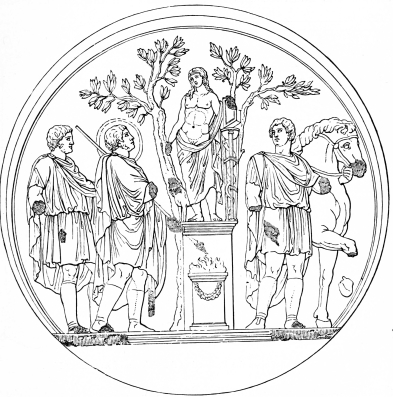
Fig. 303.—Relief of Trajan, from the Arch of Constantine
in Rome.
The oblong tablets of relief upon the triumphal arches occupy a somewhat more favorable position, because the frame led to a more formal, and the duplication to a more harmonious, composition. The reliefs upon the Arch of Titus, particularly those on the sides of the two large passages, notwithstanding the ignorance which they betray, are of far higher importance in art; and the same may be{460} said of the reliefs upon the monuments of Hadrian and Trajan. (Fig. 303.) How far the graces of form and order, inherited from the Greeks and hitherto prevalent, had disappeared even in the time of the Antonines, and given place to a formal and vacant hardness, is shown by the relief upon the pedestal of the lost statue of Antoninus Pius. (Fig. 304.) This represents the apotheosis of Antoninus and Faustina, who appear seated upon the back of a stiff, floating Genius of Immortality, in the weakest of compositions, while cold and all-controlling Allegory places by the side of Roma a personification of the Campus Martius, recognizable by the attribute of the obelisk which was erected there by Augustus.
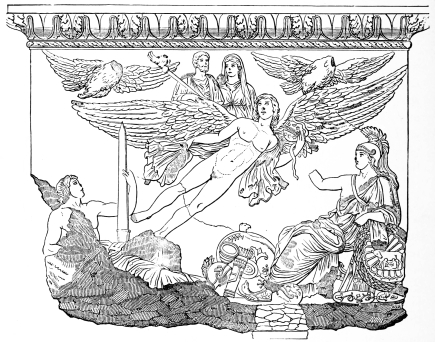
Fig. 304.—Relief upon the Pedestal of the Column of
Antoninus Pius.
Roman sculpture reached its highest point under Hadrian. This emperor filled all spaces with sculpture, as Trajan covered them with inscriptions commemorating his restorations, acquiring thus, in later times, the nickname of the “Lichen.” Even the golden house of{461} Nero was, in this respect, surpassed by the Villa of Hadrian at Tibur, where it pleased him to reproduce all the wonderful works of architecture and of sculpture which he had noticed in his extended travels through the Roman world. After the death of Hadrian, however, who, as an enthusiastic admirer of Greek art, naturally directed the artistic industry of his time to the best possible reproductions of the highest products of Hellenic art, the Romans began to follow the works of the later ages. The lower they placed their aim, and the farther they were removed from the original source of inspiration the more rapid was their decline.
Ideal art degenerated into increasing formalism, carelessness, weakness of sentiment, and shallowness, though still retaining much that was good, because the originals, though copied and recopied, still dated back to the best periods. Portraiture naturally retained more independence; but this also would have been stifled by the enormous requirements, even if the declining art had possessed fresh vigor. To understand this excessive demand, it is only necessary to bear in mind the rapid succession of emperors after Antoninus, with the consequent changing of imperial statues in all the cities of the Roman empire. With the Antonines expired the ideal element in sculptural portraits; and prosaic realism, as it had existed in ancient Italian art, obtained exclusive mastery. Anxious struggles after external likeness in small and inartistic details, like wrinkles, and abnormities such as the curly and frizzled hair of the Antonines, and of L. Verus, with locks like porous pumice-stone, took the place of the lost ideal—remarkable examples, which failed to preserve the lifelike expression. Within a century art had altogether lost the capacity for characterization, even in portraiture; and the numerous busts of the later empire can hardly be distinguished one from another. They are mostly portraits of emperors, empresses, and princes, whose heads are stiffened and hardened into a common type. Previously, with a change of the sovereign, they had altered the heads of the Achilleic and iconic imperial statues; but it now sufficed merely to vary the inscription, and, at most, the accessories. But it was not difficult to change the face also, since it pleased them, in making busts, to combine marbles of different hues, so as to realize the local colors. Thus the mask was of simple white, the hair{462} of dark marble, the garments of red, green, and gray marble or granite, and even the band for the forehead and the clasp for the toga were of a suitable hue. In the heads of ladies this disagreeable polychromy had the advantage that, upon the portrait of the same sovereign, not only the mask, but the wig, could be altered, which, according to the fashion of the day, might be blond, red, or dark, with any desired mode of dressing the hair.
Carving in relief, after the Antonines, suffered a similar decline. The sculptures upon the Column of Marcus Aurelius, in comparison with those of Trajan’s Column, notwithstanding their unmistakable dependence upon the older example, show the want of energy, of appreciation of form, of variety, and of technical ability which characterizes the loss of creative power, and the mere reproduction of models. The reliefs of the Arch of Marcus Aurelius, once upon the Corso at Rome, now in the palace of the Capitol, betray the same vacuity of expression and hardness of form, in comparison with the illustrations from the life of Trajan upon the Arch of Constantine; even when compared with the sculptures upon the pedestal of the Column of Antoninus Pius, a decline is visible from the time of the older to the younger Antoninus. But even these are superior to the reliefs upon the Arch of Septimius Severus, erected in 201 B.C., which, in the main parts, have a fourfold division, in order to gain space for the utmost possible number of representations. From the nature of the design, the spiral reliefs upon the columns of Trajan and of Marcus Aurelius exhibited such parallel rows, one above another; but here the same method is employed upon a plane surface, although it crowds the subject to such an extent that the figures become insignificant and, at a little distance, indistinct. In these four lines are given scenes of war, not, apparently, so much to celebrate combat and victory in general as to register especial facts, battles fought with various weapons, sieges, capitulations, and the transport of booty. Though many of the details were vigorous, the forms in general tolerably correct, and the technical ability considerable, yet the composition appears barbaric, the grouping awkward, and the filling of the given space, the composition, and the artistic construction altogether unfortunate.
After Septimius Severus, statuesque art degenerated into mere{463} stone-cutting; the portraits are unrecognizable, the reliefs without expression or effect, except, as in Egyptian art, from the number of figures and accessories. In religious sculptures, finally reduced to bungling artisan work, the last spark of Hellenic tradition died out in continued weak copies. In historical reliefs the impulse to create perished with the artistic ability. When large monumental constructions were required, the material was frequently drawn from the works of former emperors; and even in triumphal memorials, like the Arch of Constantine, there was no hesitation in inserting reliefs unmistakably celebrating the deeds of Trajan, or installing statues connected with his conquests upon the Danube, the builders contenting themselves with filling out what was lacking, as in the case of the Victories upon the pedestals of the columns (Fig. 305), and the narrow frieze of reliefs over the side passages. The figures err greatly in proportions: dumpy, formless, and awkward, appearing incapable of motion, they already exemplify that perfect rigidity which, in the following centuries, was to hold sculpture in bondage. Even where the nature of the representations permitted the influence of the old models, the decline of technical ability is striking, as may be seen by comparing these figures with the Victories upon the pedestals of the Arch of Septimius Severus, which, though superficial, are not without a certain style. The folds, for example, look like the holes and lines of the wood-worm; they are simple stripes cut into the garment, without movement or purpose, hard, rough, and hasty, as is the entire treatment.
If in Roman art the province of architecture is the most important, and that of sculpture the most richly represented, that of painting is the most charming. In this, as in sculpture, the decorative{464} character predominated. Traces of that monumental art which creates for itself, and for its own sake, are found only in works of the earlier time, and even then in few and isolated instances. Even more than sculpture, painting appears dependent and imitative, vacillating in the first five centuries between the influence of ancient Italy and of Greece; later, in close subjection to the latter, as developed in the Hellenistic period after Alexander.
The earliest notice of monumental painting in Rome relates to the decoration of the temples of Ceres, Liber, and Libera by the Greek artists of Lower Italy, Gorgasos and Damophilos, in 493 B.C., of which mention has already been made. Although they made use of four colors, their method was that of the time before Polygnotos, and their work was little distinguished from the older painting upon vases, such as those of Ergotimos and Clitias in Florence, the surfaces within the outlines being treated in color, without gradation of light or shade. It may therefore be concluded that, in the two chief temples of the last period of the kings, colored ornament, whether upon the plaster itself, or upon a revetment of terra-cotta slabs, as in the tomb at Cære (Fig. 262), was as little wanting as in the temples and tombs of Etruria. It may be judged that in Rome this was specifically Etruscan, since Pliny refers to the ornamentation of the Temple of Ceres only because in this Grecian artists first appear to have taken part, while before “everything in the Roman temple had been Etruscan.” Much as we may be inclined to regard the primitive art of Etruria as dependent upon that of Greece, the difference must have been considerable; and the Grecian wall-paintings in the Temple of Ceres must have been held in great estimation, since, according to Pliny, they were protected when the temple was restored, being removed from the walls with great care, framed upon tablets, and replaced.
It can scarcely be doubted that these wall-paintings opened the way to Hellenic influence, although a guild of Etruscan artists for a long time worked by the side of the Greeks in Rome, for purposes of ordinary decoration. If, according to Pliny, “art came early to be honored in Rome,” and even patricians did not hesitate to devote themselves to it, it would seem that this must have been brought about through Grecian methods. Fabius Pictor, whose wall-paintings,{465} according to Dionysios of Halicarnassos, were carefully drawn, of a fresh, agreeable color, and composed in a grand historical style, acquired his sobriquet and his great fame by his paintings in the Temple of Salus, executed in the year 304 B.C. His rank in regard to drawing may be exemplified by the wonderful sgraffiti of the Cista of Novius Plautius in Rome, although the latter, having flourished half a century later, may take a somewhat higher rank. The paintings of the tragic poet Pacuvius, from 220 to 130 B.C., were still more advanced. Among these a picture, probably upon a panel, in the Temple of Hercules in the Forum Boarium, was very celebrated; and it may be assumed that, in order to obtain renown, the artist adopted with success the technical refinements of the period of the Diadochi. The aged artist, before his death, must have witnessed the extensive robberies which brought to the metropolis, besides the sculptural works, the most distinguished pictures of Greece, it having happened in his prime that the Athenian painter and philosopher Metrodoros was called to Rome by Æmilius Paulus—as a philosopher to educate his children, and as an artist to illustrate his triumphs. Metrodoros, who, in his artistic and scholarly versatility, had written a book upon architecture, gave assistance even in the construction of triumphal arches. Still, Æmilius Paulus may well have wished to glorify his deeds by historical paintings, as had been customary with the conquerors for a century. In 293 B.C., M. Valerius Maximus Messala had placed a battle-scene in the Curia Hostilia, illustrating his victory over the Carthaginians and Hiero of Syracuse—an example which was followed by L. Scipio, in 190 B.C., with a representation of his success at Magnesia over Antiochus of Syria. These, however, must be regarded less as works of art than as realistic delineations of the events, analogous to the Roman historical reliefs in the time of the Empire; at least, great importance was given to details in the picture representing the Conquest of Carthage which L. Hostilius Mancinus, in 146 B.C., exhibited upon the Forum and explained to the people, and which especially showed the Roman preparations for a siege. Such works, the background of which was probably treated more or less as a landscape, like the topographical representations of earlier antiquity, must have been similar in conception and composition to the Assyrian{466} reliefs that represent battles and sieges, and to the pictures of the sixteenth and seventeenth centuries of the Christian era.
In the notices of these panel-paintings there are no names of artists to assist in their classification; but it may be concluded that Metrodoros was encouraged in this work, and Serapion, in 100 B.C., really distinguished himself in such historical scenes. The artists of importance in the last century of the republic, like Sopolis, Dionysios, and their pupil Antiochus Gabinius, found themselves forced into portraiture; the specialty of Iaia, or Laia, of Kyzicos was the painting of women upon ivory, and Arellius portrayed his mistresses as goddesses. But in the beginning of the empire, tablet-painting seems to have been entirely abandoned, being supplanted by a new decorative tendency which again, in quite an unmonumental manner, led back to mural painting.

Fig. 306.—Wall-painting, from the Aurea Domus of Nero.
It is clear from the term “Pinacotheca,” applied to certain halls in the city palaces, that the eagerness for collecting among the Roman emperors and nobles extended as well to the paintings of Greece as to the statues. In sculpture copies were substituted when originals were wanting, but this seems to have been rarely the case with panel-paintings. As the statues were employed for decoration, originality in these was not so important; but with paintings preserved in cabinets, genuineness was more imperative. Painting upon panels, however, became less frequent when pictures came to{467} be imitated upon the wall itself and brought into harmony with the remainder of the mural ornamentation, as, according to Helbig, was customary, particularly in Alexandria, even in the time of the Diadochi. This is shown, not only by the new discoveries among the buildings of Tiberius upon the Palatine, but also in the frescos of those subterranean baths of Titus which may be regarded as part of the ruins of the Golden House of Nero. (Fig. 306.) Ornaments, garlands, and architectural designs divide the walls into many spaces, within which groups or single figures (Fig. 307), often dancing or floating, are placed directly against a ground of intense color, sometimes black—the paintings of Campania showing unsurpassed lightness and charm in the lines. (Fig. 308.)
Sometimes they are ornamented with imitations of framed panel-pictures, mostly containing mythological groups, and scenes in small genre. To these was generally given a background of landscape, so that the figures represented were little more than picturesque accessories; and this custom seems to have led, perhaps even in the Hellenistic period, to true landscape-painting. (Fig. 309.) According to Pliny, Ludius, or Studius, introduced this style in the time of Augustus, of which, besides those of Campania, the frieze decorations of the newly discovered house of Tiberius upon the Palatine give the best representations, and form an illustrated commentary upon the descriptions of the works of Ludius. These are characterized as showing “villas and halls, artificial gardens, hedges, woods, hills,{468} water-basins, tombs, rivers, shores, in as great a variety as could be desired;” besides “figures sitting at ease, mariners, and those who, riding upon donkeys or in wagons, look after their farms; fishermen, snarers of birds, hunters, and vine-dressers; also swampy passages before beautiful villas, and women borne by men who stagger under the burden, and other witty things of this nature; finally, views of seaports, everything charming and suitable;” that is to say, of a certain facility and shallowness. The aim was to give an open and cheerful effect, and this could be attained without correct and naturalistic method or unity of idea; on the contrary a fantastic unreality, and even impossibility, was its chief charm, like the painting upon Japanese lacquered wares.
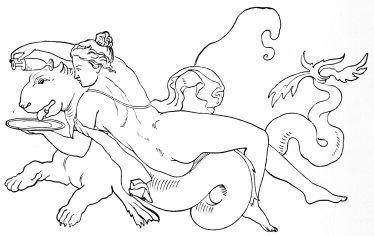
Fig. 308.—Wall-painting from Herculaneum.
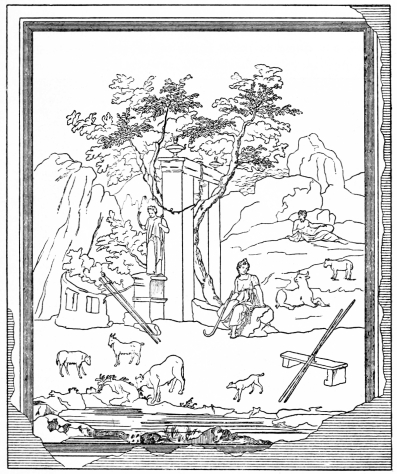
Fig. 309.—Landscape-painting from Pompeii.
The case was similar with architectural ornamentation, another branch of Roman decorative painting, generally known under the name of the Pompeian style. (Fig. 310.) Even in the time of Augustus, Vitruvius complains of a blind seeking after scenic effect, which, in disdain of all constructive laws, and in a manner quite impossible, piled heavy gables and upper stories upon reed-like columns of no supporting power. His blame, however, seems unjustifiable. That architectural painting which aims at illusion should be condemned as worthless; but this is not the case with that which,{469} after the analogy of conventional landscape-painting, renounces all semblance of reality and assiduously avoids all illusion. Spaces may be apparently extended by an architectural painting which, not deceptively, but poetically, opens the narrow walls of small rooms, and carries the eye dreamily through a wide perspective. Hence the fresh and by no means realistic colors, which, tapestry-like, are not intended to deceive, but to ornament and please. They bear witness{470} to the deep feeling for polychromy, inherited from Hellenic, or at least Hellenistic, predecessors, which was characteristic of the Romans even after their decline. What delight must there have been in a work so extended, and yet free from all slavish copying! Not only Amulius, who, by compulsion, painted the Golden House of Nero, and was celebrated by Pliny for his valuable and finely colored pictures, but countless other artists were everywhere busily employed in covering the walls with paintings and ornaments—a work now intrusted to common decorators. In the time of Nero the activity in ornamental painting, judged by the discoveries among the ruined cities of Campania, must have been greater than has ever been known at any other period.
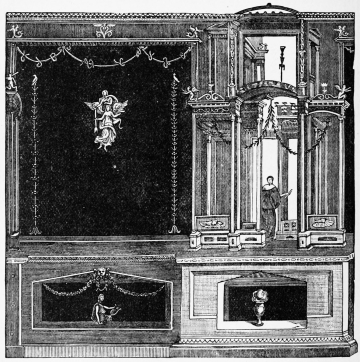
Fig. 310.—Wall-painting of Decorative Architecture,
Pompeii.
In the consideration of Hellenic painting, mention has been made of the origin of floor-decorations in mosaic by Sosos at the{471} royal court of Pergamon. By this is only meant mosaic painting with illusory effects, as practised by him; imitations of tapestry patterns and merely ornamental mosaic-work must have been older. His drinking-doves in the “unswept hall” appear to have continued a favorite subject, judging from three well-known imitations; one of which, found upon the Aventine, now in the Museum of the Lateran, bears the inscription of the artist Heraclitos. Though the names of other workers in mosaic are known, they as little deserve mention here as do the numerous vase-painters, their mosaic being almost wholly a technical process; its very laboriousness rendered a truly artistic activity almost impossible. Unfortunately, no name is attached to the most important work of this kind, over four meters long and two wide, apparently representing an Alexandrian battle-scene. This is also the best-preserved historical painting of antiquity, but it is related rather to the Grecian types than to the Roman battle-pieces above mentioned. The greater part of the well-known mosaics, being from Herculaneum and Pompeii, may be referred to the time of Nero; but those of Præneste with the Egyptianized conventional landscapes may date back to the time of Sulla, while the extensive example with figures of athletes from the Baths of Caracalla—now in the Lateran—belongs to the time of that emperor. Many others, however, especially those discovered in the distant provinces, are of later times. Vigorous as are some of the representations of landscapes and of animals among them, it is not to be denied that, as Semper says, mosaic oversteps its boundary in going beyond the patterns of woven tapestry, and trying to make us forget that it is outstretched like a level floor upon which we would walk without hindrance.
“It would be difficult, connectedly, to pursue the history of ancient painting later than the eruption of Vesuvius, which, in the year 79 A.D., by a wonderful fortune, preserved for the later world the artistic treasures of three cities of Campania—Herculaneum, Pompeii, and Stabiæ—and, at the same time, cost the life of Pliny, whom we have to thank for the greatest completeness of written description.” Thus Brunn rightly concludes his “History of the Grecian Painters,” for the works of succeeding generations, even when names of artists are attached, do not deserve to be called art,{472} being nothing more than hasty and crude decorations; such, for example, are the servants’ rooms in the Vigna Nussiner, upon the southern slope of the Palatine, which, in recent times, have acquired some celebrity by the careless scratches of the slaves found upon their walls. The most important illustrations that have been preserved of the shallowness and roughness of this lingering art are in the tombs; and with these in painting, with the basilica in architecture, and the sarcophagi in sculpture, the boundaries of the antique and of the Christian era flow into each other, and are scarcely distinguishable. When Christianity arose from the sepulchre, it allied itself in monumental art to that stage of debasement which painting had reached in the heathen and the Christian catacombs of the fourth century; indeed, art continued still to decline through ages, until the Northern races and the life of the common people breathed into it the spirit of a new life.{473}
A, B, C, D, E, F, G, H, I, L, M, N, O, P, Q, R, S, T, V, X, Z
IT has been the translator’s endeavor to avoid technical terms wherever this was possible without detracting from exactness of expression. Of those which it has proved necessary to introduce into the present History, it is intended in this glossary to define neither words in common usage, like basilica, battlement, column, etc., nor those designations of infrequent occurrence which should be interpreted whenever employed, like the Greek and Latin names of the many divisions of the ancient theatre, bath, and gymnasion. A few of the former—as, for instance, the too often interchanged channel, flute, and reed—have, however, been given for the sake of discrimination. In these cases, and in the case of some other words which are often employed in senses too widely extended to allow of their being used without qualification in careful architectural descriptions, it has been attempted to make some advance towards precision of usage.
Ab´acus (Gr. ἄβαξ-ακος. Lat. abax and abacus, a slab. Possibly in its architectural signification from βαστάζω, to lift up, to bear). The plinth which forms the upper part of the capital—supporting the entablature by bearing the lower surface of the epistyle beam. The abacus is the crowning member of the capital, as the capital is of the column. In the Doric style it is thick and of square plan, in the Corinthian order thin and curved upon the sides.
Acrote´rion, pl. acroteria (Gr. from ἄκρος, outermost). The ornaments, such as statues or anthemion shields, placed upon the angles of the gable—whether of the outer corners or of the apex. The term is also applied to the pedestals of these ornaments.
Ag´onal, adj. (from Gr. ἀγών, festive gathering, especially an assembly met to see games; also the place of contest itself). Pertaining to a festive destination. The word agones is used for the arena itself by Grote. (For the hypothetical distinction between agonal temples and those consecrated alone to the worship of a deity, introduced by Boetticher, see p. 214.)
Ag´ora (Gr. an assemblage of the people; hence, the place where such meetings were commonly held). A public square or marketplace. Synonymous with the more familiar Latin forum.
Amphiprosty´los, adj. amphip´rostyle (from Gr. ἀμφί, on both sides; πρό, in front of; and στῦλος, column). A term applied to a temple having a columned portico at the rear (epinaos), as well as at the front (pronaos), but without lateral columns.
An´nulet (Lat. annulus, or, according to the best manuscripts, anulus, ring, terminated by Ital. diminutive). A small fillet encircling the base of the Doric echinos. The number of annulets is commonly three.
An´ta, pl. antæ (Lat.). Terminations similar to pilasters upon the ends of the lateral walls of the cella, in pronaos and epinaos. Though a corresponding member, the anta is in form but little allied to the column, because its individual function is so different.
An´tefix (from Lat. ante, before, and fixus, fixed). An upright ornament like a small shield, placed above the corona when the gutter is omitted, to hide the end of the jointing tile ridge.
Anthe´mion (Gr. patterned with flowers, from ἀνθέω, to blossom). The so-called palmetto or honeysuckle ornament, employed on{474} acroteria and antefixes, and also as a continuous decoration on bands, gutters, etc., and the necking of some Ionic capitals.
In an´tis (Lat.). The simplest variety of temple plan, so called by Vitruvius because the pronaos or portico is formed by the projection of the side walls, terminated by antæ, between which stand columns.
Apoph´yge (Gr. escape; from ἀπό, from, and φεύγω, to flee. In its technical employment, of the same significance as the Fr. congé and Ger. Ablauf). The hollow, or scotia, beneath the Doric echinos, the juncture between shaft and capital, occurring in archaic examples of the style, and relinquished with its advance.
Ar´ris (Lat. arista, beard of an ear of grain, bone of a fish. Old Fr. areste). The sharp edge formed by two surfaces meeting at an exterior angle. Particularly the ridge between the hollows of Doric channellings.
As´tragal (Gr. ἀστράγαλος, knuckle-bone, one of the vertebræ of the neck, the bone of the ankle-joint). A roundlet moulding carved into the form of beads; employed on the Ionic capital, and to separate the projecting faces of the epistyle and coffering beams.
Atlas, pl. Atlan´tes (Gr. the fabled upholder of the heavens). Figures of male human beings, generally of colossal size, carved either in the full or half round, and employed in the place of columns or pilasters to support an entablature.
A´trium (Lat.; from Gr. αἰθρία, open sky?). The chief space of the Roman dwelling-house; an inner court usually surrounded by columns.
At´tica (from Gr. ἀττικός, pertaining to Attica). The upright portion of a building above the main cornice.
Bar´biton (Gr.). An ancient Greek musical instrument of many strings, resembling a lyre.
Caryat´id, pl. caryat´ides (Gr. pl. priestesses of Artemis at Caryæ in Laconia, the connection of which with the architectural support has not as yet been satisfactorily explained). Figures of female human beings employed in the place of columns to support an entablature.
Cel´la (Lat.; from celare, to hide). All that portion of the temple structure within the walls. The term cella is comprehensive, including pronaos, naos, and, if such there be, opisthodomos and epinaos.
Cham´fer (Fr. chamfrein, Old Engl. chanfer). A slope or small splay formed by cutting off the edges of an angle.
Chan´nel (a modification of canal, from Lat. canna, reed). A curved furrow, immediately adjoining its repetition, and separated from it only by an arris, as in the Doric column.
Chorag´ic (Gr. χοραγικός or χορηγικός, from χορός, chorus, and ἄγω, to lead). Pertaining to, or in honor of, a choregos, i. e. one who superintended a musical or theatrical entertainment among the Greeks, and provided a chorus at his own expense.
Chryselephan´tine (Gr. χρυσελεφάντινος, from χρυσός, gold, and ἔλεφας, ivory). A kind of sculpture in gold and ivory overlaying a wooden kernel—the drapery and ornaments being of the former, the exposed flesh of the latter, material.
Clere´-story (Fr. clair-étage, claire-voie, from clair, light). That portion of a central aisle which is so raised above the surrounding parts of the building as to permit the illumination of the interior through windows in its side walls.
Coilanaglyph´ic (from Gr. κοίλος, hollow, and γλυφή, carving). That species of carving in relief in which no part of the figure represented projects beyond the surrounding plane, the relief being effected by deeply incising the outlines.
Cor´nice (Gr. κορωνίς, Lat. coronis, terminating curved line; flourish with the pen at the end of a book). The uppermost division of the entablature—the representative of the roof—consisting of projecting mouldings and blocks, usually divisible into bed-moulding, corona, and gutter. Hence, in general usage, any moulded projection which crowns and terminates the part upon which it is employed.
Coro´na (Lat. crown). The chief member of the cornice, directly beneath the gutter, by its great projection and rectilinear faces forming the drip.
Crepido´ma (Gr. from κρηπίς-ιδος, boot). The entire foundation of the temple, including the stereobate, the stylobate, and the remaining steps.
Cy´ma (Gr. wave). A moulding composed of two distinct curves. The Doric cyma is commonly called the beak-moulding, the Lesbian cyma the cyma reversa.{475}
Den´til (Lat. denticulus, from dens, dentis, tooth). Small rectangular blocks in the bed-moulding of a cornice, originally representing the ends of the slats which formed the ceiling.
Diad´ochi (Gr. successors, from διαδέχομαι, to receive from another), a term applied to the successors of Alexander.
Diminution. In architectural usage, the continued contraction of the diameter of the shaft as it ascends.
Dip´teros, adj. dip´teral (from Gr. δίς, double, and πτερόν, wing). That variety of a temple plan which has two ranges of columns entirely surrounding the cella.
Dro´mos (Gr. course). A road; particularly applied to the entrance-passages to subterranean treasure-houses.
Echi´nos, pl. echi´ni (Gr. hedgehog, so called from the resemblance of the member to the shell of the sea-urchin). The curved and projecting moulding which supports the abacus in the Doric capital.
Egg-and-dart moulding. Term applied to the well-known carving of the roundel common in the Ionic style.
Empais´tic (Gr. ἐμπαιστική; from ἐν, in, and παίω, to stamp). Stamped and embossed work of metal; also sheets of metal applied or inlaid.
Entab´lature (Lat. intabulamentum; from tabula, board, table). In the Greek styles the whole of the structure above the columns, excepting the gable. The entablature consists of three members: the epistyle, or architrave, joining the columns and taking the place of the wall; the frieze, standing before, and in the Doric style imitating, the ceiling and its beams; and the terminal cornice, the representative of the ends of the roof rafters.
En´tasis (Gr.; from ἐντείνω, to bend a bow). The swelling of the column towards its middle, the object of which is to counteract an optical delusion causing the diminished shaft, when formed with absolutely straight lines, to appear hollowed in the centre.
Epina´os (formed by analogy with pronaos; from Gr. ἐπί, after, behind, and ναός, naos). The open vestibule behind the naos.
Ep´istyle (Gr. ἐπιστύλιον; from ἐπί, after, upon, and στῦλος, column). The lower member of the entablature, the representative of the wall, consisting, as the name imports, of beams laid horizontally upon the capitals of the columns. The epistyle is commonly spoken of by its Roman name, architrave.
Fascine´ (Lat. fascina; from fascis, bundle). A bundle of long, thin sticks employed in military engineering for filling ditches, raising parapets, etc.
Fil´let (Fr. filet, thread; from Lat. filum). A ribbon; a narrow, flat band used in the separation of one moulding from another. Especially the ridge between the flutes of the Ionic shaft.
Flute. In architectural usage, a curved and usually semicircular furrow, separated from its repetition by a narrow fillet, as in the Ionic column. So called from its similarity to the musical instrument.
Frieze (Ital. freggio, adorned?). The second member of the entablature. When enriched by carvings of men or animals in relief, as is common in the Ionic style, and as occurs upon the cella wall of the Doric Parthenon, the frieze is in classic architecture called zophoros.
Gar´goyle (Fr. gargouille; from gargouiller, to dabble, to paddle). A carved waterspout projecting from the gutter.
Gymna´sion (Gr.; from γυμνός, naked). Originally an open space, but in later times extensive courts and buildings, devoted to mental as well as bodily instruction and exercises.
He´lix, pl. hel´ices (Gr. anything twisted or spiral; from ἑλίσσω, to turn around). A spiral, particularly the volutes of the Ionic capital and the corner leaves and tendrils of the Corinthian.
Hexasty´los, adj. hex´astyle (from Gr. ἕξ, six, and στῦλος, column). A building, particularly a temple, upon the front of which are six columns.
Hip´podrome (Gr. ἱππόδρομος; from ἵππος, horse, and δρόμος, way). A course prepared for the races of horses and chariots.
Hypæ´thron, adj. hypæ´thral (Lat. hypæthrus; from Gr. ὑπό, under, and αἰθήρ, clear sky). Term applied to a temple supposed by some writers on Greek architecture to have been lighted from above, by an orifice through roof and ceiling.
Hyper´oön (Gr.). The upper stories of a house; particularly the galleries above the side-aisles in the interior of the Greek temple.{476}
Hyp´ostyle (Gr. ὑπόστυλον; from ὑπό, under, and στῦλος, column). A space, with or without lateral enclosure, the ceiling of which rests upon columns.
Inci´sion. In architectural usage, the deep groove which separates the necking of the column from the upper drum of the shaft beneath. At times repeated to emphasize this separation.
Intercolumnia´tion (from Lat. inter, between, and columna, column). The open space between two columns, measured at the base. The measures are often taken from centre to centre of the columns.
Lacu´na, pl. lacunæ (Lat.; from Gr. λάκος, pit, originally anything hollow). A sunken panel in the under surface of any constructive feature, particularly of a horizontal ceiling.
Log´gia (Ital.; from Lat. locus, place). A covered space enclosed by walls, but with one or, in exceptional instances, two sides entirely open to the air.
Lychni´tes (Gr. λυχνίτης λίθος; from λύχνος, light). A variety of fine-grained marble from the island of Paros, probably so called because quarried by torchlight.
Met´ope (Gr.; from μετά, between, and ὀπή, opening). Originally the orifice between the beam-ends of the Doric ceiling; hence, in later times, the stones which were employed to close these openings. The nearly square slabs between the triglyphs.
Monop´teros (from Gr. μόνος, alone, single, and πτερόν, wing). A circular structure of outstanding columns, commonly without a cella enclosed by walls.
Mu´tule (Lat. mutulus). A projection upon the soffit of the Doric corona, which originally marked the position of the rafter-ends beneath the sheathing.
Na´os (Gr.). The innermost chamber of the Greek temple.
Neck´ing. In architectural usage, the space, if such be separated, between the top of the shaft and the projecting members of the capital. In the Doric style, for instance, the continuation of the channellings above the incision or incisions to the annulets of the echinos, including the hypophyge, when this occurs.
Octosty´los, adj. oc´tostyle (from Gr. ὀκτώ, eight, and στῦλος, column). A building, particularly a temple, upon the front of which are eight columns.
Odei´on (Gr.; from ᾠδή, song). A hall, similar to a modern theatre, devoted to the production of the lyric works of poets and musicians.
Ogive´ (Fr.). The pointed arch.
Opisthod´omos (Gr. from ὄπισθε, behind, and δόμος, house). An enclosed chamber in a temple, entered from the epinaos, commonly employed to contain the treasure of the temple or of the state.
Palais´tra (Gr.; from παλαιστής, wrestler). A building or enclosure devoted to wrestling, boxing, and kindred gymnastic exercises; commonly, also, containing baths.
Perip´teros, adj. perip´teral (Gr.; from περί, around, and πτερόν, wing). A temple entirely surrounded by columns.
Per´istyle, noun and adj. (from Gr. περί, around, and στῦλος, column). A term applied to a secular building, or a court, which is entirely or for the greater part surrounded by a colonnade.
Pisé (Fr.; from piser, to build with stamped clay). A species of tenacious clayey earth, employed for walls and pavement by being rammed down.
Plinth (Lat. plinthus, from Gr. πλίνθος, tile). Any rectangular and projecting member of considerable size. A narrow and long plinth is a fillet.
Po´ros (Gr.). A light, coarse tufa-limestone almost exclusively employed during the earliest ages of Greek architecture.
Prona´os (Gr.; from πρό, before, and ναός). The open vestibule before the naos.
Propylæ´on, pl. propylæ´a (Gr.; from πρό, before, and πύλη, gate). The portal structure before the entrance to a Greek temenos.
Prosty´los, adj. pro´style (from Gr. πρό, before, and στῦλος, column). That variety of temple plan in which the projecting wall and pilasters of the temple in antis have been transformed to corner columns, thus altering the pronaos from a loggia to an open portico.
Pseudodip´teros (pseudo from Gr. ψευδής, false; dipteros, see above). A temple planned upon the dipteral arrangement, in which the inner rank of columns surrounding the cella is wanting.
Pseudoperip´teros (pseudo from Gr. ψευδής, false; peripteros, see above). A temple{477} in which the columns surrounding the cella are engaged upon a continuous enclosure wall, as in the great temple of Acragas (Agrigentum).
Ptero´ma (Gr.; from πτερόν, wing). The passage surrounding the cella of a peripteral temple.
Py´lon (Gr.; from πύλη, gate). The towers of truncated pyramidal form on either side of the gateways of Egyptian temples.
Quirk. In architectural usage, a moulding formed by a sharp turn in a continuous line.
Reed. In architectural usage, a small convex moulding applied to a regular surface and frequently repeated. The term is commonly employed for the ornamentation of columns by reversed channels or flutes.
Reg´ula (Lat. any straight piece of wood, a ruler). The short band, corresponding to the triglyph, beneath the tænia moulding which crowns the epistyle; the listel. Originally determined by the slat of wood which strengthened the wall-plate at the point of its perforation by the trunnels.
Revet´ment, vb. to revete (Fr. revêtement, from revêtir, to clothe). A facing of metal, stone, or wood encasing a kernel—usually of some less firm or sightly material.
Round´el, dim. roundlet. A moulding of semicircular profile.
Scamil´lus (Lat. little bench, foot-stool). A slight projection, cut by means of a joggle, upon a constructive feature in such a manner as to prevent its adjacent edges from touching and possibly chipping those of the next block. A scamillus thus creates the incision between the upper drum of the shaft and the necking of the Doric capital, and is also occasionally inserted between the top of the abacus and the soffit of the epistyle.
Sco´tia (Gr. darkness). A hollow curved moulding, so called from the deep line of shadow which it casts.
Soc´le (Lat. socculus, dim. of soccus, low shoe, slipper). The low, plain foundation of a pedestal or building.
Sof´fit (Ital. soffitta; from Lat. suffigere, to fasten beneath). The under side of any part of a building, particularly of lintels, epistyles, and coronas.
Sphyrel´aton (Gr.; from σφῦρα, hammer, and ἐλαύνω, to drive). Metal-work beaten to the shape of a carved kernel by a hammer.
Spi´na (Lat.; from Gr. σπινός, lean, thin). The barrier dividing the race-course longitudinally into two tracks.
Sta´dion (Gr.; from στάδιος, standing firm). A race-course of fixed dimensions, whence a measure of length, 600 Greek feet.
Ste´le (Gr.). An upright stone employed as a monument.
Ste´reobate (Gr. στερεοβάτης; from στερεός, firm, solid, and βάσις, base). The substructure of rough masonry beneath a temple.
Sto´a (Gr.). An extended colonnade, usually adjoining a public place, and affording protection against the heat of the sun.
Sty´lobate (Gr. στυλοβάτης; from στῦλος, column, and βαστάζω, to light up, support). The uppermost step of the peripteros, which forms a continuous base beneath the columns.
Tæ´nia (Gr. ribbon). The continuous fillet which crowns the epistyle, representative of the wall-plate of the original timbered Doric construction.
Ta´lus (Lat. ankle). The slope or angle of inclination of the sides of a wall.
Taraxip´pos (Gr. adj. frightening the horses). An altar upon the turning-point of the Greek race-course.
Tel´amon (Gr. bearer). In architectural usage of the same significance as Atlas, which see above.
Tem´enos (Gr.; from τέμνω, to cut, to draw a line). A piece of land marked off from common usages and dedicated to a deity. The sacred enclosure around the temple.
Tetrasty´los, adj. tet´rastyle (from Gr. τέτρα, four, and στῦλος, column). A building, particularly a temple, upon the front of which are four columns.
Thal´amos (Gr.). Term applied by Homer to inner rooms or chambers, especially those of women. In the usage of Xenophon a store-room.
Tho´los (Gr.). A chamber of circular plan, generally subterranean, approaching in interior form that of a pointed vault.
Tore (Lat. torus, swelling, protuberance). A large roundel moulding.
Trac´ery. A patterning of thin bars, usually of stone, in a window or other opening.
Tri´glyph (Gr. τρίγλυφος; from τρί, three,{478} and γλυφή, carving, because of the three slats originally chamfered). The most prominent member of the Doric frieze, originally significant of the ends of the ceiling beams. A rectangular tablet slightly projecting beyond the face of the metopes, with which it alternates, and emphasized by vertical grooves and chamfers.
Trun´nel (allied etymologically to tree-nail and trunnion). A wooden pin or peg. Carved in stone beneath the regulas and mutules of the Doric entablature, the trunnels mark the position of these primitive constructive features. In form they are commonly the frustum of a cone.
Tym´panon (Gr. drum). The triangular space enclosed by the inclined mouldings of the gable and the horizontal cornice of the entablature beneath.
Vela´rium (Lat.). The great curtain, or awning, extended above the auditories of the Roman theatre and amphitheatre to protect the spectators from the sun and rain.
Volute´ (Lat. voluta; from volvere, to roll). A spiral scroll. The term is particularly employed for such features in the Ionic and Corinthian capitals.
Xo´anon, pl. xoana (Gr.; from ξέω, to work in wood by scraping). A rude and primitive image carved in wood; particularly antique statues of the deities.
Zoph´oros (Gr.; from ζῶον, being, figure, and φέρω, to bear). A continuous frieze, sculptured in relief with the forms of human beings and animals.{479}
(The names of places are in common print, those of artists in italics.)
A, B, C, D, E, F, G, H, I, J, K, L, M, N, O, P, R, S, T, U, V, W, X, Z
Abou-Roash, 12.
Abousere, 3, 11.
Abou-Sharein, 50-52, 54.
Achermos, 280.
Ackercuf, 50.
Acragas, 219, 220, 222, 253.
Ægina, 222, 224, 282, 293-296, 298, 303.
Æsernia, 414.
Aetion, 384.
Agasias, 361, 362.
Agatharchos, 370.
Ageladas, 299, 304.
Agesandros, 351.
Aglaophon, 368.
Agoracritos, 316, 317.
Agrae, 257.
Agrigentum. See Acragas.
Aizanis, 260.
Alabanda, 260.
Alatrium (Alatri), 414, 416.
Albanum (Albano), 390, 436, 437.
Alcamenes, 317-319.
Alcantara, 439.
Alexandria, 256, 261, 346, 438.
Alexandros, 338.
Algiers, 185.
Alopeke, 322.
Alsium, 399.
Alxenor, 290.
Alyzia, 343.
Ambrakia, 281, 346.
Amphicrates, 297.
Amphipolis, 375.
Amphissa, 279.
Amran-ibn-Ali, 57.
Amrith, 133, 135-137, 141, 149.
Amulius, 470.
Amyclæ, 179, 184, 276, 277.
Amyclaios, 299.
Ancona, 439.
Ancyra, 438.
Androsthenes, 318.
Angelion, 286.
Antaradus, 133.
Antenor, 297, 298.
Antigonos, 347.
Antioch, 261, 346.
Antiochos, 363.
Antiochos Gabinius, 466.
Antiphillos, 166, 168.
Antiphilos, 384, 386.
Antium, 414.
Aosta, 439.
Apelles, 379-382.
Aphrodisias, 240, 257, 366, 436.
Apiolæ, 414.
Apollodoros, sculptor, 360;
painter, 370.
Apollonios, 353, 362, 363.
Aradus, 133.
Arbola, 62.
Ardea, 414.
Archias, 262.
Archimedes, 262.
Arellius, 466.
Argos, 186, 276, 281, 282, 298, 299, 303.
Aricia, 291, 414.
Aridikes, 367.
Aristeas, 366.
Aristiæos, 377.
Aristides, 377.
Aristocles, 287, 298, 299.
Aristogeiton, 327.
Aristolaos, 376.
Aristomedon, 299.
Aristomedos, 299.
Aristophon, 370.
Arkesilaos, 366.
Arpinum, 414.
Arrhachion, 289.
Asclepiodoros, 380, 384.
Asoka, 132.
Aspendos, 433.
Assos, 216, 286, 288.
Assur, 62.
Athanadoros, 351.
Athenis, 280, 281, 291, 365.
Athens, 191, 221-227, 241-245, 248, 249, 253, 260, 276, 289, 293, 298, 303, 346, 377, 378.
Aufidena, 414.
Aurunca, 414.
Babil, 58.
Babylon, 50, 53, 58, 59, 81, 82.
Bagdad, 57.
Balaneia, 133.
Baphio, 184.
Bara, 439.
Bassæ, 227, 236, 241, 247, 249.
Bathycles, 277.
Beni-hassan, 14-18.
Besançon, 439.
Beyrout, 133.
Biban-el-Moluk, 22.
Bi-Sueton, 128.
Boghaz-kieni, 173.
Boidas, 344.
Bolymnos, 199.
Bors-Nimrud, 57-59.
Borsippa, 55-57.
Boulac, 41.
Boutades, 278.
Boupalos, 281, 291, 365.
Bovillæ, 431.
Bryaxis, 251, 333.
Byblus, 133, 148.
Byrsa, 162.
Cadacchio, 216.
Ca-dimirra, 53.
Cære, 391, 392, 406, 409.
Cairo, 4.
Calah, 61, 62.
Calamis, 293, 299, 301, 318.
Calates, 386.
Callicles, 386.
Callimachos, 246, 322, 386.
Calliphon, 370.
Calliteles, 295.{480}
Callon, 286, 293, 299.
Calydon, 191.
Canachos, 286, 298.
Caparra, 439.
Capua, 339, 359.
Carnac, 24-28.
Carnek, 133.
Carpentras, 439.
Carthage, 139, 159, 162.
Casr, 57.
Castel d’Asso, 394.
Caunos, 383.
Cavaillon, 439.
Cervetri, 392, 394.
Chares, 344, 351.
Charmides, 304.
Chersiphron, 238.
Chionis, 299.
Chios, 279-281.
Chiusi, 390, 401, 403, 411.
Circello, 416.
Cirta, 253.
Claros, 240.
Cleanthes, 367.
Clearchos, 282.
Cleomenes, 363.
Cleonæ, 281, 367.
Clitias, 277, 464.
Clusium, 390, 408.
Cnidos, 239, 248, 260, 334.
Cochome, 3.
Colophon, 240.
Colotes, 317.
Constantina, 253, 436.
Constantinople, 438.
Coponius, 452.
Cora, 414.
Corfu, 216.
Corinth, 218, 278, 289, 298, 299.
Corkyra. See Corfu.
Corneto, 392, 398.
Corsabad, 60, 66, 73, 76, 78, 79, 280.
Cos, 334.
Cossutius, 249.
Coyundjic, 60, 61, 66, 68, 70, 74-76, 78.
Craton, 367.
Cresilas, 321.
Crete, 160, 170, 266.
Critios, 297.
Ctesiphon, 58, 131.
Cures, 414.
Cussi, 438, 439.
Cyprus, 96, 139, 150, 159, 162, 267, 321.
Dactylæ, 266.
Daidalos, 267, 268.
Damophilos, 449, 464.
Damophon, 327.
Daphnis, 238.
Darabgerd, 118.
Dashour, 3, 10, 11.
Deinocrates, 261, 344.
Delos, 191, 193, 229, 260, 280.
Demetrios, 322.
Dionysios, 299, 363, 370, 466.
Diopos, 401.
Dipoinos, 281, 282, 298.
Dium, 342.
Diyllos, 299.
Dodona, 192.
Dontas, 282.
Donycleidas, 282.
Dur-Sargina, 60.
Ecetræ, 414.
Ecphantos, 367.
Elateia, 363.
El-Cab, 30.
El-Casr, 439.
Eleusis, 228.
Eleutheræ, 299.
Elis, 222, 254, 299.
Endoios, 297, 365.
Enhydra, 133.
Ephesos, 237, 256, 279, 361, 371, 375.
Epidauros, 186, 260.
Erbil, 62.
Erech, 50.
Ergotimos, 277, 464.
Eubœa, 193.
Eucheir, 401.
Eugrammos, 401.
Eumaros, 367.
Eupalamos, 267.
Euphranor, 340, 377, 378.
Eupompos, 375.
Euthycrates, 344.
Eutychides, 344.
Eyuk, 173.
Fabius Pictor, 464.
Falerii, 388, 389.
Fanum, 442.
Fayoum, 4, 34, 35.
Ferentinum, 414.
Firuz-Abad, 118, 131.
Florence, 227.
Gabr-Hiram, 133.
Gineh, 141.
Girsheh, 30.
Gitiades, 299.
Gizeh, 3, 4-6, 13, 17, 42.
Glanum, 253.
Glaucos, 279, 299.
Glycon, 343, 362.
Gorgasos, 449, 464.
Goshen, 143.
Gozo, 163.
Halicarnassos, 250-252.
Haram-el-Sherif, 147.
Hegias, 297, 304.
Hegylos, 282.
Heraclea, 371.
Heraclitos, 471.
Herculaneum, 436, 471.
Hermogenes, 240.
Hierapolis, 256.
Hillah, 57.
Hit, 49.
Hovara, 12.
Huram, 148.
Hypatodoros, 327.
Iaia, 466.
Icmalios, 269.
Ictinos, 225.
Illahoun, 12.
Illecles, 238.
Isogonos, 347.
Istakr, 100.
Ithaca, 177, 178, 184.
Jebeil, 133, 136, 138.
Jerusalem, 139, 147-157.
Jumjuma, 57.
Kalwadha, 50.
Kenchreæ, 186.
Kephisodotos: the elder, 329;
the younger, 338.
Kileh-Shergat, 75.
Kimon, 367.
Kisr-Sargon, 57, 60, 62-66, 73, 79, 152.
Kiutahija, 171.
Kypselos, 276.
Kyrene, 185.
Kythnos, 374.
Kyzicos, 261.
Lacedæmonia, 282.
Laconia, 187.
Laia, 466.
Laodikeia, 260.
Latium, 416.
Lavinium, 414.
Lemnos, 305, 317.
Leochares, 251, 331, 333.
Lessa, 187.
Libon, 222.
Lindos, 344.
Lisht, 12.
Ludius, 467.
Luxor, 24, 25.
Lykios, 320.
Lysippos, 341, 345, 450, 453.
Lysistratos, 342.
Magnesia, 240, 272, 277.
Malta, 163.
Mantinea, 243, 260.
Marathus, 133, 135.
Marseilles. See Massalia.
Mashnaka, 135, 141, 142, 150.
Massalia, 449.
Medinet-Abou, 25, 34.
Medinet-el-Fayoum, 24.
Medullia, 414.{481}
Megalopolis, 260.
Megara, 287.
Melanthios, 376, 380.
Melas, 280.
Melos, 260.
Memphis, 3, 5, 12, 42.
Mende, 317.
Menelaos, 364.
Menidi, 179, 183.
Merida, 439.
Meroe, 12.
Messene, 327, 357.
Metagenes, 238.
Metapontion, 216, 217.
Metrodoros, 465, 466.
Meydoun, 10, 12.
Mickiades, 280.
Micon, 368, 369.
Miletos, 238, 247, 285, 288, 298.
Mnesicles, 226.
Mœris, 10.
Moriah, 147.
Mosul, 59, 60.
Mt. Barkal, 12.
Mt. Ocha, 193, 194.
Mudjelibeh, 57, 58, 83.
Mugheir, 50, 52, 54, 80.
Murgab, 100, 119.
Mykenæ, 179-185, 188, 189, 192, 198, 273-276, 280.
Mylassa, 250.
Myra, 165, 167, 260.
Myron, 299, 301, 303, 320.
Mys, 305.
Naksh-i-Rustam, 120, 121.
Naxos, 288, 290.
Nebbi-Jonas, 61.
Nemea, 211.
Nesiotes, 297.
Nicomachos, 377.
Nicomedia, 346.
Nicophanes, 376.
Nicopolis, 375.
Niffer, 50.
Nikias, 378.
Nimrud, 57-60, 66, 67, 69, 71, 75, 77, 78, 85, 87.
Nineveh, 53, 59, 61, 62, 80, 84, 95, 140.
Nipur, 50, 53.
Norba, 414, 415.
Norchia, 394-397.
Norma, 414.
Novius Plautius, 450.
Nubia, 12, 40.
Nus, 14.
Olevano, 414, 416.
Olympia, 209, 222, 223, 258, 276, 278, 282, 307, 308, 317, 319, 335, 336, 386.
Onatas, 293, 295, 297.
Orange, 433, 439.
Orchomenos, 179, 184, 287, 288.
Ortygia, 218, 221.
Otricoli, 309.
Ovius, 451.
Pacuvius, 465.
Pæstum, 206, 223, 229, 255.
Paionios, architect, 238.
Paionios, sculptor, 317, 319.
Palamaon, 268.
Palestrina, 450.
Palma, 291.
Paltus, 133.
Pamphilos, 375, 382.
Panainos, 368, 369.
Paphos, 160.
Papias, 366.
Paros, 317.
Parrhasios, 305, 371, 373, 374.
Pasargadæ, 100, 103, 118, 120, 123.
Pasiteles, 364.
Patara, 260.
Pausias, 376.
Pauson, 370.
Peiræicos, 386.
Pergamon, 261, 346-350, 353, 356, 358, 362.
Persepolis, 100-102, 107, 117, 120, 122, 123.
Perugia, 286, 400, 404.
Pessinus, 240.
Petra, 437, 438.
Pharsalos, 179.
Pheidias, 225, 299, 304-322.
Phellos, 167.
Pheneos, 185.
Phigalia, 190, 227, 287, 321.
Philæ, 30, 47, 105, 135.
Phileas, 279.
Philocles, 367.
Phokis, 363.
Phycomachos, 347.
Piraios, 255.
Plataia, 305, 368.
Pola, 436.
Politorium, 414.
Polycleitos, 299, 323, 328.
Polycles, 363.
Polydoros, 351.
Polygnotos, 254, 368-370, 383.
Pompeii, 436, 442, 444, 468, 471.
Præneste, 414, 450, 471.
Praxias, 318.
Praxiteles, 300, 330, 332-336, 338, 340.
Priene, 238.
Protogenes, 383, 384.
Pythagoras, 299, 301.
Pythios, 238, 251.
Redesie, 30.
Reggio, 436.
Reson, 62.
Rhamnous, 228, 330.
Rhegion, 282, 299, 301, 303.
Rheims, 438.
Rhodes, 267, 344, 351, 353, 356, 358, 362, 363.
Rhoicos, 279.
Rimini, 439.
Ruad, 133, 148.
Saccara, 9.
Saida, 133, 138, 141, 149.
Saint-Remi, 253, 437, 439.
Samos, 141, 190, 238, 260, 280.
Sarbistan, 131, 171.
Sardinia, 163.
Sardis, 174.
Satricum, 414.
Satyros, 251.
Sauiet-el-Meytin, 16.
Saurias, 367.
Scaptia, 414.
Scopas, 251, 330-333.
Scythopolis, 148.
Segesta, 211, 222, 259, 260.
Segni, 414, 416.
Seid-el-Ar, 172.
Selamiyeh, 62.
Seleucia, 58, 131, 346.
Selinous, 216, 218, 222, 283, 288, 290, 327.
Serapion, 466.
Serpul-Zohab, 121.
Side, 260.
Sidon, 133, 138.
Signia, 414, 415.
Sikyon, 243, 276, 281, 282, 298, 299, 303, 322, 340, 375-378.
Silanion, 340, 341.
Siloam, 152.
Silsilis, 30.
Sipylos, 173, 272.
Sivrihissar, 171.
Skyllis, 281, 282, 298.
Smilis, 282.
Smyrna, 173.
Socrates, 299.
Soleb, 27.
Sopolis, 466.
Sora, 414.
Sosibios, 365.
Sosos, 386, 470.
Spalatro, 447.
Sparta, 183, 255, 260, 282, 287, 299.
Stabiæ, 471.
Stephanos, 364.
Stoura, 193.
Stratonicos, 347.
Studius, 467.
Styppax, 321.
Sunion, 228.
Sur, 133, 138.
Sura,{482} 50.
Susa, Italy, 439.
Susa, Persia, 100.
Sutri, 436.
Syracuse, 217, 260, 262.
Tak-i-Gero, 132.
Tarention, 242, 243, 249.
Tauriscos, 353.
Tauromenium, 260.
Tectaios, 286.
Telchinœ, 266.
Telecles, 260, 279.
Telenæ, 414.
Telephanes, 367.
Telmissos, 260.
Tel-Sifr, 50.
Tenea, 267, 287, 288.
Teos, 240.
Thabarieh, 146.
Thasos, 289, 368.
Thebes, Egypt, 22, 47.
Thebes, Greece, 191, 298, 299, 375, 377.
Theocles, 282.
Theodoros, 238, 260, 279, 280.
Theon, 386.
Thera, 287, 288.
Thespeia, 368.
Thessalonica, 255.
Theveste, 439.
Thoricos, 254.
Tibur, 414.
Timanthes, 374, 375.
Timarchides, 363.
Timarchos, 338.
Timocles, 363.
Timomachos, 385.
Timotheos, 251, 333.
Tiryns, 187, 188, 192.
Todi, 408.
Tortosa, 133.
Tourah, 11.
Tralles, 353.
Treves, 436.
Troezen, 199.
Troy, 185, 191, 267, 268.
Tusculum, 414, 433, 436.
Tyndaris, 260.
Tyre, 133, 138, 140.
Um-el-Auamid, 133, 138, 145.
Ur, 48, 50, 53, 80.
Veii, 388, 391, 401, 448.
Velabro, 416.
Venice, 450.
Verulæ, 414.
Viterbo, 394.
Volca (Vulcanius), 401, 448.
Volsinii, 405.
Volterra, 408.
Vulci, 390, 401, 406, 407.
Warka, 50, 52, 54, 80.
Xanthos, 167, 170, 252, 288, 339.
Xenaios, 261.
Zeuxis, 371-374.
VALUABLE AND INTERESTING WORKS
FOR
STUDENTS OF ANCIENT AND MODERN ART.
☞ Harper & Brothers will send any of the following works by mail, postage prepaid, to any part of the United States or Canada, on receipt of the price.
☞ For a full list of works published by Harper & Brothers, see Harper’s Enlarged Catalogue, 360 pp., 8vo, which will be sent by mail, postage prepaid, on receipt of Ten Cents.
History of Mediæval Art.
By Dr. Franz von Reber, Author of “A History of Ancient Art,” &c. Translated and Augmented by Joseph Thacher Clarke. Profusely Illustrated. 8vo, Cloth, $5 00.
History of Ancient Art.
By Dr. Franz von Reber, Director of the Bavarian Royal and State Galleries of Paintings, Professor in the University and Polytechnic of Munich. Revised by the Author, and Translated and Augmented by Joseph Thacher Clarke. With 308 Illustrations, and a Glossary of Technical Terms. 8vo, Cloth, $3 50.
Ilios.
Ilios, the City and Country of the Trojans. The results of Researches and Discoveries on the Site of Troy and throughout the Troad in the years 1871-’72-’73-’78-’79. Including an Autobiography of the Author. By Dr. Henry Schliemann, F.S.A. With a Preface, Appendices, and Notes by Professors Rudolf Virchow, Max Müller, A. H. Sayce, J. P. Mahaffy, H. Brugsch-Bev, P. Ascherson, M. A. Postolaccas, M. E. Burnouf, Mr. F. Calvert, and Mr. A. J. Duffield. With Illustrations representing nearly 2000 Types of the Objects found in the Excavations of the Seven Cities on the Site of Ilios. Maps, Plans, and Illustrations. Imperial 8vo, Cloth, $12 00; Half Morocco, $15 00.
Troja.
Troja. Results of the Latest Researches and Discoveries on the Site of Homer’s Troy, and in the Heroic Tumuli and other Sites, made in the year 1882, and a Narrative of a Journey in the Troad in 1881. By Dr. Henry Schliemann, F.S.A. Preface by Professor A. H. Sayce. With 150 Wood-cuts and 4 Maps and Plans. pp. xl., 434. 8vo, Cloth, $7 50; Half Morocco, $10 00.{484}
A History of Wood-Engraving.
By G. E. Woodberry. With Numerous Illustrations. 8vo, Cloth, $3 50.
South Kensington.
Travels in South Kensington. With Notes on Decorative Art and Architecture in England. By Moncure Daniel Conway. Illustrated. 8vo, Cloth, $2 50.
The Land and the Book.
By William M. Thomson, D.D. In Three Volumes. Copiously Illustrated. Square 8vo, Ornamental Cloth, $6 00; Sheep, $7 00; Half Morocco, $8 50; Full Morocco, Gilt Edges, $10 00 per Volume. (The Volumes sold separately.)
Vol. I. Southern Palestine and Jerusalem. (140 Illustrations and Maps.)
Vol. II. Central Palestine and Phœnicia. (130 Illustrations and Maps.)
Vol. III. Lebanon, Damascus, and Beyond Jordan. (147 Illustrations and Maps.)
Popular Edition, Copiously Illustrated, 3 vols., 8vo, Cloth, $9 00.
Cyprus: its Ancient Cities, Tombs, and Temples.
A Narrative of Researches and Excavations during Ten Years’ Residence in that Island. By General Louis Palma di Cesnola, Mem. of the Royal Academy of Sciences, Turin; Hon. Mem. of the Royal Society of Literature, London, &c. With Appendix, containing a Treatise on “The Rings and Gems in the Treasure of Kurium,” by C. W. King, M.A.; a “List of Engraved Gems found at Different Places in Cyprus;” a Treatise “On the Pottery of Cyprus,” by A. S. Murray; Lists of “Greek Inscriptions,” “Inscriptions in the Cypriote Character,” and “Inscriptions in the Phœnician Character.” With Portrait, Maps, and 400 Illustrations. Third Edition. 8vo, Cloth, Gilt Tops and Uncut Edges, $7 50.
Caricature and other Comic Art.
In all Times and Many Lands. By James Parton. With 203 Illustrations. 8vo, Cloth, Gilt Tops and Uncut Edges, $5 00.
Spanish Vistas.
By George Parsons Lathrop. Illustrated by Charles S. Reinhart. 8vo, Ornamental Cover, Gilt Edges, $3 00.{485}
Peru.
Incidents of Travel and Exploration in the Land of the Incas. By E. G. Squier, M.A., F.S.A., late U. S. Commissioner to Peru; Author of “The States of Central America,” “Nicaragua: its People, Scenery, Monuments, Resources, Condition, and Proposed Canal,” &c. With Map and 258 Illustrations. 8vo, Cloth, $5 00.
The Mikado’s Empire.
Book I. History of Japan, from 660 B.C. to 1872 A.D.—Book II. Personal Experiences, Observations, and Studies in Japan, 1870-1874. By Wm. Elliot Griffis, A.M., late of the Imperial University of Tōkiō, Japan. Fifth Edition, revised. Copiously Illustrated. 8vo, Cloth, $4 00; Half Calf, $6 25.
A Hand-Book of Pottery Painting.
By John C. L. Sparkes. 32mo, Paper, 20 cts.; Cloth, 35 cts.
Atlantis:
The Antediluvian World. By Ignatius Donnelly. Illustrated. 12mo, Cloth, $2 00.
Bible Lands:
Their Modern Customs and Manners Illustrative of Scripture. By the Rev. Henry J. Van-Lennep, D.D. Illustrated with upward of 350 Wood-engravings and Two Colored Maps. 8vo, Cloth, $5 00; Sheep, $6 00; Half Morocco, $8 00.
Ancient America,
In Notes on American Archæology. By John D. Baldwin, A.M. With Illustrations. 12mo, Cloth, $2 00.
Fresh Discoveries at Nineveh and Babylon.
Fresh Discoveries at Nineveh and Babylon; with Travels in Armenia, Kurdistan, and the Desert: being the Result of a Second Expedition undertaken for the Trustees of the British Museum. By Austen Henry Layard, M.P. With all the Maps and Illustrations in the English Edition. 8vo, Cloth, $4 00; Half Calf, $6 25.
From Egypt to Palestine,
Through Sinai, the Wilderness, and the South Country. By S. C. Bartlett, D.D., LL.D. Illustrated. 8vo, Cloth, $3 50.{486}
The North Americans of Antiquity.
Their Origin, Migrations, and Type of Civilization Considered. By John T. Short. Illustrated. 8vo, Cloth, $3 00.
The Ceramic Art:
A Compendium of the History and Manufacture of Pottery and Porcelain. By Jennie J. Young. Illustrated. 8vo, Cloth, $5 00.
The China Hunters Club.
By the Youngest Member. Illustrated. Post 8vo, Cloth, $1 75.
Art Education Applied to Industry.
By Geo. Ward Nichols. Illustrated. 8vo, Cloth, Illuminated and Gilt, $4 00.
Art Decoration Applied to Furniture.
By Harriet Prescott Spofford. With Illustrations. 8vo, Cloth, $4 00; Half Calf, $6 25.
Historical Studies of Church-Building
In the Middle Ages. Venice, Siena, Florence. By Charles Eliot Norton. 8vo, Cloth, $3 00.
Sketches and Studies in Southern Europe.
By John Addington Symonds. In Two Volumes. Post 8vo, Cloth, $4 00.
The Mythology of Greece and Rome,
With Special Reference to its Use in Art. From the German of O. Seemann. Edited by G. H. Bianchi, B.A., late Scholar of St. Peter’s College, Cambridge, Brotherton Sanskrit Prizeman, 1875. With 64 Illustrations. 16mo, Cloth, 60 cents.
The Student’s History of Greece.
A History of Greece, from the Earliest Times to the Roman Conquest. With Supplementary Chapters on the History of Literature and Art. By Wm. Smith, D.C.L., LL.D. Illustrated. 12mo, Cloth, $1 25.
The Student’s History of Rome.
A History of Rome, from the Earliest Times to the Establishment of the Empire. With Chapters on the History of Literature and Art. By H. G. Liddell, D.D., Dean of Christ Church, Oxford. Illustrated. 12mo, Cloth, $1 25.{487}
Carthage and Her Remains:
Being an Account of the Excavations and Researches on the Site of the Phœnician Metropolis, in Africa and other Adjacent Places. Conducted under the Auspices of Her Majesty’s Government. By Dr. N. Davis, F.R.G.S. Profusely Illustrated with Maps, Wood-cuts, Chromo-Lithographs, &c. 8vo, Cloth, $4 00; Half Calf, $6 25.
Art Hints.
Architecture, Sculpture, and Painting. By James Jackson Jarves. 12mo, Cloth, $1 50.
Lessons from My Masters:
Carlyle, Tennyson, and Ruskin. By Peter Bayne, M.A., LL.D., Author of “The Chief Actors in the Puritan Revolution,” “Life and Letters of Hugh Miller,” &c. 12mo, Cloth, $1 75.
She Stoops to Conquer; or, The Mistakes of a Night.
A Comedy. By Dr. Goldsmith. With Drawings by Edwin A. Abbey, Decorations by Alfred Parsons, and Introduction by Austin Dobson. Folio, Illuminated Calf, Gilt Edges (in a Handsome Box), $20 00.
Herrick’s Poems. Illustrated by Abbey.
Selections from the Poems of Robert Herrick. With Drawings by Edwin A. Abbey. pp. xviii., 188. 4to, Illuminated Cloth, Gilt Edges, $7 50. (In a Box.)
Sketching Rambles in Holland.
By George H. Boughton, A.R.A. Beautifully and Profusely Illustrated with Wood-engravings from Drawings by the Author and Edwin A. Abbey, pp. xvi., 342. 8vo, Illuminated Cloth and Tile, $5 00; Gilt Edges, $5 25.
The Raven. Illustrated by Doré.
The Raven. By Edgar Allan Poe. Illustrated by Gustave Doré. With Comment by Edmund Clarence Stedman. Folio, Illuminated Cloth, Gilt Edges, $10 00. (In a Box.)
The Ancient Mariner. Illustrated by Doré.
The Rime of the Ancient Mariner. By Samuel Taylor Coleridge. Illustrated by Doré. Folio, Cloth, Gilt Edges, $10 00. (In a Box.){488}
Happy Hunting-Grounds.
By W. Hamilton Gibson. Illustrated by the Author. pp. 202. 4to, Illuminated Cloth, Gilt Edges, $7 50. (In a Box.)
Highways and Byways.
By W. Hamilton Gibson. Illustrated by the Author. pp. 158. 4to, Illuminated Cloth, Gilt Edges, $7 50. (In a Box.)
Pastoral Days.
By W. Hamilton Gibson. Illustrated by the Author. pp. 154. 4to, Illuminated Cloth, Gilt Edges, $7 50. (In a Box.)
Nature’s Serial Story.
By Edward P. Roe. Beautifully and Profusely Illustrated with Wood-engravings from Drawings by W. Hamilton Gibson and Frederic Dielman. pp. xvi., 430. 4to, Illuminated Cloth, $5 00; Gilt Edges, $5 25.
The Heart of the White Mountains.
By Samuel Adams Drake. Illustrated by W. Hamilton Gibson. pp. xvi., 318. 4to, Illuminated Cloth, Gilt Edges, $7 50. (In a Box.)
Home Fairies and Heart Flowers.
Copiously Illustrated with Drawings and Engravings by Frank French. With Poems by Margaret E. Sangster. pp. 96. 4to, Illuminated Cloth, Gilt Edges, $6 00. (In a Box.)
Higginson’s Larger History of the United States.
A Larger History of the United States of America to the Close of President Jackson’s Administration. By Thomas Wentworth Higginson. Illustrated by Maps, Plans, Portraits, and other Engravings. pp. xii., 470. 8vo, Cloth, $3 50.
The Life and Habits of Wild Animals.
Illustrated from Designs by Joseph Wolf. Engraved by J. W. and Edward Whymper. With Descriptive Letter-press by Daniel Giraud Eliot, F.L.S., F.Z.S. pp. 122. 4to, Ornamental Cloth, Gilt Edges, $5 00.
Life of Benjamin Robert Haydon,
Historical Painter, from his Autobiography and Journals. Edited and Compiled by Tom Taylor. 2 vols., 12mo, Cloth, $3 00.
| Typographical errors corrected by the etext transcriber: |
|---|
| referred to the first dynasty of Manetho=> referred to as the first dynasty of Manetho {pg 3} |
| The greatest diference=> The greatest difference {pg 5} |
| Mesopotomia=> Mesopotamia {pg 78} |
| sepaated by sharp arrises=> separated by sharp arrises {pg 104} |
| who had caused Deionocrates=> who had caused Deinocrates {pg 261} |
| impression of a pantomine=> impression of a pantomime {pg 295} |
| Temple of Apollo at Phigalea=> Temple of Apollo at Phigalia {pg 321} |
| Benihassan, 14-18.=> Beni-hassan, 14-18. {pg 479} |
| Skyllis, 251, 330-333.=> Skyllis, 281, 282, 298. {pg 481} |
FOOTNOTES:
[A] The measurements in the text are the mean of the results attained by the French academicians in 1799, and by Colonel Howard Vyse in 1837. The recent measurements of Mr. Thomas Inglis make the north side 231.64 m., the south 231.49 m., the east and west sides alike 231.19 m., or an average of 231.38 m.
[B] According to Piazzi Smyth.
[C] The fellow of this monolith, known as Cleopatra’s Needle, until recently stood at Alexandria, whither it had been moved from Heliopolis; but having been presented by the late Khedive to the city of New York, it has been shipped across the Atlantic, and erected in the Central Park of that city.
[D] Discoveries, p. 444.
[E] Nineveh and Babylon, p. 508.
[F] “Geschichte der Baukunst im Alterthum.” Franz Reber. Leipzig, 1864-1866.
[G] The modern hypothetical distinction between agonal, or festal, temples and those used only for worship is now generally regarded as erroneous; while the existence of a so-called hypæthron—an opening supposed to have existed in the roof and ceiling of the naos for the admission of daylight—is inadmissible from the point of view both of design and of structure.